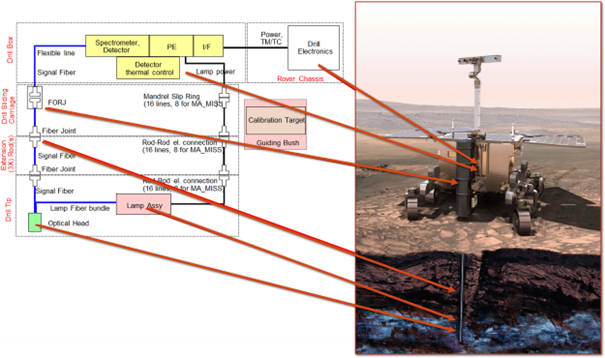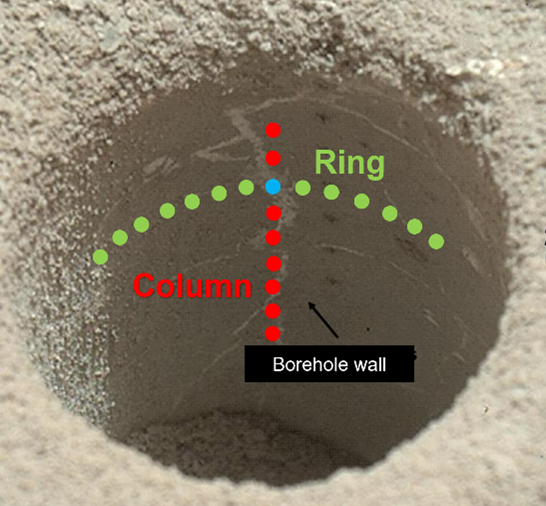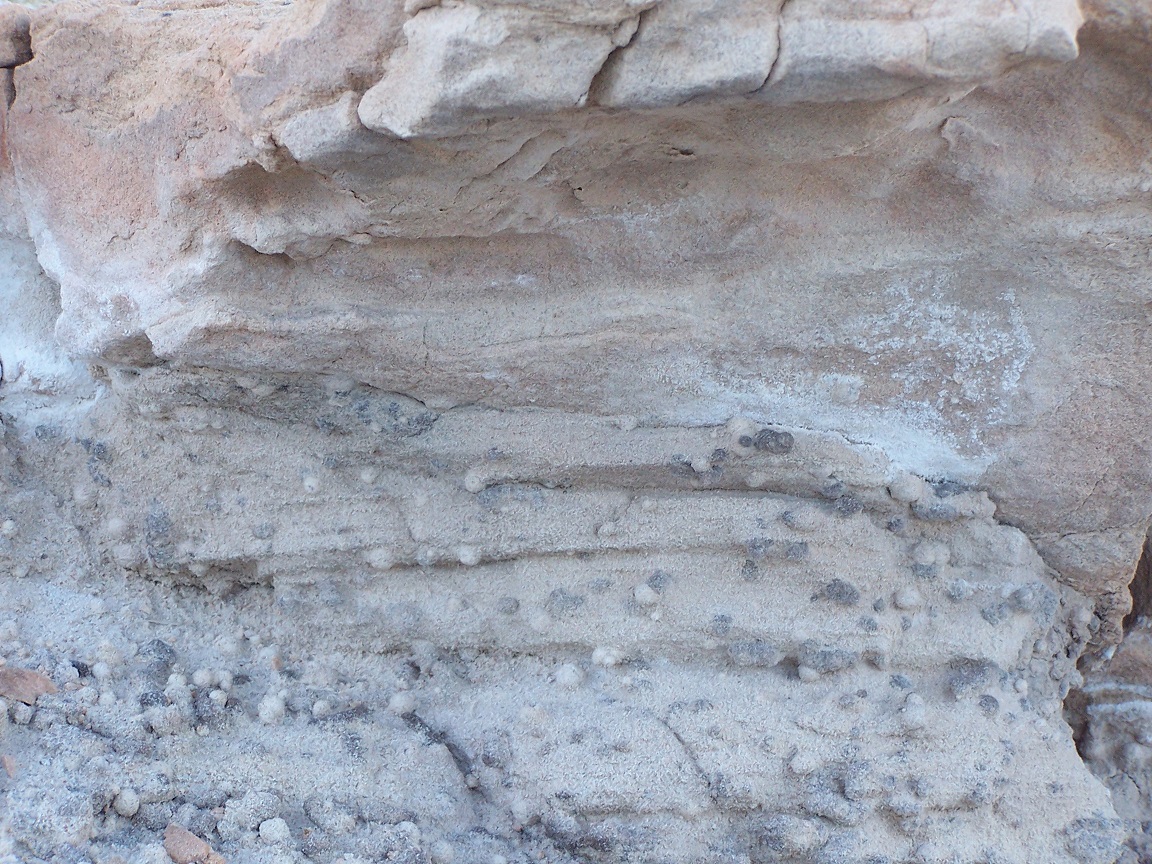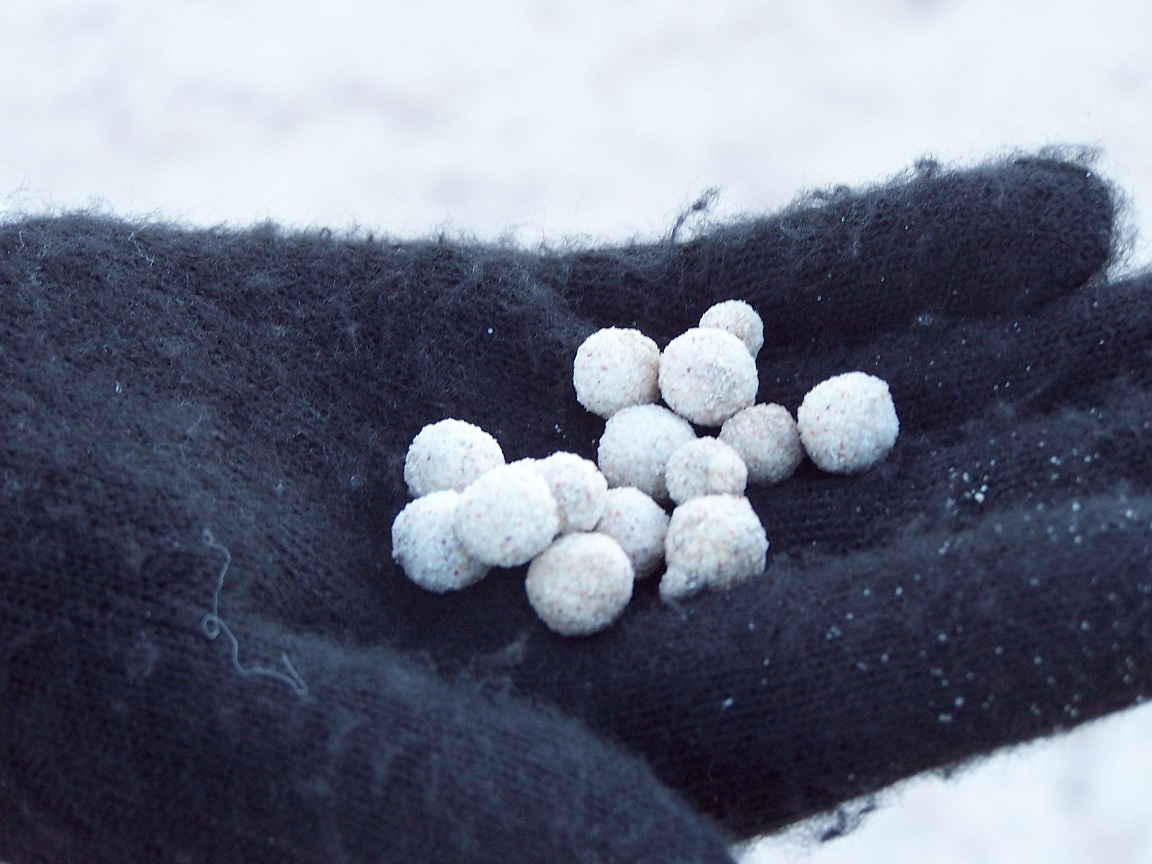Abstracts with displays | TP
TP1 | Mercury Science and Exploration
The discrete photoemission properties of atomic and molecular species stimulated by solar radiation are an important tool for quantitative work with remote sensing experiments. In an optically thin atmosphere, the total column amount of a given species is given in terms of a solar-forced g-value, defined as an emission probability per atom (photon s−1atom−1). For an optically thin gas and a measured emission brightness (4πI), the column abundance N is obtained through the relation 4πI= gN. Discrete emission lines and Fraunhofer features in the solar spectrum are responsible for a strong dependence of the g-values on Doppler velocity for many species. Because of Mercury’s eccentric orbit, some g-values can vary by over an order of magnitude during the orbital period. In addition, g-values are dependent on the instantaneous heliocentric radial velocity, which varies as an atom is ejected from the surface and moves through gravitational and radiation pressure accelerations. Thus knowledge of how the g-values vary is critical to interpretation of spectroscopic data. In previous work, g-values were calculated for 12 species that were to be targeted by MESSENGER. The species of interest included sodium, potassium, and calcium, which had been observed in Mercury’s exosphere through ground-based observations pre-MESSENGER, and hydrogen and oxygen, measured (or potentially only an upper limit in the case of O) by the UV spectrometer experiment on the Mariner 10 spacecraft. In addition, sulfur, magnesium, carbon, Ca+ and Mg+ are observable by Bepi-Colombo as well as MESSENGER. Helium EUV emission at 584 Å, not within the MESSENGER UVVS wavelength range, will be observable with the Bepi-Colombo UV spectrometer. Of particular importance for Mercury is the dependence of the g-values on the bulk motion of the gas relative to the Sun. This heliocentric relative velocity is often quite large due to the high initial velocity of the ejected atoms and the subsequent radiation pressure acceleration.
- Motivation
Mercury’s orbit is highly elliptical, having an ellipticity of 0.2. This results in a variation of the heliospheric relative velocity varying by ± 10 km/s. The g-values published by Killen et al. (2009) were therefore calculated for Doppler shifts of this magnitude. However, it has become apparent that the heliocentric relative velocity of atoms in Mercury’s exosphere varies considerably more than the velocity at rest with respect to the planet, both due to the initial ejection velocity and due to radiation pressure, that is especially strong for Na. The velocity of Ca atoms is also extreme, due to as yet unknown processes, but possibly due to dissociation of a Ca-bearing molecule. We have therefore extended the g-values to ±50 km/s relative to their at-rest values. The g-values have been scaled using the solar spectrum originally used by Killen et al. (2009) (e.g. Hall and Anderson, 1991) and available in the appendix to that paper. In addition, for the Mg line at 285.296 nm, we used the TSIS-1 solar spectrum available from the LISIRD website (https://lasp.colorado.edu/lisird/). In March 2022, the TSIS-1 HSRS was recommended as the new solar irradiance reference spectrum by the Committee on Earth Observation Satellites (CEOS) Working Group on Calibration and Validation (WGCV). TSIS-1 HSRS is developed by applying a modified spectral ratio method to normalize very high spectral resolution solar line data to the absolute irradiance scale of the TSIS-1 Spectral Irradiance Monitor (SIM) and the cubesat Compact SIM (CSIM). The spectral resolution of this spectrum is 0.25 nm. The high spectral resolution solar line data from the Air Force Geophysical Laboratory ultraviolet solar irradiance balloon observations, used in the Killen et al. (2009) work, have a spectral resolution of 0.015 nm. The g-values calculated herein at high resolution must be convolved to the spectral resolution of the instrument used for the observations to be analyzed. The UVVS spectrometer on MESSENGER was a scanning grating monochromator that covered the wavelength range 1150 - 6100 Å with an average 6 Å spectral resolution (McClintock & Lanton 2007). The Bepi Colombo UV spectrometer, PHEBUS, is a double spectrometer for the Extreme Ultraviolet range (550 - 1550 Å) and the Far Ultraviolet range (1450 - 3150 Å) using two micro-channel plate (MCP) detectors with spectral resolution of 10 Å for the EUV range and 15 Å for the FUV range (Chassefiere et al. 2008).
We show plots of extended g-values for Na (D1), K (D1 & D2), Ca, and Mg. The Mg g-values are given for both the Hall and Anderson (1991) solar spectrum and for the TSIS-1 spectrum for comparison of high and low-resolution results.
Figure 1. The g-value for Na (D1) at 589.756 nm in vacuum continues to increase as the Doppler shift increases. The D2 line g-values similarly increase beyond a velocity of ±10 km/s to ± 50 km/s. Therefore the column abundance for high velocity atoms will be over-estimated using the formerly published g-values. This is especially important for estimates of escape.
Figure 2. G-values for the Ca 422.7 nm line calculated to ±50 km/s. In the case of the Ca line, the g-value continues to increase for heliocentric relative velocity > 25 km/s, but decreases for heliocentric relative velocities < -35 km/s. As for Na, the Ca column abundance anti-sunward of Mercury will be overestimated using the previously published g-values.
Figure 3. The extended g-values for the K (D2) line at 404.53 nm (green) and K (D1) 404.84 nm (vacuum wavelengths) at 0.352 AU are quite complex owing to the underlying solar spectrum. Care must be taken to calculate the column abundance at the instantaneous heliocentric relative velocity of the atom.
Figure 4. The g-value for the Mg 285.296 nm line is also quite complex. This figure shows the g-value calculated using the high resolution of the Hall and Anderson (1991) solar spectrum at a spectral resolution of 15 mÅ.
Figure 5. The g-value for the Mg 285.296 nm line using the low resolution TSIS-1 spectrum at 0.25 Å resolution shows little high frequency variation, as expected.
How to cite: Killen, R., Vervack, R., and Burger, M.: Variation of g-values of major species with heliocentric velocity, Europlanet Science Congress 2022, Granada, Spain, 18–23 Sep 2022, EPSC2022-53, https://doi.org/10.5194/epsc2022-53, 2022.
In this work, we apply a method previously discussed in [1] to assess the presence of water ice in Mercury’s Polar Shadowed Regions (PSR) mixed to S-rich volatile species like SO2, H2S, and volatile organics, intending to verify their detectability from Bepi Colombo’s orbit and to optimize SIMBIO-SYS/VIHI observations. PSR icy deposits located within the floor of the Kandinsky crater are simulated in terms of I/F spectra corresponding to mixtures of H2O-H2S and H2O-SO2 with grain sizes of 10, 100, and 1000 µm as resulting from indirect illumination by the scattered solar light coming from the crater’s rim. The spectral simulations, performed following the method described in [2], and including the ice-regolith mixing (areal or intimate) as modeled in [3], allow for exploring different volatile species abundances and grain size distribution.
The resulting ice detection threshold are evaluated by means of the computation of VIHI’s instrumental signal-to-noise ratio as given by the instrumental radiometric model [4]. In this way, a synergistic use of illumination models, spectral simulations and resulting SNR calculations will help us to optimize the VIHI’s observation strategy across Mercury’s polar regions with the aim to detect, identify and map volatile species. This task is one of the primary scientific goals of the 0.4-2.0 µm Visible and Infrared Hyperspectral Imager (VIHI) [5], one of the three optical channels of the SIMBIO-SYS experiment [6] on ESA’s BepiColombo mission.
Due to orbital characteristics and proximity to the Sun, Mercury’s polar regions undergo large variations in illumination conditions during the hermean year [1]. At poles, Permanent Shadowed Regions (PSRs) occur on deep craters and rough morphology terrains that are not directly illuminated by the Sun during the hermean day. Nevertheless, some of these areas could experience partial illumination caused by multiple scattered light coming from nearby illuminated areas. Despite the orbital vicinity to the Sun, Mercury’s PSRs can maintain cryogenic temperatures across geological timescales resulting in the condensation and accumulation of volatile species [7]. While water ice is the more certain species in Mercury’s PSR, it is not precluded the occurrence of other secondary species rich in sulfur or even organic matter.
In fact, the total surface area of PSRs between latitudes 80−90° south is not negligible, being estimated at about 25.000 km2 [8], about two times larger than the same geographic area on the North Pole [9].
References: [1] Filacchione G. et al., MNRAS, 498, 1308-1318, 2020. [2] Raponi A. et al., Sci. Adv., 4, eaao3757, 2018. [3] Ciarniello. M. et al., Icarus, 214, 541, 2011. [4] Filacchione G. et al., Rev. Sci. Instrum., 88, 094502, 2017. [5] Capaccioni F. et al., IEEE Trans. Geosci. Remote Sens., 48, 3932, 2010. [6] Cremonese G. et al., Space Sci. Rev., 216, 75, 2020. [7] Paige D. A. et al., Science, 339, 300, 2013. [8] Chabot N. L. et al., J. Geophys. Res., 123, 666, 2018. [9] Deutsch A. N. et al., Icarus, 280, 158, 2016.
Acknowledgments: We gratefully acknowledge funding from the Italian Space Agency (ASI) under ASI-INAF agreement 2017- 47-H.0.
How to cite: Filacchione, G., Raponi, A., Ciarniello, M., Capaccioni, F., Frigeri, A., Galiano, A., De Sanctis, M. C., Formisano, M., Galluzzi, V., and Cremonese, G.: DETECTION OF ICY SPECIES IN MERCURY’S PSRs: SPECTRAL SIMULATIONS FOR SIMBIO-SYS/VIHI ON BEPI COLOMBO, Europlanet Science Congress 2022, Granada, Spain, 18–23 Sep 2022, EPSC2022-191, https://doi.org/10.5194/epsc2022-191, 2022.
Strofio is a mass spectrometer, aboard the BepiColombo mission, that utilizes a time-of-flight method to determine the mass-per-charge of each particle entering its aperture in order to study the chemical composition of the exosphere of Mercury. Optimization of Strofio involves finding a balance between system efficiency and mass resolution while increasing the signal-to-noise ratio. In order to ensure our data is exospheric in nature, we must separate the Mercury environment from the background environment. The background environment is made up of thermal particles produced from sources like the outgassing of the spacecraft as well as from the instrument itself. This problem can be addressed by assigning the correct voltages to the source apparatus, thereby realizing a background filter. This filter works best in Mach 2 or larger regimes to ensure the targeted particles do not get filtered out with the background. My work focuses on writing and running a series of computer simulations that optimize the velocity filter in accordance with the configuration of the flight model.
How to cite: Schroeder, J., Livi, S., Allegrini, F., and Wurz, P.: Increasing the Signal-to-Noise Ratio of a Mass Spectrometer Using a Velocity Filter, Europlanet Science Congress 2022, Granada, Spain, 18–23 Sep 2022, EPSC2022-368, https://doi.org/10.5194/epsc2022-368, 2022.
Mercury possesses the second, highest density (5.23 g/cm3) in the Solar System after Earth. This high density is likely the result of the presence of a large inner core, composed of iron-light elemental alloys, overlayed by a relatively thin silicate shell, comprising the crust and the mantle [1]. The mercurian crust has been analyzed by the Messenger spectroscopic suite of instruments, which included, among others, the XRS (X-ray Spectrometer) and GRS (Gamma-Ray Spectrometer) spectrometers, capable of detecting the elements present on Mercury’s surface. The surface mineralogy of Mercury is dominated by enstatite and plagioclase, with small amounts of sulfides (oldhamite, CaS), the presence of which is a strong clue of the extremely reducing conditions which have led to Mercury’s accretion and differentiation [2]. The mercurian crust has been found to be very thin with estimates ranging between 26 ± 11 km and 35 ± 18 km [3,4]. Moreover, the mercurian mantle is also thin, thinner than other terrestrial planets' mantles, with an estimated thickness between 300 km – 500 km [5]. In addition, the mantle shows a great lateral heterogeneity in mineral compositions, as indicated by the local, abrupt chemical changes in crustal chemistry [6].
Mercury’s large metallic core, likely partially molten and making up to 42% of its volume, combined with surficial observations (which have revealed a very small FeO concentration), and the peculiar position occupied by Mercury in the solar nebula, lead us to hypothesize a very reduced geochemical environment as its birthplace [7]. In literature, chondrites belonging to CB and enstatite chondrites (EN) have been considered the best precursor materials for Mercury’s composition [6, 8, 9, 10], sharing many analogies both in geochemistry and thermal evolution.
In light of the above, we chose a CB-like bulk composition to model the mineral assemblage of the mercurian mantle.
We reconstruct the evolution of the mercurian mantle starting from a CB chondrite-like bulk silicate composition, at thermodynamic equilibrium, as a function of temperatures and pressures estimated for Mercury’s mantle employing the Perple_X algorithm (6.9.1 version) [11]. We describe a dry scenario because the water abundance estimated for the bulk composition of Mercury silicate shells is quite low (0.3wt%, [12]) and due to the high-temperature ranges included in the model.
We predict that the peculiar geochemical environment where Mercury may have originated is characterized by a very low oxygen fugacity, which would result in a very reduced mineral assemblage for the mantle, dominated by pyroxenes and silica polymorphs, as shown in [9]. We expect that significant mantle phase transitions are unlikely due to the relative thinness of the mantle and the consequent low-pressure ranges (always <10 GPa) [13].
In conclusion, contrary to the terrestrial mantle, olivine is not predicted to be stable in our model. In effect, the low fO2 results in stabilizing pyroxenes relative to olivine [9], producing mineral assemblages quite different from terrestrial peridotites.
Acknowledgments
G.M. and C.C. acknowledge support from the Italian Space Agency (2017-40-H.1-2020).
References
[1] Solomon, S. C., et al., (2018). Mercury: The view after MESSENGER (Vol. 21). Cambridge University Press. [2] Weider, S. Z., et al., (2012)., J. Geophys. Res. Planets, 117(E12).[3] Sori, M. M. (2018). Earth & Planet. Sci. Lett., 489, 92-99. [4] Padovan, S., et al., (2015). Geophys. Res. Lett., 42(4), 1029-1038. [5] Tosi P. et al. (2013), J. Geophys. Res. Planets, 118(12), 2474-2487.[6] Charlier, B. et al., (2013). Earth & Planet. Sci. Lett., 363, 50-60. [7] Cartier, C., and Wood, B. J. (2019). Elements,15(1), 39-45. [8] Stockstill‐Cahill, K. R., et al., (2012). J. Geophys. Res. Planets, 117(E12). [9] Malavergne, V. et al., (2010). Icarus, 206(1), 199-209. [10] Zolotov, M. Y., et al., (2013). J. Geophys. Res. Planets, 118(1), 138- 146. [11] Connolly, J. A. (2005). Earth & Planet. Sci. Lett., 236(1-2), 524-541. [12] Vander Kaaden, K. E., & McCubbin, F. M. (2015). J. Geophys. Res. Planets, 120(2), 195-209. [13] Riner M. A.,et al., (2008). J. Geophys. Res. Planets, 113(E8).
How to cite: Cioria, C. and Mitri, G.: Mineralogical model of the mantle of Mercury, Europlanet Science Congress 2022, Granada, Spain, 18–23 Sep 2022, EPSC2022-432, https://doi.org/10.5194/epsc2022-432, 2022.
Introduction
Mercury’s surface is characterized by large and well-preserved impact basis. They represent important records regarding the magnitude and timing of the “Late Heavy Bombardment” in the early inner solar system. It has been suggested that Mercury and Moon had the same early impactor population based on their similar crater size frequency distributions [1,2]. In this study we investigated the basins using complementary topography and gravity data sets derived by MESSENGER [3,4]. Gravitational data in combination with the surface morphology of the basins may help improve our understanding of their formation processes and alterations with time. Gravity anomalies hint at complex interior structures, such as mass and density distributions in the upper crust of the planet, which is beneficial for identifying highly degraded or buried basins.
In this study, we present an inventory of basins larger than 150 km, for which we introduce a classification scheme according to morphological and gravitational signatures.
Methods and data sets
The topographic digital terrain model (DTM) used in this study was derived by the Mercury Dual Imaging System (MDIS), involving a narrow-angle- as well as a wide-angle camera [3]. Gravity data data of the MESSENGER spacecraft, which resulted in a gravity field model with a resolution of degree and order 160, equivalent to approximately 28 km in the spatial domain [4].
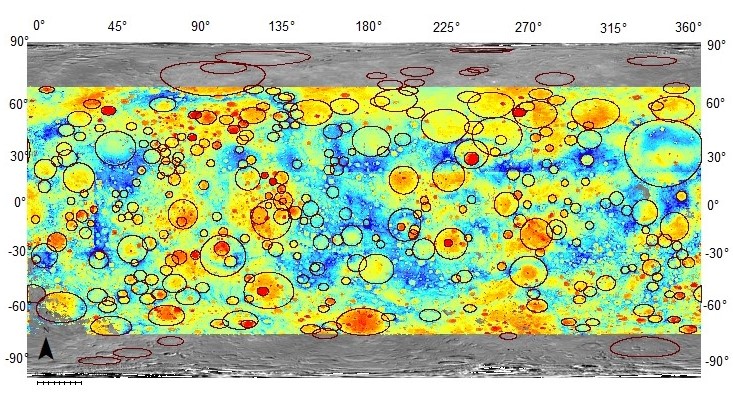
Fig 1: DTM of Mercury’s topography. Circles mark the identified basins.
Results
Our preliminary basin inventory hosts 311 basins (Fig.1). A clear correlation is noticed between the topography and gravity data, in particular impact basins are well detectable in both data sets. Their global distribution is non-uniform. Around 60% of basins are located on the western hemisphere. This asymmetric pattern may be caused by (I) lateral thermal variances of the crust [1], (II) synchronous spin- and orbital periods of the planet in its early history, which later changed to its presently observed 3:2 spin-orbit resonance [2], (III) resurfacing events that includes the northern smooth plains and following flooding of existing basins on the eastern hemisphere, which would eventually bury smaller complex basins.
With increasing diameter basins were found to show more complex gravity- and topography signatures. Basins with smaller diameter (<160 km) display a central peak. With increasing size, the morphology changes to a peak ring in the center. The transition from peak ring to multi-ring basins is suggested to occur at 350 km as is attested by a distinct change in the gravitational signal. The gravity disturbance remains mostly in strong negative values. This value shifts to a positive one for basins larger than 350 km.
High positive gravity signals were also recognized in the Bouguer anomaly map. Some basins (>350 km) possess a positive Bouguer anomaly in the basin center surrounded by a negative anomaly annulus (bullseye pattern) (Fig 2). Gravity data are reflecting mass/density deficits and excesses in the planet’s subsurface structures. The high mass and density concentrations may be caused by an uplift of mantle material after the crater excavation phase [5]. The excavation was followed by an isostatic adjustment caused by cooling and contraction of the melt pool. Subsequently, crust is expected to be thinner.
Fig 2: Left: Profile of Bouguer anomaly, Right: Bouguer anomaly map; showing positive strong anomaly in center surrounded by negative annulus.
However, basins with small diameter (<200 km) were found to show strong positive anomalies as well, that indicate a mantle uplift after their formations. Due to limited data resolution (particularly in the south) the localization and accuracy of the Bouguer anomalies is not certain.
Other 208 basins where identified, but could not be characterized in detail due to their high degradation state (rim <50%). Most of these are filled by secondary material. Future data with improved resolution would be required to verify these results.
We investigated the amplitude of Bouguer anomalies in the basin centers and surroundings as a measure of crustal thinning, which may hint at basin relaxation state. Lunar observations showed, that young basins with large diameters should contain strong positive anomalies because of limited relaxation due to high viscosity of a cooler planet [6]. In contrast, a less pronounced gravity anomalies hint at higher relaxation due to lower viscosity and a hotter crust in the planet’s earlier history (Fig 3).
Fig. 3: Bouguer anomaly contrast from rim to centre versus rim diameter. Basin classes: b_deg- degraded basin (<50% rim preserved), centr_peak- central peak basin, peakr- peak ring basin, com- complex basin (>50% rim preserved).
Acknowledgements
This work is supported by the Deutsche Forschungsgemeinschaft (SFB-TRR170, A6).
References
[1] Orgel et al., 2020, Re-examination of the Population, Statigraphy and Sequence of Mercurian Basins: Implications for Mercury’s Early Impact History and Comparison with the Moon, J. Geophys. Res. 125(8), doi:10.1029/2019JE006212
[2] Fassett C. I., et al., (2012), Large impact basins on Mercury: Global distribution, characteristics, and modification history from MESSENGER orbital data, J. Geophys. Res. 117, E00L08, doi:10.1029/2012JE004154
[3] Preusker et al., Towards high-resolution global topography of Mercury from MESSENGER orbital stereo imaging: A prototype model for the H6 (Kuiper) quadrangle, Planetary and Space Science 142 (2017) 26-37
[4] Konopliv et al., The Mercury gravity field, orientation, love number, and ephemeris from the MESSENGER radiometric tracking data, Icarus, Volume 335, 2020, 113386, ISSN 0019-1035,https://doi.org/10.1016/j.icarus.2019.07.020.
[5] Wieczorek, M., The gravity and topography of terrestrial planets, Treatise on geophysica, 2006
[6] Neumann et al., 2015. Lunar impact basins revealed by Gravity Recovery and Interior Laboratory measurements. Science Advances 1(9), 1-10.
How to cite: Szczech, C. C., Oberst, J., and Preusker, F.: Classification of Mercury’s Impact Basins, Based on Topography- and Gravity Signatures in MESSENGER Data, Europlanet Science Congress 2022, Granada, Spain, 18–23 Sep 2022, EPSC2022-595, https://doi.org/10.5194/epsc2022-595, 2022.
Data from NASA MESSENGER spacecraft highlighted that Mercury’s surface and composition are more varied than previously thought. Despite being the closest planet to the Sun, indeed, Mercury is rich in volatiles and its surface shows evidence of volatile-driven processes such as the formation of hollows and explosive volcanism. Even MESSENGER’s color-derived basemaps, moreover, highlight relevant color variations of the hermean surface possibly indicating age and compositional differences between adjacent materials.
The ongoing mapping for the eastern H9 Eminescu quadrangle (22.5°N-22.5°S, 108°E-144°E) [1] led to a thorough knowledge of the area that allowed the definition of scientific targets of interest to be investigated by the SIMBIO-SYS cameras [2] onboard the ESA-JAXA BepiColombo mission [3] coupled with other instruments such as MERTIS, BELA, MGNS and MIXS.
Proposed targets range from hollows to volcanic features, from craters and deformational structures and specific terrains and aim at shedding light on scientific questions concerning Mercury’s origin and evolution [4]. In particular, proposed targets aim to i) determine the abundance and distribution of key elements, minerals and rocks on the hermean crust, ii) characterize and correlate geomorphological features with compositional variations, iii) investigate the nature, evolution, composition and mechanisms of effusive and explosive events, iv) determine the formation and growth rates of hollows, the nature of processes related with volatile loss and their mineralogical and elemental composition of volatiles, v) determine the displacement and kinematics of tectonic deformations and the mechanisms responsible for their formation and vi) verify the occurrence of any detectable change in and around hollows and pyroclastic deposits since MESSENGER observations.
Acknowledgements: We acknowledge support from the Italian Space Agency (ASI) under ASI-INAF agreement 2017-47-H.0.
References: [1] El Yazidi et al., 2021, EPSC. [2] Cremonese et al., 2020, Sp. Sci. Rev. [3] Benkhoff et al., 2010, Plan. Sp. Sci. [4] Rothery et al., 2020, Sp. Sci. Rev.
How to cite: Tognon, G. and Massironi, M.: Definition of scientific targets of interest for BepiColombo in the eastern Eminescu (H9) quadrangle, Europlanet Science Congress 2022, Granada, Spain, 18–23 Sep 2022, EPSC2022-624, https://doi.org/10.5194/epsc2022-624, 2022.
Introduction: The IRIS (Infrared and Raman for Interplanetary Spectroscopy) laboratory generates mid-infrared spectra for the ESA/JAXA BepiColombo mission to Mercury. Onboard is a mid-infrared spectrometer (MERTIS-Mercury Radiometer and Thermal Infrared Spectrometer), which will allow to map the mineralogy in the 7-14 µm range [1, 2]. In order to interpret the future data, a database of laboratory spectra is assembled at the Institut für Planetologie in Münster (IRIS) and the DLR in Berlin.
So far, we have studied for this purpose natural mineral and rock samples (e.g. 3, 4), impact melt rocks (e.g. 5, 6, 7) and meteorites (e.g. 8, 9, 10, 11). Furthermore, surface processes like regolith formations and space weathering were of interest (e.g. 12, 13, 14).
Synthetic analogue materials have become one of the foci of our work, since they allow to produce ‘tailor-made’ materials based on remote sensing data and/or modelling and experiments. These are closer than natural terrestrial materials, which formed usually under different conditions as expected on Mercury [e.g. 1]. We synthesized analogs for surface regions of Mercury and other planetary bodies (15, 16, 17).
In this part of our study, we present mixtures based on phase equilibria of peridotite and partial melt compositions which were studied under hermean mantle conditions - temperature, pressure, oxygen fugacity (18,19,20). These experiments suggested that the crustal mineralogy should be dominated by variable abundances of plagioclase, olivine, clino- and orthopyroxene, with unconstrained proportions of silicate glass. Based on the model mineralogy of representative results, we produced mineral/glass mixtures based on the Low-Mg Northern Volcanic Plains (NVP)(Y121, Y131, Y172), High-Mg NVP (Y143, Y144), Smooth Plains (Y140, Y143, Y144), Inter crater Plain and Heavily Cratered Terrains (IcP-HCT) (Y126, Y131, Y132, Y146), and High-Mg Province (Y126, Y131, Y146) [20].
Samples and Techniques: We conducted diffuse reflectance studies of sieved size fractions (0-25 µm, 25-63 µm, 63-125 µm and 125-250 µm) under vacuum conditions, ambient heat, and variable geometries. We used a Bruker Vertex 70v with A513 variable geometry stage. The results will be made available in the IRIS Database [1].
Results: First results show the Christiansen Feature (CF), a characteristic, easy to identify reflectance low (or emission high) ranging from 7.9 µm to 8.2 µm (always average of all size fractions). The Transparency Feature (TF), typical for the finest size fraction (0-25 µm) is in many mineral mixtures less pronounced than for pure mineral phases. Here the individual TF of the components result in a broad feature.
The resulting spectra can be divided into three groups – such as dominated by a single glass feature at 9.6 – 9.9 µm, a second groups with forsterite bands 9.4 µm- 9.5 µm, 10.2 µm, 10.6 µm, 11.9 µm and 15.9 µm-16 µm, and a third dominated by pyroxene bands at 8.9-9.1 µm, 9.4-9.5 µm, 9.9 µm, 10.2 µm, 10.4-10.5 µm, 10.6 µm, 10.8-11 µm 11.1-11.3 µm and 11.4-11.6 µm. Plagioclase features, even when the phase is dominating the composition, are usually ‘overprinted’ by forsterite and pyroxene bands.
Discussion: A classic way to connect an easy to identify spectral feature in the mid-infrared to the chemical bulk composition is using the CF and the SiO2 content. Both show a strong correlation for both terrestrial rocks [21] and a variety of synthetic analogue samples from earlier studies in this project [15, 16, 17] (Fig.1).
Summary & Conclusion: In a next step, we will study these mixtures under more realistic conditions, i.e., high vacuum and high temperature, in order to better simulate the hermean surface. Also, these mixtures will be used to test spectral unmixing routines, which allow to identify abundances of single minerals in a complex mixture of phases.
References: [1] Hiesinger et al. (2020) Space Sci. rev. 216, 110 [2] Benkhoff et al. (2022) Space Sci. Rev. 217, 90 [3] Reitze et al.(2020) Min. Pet. 114, 453-463 [4] Reitze et al.(2021) EPSL 554, 116697 [5] Morlok et al.(2016) Icarus 264, 352-368 [6] Morlok et al.(2016) Icarus 278, 162-179 [7] Reitze et al.(2021) JGR (Planets) 126, e06832 [8] Weber et al. (2016) MAPS 51, 3-30 [9] Morlok et al. (2017) Icarus 284, 431-442 [10] Morlok et al. (2020) MAPS 55, 2080-2096 [11] Martin et al. (2017) MAPS 52, 1103-1124 [12] Weber et al. (2020) EPSL 530, 115884 [13] Weber et al. (2021) EPSL 569, 117072 [14] Stojic et al. (2021) Icarus 357, 114162 [15] Morlok et al. (2017) Icarus 296, 123-138 [16] Morlok et al. (2019) Icarus 324, 86-103 [17] Morlok et al. (2021) Icarus 361, 114363 [18] Charlier et al. (2013) EPSL 363, 50-60 [19] Namur et al. (2016) EPSL 439, 117-128 [20] Namur and Charlier (2017) Nature Geosci. 10, 9-13 [21] Cooper at al. (2002) JGR 107, 5017-5034 [22] Morlok et al. (2020) Icarus 335, 113410
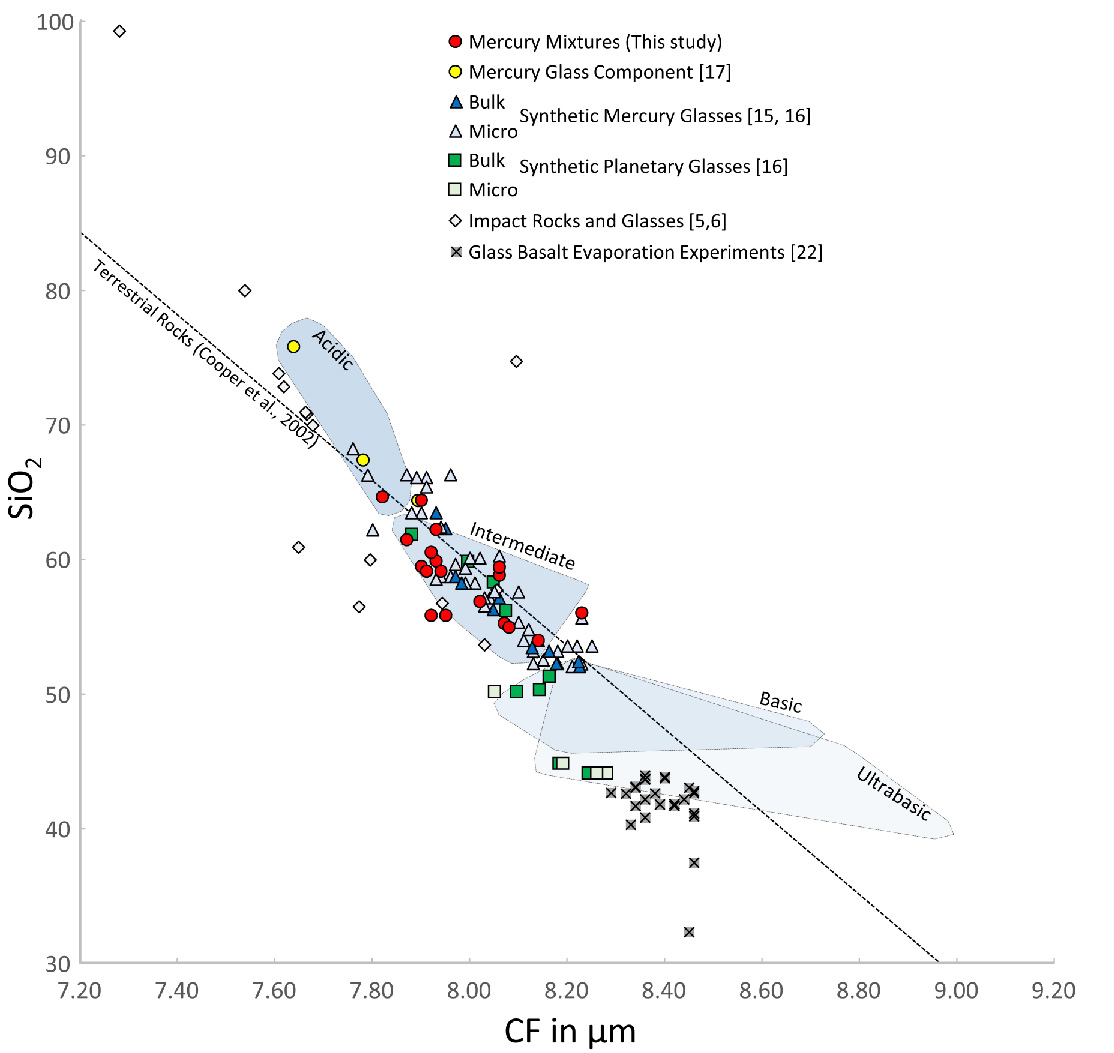
Figure 1: Comparison of the Christiansen Feature (CF), a characteristic reflectance low, to the SiO2 bulk composition. The results from this study (red circles) fall along the regression line for terrestrial intermediate rocks.
How to cite: Morlok, A., Renggli, C., Charlier, B., Namur, O., Klemme, S., Reitze, M., Weber, I., Stojic, A. N., Bauch, K., Schmedemann, N., Pasckert, J.-H., Hiesinger, H., and Helbert, J.: Synthetic Analogs for Surface Regions on Mercury: A Mid-Infrared Study for the BepiColombo Mission, Europlanet Science Congress 2022, Granada, Spain, 18–23 Sep 2022, EPSC2022-876, https://doi.org/10.5194/epsc2022-876, 2022.
The low intensity and lack of small-scale variations in Mercury’s present-day magnetic field can be explained by a thermally stratified layer blanketing the convective liquid outer core. The presence of a present-day stable layer is supported by thermal evolution studies that show that a sub-adiabatic heat flow at the core-mantle boundary can occur during a significant fraction of Mercury’s history. The requirements for both the likely long-lived Mercury dynamo and the presence of a stable layer place important constraints on the interior structure and evolution of the core and planet.
We couple mantle and core thermal evolution to investigate the necessary conditions for a long-lived and present-day dynamo inside Mercury’s core by taking into account an evolving stable layer overlying the convecting outer core. Events such as the cessation of convection in the mantle may strongly influence the core-mantle boundary heat flow and affect the thickness of the thermally stratified layer in the core, highlight the importance of coupling mantle evolution with that of the core. We employ interior structure models that agree with geodesy observations and make use of recent equations of state to describe the thermodynamic properties of Mercury’s Fe-S-Si core for our thermal evolution calculations.
How to cite: Rivoldini, A., Deprost, M.-H., Zhao, Y., Knibbe, J., and Van Hoolst, T.: Effect of a thermally stratified layer in the outer core of Mercury on its internally generated magnetic field, Europlanet Science Congress 2022, Granada, Spain, 18–23 Sep 2022, EPSC2022-929, https://doi.org/10.5194/epsc2022-929, 2022.
Since the era of Messenger, many observational constraints on Mercury’s thermal evolution and magnetic field have strengthened the idea that the outermost layer of Mercury’s fluid core is stably stratified. The presence of such a stably stratified zone can significantly alter the core flow compared to the flow in a completely homogeneous fluid core. This is on the one hand because stratified layers can impede fluid motions that are parallel to the density gradient, which in the case of Mercury would mean that radial flows are strongly suppressed. On the other hand this is because a stably stratified layer can support different types of waves that are affected by the buoyancy force.
In this study we have created a numerical model to investigate flow in Mercury’s fluid outer core that includes a radial background stratification. The exact structure of the density profile in the planet’s core is unknown, and we assume profiles based on recent findings of the interior evolution of the planet. We studied core flow that is excited by Mercury’s librations, oscillations of the mean rotation rate due to the solar gravitational torque acting on Mercury’s triaxial shape. Based on the work by Rekier et. al. (2019) we represent the librational forcing by the superposition of three different decoupled motions: a horizontal component, which represents the viscous drag of the core fluid by the librating mantle and spherical inner core, and two radial components that are representing the radial push that the core flow would experience due to the librating triaxial boundaries.
We show that especially the second component has a profound effect, inducing a large non-axisymmetric flow close to the core-mantle boundary. It turns out that even though the origin of said flow is radial, the horizontal component of the flow is far larger than it’s radial counterpart. This indicates that the stratified layer acts to convert radial motions into strong horizontal motions.
We show how the strength and existence of this flow depend on the strength of the stratification of the layer and discuss implications of this flow for the magnetic field.
References:
Rekier, J., Trinh, A., Triana, S. A., & Dehant, V. (2019). Internal energy dissipation in Enceladus's subsurface ocean from tides and libration and the role of inertial waves. Journal of Geophysical Research: Planets, 124, 2198–2212. https://doi.org/10.1029/2019JE005988
How to cite: Seuren, F., Rekier, J., Triana, S. A., and Van Hoolst, T.: The core flow induced by Mercury’s libration: density stratification and magnetic fields, Europlanet Science Congress 2022, Granada, Spain, 18–23 Sep 2022, EPSC2022-934, https://doi.org/10.5194/epsc2022-934, 2022.
TP2 | Paving the way to the decade of Venus
Background
In situ probe measurements and remote sensing have revealed that Venus has a highly organised cloud system. Comparisons between models of the expected spectra and observations reveal unexplained absorption in the near-UV to blue region of the spectrum. While many candidates for this “unknown absorber” have been proposed over the years, none have been conclusively demonstrated to match the physical and optical behaviour observed (Pérez-Hoyos et al., 2018, JGR Planets, 123).
One such candidate is ferric chloride (Krasnopolsky, 2017, Icarus, 286; Zasova et al., 1981, ASR, 1). Attempts to reliably determine its suitability have been hampered by the scarcity of representative spectra available. Absorbance spectra generally used in the literature are measured in ethyl acetate (Aoshima et al., 2013, Polymer Chemistry, 4), and therefore may not be representative of the absorption produced by ferric chloride in the Venusian clouds.
In addition to the absorption spectrum produced, the behaviour of absorber candidates must also be considered, including their rates and locations of production and loss, transport mechanisms, and lifetimes in the atmosphere. While much of this behaviour must be examined in atmospheric models, laboratory studies to establish reaction pathways and measure rates are needed to provide as much quantitative data as possible for model development.
Method and results
Literature spectra for ferric chloride employ UV-visible spectrometry using ethyl acetate as a solvent. We present absorption spectra of ferric chloride in sulphuric acid. This change of solvent produces an environment more closely aligned to that on Venus, where ferric chloride, if present, may exist as an impurity in the micron-sized sulphuric acid cloud droplets (Petrova, 2018, Icarus, 306).
In addition, mass spectrometry was used to investigate the kinetics and products of reactions of ferric chloride that could occur in the Venusian atmosphere. Behaviour predicted by these experiments can then be included in atmospheric models to test the lifetime and transport of ferric chloride and its reaction products in the atmosphere.
Conclusions
The unknown absorption was first observed close to 100 years ago, yet the mystery of its cause remains unsolved. More representative spectra of ferric chloride and a greater understanding of its behaviour in the atmosphere of Venus are critical to advancing the identification of the unknown absorber. As the absorber is located towards the top of the clouds and absorbs in the near-UV to blue region, it is responsible for large amounts of absorption of incident sunlight, and therefore has a significant impact on the Venusian energy budget. Accurate atmospheric modelling of the planet therefore requires an understanding of the absorber which can only be achieved once it has been conclusively identified.
How to cite: Egan, J., James, A., Plane, J., Murray, B., and Feng, W.: Laboratory experiments to constrain the identity of Venus’s unknown UV absorber, Europlanet Science Congress 2022, Granada, Spain, 18–23 Sep 2022, EPSC2022-76, https://doi.org/10.5194/epsc2022-76, 2022.
Observations of the Venus Climate Orbiter “Akatsuki” provide us with horizontal distributions of the horizontal winds derived from cloud tracking of the Ultraviolet Imager (UVI) and of temperature observed by the Longwave Infrared Camera (LIR). However, these observations are limited in altitude, local time (day or night side), and frequency. Then it is difficult to elucidate the general circulation of the Venus atmosphere, including various temporal and spatial scales, only from observations. In this study, we produced a Venus dataset (analysis) that has high temporal and spatial resolutions by assimilating horizontal winds derived by the Akatsuki observations. At the top of the cloud layer of Venus, there are planetary-scale atmospheric waves that are excited by the solar heating and move with the sun, called the thermal tides. In this presentation, we focused on thermal tides to verify the analysis.
We use the Venus atmospheric data assimilation system “ALEDAS-V" (Sugimoto et al., 2017) [1] for assimilation and the Venus atmospheric general circulation model “AFES-Venus" (Sugimoto et al., 2014) [2] for ensemble forecasts. AFES-Venus is a full nonlinear dynamical GCM on the assumption of hydrostatic balance, designed for the Venus atmosphere. ALEDAS-V uses the Local Ensemble Transform Kalman Filter, and is the first data assimilation system for the Venus atmosphere. We assimilated the cloud top (~70km) zonal and meridional winds obtained by tracking morphology, using Akatsuki UVI data (Horinouchi et al., 2021) [3] from September 1st to December 31st, 2018. The assimilation data (analysis) from October 1st to November 30th, 2018, is analyzed, because the root-mean-square-deviations (RMSD) from FR (free run; the case without data assimilation) are stable.
Figures (a) and (d) show the observed zonal and meridional winds, respectively. The zonal wind has a local minimum near 11 LT (local time) around the equator (Figure a). The meridional wind is the weakest at the equator and increases with latitude, and the amplitude is maximum around noon (Figure d) in the local time direction. Note that these winds obtained from observations exist only the dayside equatorward of 50° latitudes (Figure a and d).
Figures (b) and (e) show the deviations from the zonal means of zonal and meridional winds at an altitude of 70 km in the FR, respectively. For zonal wind, diurnal (zonal wavenumber 1) and semidiurnal (zonal wavenumber 2) tides are dominant at latitudes poleward and equatorward of 30, respectively (Figure b). The zonal wind deviation has a local minimum at 14-15LT, which is ~ 2 hours behind the observation (Figures a and b). The meridional wind deviation is polar and equatorial on the dayside and nightside, respectively (Figure e), and this distribution is consistent with Akatsuki's observation (Figure d).
Figures (c) and (f) show the zonal and meridional winds as a result of assimilation, respectively. The zonal wind in the equatorial region have a local minimum near 11 LT. The assimilation improved the semidiurnal tide closer to the observations (Figures a and c). The meridional wind is not so different from FR. This is probably because FR was originally very similar to observations (Figures d and f). These results are consistent with a previous study by Sugimoto et al. (2019) [4]. In addition, while the observed winds exist only on the dayside, the results of assimilation show that the horizontal winds field is modified significantly even on the nightside. It is suggested that spatially limited data assimilation can improve the general circulation of GCM.
In the future work, we are planning to release the assimilation dataset as the “objective analysis data” of Venus for the first time in the world.
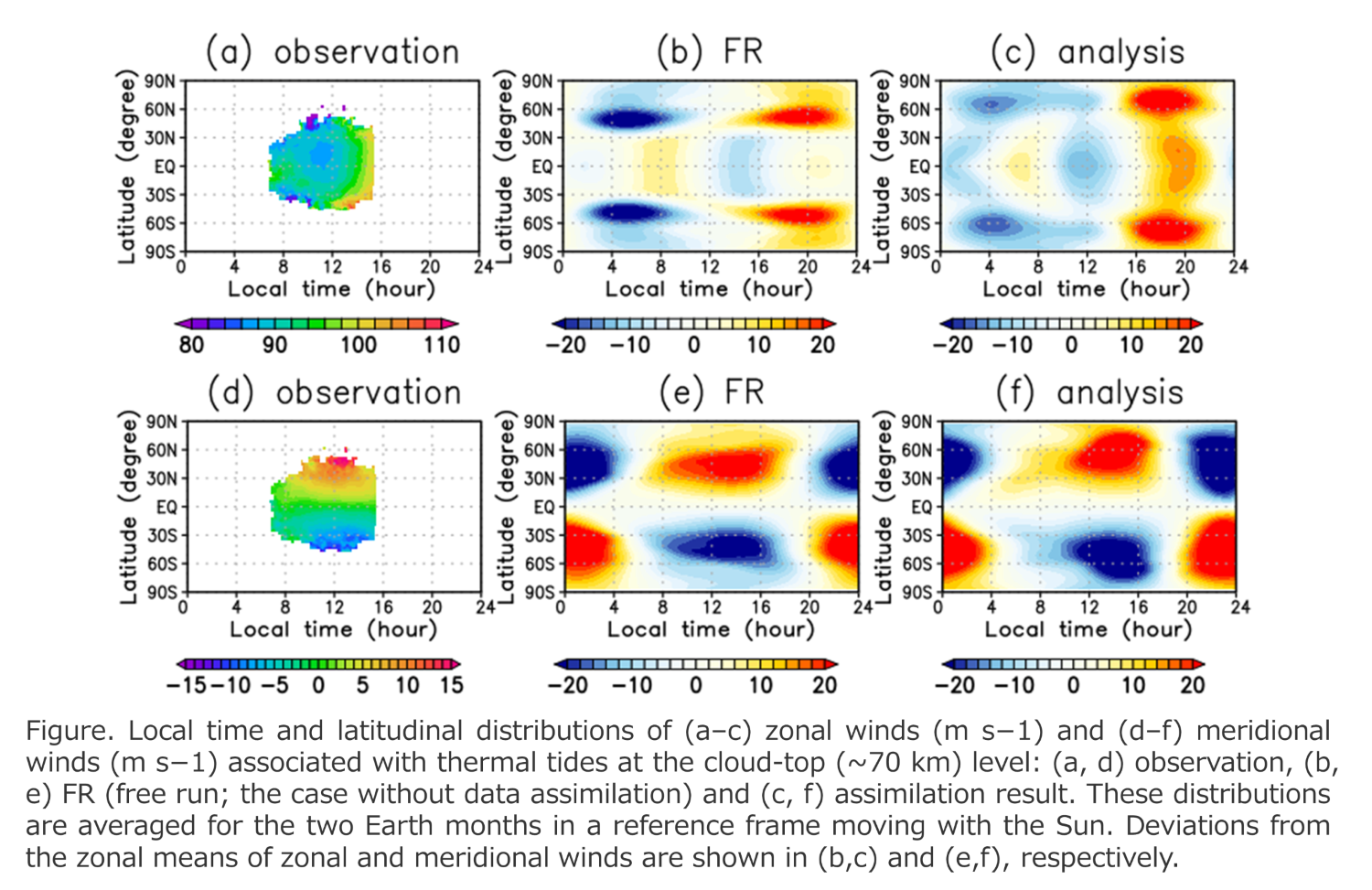
[1] Sugimoto, N., et al. Development of an ensemble Kalman filter data assimilation system for the Venusian atmosphere. Scientific Reports 7(1), 9321 (2017).
[2] Sugimoto, N., et al. Baroclinic instability in the Venus atmosphere simulated by GCM. J. Geophys. Res. Planets 119, 1950–1968 (2014).
[3] Horinouchi, T., et al. Venus Climate Orbiter Akatsuki Cloud Motion Vector Data Set v1.0, JAXA Data Archives and Transmission System (2021).
[4] Sugimoto, N., et al. Impact of data assimilation on thermal tides in the case of Venus Express wind observation. Geophys. Res. Lett. 46, 4573–4580 (2019).
How to cite: Fujisawa, Y., Murakami, S., Sugimoto, N., Takagi, M., Imamura, T., Horinouchi, T., Hashimoto, G. L., Ishiwatari, M., Enomoto, T., Miyoshi, T., Kashimura, H., and Hayashi, Y.-Y.: Thermal tides reproduced in the assimilation results of horizontal winds obtained from Akatsuki UVI observations, Europlanet Science Congress 2022, Granada, Spain, 18–23 Sep 2022, EPSC2022-309, https://doi.org/10.5194/epsc2022-309, 2022.
Since 2012, we have been monitoring SO2 and H2O (using HDO as a proxy) at the cloud top of Venus, using the TEXES high-resolution imaging spectrometer at the NASA InfraRed Telescope Facility (IRTF) at Maunakea Observatory. Sixteen runs have been performed between 2012 and 2022. Maps have been recorded around 1345 cm-1 (7.4 microns, z = 62 km), where SO2, CO2 and HDO are observed, and around 530 cm-1 (19 microns, z = 57 km) where SO2 and CO2 are observed, as well as around 1162 cm-1 (8.6 microns, z = 66 km) where CO2 is observed. From the early beginning, SO2 plumes have been identified with an evolution time scale of a few hours. In 2020, an anti-correlation has been found in the long-term evolution of H2O and SO2; in addition, the SO2 plume appearance as a function of local time seems to show two maxima around the terminator, indicating the possible presence of a semi-diurnal wave (Encrenaz et al. A&A 639, A69, 2020). After two years of interruption due to the pandemia, new observations have been performed in July 2021, September 2021, November 2021, and February 2022. The main results of the new observations are listed below. (1)The SO2 abundance, which had been globally increasing from 2014 until 2019, has now decreased with respect to its maximum value. (2) The anti-correlation between H2O and SO2, which was maximum between 2014 and 2019 (cc = - 0.9) does not appear clearly in the recent observations. (3) The maximum appearance of the SO2 plumes at the equator and the terminators is confirmed, but appears stronger on the morning side.(4) A strong activity of the SO2 plumes is observed in September and November 2021, at a time when the disk-integrated SO2 abundance is low. At the same time, thermal maps at 1162 cm-1 (8.6 microns, z = 66 km) show a polar enhancement. This behavior could possibly be associated with the topography.
How to cite: Encrenaz, T., Greathouse, T., Giles, R., Widemann, T., Bézard, B., and Fouchet, T.: Ground-based HDO and SO2 thermal mapping on Venus between 2012 and 2022: : An update, Europlanet Science Congress 2022, Granada, Spain, 18–23 Sep 2022, EPSC2022-414, https://doi.org/10.5194/epsc2022-414, 2022.
Numerical simulation of Venus’ atmosphere is useful to understand the dynamics of the system. The Venus atmospheric data assimilation system “ALEDAS-V” (Sugimoto et al. 2017) based on the Venus atmospheric general circulation model “AFES-Venus” (Sugimoto et al. 2014) has been used to simulate Venus’ atmosphere and generated some key phenomena such as the super-rotation, baroclinic waves, and thermal tides. To further understand the dynamics of Venus’ atmosphere, Bred Vectors (BV) are computed with the AFES-Venus model. This method can identify different growing modes of the system and has been used to study the dynamics of the Earth (Toth and Kalnay 1993, 1997) and Martian atmospheres (Greybush et al. 2013). However, to our knowledge, there has been no similar study on Venus’ atmosphere. To conduct the breeding cycle, we first produced a five (Earth) year free run of the AFES-Venus model initialized from an idealized zonal wind profile. Next, the forecast states on January 01 and August 25 in the 5th Earth year are used as the initial conditions for the control run and the perturbed run, respectively. These two initial conditions have the same sub-solar positions. To emphasize the active dynamics, the BV norm is defined by the temperature norm from the 60 km to 80 km altitudes, weighted by pressure and latitude. For the breeding cycle, a rescaling norm and rescaling interval are specified. During the breeding cycle, at every rescaling interval (including the initial time), if the norm is bigger than the specified rescaling norm, the BV is rescaled to the rescaling norm.
Different combinations of the parameters are tested. The BV amplitude generally remains stable throughout the whole year without significant seasonal variability (Figure 1), which is different from the Martian atmosphere. The growth rate of the BV amplitude can represent the characteristics of the instabilities. It is calculated by taking the natural logarithm of the ratio of the BV amplitude at the end of the time interval (before rescaling) to the amplitude at the beginning of the interval. It is then converted to the daily growth rate by dividing the ratio of the time interval to one day. When the rescaling norm is smaller or the rescaling interval is shorter, the average growth rate is higher (Figure 2). Further BV analysis will be conducted such as analyzing the BV structure by taking composite mean along the super-rotation and conducting BV breeding cycle without thermal tides. These results will be useful to understand the dynamics of the thermal tide, baroclinic waves, super-rotation, and other important features of Venus atmosphere.
Figure 1. The bred vector amplitude (K2 ) time evolution from the experiments with different rescaling days (1, 2, 5, 10, 20) and the same rescaling norm (10 K2 ).
Figure 2. The average daily growth rate of the bred vector amplitude (K2 ) for different combination of rescaling norm and rescaling days. The average is taken from February to December.
Reference
Greybush, S. J., E. Kalnay, M. J. Hoffman, and R. J. Wilson, 2013: Identifying Martian atmospheric instabilities and their physical origins using bred vectors. Q. J. R. Meteorol. Soc., 139, 639–653, https://doi.org/10.1002/qj.1990.
Sugimoto, N., M. Takagi, and Y. Matsuda, 2014: Baroclinic instability in the Venus atmosphere simulated by GCM. J. Geophys. Res. Planets, 119, 1950–1968, https://doi.org/10.1002/2014JE004624.
——, A. Yamazaki, T. Kouyama, H. Kashimura, T. Enomoto, and M. Takagi, 2017: Development of an ensemble Kalman filter data assimilation system for the Venusian atmosphere. Sci. Rep., 7, 9321, https://doi.org/10.1038/s41598-017-09461-1.
Toth, Z., and E. Kalnay, 1993: Ensemble Forecasting at NMC: The Generation of Perturbations. Bull. Am. Meteorol. Soc., 74, 2317–2330, https://doi.org/10.1175/1520-0477(1993)074<2317:EFANTG>2.0.CO;2.
——, and ——, 1997: Ensemble Forecasting at NCEP and the Breeding Method. Mon. Weather Rev., 125, 3297–3319, https://doi.org/10.1175/1520-0493(1997)125<3297:EFANAT>2.0.CO;2.
How to cite: Liang, J., Sugimoto, N., and Miyoshi, T.: Identifying the growing modes of Venus’ atmosphere using Bred Vectors, Europlanet Science Congress 2022, Granada, Spain, 18–23 Sep 2022, EPSC2022-713, https://doi.org/10.5194/epsc2022-713, 2022.
We report on detection and upper-limit of H2CO, O3, NH3, HCN, N2O, NO2, and HO2 above the cloud deck using the SOIR instrument on-board Venus Express.
The SOIR instrument performs solar occultation measurements in the IR region (2.2 - 4.3 µm) at a resolution of 0.12 cm-1, the highest of all instruments on board Venus Express. It combines an echelle spectrometer and an AOTF (Acousto-Optical Tunable Filter) for the order selection. SOIR performed more than 1500 solar occultation measurements leading to about two millions spectra.
The wavelength range probed by SOIR allows a detailed chemical inventory of the Venus atmosphere at the terminator in the mesosphere, with an emphasis on vertical distribution of the gases.
In this work, we report detections in the mesosphere, between 60 and 100 km.
Implications for the mesospheric chemistry will also be addressed.
How to cite: Mahieux, A., Robert, S., Mills, F., Trompet, L., Aoki, S., Piccialli, A., Jessup, K. L., and Vandaele, A. C.: Minor species in the Venus mesosphere from SOIR on board Venus Express: detection and upper limit profiles of H2CO, O3, NH3, HCN, N2O, NO2, and HO2, Europlanet Science Congress 2022, Granada, Spain, 18–23 Sep 2022, EPSC2022-921, https://doi.org/10.5194/epsc2022-921, 2022.
Venus appears to be an “alien” planet drastically and surprisingly different from the Earth. The early space missions revealed the world with remarkably hot, dense, cloudy, and very dynamic atmosphere filled with toxic species likely of volcanic origin. During more than 8 years of operations ESA’s Venus Express spacecraft performed a global survey of the atmosphere and plasma environment of our near neighbour. The mission delivered comprehensive data on the temperature structure, the atmospheric composition, the cloud morphology, the atmospheric dynamics, the solar wind interaction and the escape processes. Vertical profiles of the atmospheric temperature showed strong latitudinal trend in the mesosphere and upper troposphere correlated with the changes in the cloud top structure and suggesting convective instability in the main cloud deck at 50-60 km. Observations revealed significant latitudinal variations and temporal changes in the global cloud top morphology, which modulate the solar energy deposited in the atmosphere. The cloud top altitude varies from ~72 km in the low and middle latitudes to ~64 km in the polar region, correlated with decrease of the aerosol scale height from 4 ± 1.6 km to 1.7 ± 2.4 km, marking vast polar depression. UV imaging showed for the first time the middle latitudes and polar regions in unprecedented detail. In particular, the eye of the Southern polar vortex was found to be a strongly variable feature with complex dynamics.
Solar occultation observations and deep atmosphere spectroscopy in spectral transparency “windows” mapped distribution of the major trace gases H2O, SO2, CO, COS and their variations above and below the clouds, revealing key features of the dynamical and chemical processes at work. A strong, an order of magnitude, increase in SO2 cloud top abundance with subsequent return to the previous concentration was monitored by Venus Express specrometres. This phenomenon can be explained either by a mighty volcanic eruption or atmospheric dynamics.
Tracking of cloud features provided the most complete characterization of the mean atmospheric circulation as well as its variability. Low and middle latitudes show an almost constant with latitude zonal wind speed at the cloud tops and vertical wind shear of 2-3 m/s/km. Surprisingly the zonal wind speed was found to correlate with topography decreasing from 110±16 m/s above lowlands to 84±20 m/s at Aphrodite Terra suggesting decelerating effect of topographic highs. Towards the pole, the wind speed drops quickly and the apparent vertical shear vanishes. The meridional cloud top wind has poleward direction with the wind speed ranging from about 0 m/s at equator to about 15 m/s in the middle latitudes. A reverse equatorward flow was found about 20 km deeper in the middle cloud suggesting existence of a Hadley cell or action of thermal tides at the cloud level. Comparison of the thermal wind field derived from temperature sounding to the cloud-tracked winds confirms the validity of cyclostrophic balance, at least in the latitude range from 30S to 70S. The observations are supported by the General Circulation Models.
Venus Express detected and mapped non-LTE infrared emissions in the lines of O2, NO, CO2, OH originating near the mesopause at 95-105 km. The data show that the peak intensity occurs in average close to the anti-solar point for O2 emission, which is consistent with current models of the thermospheric circulation. For almost complete solar cycle the Venus Express instruments continuously monitored the induced magnetic field and plasma environment and established the global escape rates of 3·1024s−1, 7·1024s−1, 8·1022s−1 for O+, H+, and He+ ions and identified the main acceleration process. For the first time it was shown that the reconnection process takes place in the tail of a non-magnetized body. It was confirmed that the lightning tentatively detected by Pioneer-Venus Orbiter indeed occurs on Venus.
Thermal mapping of the surface in the near-IR spectral “windows” on the night side indicated the presence of recent volcanism on the planet, as does the high and strongly variable SO2 abundance. Variations in the thermal emissivity of the surface observed by the VIRTIS imaging spectrometer indicated compositional differences in lava flows at three hotspots. These anomalies were interpreted as a lack of surface weathering suggesting the flows to be younger than 2.5 million years indicating that Venus is actively resurfacing. The VMC camera provided evidence of transient bright spots on the surface that are consistent with the extrusion of lava flows that locally cause significantly elevated surface temperatures. The very strong spatial correlation of the transient bright spots with the extremely young Ganiki Chasma, their similarity to locations of rift-associated volcanism on Earth, provide strong evidence of their volcanic origin and suggests that Venus is currently geodynamically active.
Alongside observations of Earth, Mars and Titan, observation of Venus allows the opportunity to study geophysical processes in a wide range of parameter space. Furthermore, Venus can be considered as an archetype of terrestrial exoplanets that emphasizes an important link to the quickly growing field of exoplanets research.
The talk will give an overview of the Venus Express findings including recent results of data analysis, outline outstanding unsolved problems and provide a bridge, via the Akatsuki mission, to the missions to come in 2030s: EnVision, VERITAS and DAVINCI.
How to cite: Titov, D., Straume-Lindner, A. G., and Wilson, C.: Venus Express as precursor of the Venus Decade, Europlanet Science Congress 2022, Granada, Spain, 18–23 Sep 2022, EPSC2022-1120, https://doi.org/10.5194/epsc2022-1120, 2022.
TP3 | Forward to the Moon: The Science of Exploration
1. Introduction
Knowing the photometric properties of a surface can give us insight into its physical properties. Images with several different observation conditions can be used to constrain the parameters of a semi-physical model like the Hapke model [1].
The Wide Angle Camera onboard the Lunar Reconnaissance Orbiter (LROC WAC) [2] provides unprecedented coverage of the lunar surface for a variety of phase angles. The field of view of the Narrow Angle Camera (LROC NAC) [2] is much smaller and therefore, also the possible phase angles are limited but the resolution is around 1 m/pixel.
Sato et al. [3] have used WAC images to create global maps of the Hapke parameters binned into areas of 1 degree/pixel [3]. In this work, we calculate photometric parameters on the pixel level. Velikodsky et al. [4] investigated the relative contributions of coherent backscatter and shadow hiding opposition effects based on WAC images and, similar to [3], find that the total strength of the opposition effect is inversely correlated with albedo.
The landing of a spacecraft on the lunar surface can change the physical properties of the regolith [5], e.g., by compacting the very porous lunar regolith.
2. Methods
Our method consists of three main steps. Firstly, the WAC or NAC EDR images are downloaded from the PDS and processed with ISIS3 [6]. This process includes calibration and map projection. The NAC images are mapped to a common resolution of 1.6 m/pixel and the WAC images are mapped to a resolution of 400 m/pixel. The sub-solar and sub-spacecraft points are extracted using the campt command in ISIS3.
Secondly, suitable images are co-registered in MATLAB to a common reference image and we calculate the incidence, emission, and phase angles based on the trajectory of the LRO, the sub-solar point, and either the GLD100 [7] in the case of WAC images or a Shape from Shading Digital Elevation Model [8] in the case of NAC images. Due to its large field of view, the phase angle changes significantly within one WAC image. For NAC images the emission angle can be assumed as constant for our region of interest.
Thirdly, we employ the NUTS sampler of pymc3 [9] to infer the posterior density of the parameters of the Hapke model [1] given the data. This Bayesian inference technique [10] also provides us with information about the respective uncertainties. Because several parameters of the Hapke model have a similar influence on the total reflectance, we limit our analysis to three parameters, namely, the single scattering albedo (w), the amplitude of the shadow hiding opposition effect (BS0), and the surface roughness (θb).
3. Results
For the landing site of Chang’e 5, we selected and co-registered 19 LROC NAC images, 8 before landing and 11 after landing. The phase angles range from approximately 45 degrees to nearly 90 degrees. For the Reiner Gamma swirl, we selected and coregistered 9 LROC WAC images and selected the wavelength channel at 605 nm. All outcrops of the regions of interest are shown in Figure 1. One can see that the image after the landing is overall brighter compared to that before the landing for a similar phase angle. The western part of the Reiner Gamma swirl is also clearly visible by its increased brightness (see Figure 1c). The resulting maps for albedo, shadow hiding amplitude, and mean of the standard deviation of the likelihood function (σ) are shown in Figure 2. The parameter σ describes the quality of the fit of the model and the data and can be interpreted similarly to a root mean squared error. Overall, the albedo increases from before the landing to after the landing, and BS0 decreases around the rover landing site. Very high values of BS0 coincide with shadows of the rover or craters and also correlate with high values of σ. Values with a σ value above 0.07 are labeled as invalid and are, therefore, omitted for future analysis. Pixels with an albedo larger than 0.21 have been labeled as on-swirl or landing-site. The histograms of the BS0 values are shown in Figure 3. They show that the landing site and on-swirl pixels show a significantly weaker shadow hiding effect than the surrounding surface.
Figure 1: Images of similar phase angle for the landing site before (a) and after (b) the landing of Chang’e 5 as well as for the western part of Reiner Gamma (c).
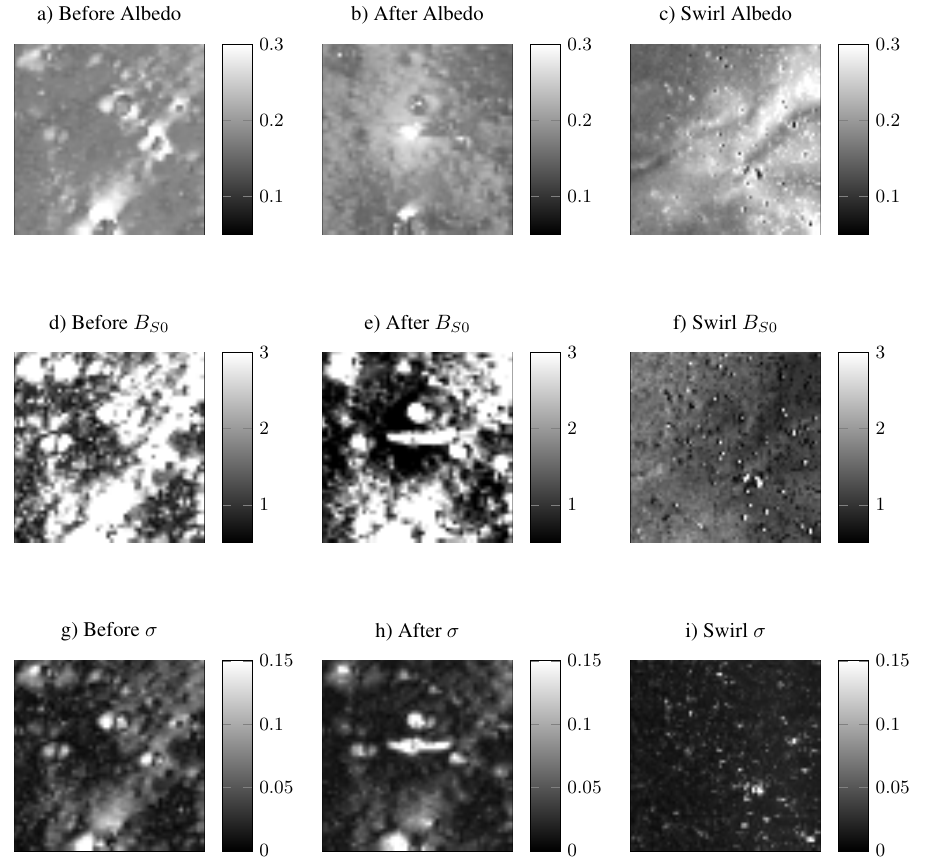
Figure 2: Maps of Hapke parameters.
Figure 3: Distribution of BS0 for the landing site after the landing and the Reiner Gamma swirl.
4. Conclusion
The landing of the Chang’e 5 rover on the Moon has changed the photometric properties of the surface. The albedo has increased and the shadow hiding opposition effect is less strong such that the phase curve has become flatter. This is generally the case for higher albedos but the reduction is nonetheless significantly even below the value expected for the brighter highlands [3]. Similarly, swirls show a reduced opposition effect. A physical explanation could be that the porosity of the regolith is reduced by fast-streaming gas from the landing rocket jet and from a passing comet, respectively (see [5]).
References
[1] B. Hapke (2012). Theory of reflectance and emittance spectroscopy, Cambridge.
[2] M.S. Robinson et al. (2010). Space science reviews, 150(1):81–124.
[3] H. Sato et al. (2014). JGR Planets, 119(8):1775–1805.
[4] Y.I. Velikodsky et al. (2016). Icarus, 275:1–15.
[5] V.V. Shevchenko (1993). Astronomy Reports, 37:314–319.
[6] J. Laura et al. (2022). URL https://doi.org/10.5281/zenodo.6329951.
[7] F. Scholten et al. (2012). JGR Planets, 117, E00H17.
[8] A. Grumpe et al. (2014). Advances in Space Research, 53(12):1735–1767.
[9] J. Salvatier et al. (2016). PeerJ Computer Science, 2:e55.
[10] A. Gelman et al. (1995). Bayesian Data Analysis, Chapman and Hall/CRC.
How to cite: Hess, M., Wöhler, C., and Qiao, L.: Photometric Modelling for Chang’e 5 Landing Site and Reiner Gamma Swirl, Europlanet Science Congress 2022, Granada, Spain, 18–23 Sep 2022, EPSC2022-147, https://doi.org/10.5194/epsc2022-147, 2022.
Introduction: Several future missions to the Moon will be devoted to robotic and human explorations in search for ice deposits and other resourses. Ground Penetrating Radar (GPR) is considered a fundamental geophysical instrument to detect water ice inside the regolith and to map the distribution of the volatiles in the lunar polar regions. The success of GPR survey relies on the capability to discriminate between dry and ice-saturated regolith or to detect lenses of relatively pure water ice. To reach this goal an intense laboratory activity is required to characterize the radar response of the lunar regolith as a function of mineralogical composition and different physical conditions (e.g., compactions, temperature, ice content). Here, we present new dielectric measurements of lunar regolith simulants in a broad range of frequencies and for different soil porosities, to improve the interpretation of radar data collected on the Moon. Such measurements have been carried out in the framework of the PrIN INAF “MELODY” (Moon multisEnsor and LabOratory Data analysis) research project, which is devoted to combining past and present lunar data to improve our knowledge on the lunar surface and shallow subsurface properties.
Laboratory measurements: GPR measurements allow one to retrieve signal wave velocity and attenuation in the lunar subsurface [1]. Such parameters are related to complex dielectric permittivity and magnetic permeability, from which some chemical-physical properties of the lunar soil and rocks can be inferred. We apply dielectric spectroscopy techniques for two pairs of commercially available, certified lunar soil analogues (Exolith Lab, 2021a, 2021b) [2, 3] to characterize the radar response of the regolith as a function of mineralogical composition and different physical conditions (e.g., temperature, porosity, and ice content). The investigation of these analogues helps us understand the most reliable lunar soil. Such analogues reproduce the composition of both lunar maria and highlands. The maria analogues are LMS-1D (particle size < 0 – 30 μm) and LMS-1 particle size < 0.04 – 300 μm). The highlands soil simulants are LHS-1D (particle size < 0.04 – 35 μm) and LHS-1 (particle size < 0.04 – 400 μm). The analogues mineralogy are reported in Tab. 1 and Tab. 2.
The measurements are performed at room temperature in the frequency range 100 kHz to 3 GHz, using a Vector Network Analyzer VNA (Agilent E5071C). The VNA ultimately provides the the electromagnetic parameters of the simulant through the Nicholson-Ross-Weir algorithm (NRW) [4]. This method allows one to retrieve both complex dielectric permittivity and magnetic permeability; however due to the negligeble magnetic properties of the samples, here only the dielectric permittivity is reported. Measurements are performend with a coaxial probe line characterized by a multiwire shield cage. Regolith analogues were first oven-dried at 105°C for 24 hours to remove residual water; then the samples are inserted in the teflon cage and different compaction are obtained through a vibration plate.
Results and future work: Fig. 1 (a and b) report the real and imaginary parts of the dielectric permittivity as a function of frequency for the Maria simulant having the smallest particle size range. Fig. 2 (a and b) illustrates the same parameters for the highland simulant. Note that for the two samples a different range of compaction is obtained. The real part of permittivity is frequency independent and decreases with increasing porosity because of the air trapped in the pores, as expected. For lunar maria it ranges from 1.8 to 2.2 (𝜙 from 70% to 60%), while the highland simulant shows higher values between 2.3 and 2.9 (𝜙 from 56% to 44%). Re- garding the imaginary part, it does not show a dependency on porosity, while it shows the same trends at every compaction over the frequency range for both simulants. The next step of the project will be the characterization of the dielectric behaviour of the simulants in a broad range of temperatures (200K – 373K).
Acknowledgements: We acknowledge support from the research project: “Moon multisEnsor and LabOratory Data analYsis (MELODY)” (PI: Dr. Federico Tosi), selected in November 2020 in the framework of the PrIN INAF (RIC) 2019 call.
References: [1] Jol, Harry M., ed. Ground penetrating radar theory and applications. elsevier, 2008. [2] Exolith Labs, U. of C.F LMS-1 Lunar Mare Simulant Spec Sheet (2021). [3] Exolith Lab, U. of C.F LHS-1 Lunar Highland Simulant Spec Sheet (2021). [4] Nicolson, A. M., & Ross, G. F. (1970). Measurement of the intrinsic properties of materials by time-domain techniques. IEEE Transactions on instrumentation and measurement, 19(4), 377-382.
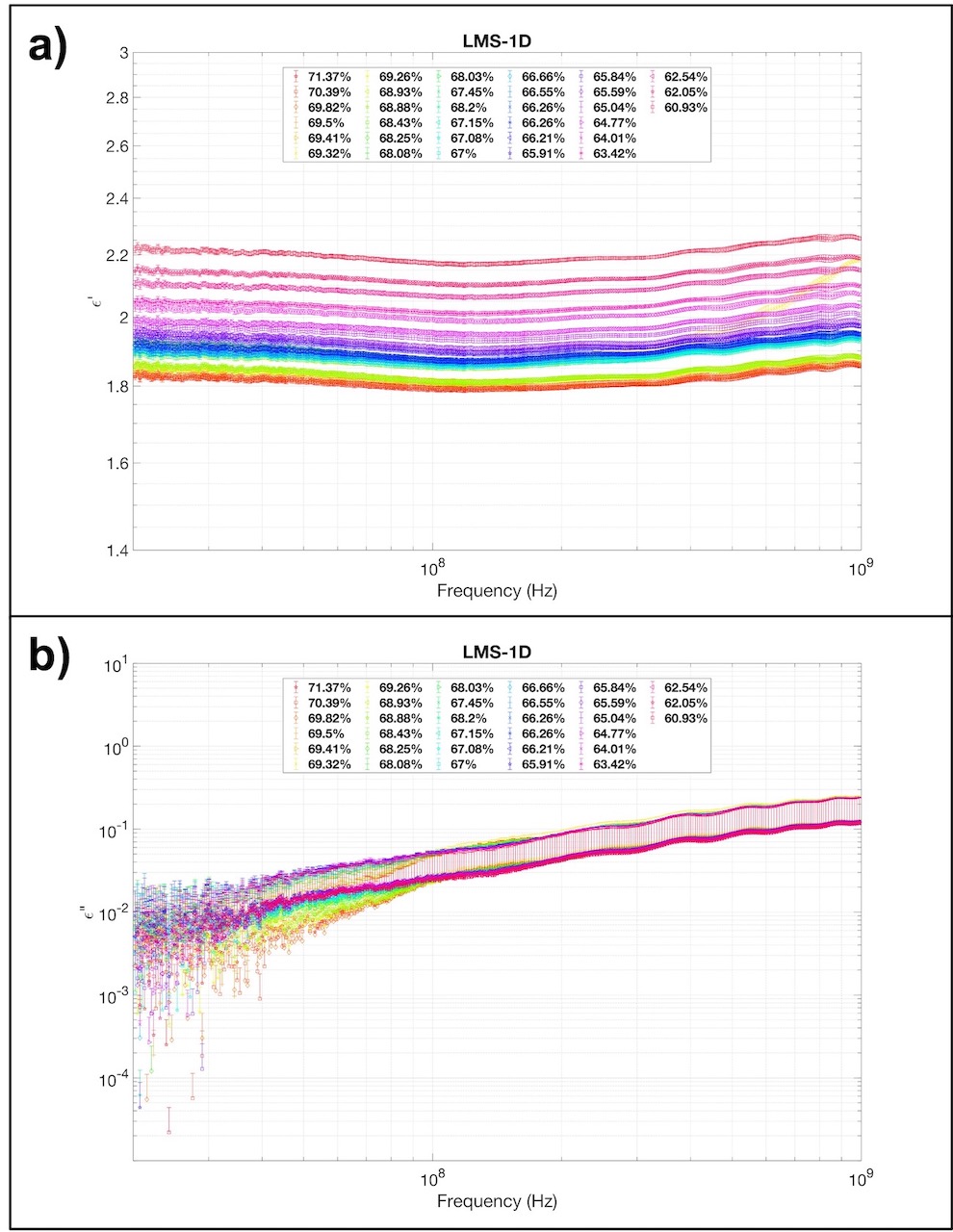
Figure 1: Real (a) and Imaginary (b) part of the permittivity as function of frequency of sample LMS-1D at varying compaction.
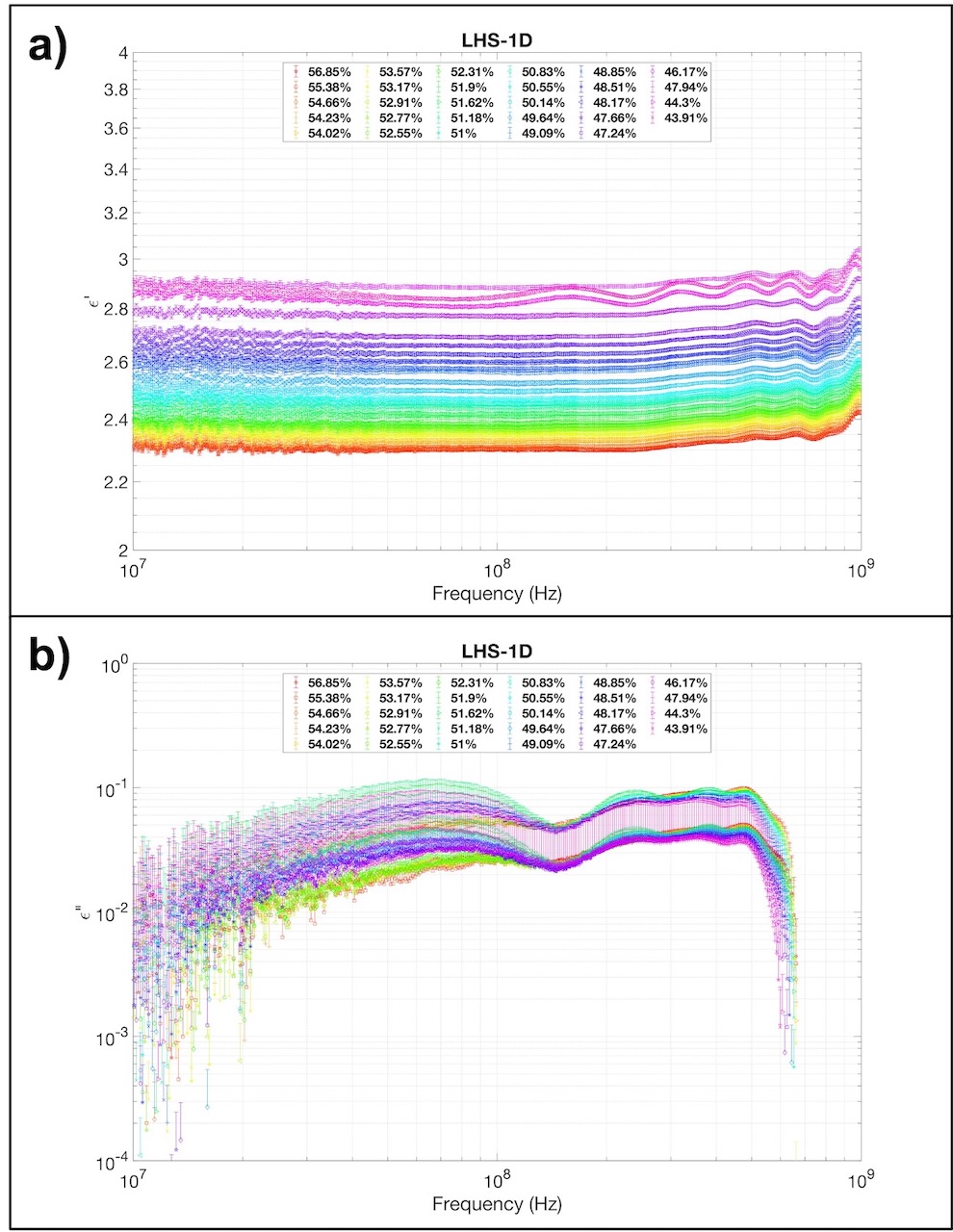
Figure 2: Real (a) and Imaginary (b) part of the permittivity as function of frequency of sample LHS-1D at varying compaction.
Table 1: Mineralogy of lunar Highlands analogues LHS-1 and LHS-1D.
Table 2: Mineralogy of lunar Maria analogues LMS-1 and LMS-1D
How to cite: Martella, C. H., Cosciotti, B., Lauro, S. E., Mattei, E., Tosi, F., and Pettinelli, E.: Dielectric measurements of lunar soil analogues at different compactions within the Melody project., Europlanet Science Congress 2022, Granada, Spain, 18–23 Sep 2022, EPSC2022-243, https://doi.org/10.5194/epsc2022-243, 2022.
This study investigates the lunar plasma environment when embedded within Earth's magnetotail. We use data from 10 years of tail crossings by the Acceleration, Reconnection, Turbulence, and Electrodynamics of the Moon's Interaction with the Sun (ARTEMIS) spacecraft in orbit around the Moon. We separate the plasma environments by magnetosheath-like, magnetotail lobe-like, and plasma sheet-like conditions. Our findings highlight that the lobe-like plasma is associated with low densities and a strong magnetic field, while the plasma sheet is characterized by higher densities and a weaker magnetic field. These regions are flanked by the fast, predominantly tailward flows of the terrestrial magnetosheath. During a single lunar crossing, however, the magnetotail displays a wide range of variability, with transient features—including reconnection events—intermixed between periods of lobe-like or sheet-like conditions. We compare and contrast the Moon's local magnetotail plasma to the environments near various outer-planet moons. In doing so, we find that properties of the ambient lunar plasma are, at times, unique to the terrestrial magnetotail, while at others, may resemble those near the Jovian, Saturnian, and Neptunian moons. These findings highlight the complementary role of the ARTEMIS mission in providing a deeper understanding of the plasma interactions of the outer-planet moons.
How to cite: Liuzzo, L., Poppe, A., and Halekas, J.: A statistical study of the Moon's magnetotail plasma environment, Europlanet Science Congress 2022, Granada, Spain, 18–23 Sep 2022, EPSC2022-291, https://doi.org/10.5194/epsc2022-291, 2022.
Introduction:
Analyses of samples returned by the Apollo Program have provided fundamental insights into the origin-history of the Earth-Moon system and how planets and solar systems work. Several special samples that were collected or preserved in unique containers or environments (e.g., Core Sample Vacuum Container (CSVC), frozen samples) have remained unexamined by standard or advanced analytical approaches. The Apollo Next Generation Sample Analysis (ANGSA) initiative was designed to examine a subset of these samples. The initiative was purposely designed to function as a participating scientist program for these samples, and as a preparation for new sample return missions from the Moon (e.g., Artemis) with processing, preliminary examination (PE), and analyses utilizing new and advanced technologies, lunar mission observations, and post-Apollo science concepts. ANGSA links the first generations of lunar explorers (Apollo) with future generations of lunar explorers (Artemis) [1-4].
Progress and Results:
Teamwork for gas extraction from CSVC 73001: To extract any potential gas phase from the CSVC, the European Space Agency (ESA) designed, built, tested, and delivered to JSC a CSVC piercing tool. To collect-store the gas phase, WUStL designed, built, and delivered to JSC a gas manifold system. Together these tools were used to open and sample the CSVC. Preliminary analyses of these gases are being carried out at UNM (Z. Sharp) and WUStL (R. Parai), which will determine whether a lunar component can be detected in the gas.
Extrusion of 73001: Following extraction of gas, the lower part of the double drive tube (73001) was imaged (µXCT, multi-spectral imaging), extruded, dissected, sieved, and examined (Pass 1 and 2). Pass 3 will remain unsieved and will be a target for PE by early career ANGSA scientists-engineers. ANGSA team members participated in the PE of 73002.
Frozen samples: The cold curation facility for processing Apollo 17 frozen samples was approved in mid-December 2021. These samples were processed and allocated in early 2022. Studies are advancing to define differences in preservation of (a) volatiles between frozen and unfrozen samples; (b) thermoluminescence kinetics in lunar samples [e.g., 5]; and (c) chronology.
Stratigraphy of 73001-73002: The stratigraphy of the double drive tube has been examined by multiple approaches. For 73001-73002, the stratigraphy was documented by µXCT imaging [6], reflectance properties [7,8], IS/FeO [8], major, minor, and trace element geochemistry [9,10], grain size/modal proportions [8,11,12], and continuous thin sections [13].
µXCT imaging of lithic fragments: Lithic fragments >4 mm in size were removed from the double drive tube during sampling passes 1-2 (73001-73002); from unsieved Pass 3 > 1cm fragments were removed. µXCT images of hundreds of these lithic fragments were produced. Fragments include a variety of breccias (some with a significant number of spherical glasses), high-Ti basalts with different cooling histories, a variety of “lower-Ti” basalts, and unique lithologies presumably derived from the South Massif. The ANGSA lithic analysis group is carrying out collaborative studies of these fragments [6,14].
Less than 1mm lithic fragments: During processing of Passes 1 and 2 from the double drive tube, samples were sieved into > 1 mm and < 1 mm size fractions. The < 1 mm size fractions were further sieved into 1000-500, 500-250, 250-150, 150-90, 90-20, and <20µm size fractions for selected intervals. In addition to determining modes of each size fraction within the stratigraphy, lithic fragments were also classified and documented. Impact melt rocks and breccias were abundant. Igneous lithologies include ferroan anorthosites, Mg-suite, “felsites”, low-Ti basalts, pyroclastic glasses, and a variety of high-Ti basalts [11,12,15]. Observations (e.g., volatiles, stable isotopes, organics, cosmogenic radionuclides, space weathering) were placed within the context of core stratigraphy [e.g., 16-21].
References: [1] Shearer et al. (2020) 51st LPSC abst.#1181 [2] Shearer (2008) Presentation to CAPTEM. [3] Shearer et al. (2019) 50th LPSC abst. #1412. [4] G. Lofgren (2007) personal communication. [5] Sehlke et al (2022) 53rd LPSC abst. #1267.[6] Zeigler et al. (2022) 53rd LPSC abst.#2890. [7] Sun et al. (2022) 53rd LPSC abst. #1890. [8] Morris et al. (2022) 53rd LPSC abst. #1849. [9] Neuman et al. (2022) 53rd LPSC abst.#1389. [10] Valenciano et al. (2022) 53rd LPSC abst.#2869. [11] Simon et al. (2022) 53rd LPSC abst.#2211. [12] Cato et al. (2022) 53rd LPSC abst.#2215. [13] Bell et al. (2022) 53rd LPSC abst.#1947. [14] Yen et al (2022) 53rd LPSC abst.#1547. [15] Valencia et al. (2022) 53rd LPSC abst#2608. [16] Cano et al. (2021) AGU Fall Meeting abst.; [17] Gargano et al. (2022) 53rd LPSC abst#2450 . [18] Recchuiti et al (2022) 53rd LPSC abst.#2193. [19] Elsila et al. (2022) 53rd LPSC abst.# 1212. [20] Welten et al. (2022) 53rd LPSC abst.#2389. [21] McFadden et al. (2022) 53rd LPSC abst. #1539.
How to cite: Shearer, C. and Zeigler, R. and the ANGSA Science Team: Using an analog lunar sample return mission to grow a lunar sample community and prepare for human return to the Moon’s surface. An update on the progress of the ANGSA initiative., Europlanet Science Congress 2022, Granada, Spain, 18–23 Sep 2022, EPSC2022-747, https://doi.org/10.5194/epsc2022-747, 2022.
- Introduction
When solar wind hits the lunar surface, a fraction of it is reflected back from the Moon instead of being absorbed by its surface. Evidence of neutral hydrogen atoms [1] and solar wind protons [2] being reflected from the surface are provided by numerous studies; however, no measurements of negative ions have been done so far. It is unknown whether or not a significant negative ion population exists near the lunar surface. The Negative Ions at the Lunar Surface (NILS) instrument, the first-ever dedicated negative ion instrument flown beyond the Earth, will address this question. NILS is being developed at the Swedish Institute for Space Physics for the Chinese Chang’E-6 sample return mission. Chang’E-6 is expected to launch in 2024 and will soft-land on the lunar far-side at approximately 41°S and 180°E. NILS will operate at least 30 minutes after the landing to achieve its main science objective. NILS operations will end with the lift-off of the sample return module.
- Main science objective
Negative ions are a not yet observed plasma component at the Moon. NILS’s main objective is to detect negative ions emitted from the lunar surface as a result of the interaction with solar wind and establish the upper limits for their fluxes. That requires NILS to distinguish and resolve the energy distributions of scattered H- and sputtered lunar negative ions, as well as to coarsely resolve different mass groups. The overarching scientific question is to estimate the importance of negative ions for space-surface interactions and environments of planetary bodies with surface-bound exospheres.
- Instrument design
NILS is the 9th generation of the SWIM family [3], a series of compact, adaptive, and capable mass spectrometers analysing ions, electrons or energetic neutral atoms at the sub-keV energy range. NILS combines a compact electrostatic analyser and a time-of-flight cell to measure the energy per charge and the mass per charge of incident ions. An additional deflection system consisting of two cylindrical electrodes allows for a one-dimensional 160° scanning of the viewing direction. NILS instantaneously records negative ions and electrons from a single direction and requires electrostatic scanning to change the viewing direction. Negative ions and electrons can be separated by an electron suppression system placed between the deflection system and the first-order focusing 127° long cylindrical electrostatic analyser. The latter is equipped with micro serrations on the outer electrode to maximize suppression of UV photons and scattered particles.
Prior to entering the time-of-flight cell, ions are post-accelerated by a -400V potential improving the sensor detection efficiency. The time-of-flight start signal is generated by a channel electron multiplier, which detects the secondary electrons generated when that particle is interacting at grazing incidence with a tungsten single crystal start surface. After the reflection on the tungsten surface, the particle travels to a stop surface, where a second secondary electron is generated that then subsequently is detected by a second channel electron multiplier, providing the time-of-flight stop signal. The time difference between the start and stop signals combined with the energy setting of the electrostatic analyser allows determining the mass per charge of the particle.
- References
[1] M. Wieser, S. Barabash, Y. Futaana, M. Holmström, A. Bhardwaj, R. Sridharan, M. B. Dhanya, A. Schaufelberger, P. Wurz, and K. Asamura. First observation of a mini-magnetosphere above a lunar magnetic anomaly using energetic neutral atoms. Geophys. Res. Lett., 37(5), 03 2010.
[2] Y. Saito, S. Yokota, T. Tanaka, K. Asamura, M. N. Nishino, M. Fujimoto, H. Tsunakawa, H. Shibuya, M. Matsushima, H. Shimizu, F. Takahashi, T. Mukai, and T. Terasawa. Solar wind proton reflection at the lunar surface: Low energy ion measurement by map-pace onboard selene (kaguya). Geophys. Res. Lett., 35, 12 2008.
[3] M. Wieser and S. Barabash. A family for miniature, easily reconfigurable particle sensors for space plasma measurements. Journal of Geophysical Research: Space Physics, 2016
How to cite: Canu-Blot, R., Wieser, M., and Barabash, S.: The Negative Ions at the Lunar Surface (NILS): first dedicated negative ion instrument on the Chang’E-6 mission to the Moon., Europlanet Science Congress 2022, Granada, Spain, 18–23 Sep 2022, EPSC2022-992, https://doi.org/10.5194/epsc2022-992, 2022.
TP4 | Mars Surface and Interior
Introduction: Mars is a primary destination to search for signs of life and probing the subsurface is a key element in this search. Access to the Martian subsurface, under most altered layers, is needed to understand the nature, timing and duration of alteration and sedimentation processes on Mars, as well as habitability conditions. For such a reason, ExoMars rover mission includes a drill to collect subsurface samples and has a complex payload able to conduct detailed investigations of composition, search for organics, and recognize indicators of past or extant life[1]. The drill is a critical element of the mission which will explore and collect samples down to 2 m of depth. An essential part of the payload is Ma_MISS (Mars Multispectral Imager for Subsurface Studies) experiment hosted by the drill system[2,3]. Ma_MISS is a Visible and Near Infrared miniaturized spectrometer with an optical head inside the drill tip capable of observing the borehole from where samples are collected.
Ma_MISS instrument description: Ma_MISS miniaturized spectrometer is hosted inside the drill system of the ExoMars rover and will characterize the mineralogy and stratigraphy of the excavated borehole wall at different depths (up to 2 m).
|
Ma_MISS is a modular instrument, and it consists of two main parts: (i) the spectrometer with the PE located outside of the drilling tool, and (ii) the Optical Head (OH) and fibers located inside the drill itself (Fig.1). The Drill consists of a main rod and three additional rods to reach a maximum depth of 2 m. The drill tip also has the Ma_MISS OH with a sapphire window to observe the borehole wall. All the rods are equipped with optical fibers to transmit light and signal. Ma_MISS is equipped with a light source of 5W and the illumination spot is about 1 mm at a focal distance of about 0.6 mm. The reflected light is collected through a 120 μm spot. The spectrometer observes a single point on the borehole wall and, using the drill movements, can build up images of the target. By combining several column and ring observations, Ma_MISS allows the reconstruction of a complete image of the borehole wall (Fig.2). Ma_MISS spectral characteristics and fine spatial resolution enable the in situ investigation of rocks, prior the sample collection, that will be manipulated and crushed for further analysis by the analytical laboratory. Thus, Ma_MISS is the instrument that will closely investigate the mineralogical characteristics of Mars subsurface material in its original geologic context.
|
What mineralogy is expected in the subsurface ? Ma_MISS will investigate deeper into the subsurface than prior rover missions. Viking and Phoenix landers scooped materials from the upper few centimeters for compositional analysis. The MER excavated trenches up to 11 cm deep[4] and collected data with the alpha-particle x-ray spectrometer and Mossbauer instruments. The MERs [5] grounded up to 9 mm deep and revealed coatings enriched in S, Cl, Zn and Ni and iron oxides on outer rock surfaces. The MER data from the subsurface show that those soils had high ferric sulfate contents or silica contents, likely signaling an influence from volcanic or hydrothermal processes[6,7]. Mars Science Laboratory (MSL) drilled several holes into the Martian surface demostraing differences between the surface and the subsurface, as shown in the colors of the excavated fines, mainly linked with the oxidation state of the materials[8]. Most interesting is the fact that well preserved organic material was discovered at Pahrump Hills , even with the very harsh surface conditions, suggesting even better preservation may be possible farther beneath the Martian surface[9].
Differently from the previous missions, the drill and Ma_MISS measurements will be the deepest compositional measurements made on Mars. Ma_MISS is able to detect compositional gradients with depth, changes in type and abundance of minerals, weathering fronts or rinds, and diagenetic veins or nodules. The spectral range of Ma_MISS is optimal to detect changes in the occurrence and crystal chemistry of olivines and pyroxenes as well as Fe(II)/Fe(III) in silicates, oxides, and salts. There may be changes in these redox sensitive minerals with depth that record different environments. Furthermore, changes in the hydration state of materials can be also detected. For Oxia, the study of the subsurface could provide information on depositional regimes in zones not too far from the delta deposits, using the granulometric variation with dept.This will help to reconstruct the paleoenvironments that have characterized Oxia Planum.
In addition, at sufficient concentrations, organic molecules will also be detectable [10]: depending on the kind of organic, Ma_MISSis capable to detect their presence even when a 1 wt.% in the mixture, as verified by specific tests in the laboratory using the Ma_MISS breadboard. Spectroscopic measurements on these mineral/organic mixtures are useful to understand how the Ma_MISS instrument can detect traces of organic intimately mixed with minerals.
Conclusion: Ma_MISS will reconstruct the 3-D images of the borehole excavated by the ExoMars drill and will acquire spectra of the subsurface layers from which the sample will be collected. The calibration and tests performed with the flight model demonstrate the ability of the instrument in detecting most of the spectral signatures expected in Martian subsurface, including those due to the presence of possible salts and organics.
Acknowledgments. This work is fully funded and supported by the Italian Space Agency (ASI) [Grant ASI-INAF n. 2017-48-H.0].
References. [1] Vago et al. (2017) Astrobiology 17, 471–510. [2] De Sanctis, M. C. et al. (2017) Astrobiology, 17(6–7). [3] De Sanctis et al. (2022) PSJ in press. [4] Sullivan, R., et al.. (2011), J. Geophys. Res., 116, E02006; [5] Gorevan et al., (2003), J. Geophys. Res., 108, 8068; [6] Gellert, R and Yen, A.S, (2019) Remote Compositional Analysis, 10.1017/9781316888872, (555-572); [7] Morris et al., (2019), Remote Compositional Analysis, 10.1017/9781316888872, (538-554); [8] Abbey et al., (2020), Icarus, /doi.org/10.1016/j.icarus.2020.113885. [9] Eigenbrode et al., 2018, Science, doi/10.1126/science.aas9185, [10] Ferrari et al., 2022. In preparation.
How to cite: De Sanctis, M. C., Altieri, F., De Angelis, S., Ferrari, M., Frigeri, A., Fonte, S., Ammannito, E., Brossier, J., Giardino, M., Apuzzo, A., costa, N., and rossi, L.: Ma_MISS: a powerful tool for exploring the Martian subsurface, Europlanet Science Congress 2022, Granada, Spain, 18–23 Sep 2022, EPSC2022-104, https://doi.org/10.5194/epsc2022-104, 2022.
Introduction: Fresh Shallow Valleys (FSVs) are relatively undegraded dominantly mid-latitude valleys and valley networks that are generally shallowly incised (<20 m). into mantle substrate [1]. They are primarily of Hesperian to Amazonian age and are found in the mid-latitudes (30-50° N/S). The primary interpretation is formation through surface runoff of snowmelt, although a sub-ice hypothesis has been suggested for some crater-interior FSVs [2]. Exit-breach craters (EBCs), or pollywog craters, are relatively fresh craters primarily in the 1-7 km diameter range with no contributing drainage beyond the rim, and one or more exit valleys [1, 3].
Observations: Systematic ArcGIS mapping of FSVs and EBCs was conducted in the southern mid-latitudes using the Murray Lab CTX mosaic at a 1:100,000 scale. Of 1668 craters mapped as possible EBCs, 435 of these were designated as firm detections by having evident rim incision, visibly incised valleys, and no exterior contributing drainage. FSVs were mapped only exterior to craters, although many interior crater rims are dissected by FSV-like valleys. A total of 7276 FSVs were mapped averaging 7.2 km in length. Fig. 1a shows the latitudinal distribution of FSVs and EBCs and Fig. 1b the size distribution of EBCs. FSVs and EBCs have similar latitudinal distribution. To assess the possible hydrology of FSVs and EBCs, topographic relationships were analyzed using CTX and HRSC DTMs.
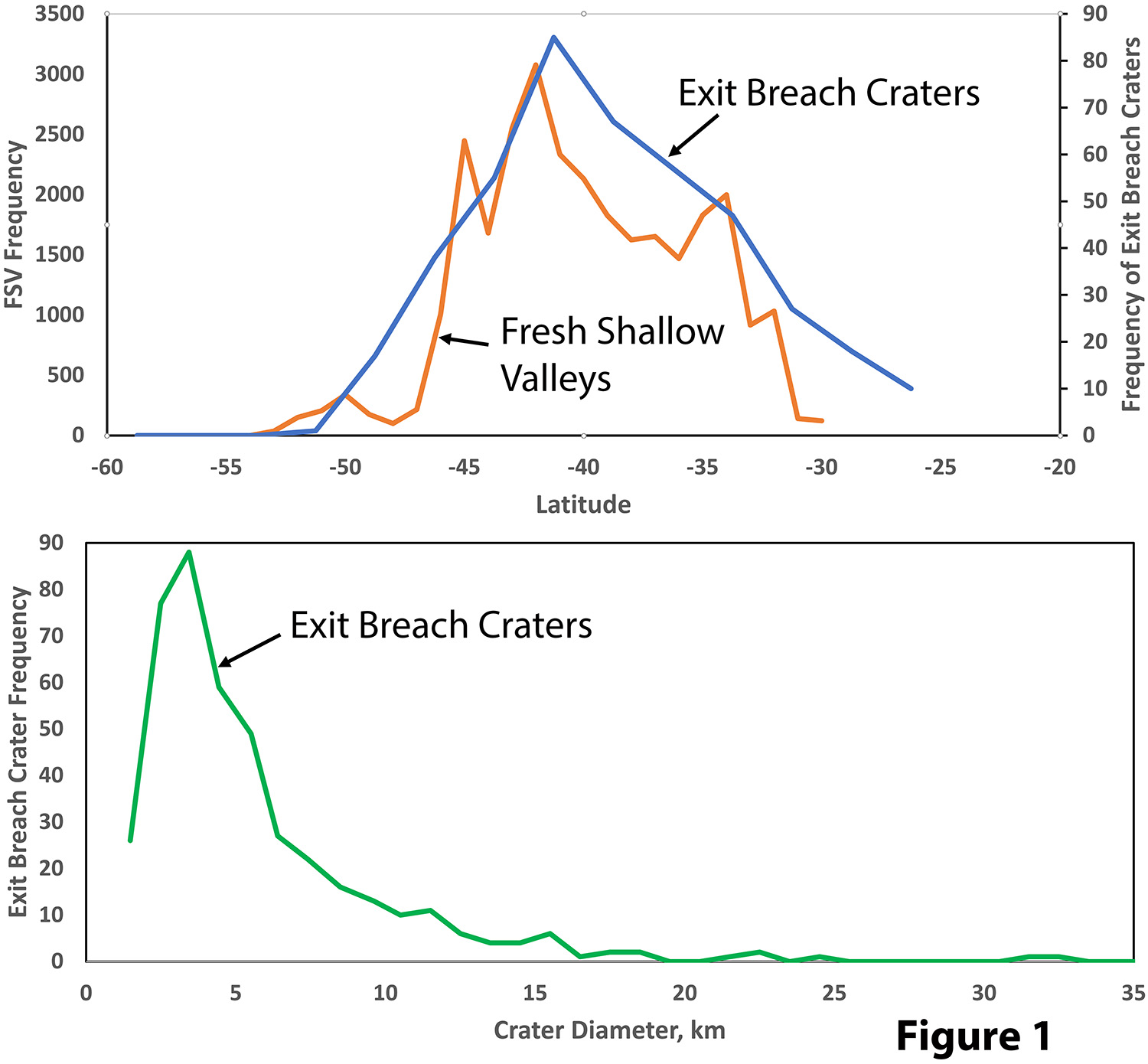
The most deeply incised FSVs occur across divides in settings connecting intercrater basins or connecting intercrater basins to crater interiors (Figs. 2 and 3). Fig. 2 shows FSVs on the northeast exterior rim of a 46 km diameter crater at 44.3°S, 165.2°W. The interior of the crater is indicated by “#”. A ~1 km wide valley leads from the exterior crater rim northward (white arrow). Three ~150m wide FSVs (“a”, “b” & “c”) extend from the valley axis east and northeast with gradients of about 0.04. Each of these FSVs breach the eastern rim of the north-trending valley. The depression on the exterior crater rim at “x” is drained by at least five east-trending FSVs that incise a low ejecta ridge.
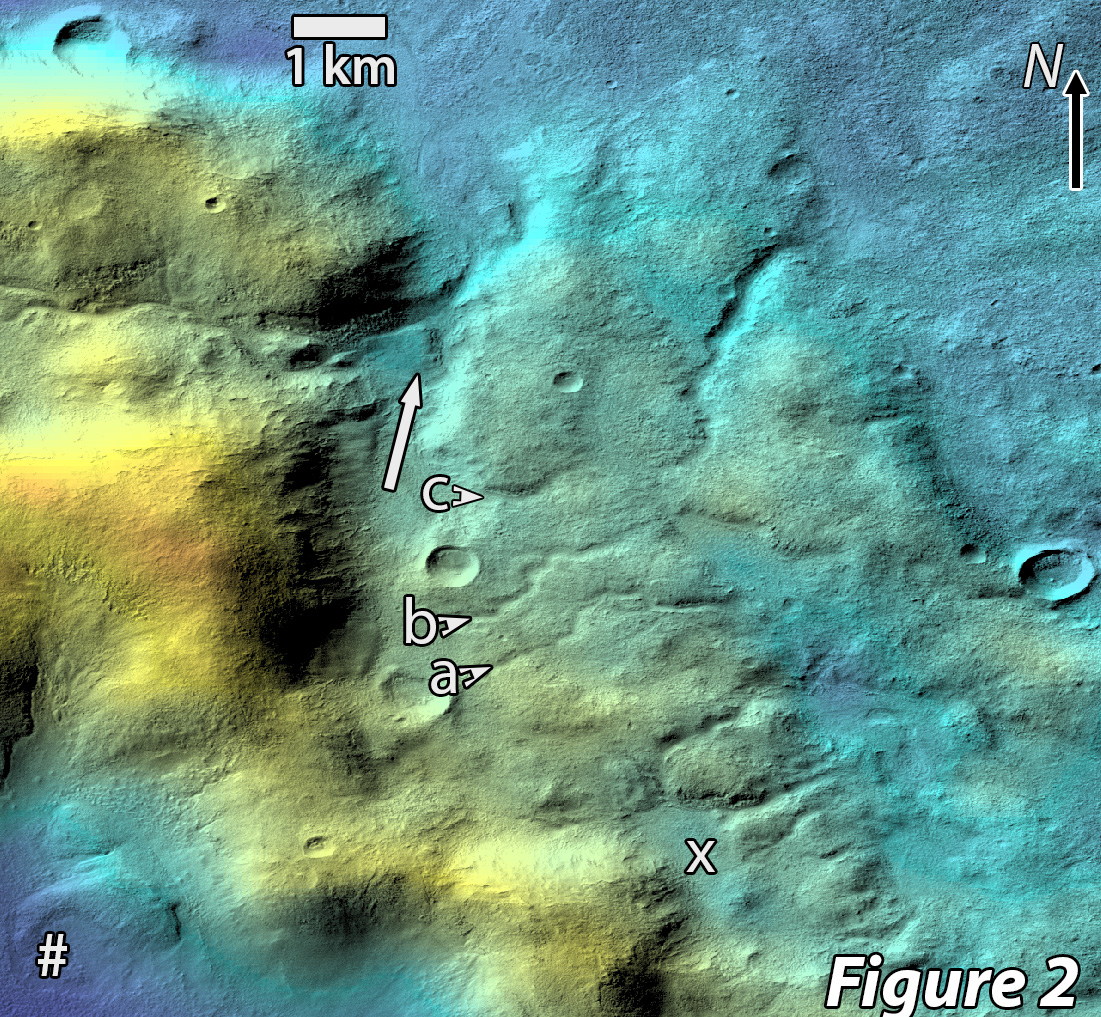
Fig. 3 is centered on the southeastern exterior rim of the same crater. Part of the crater rim is at “#”. The exterior rim depression “d” was drained by two FSVs, one of which extends to the rim depression at “a”. This basin in turn was drained by the FSV shown at the arrow, which incises through an exterior rim ridge at “b”. The lowpoint of the southern rim of basin “a” is at “c”, which is about 30 m lower that the elevation of the FSV rim breach at “b”.
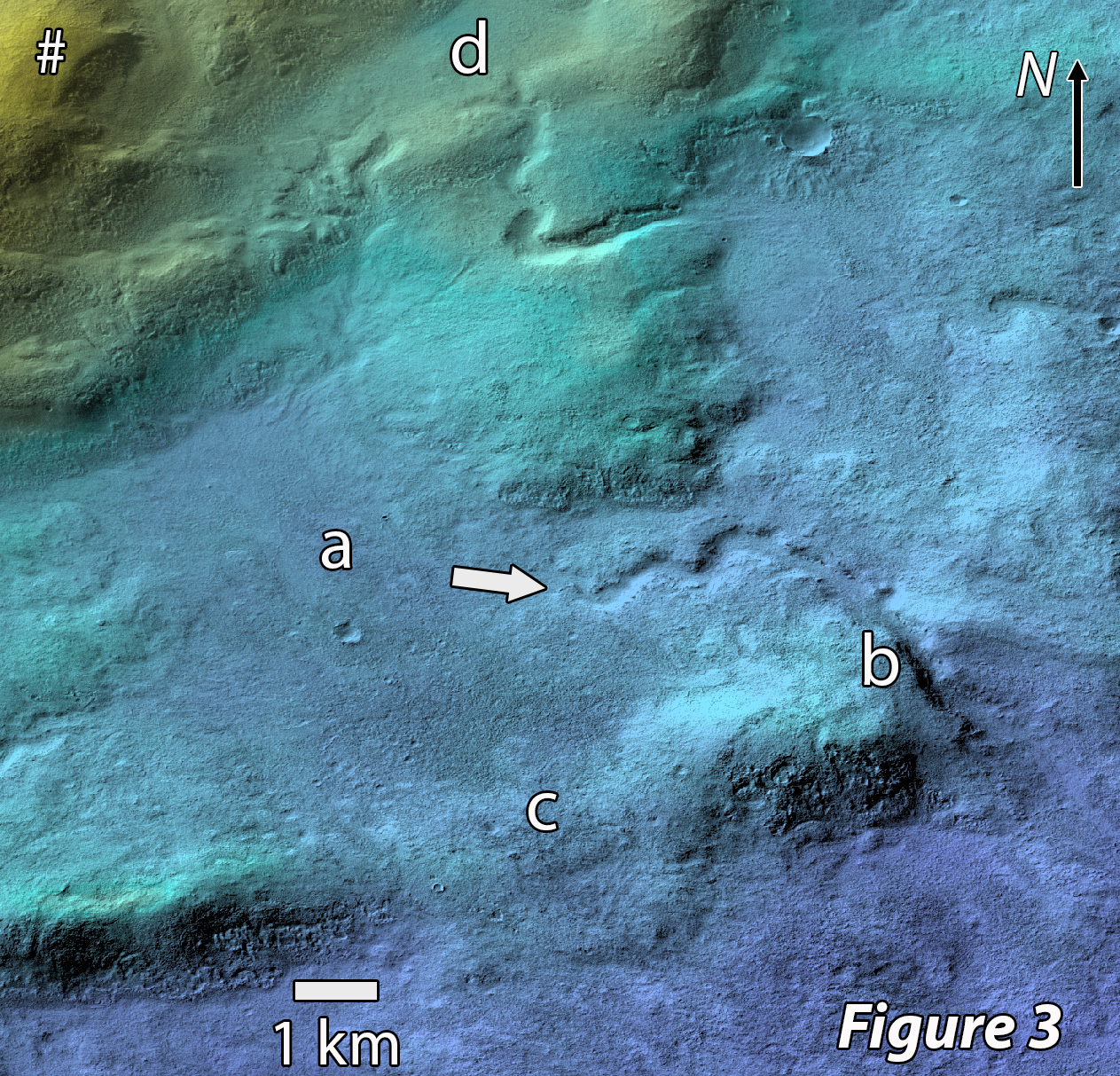
Most EBCs have a single exit breach, but some have multiple breaches. Fig. 4 shows an exit breach crater at 120.56°W, 43.88°S with a minimum of three exit breaches and possibly as many as seven.
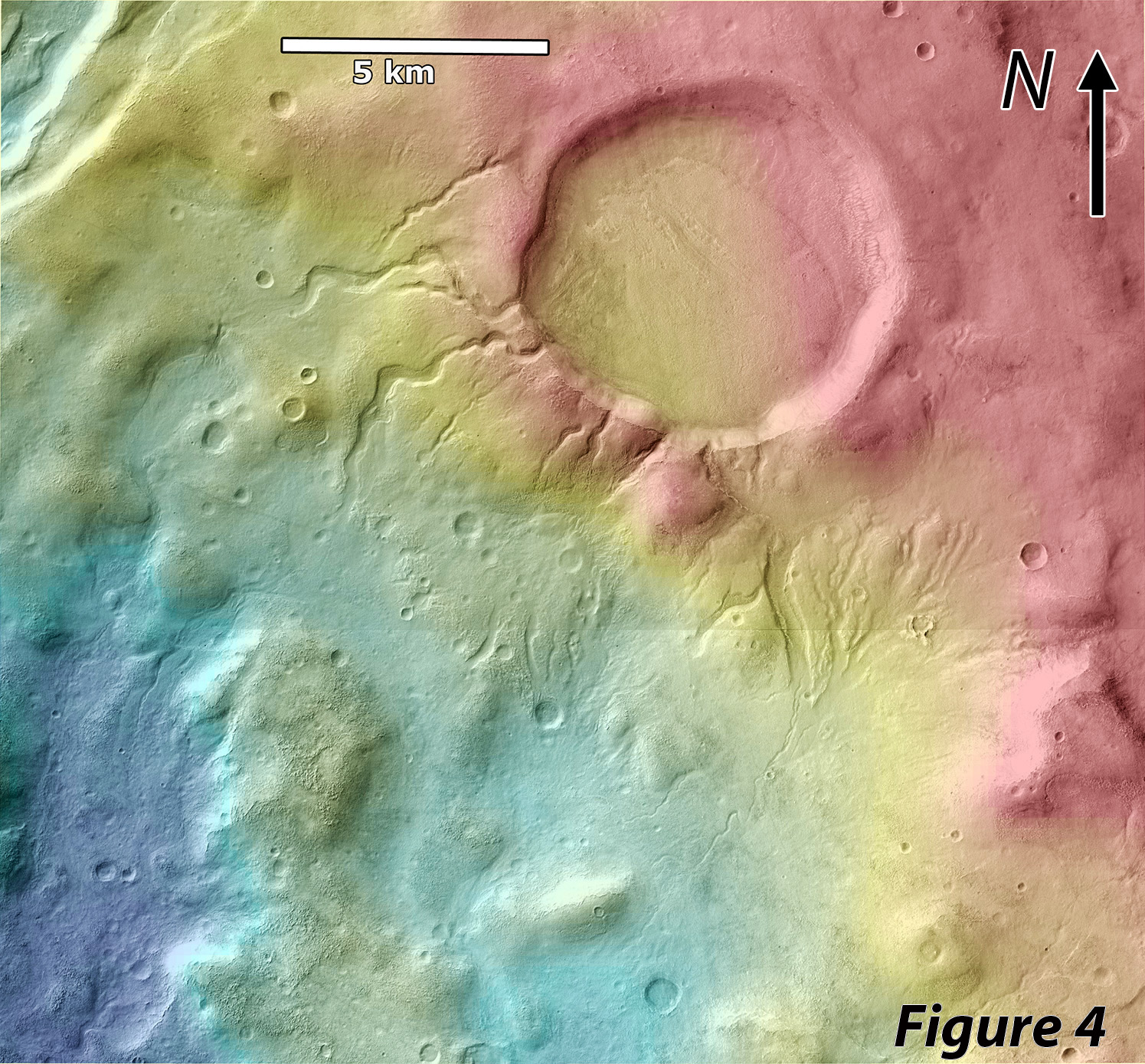
Analysis and Conclusions:
FSV morphology is distinct from typical terrestrial and the older martian valley networks: 1) they are mostly shallowly incised; 2) they are often isolated features; 3) depth of dissection is <20 m unless they cross divides; 4) many display sinuous planforms; 5) FSVs commonly connect basins across topographic divides, often through multiple breaches and extending to nearly the basin floor in both basins; 6) FSV divide breaches often do not occur at the topographic lowpoints between basins. The exit channels of EBCs are morphologically like FSVs and often accordantly drain into FSVs. As such, FSVs and EBCs probably share a common hydrological environment. Because of their relative youthfulness and mid-latitude environment, FSVs have been suggested to be fed from snowmelt, indicating a post-Noachian environment that could support occasional surface temperatures exceeding freezing [1, 4]. However, melting of seasonal or meter-scale snow cover does not readily account for FSVs breaching divides unless one of the basins overflowed.
EBCs are likewise enigmatic. Filling of craters by groundwater influx to overflow conditions has been suggested [1,3], but many EBCs occur on divides, as in Fig. 4. Filling of craters to overflow from precipitation (presumably melting of snow and ice) could lead to catastrophic breach incision [3, 5]. We suggest a common hydrological scenario for both FSVs and EBCs as resulting from episodic melting of a >100 m deep snow/ice cover accompanied by flow through basal ice tunnels (R-channels) [6]. Estimation of FSV discharge from gradient and meander wavelength using the approach of [7] suggests values <100 cumecs. In terrestrial glacial settings, divide-crossing subglacial channels generally create eskers due to bedload aggradation. On Mars, FSVs may be largely incised into fine-grained mid-latitude mantle deposits, so little coarse bedload would be entrained and channel beds might erode through scour or melting rather than aggrading. Divides breached by FSVs seldom exceed 50 m of relief relative to adjoining basins, suggesting 150-250 m of ice cover might be sufficient to support R-channel flows. Whether wider braided/anastomosing FSVs [1] can form beneath ice is uncertain. Perennial water might exist below the ice cover in the relatively undegraded EBCs, causing overflow either from surface ice accumulation or melt percolating through the ice cap. If flow rates overspilling EBCs are modest, rim incision may be restricted to removing the fine-grained mid-latitude mantle materials. The lack of large EBCs probably reflects insufficient ice cover to create overflow.
References: [1] Wilson, S. A. et al., (2016), JGR Planets 121, 1667-94, [2] Hobley, D. E. J. et al., (2014), JGR Planets 119, 128-53. [3] Warren, A. O. et al., (2021), EPSL 554, doi:/10.1016/j.epsl.2020.116671. [4] Howard, A. D., Moore, J. M., (2011), JGR 116, E05003. [5] Goudge, T. A. et al., (2021), Nature 597, 645-49. [6] Walder, J. S., (2010), J. Glaciol. 56, 1079-85. [7] Howard, A. D. et al., (2008), LPSC 39, Abs. 1629.
How to cite: Howard, A., Wilson, S., and Moore, J.: Fresh Shallow Valleys and Exit Breach Mid-Latitude Craters: Formation Below a Thick Ice Cover, Europlanet Science Congress 2022, Granada, Spain, 18–23 Sep 2022, EPSC2022-180, https://doi.org/10.5194/epsc2022-180, 2022.
MarsSI (“Mars Système d’Information”, french for Mars Information System) is a platform and service to explore, process and retrieve data from orbiters. https://marssi.univ-lyon1.fr/MarsSI. This poster aim to help user to understand and use this service.
Introduction
Geological investigations of planetary surfaces require the combination of orbital datasets. Missions being often multiple-instruments platforms from multiple space agencies, the quantity of data available increased quickly. MarsSI is a platform designed to explore, process and retrieve Mars orbital data. It was certified in 2017 as french national Research Infrastructure by the Centre National de la Recherche Scientifique (CNRS) as part of the Planetary Surface Portal (PSUP, <https://psup.cnrs.fr/>).
As of 2021, it indexes the optical (visible, multi and hyper-spectral) data from the recent orbiter missions, and allow to request the creation of Digital Elevation Models on demand. The focus, as highlighted by figure 1 is to allow the user to browse and request ”ready-to-use” products in regards of calibration, refinements and georeferencing. The user will be able to visualize and interpret the data in GIS or remote sensing software.
MarsSI
MarsSI aim to provide both a way to explore and use data from space agencies archives, such as the Planetary Data System (PDS), but also run data processing pipelines to make this data ready for analysis and as a shared, collaborative, repository. This allows a scientific user to more easily access data from their raw level and proceed to surface investigations and interpretation.
Explore datasets
MarsSI access is done through a web application. This interface, completely updated in 2021, provide a map where product footprints can be visualized over various backgrounds (MOLA, Themis, CTX) to put data in context. Instruments, and if needed, their acquisition modes, are available as layers to display.
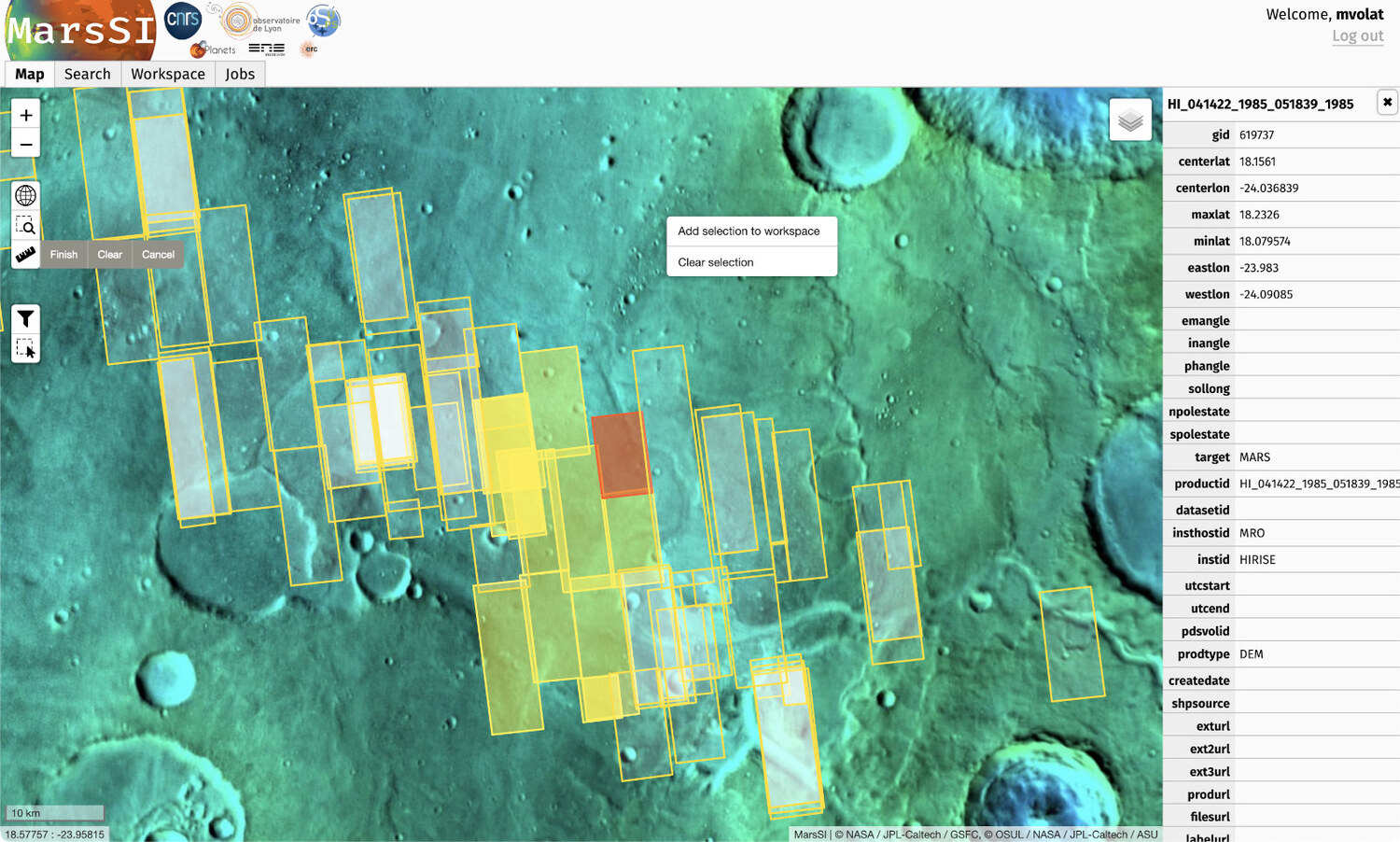
In this part of the interface, the user will be able to select products of interest and add them to a workspace summarizing the data he need to use.
Until now, MarsSI has focused on the most recent missions (ODY, MEX, MRO) optical datasets (visible, NIR, hyperspectral) and derived products.
Pipelines
Pipelines execution is done on demand, and requested from the workspace pane of the interface. Each type of product (based on instrument) has a specific pipeline defined. The pipelines are designed to be fully automated, run on MarsSI's computing cluster, and to not require any user input. This is done partially to ease the usage of the service, to avoid managing and storing multiple versions with slight differences that would make references to products more complex.
Basic pipelines operate to bring products to calibration and map projection (and georeferencing) steps. Those pipelines are usually based on ISIS (https://isis.astrogeology.usgs.gov/) for visible spectrum images.
More advanced pipelines allows to calibrate and create spectral parameter maps from CRISM hyperspectral cubes using the CRISM Analysis Toolkit (CAT, https://pds-geosciences.wustl.edu/missions/mro/crism.htm), and another to create stereophotogrammetry-derived DEMs from the CTX and HiRISE datasets (in complement of the pre-processed DEM datasets available) based on Ames StereoPipeline (https://ti.arc.nasa.gov/tech/asr/groups/intelligent-robotics/ngt/stereo/). One notable feature is that the DEM datasets are computed from the optical imagery datasets, showing all the stereo pairs deemed feasibles (based on overlap calculation and having a difference of incidence angle of at least 10°).
Documentation
MarsSI is documented through a wiki that provide information on both the platform usage and the products.
Conclusion
MarsSI (https://marssi.univ-lyon1.fr) aims to offer a way to the scientific communities to easily explore and perform the necessary processing steps for the data needed in their projects. MarsSI itself has seen superficial and architectural changes since it was recognized as part of a french national service, and aim to extend its datasets range in the future. Use of the service require registration that is free for a non-commercial usage.
Ackowledgements
MarsSI is a national Research Infrastructure, recognised as such by the French Ministry of Higher Education and Research. It was supported by the Programme National de Planétologie (PNP) of CNRS/INSU, co-funded by CNES. It was initialy supported by the European Research Council under the European Union’s Seventh Framework Program (FP7/2007-2013)/ERC Grant agreement No.280168.
How to cite: Volat, M. and Quantin-Nataf, C.: MarsSI: Martian surface data processing service, Europlanet Science Congress 2022, Granada, Spain, 18–23 Sep 2022, EPSC2022-213, https://doi.org/10.5194/epsc2022-213, 2022.
Introduction: Despite the large amount of information from orbital and in situ missions, the characteristics and evolution of Mars’ early climate are still widely debated among the scientific community. Morphological evidence dating back to about 3-4 billion years ago, such as valley networks [1], and the presence of several hydrated minerals [2] seem to indicate that Mars once had a “warm and wet” climate with abundant water on the surface and possibly even an ocean in the northern lowlands [1-3]. These conditions eventually changed through time leading up to the hyperarid and cold planet we observe today.
The area of Meridiani Planum (MP), located SW of Arabia Terra, is well known for retaining multiple evidence of past aqueous activity [4] and a varied hydrated mineralogy [5]. The majority of the terrains exposed in MP formed at the Noachian-Hesperian boundary [6], that is between two important epochs of Mars: the Noachian (4.1-3.7 Ga), where most of the evidence for water is found, and the Hesperian (3.7-3.0 Ga), which is characterized by increasingly water-limited conditions. Constraining the potential water environment at the NH boundary is fundamental to understand Mars’ early climate and its evolution.
In this study, we select 7 craters in Northern MP (figure 1) showing evidence of NH sediment infillings with hydrated materials (e.g., clays and sulfates) to assess in detail the stratigraphic sequence of the mineralogical units and understand their origin and diagenetic history. The craters are roughly aligned SE to NW following the general slope of the area from the highlands to the lowlands. If Mars experienced a “warm and wet” period, MP would represent a transition zone between the subaerial alteration environment of the highlands and the subaqueous environment of the Martian ocean. Therefore, the area would be easily affected by climatic changes whose evidence should be retained in its sedimentary sequences.
We show here some preliminary results from 2 out of the 7 craters selected for the study:
1) a 15-km-wide crater named Mikumi, centered at Lat. 2.45°N, Lon. 359.96°E;
2) an 18-km-wide unnamed crater centered at Lat. 4.25°N, Lon. 2.85°E.
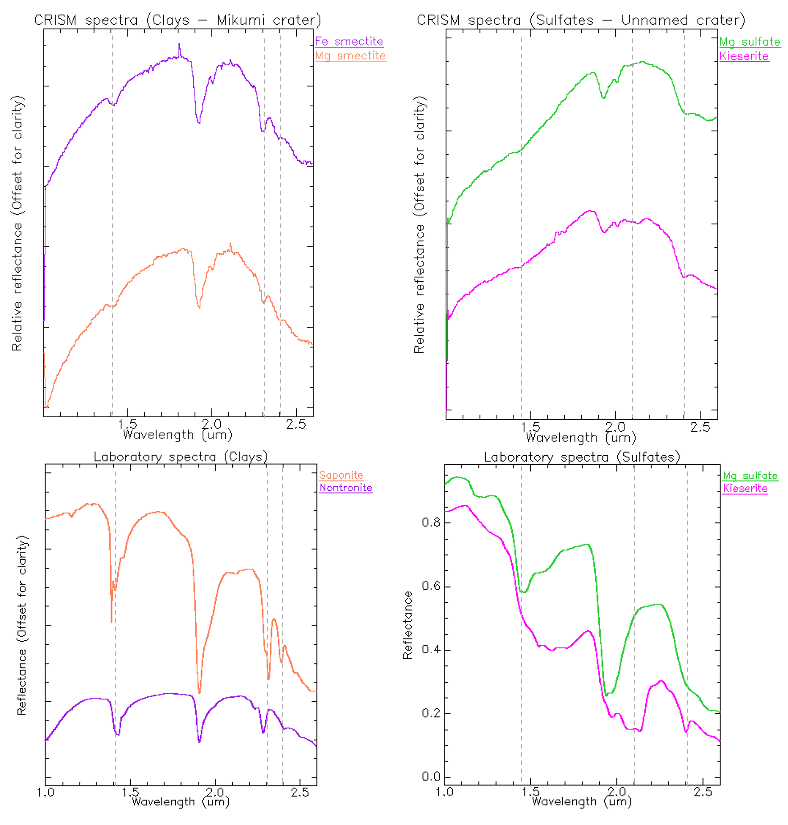
Figure 1: THEMIS daytime image of Meridiani Planum. Selected craters are evidenced with points. Name (if given) and coordinates of the center for each crater are also indicated with a label. Most of the craters are unnamed. The arrows indicate the two craters described in this abstract.
Datasets and methods: We investigate the mineralogy of the craters’ terrains through CRISM [7] hyperspectral data cubes mainly in the range 1.0-2.6 μm. This interval retains part of the key spectral features of primary rock-forming minerals, which constitute the Martian crust, and of most minerals produced by secondary processes such as aqueous circulation and alteration (e.g., clays and sulfates). MOLA, THEMIS, CTX and HiRISE data are then used for morpho-stratigraphy and camera imaging.
Results: Two types of clays (smectites) with different Fe/Mg content, polyhydrated sulfates and monohydrated sulfates are observed in both craters (figure 2). Fe/Mg-clay spectra (e.g., nontronite and saponite) show absorptions at around 1.4, 1.9 and 2.3 μm with additional overtones at 2.4 μm. The exact position of the 2.3 μm feature depends on the relative Fe/Mg content in the clay mineral. We find some areas with clays richer in iron (e.g., nontronite), showing this feature centered at 2.305 μm, and clays richer in magnesium (e.g., saponite) where the absorption is centered at 2.310-2.315 μm. In Mikumi crater, polyhydrated sulfates (Mg sulfate) and monohydrated sulfates (kieserite) are detected stratigraphically below the clay-bearing layer. For the unnamed crater, the stratigraphic relationship of the units is still to be investigated.

Figure 2: (top) CRISM spectra of detected mineralogy. Fe/Mg clays (smectites) are from Mikumi crater, mono and polyhydrated sulfates are from the Unnamed crater. The spectra are extracted from FRT0000BEF5 and FRT00009B5A TRR datasets respectively. (bottom) Laboratory spectra of clays and sulfates from the CRISM spectral library [8] (Mg Sulfate ID: CJB366; Kieserite ID: F1CC15; Saponite ID: LASA51; Nontronite ID: NCJB26).
Discussion and conclusions: Clays and sulfates on Mars appear to have formed at different times and under different climatic conditions [9]. Clays are usually associated to Noachian terrains and may have formed under alkaline conditions in a “warm and wet” ancient Mars, whereas sulfates are typically associated to Hesperian surfaces and may have formed under a dryer and more acidic environment. Therefore, sulfates are expected to be found stratigraphically on top of clays, as they should have formed later in Mars’ history. However, this distinction between a clay-rich Noachian and a sulfate-rich Hesperian oversimplifies the history of the aqueous chemistry and climate of Mars especially near the NH boundary.
Our analysis suggests a stratigraphic sequence with interleaving clays and sulfates at the NH boundary. Similar stratigraphic sequences have also been observed in other areas of MP (Southern MP) by [5]. In the case of [5], a clay-bearing layer is overlain by other sulfates, generating a sulfate/clay/sulfate stratigraphic sequence. All this argues is in favor of several distinct climatic episodes pacing the NH climatic transition.
The results obtained so far will be enriched by further analysis of these areas along with a thorough investigation of the remaining 5 craters selected.
Acknowledgments: Featured CRISM data were downloaded from the Planetary Data System (PDS). This project is partially supported by Europlanet RI20-24 GMAP project.
References: [1] M. H. Carr and J. W. Head (2010) Earth and Planet. Sci. Lett., 293, 185-203. [2] B. L. Ehlmann and C. S. Edwards (2014) Annu. Rev. Earth Planet. Sci., 42, 291-315. [3] R. A. Craddock and A. D. Howard (2002) JGR, 107 (E11), 5111. [4] R. M. E. Williams et al. (2017) GRL, 44, 1669-1678. [5] J. Flahaut et al. (2015) Icarus, 248, 269-288. [6] B. M. Hynek et al. (2002) JGR, 107 (E10), 5088. [7] S. Murchie et al. (2007) JGR, 112 (E5), E05S03. [8] C. E. Viviano-Beck et al. (2015) MRO CRISM Type Spectra Library, NASA Planetary Data System. https://crismtypespectra.rsl.wustl.edu [9] J. P. Bibring et al. (2006) Science, 312, 400-404.
How to cite: Baschetti, B., Massironi, M., Carli, C., Altieri, F., and Frigeri, A.: Clay and sulfate-bearing terrains in Northern Meridiani Planum, Mars: constraining the characteristics of Mars’ early climate at the Noachian-Hesperian boundary, Europlanet Science Congress 2022, Granada, Spain, 18–23 Sep 2022, EPSC2022-222, https://doi.org/10.5194/epsc2022-222, 2022.
The Curiosity rover of the Mars Science Laboratory has been exploring since mid-2021 the lower sulfate unit of Mount Sharp in the Gale crater. This unit, first described from orbital observations as showing spectral signatures of hydrated sulfate minerals [1], has recently been revealed to record a major paleoenvironmental and climatic transition during the Hesperian-Noachian transition, with the onset of alternating wet and dry conditions before a complete aridification of Martian conditions [2]. Before the current campaign, this unit was mainly studied using remote observations (e.g., [2, 3]), but Curiosity has now entered this major interval allowing to precisely study the rock record leading to this major climatic event.
Since the rover left the Glen Torridon area (aka the clay-bearing unit, Fig. 1), the Curiosity rover entered the sulfate-bearing unit (~Sol 3100, mid-2021; Fig. 1) and traversed sedimentary series mainly composed of fine to coarse sandstones. While no clear facies change or sharp contact has been observed when entering the sulfate-bearing unit, these levels differ from the previously observed terrains in Gale by an increased occurrence of nodular features with a strong sulfate geochemical signature [4, 5], polygonal ridges [4], or even halite detections [6]. Otherwise, the sedimentary structures and grain-size are continuous across the upper members of the Carolyn Shoemaker formation and into the overlying Mirador formation, indicating a likely continuity in the continental settings for most of these deposits.
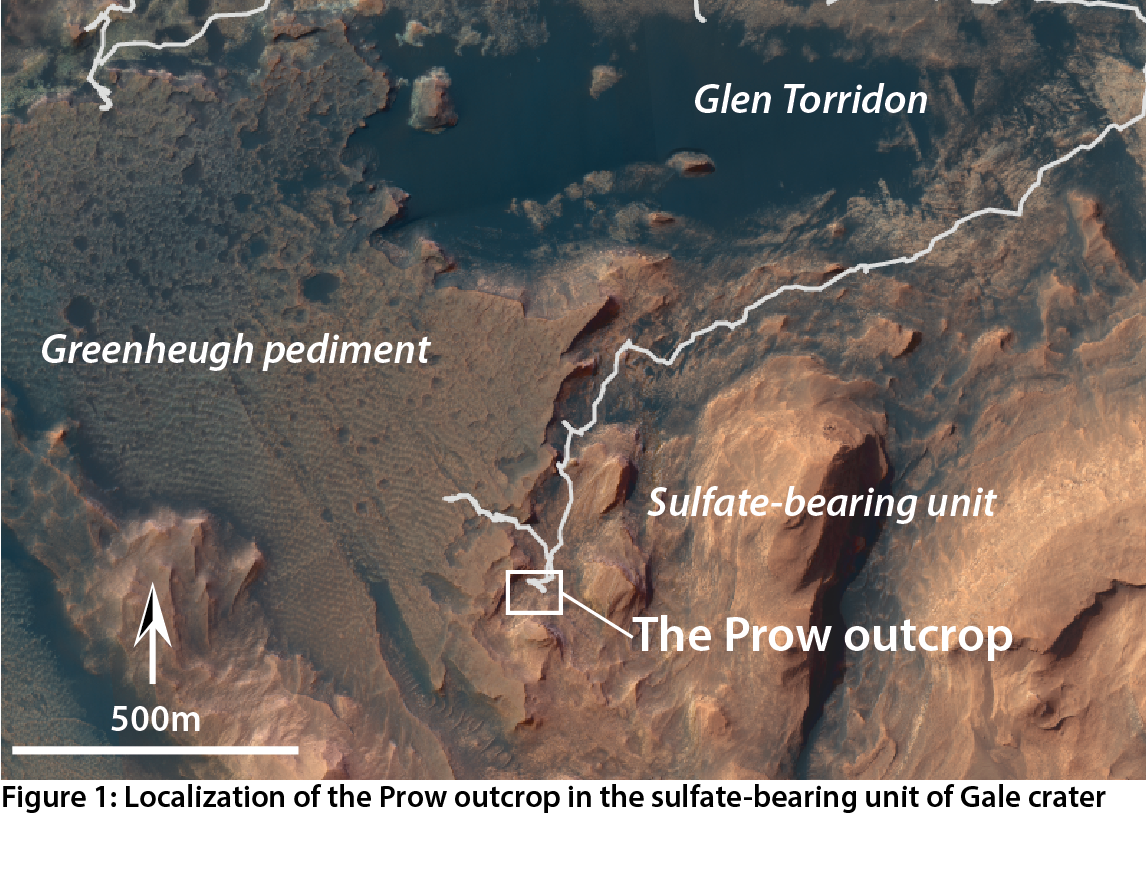
Such structures are notably well visible at the Prow locality, a major outcrop situated in the Contigo member of the Mirador formation, just below the Greenheugh pediment (Fig. 1). This outcrop has been reached and studied in January and February 2022, between sols 3349 and 3379. Using ~3200 mid- and close-range images from the Navigation and Mast cameras (Navcam, Mastcam), we used structure-from-motion photogrammetry to reconstruct a Digital Outcrop Model (following the method described in [7]) of the Prow locality and its vicinity (Fig. 2). This DOM covers an area of about 1000m². Two small excerpts of this DOM are explorable online on the Sketchfab platform at https://skfb.ly/o8DJZ and https://skfb.ly/otpLW. The DOM allows us to visualize and characterize several sets of meter- to centimeter-scale sedimentary structures, over about 30 meters of lateral continuity, either using on-screen visualization, or integrated within a Virtual Reality environment.
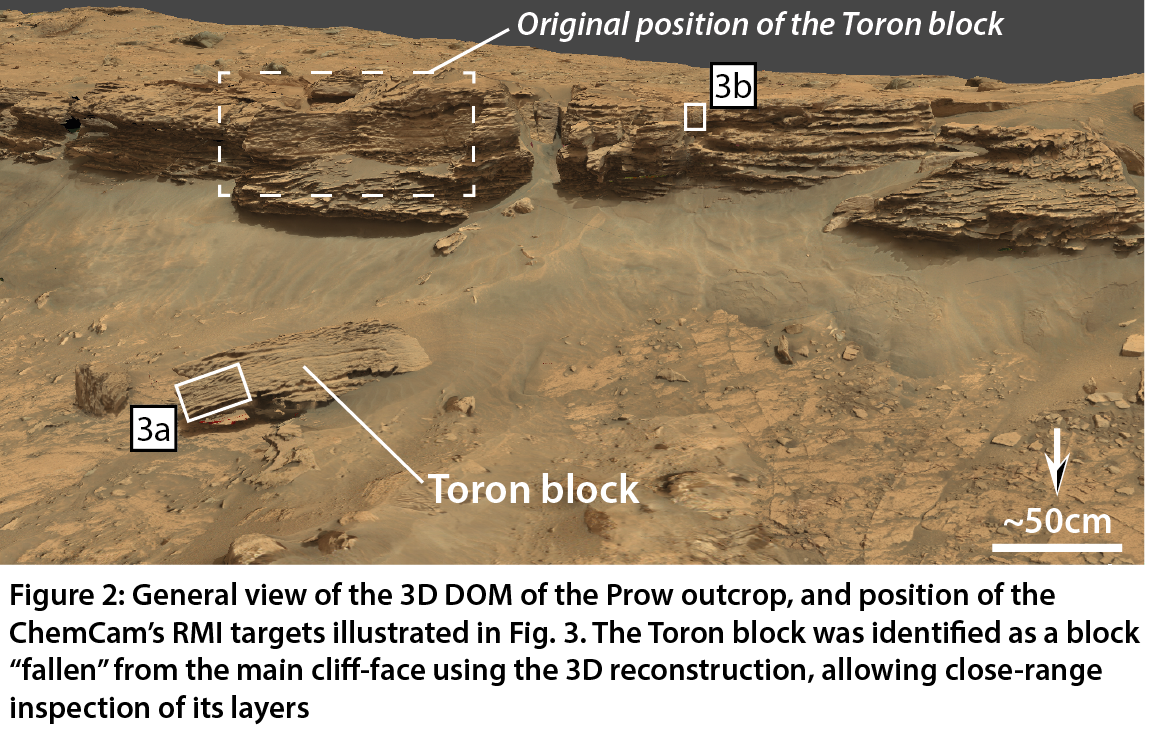
The DOM reconstruction has been helpful in determining the targets of interest during the Prow exploration by Curiosity. One particular benefit has been to identify the Toron block (Fig. 2) as a fallen piece of the main outcrop, allowing us to perform very close-range observations of the outcrop’s cliff-face (e.g., Fig. 3a) without actually putting the rover too close to the actual rock-face. The interest of using such 3D reconstruction notably lies in the ability to characterize the spatial distribution of the multi-scale structures observed at the Prow, but also to study the spatial distribution (and potential variations) of the geochemical composition of these layered sandstones as seen by the ChemCam instrument. We also take advantage of the high-resolution micro-images provided by the Remote Micro-Imager subsystem of the ChemCam instrument (with a field of view of 20 mrad per frame, resolving grains under the silt at close range) to study the facies (grain-size, micro-structures) of the different sandstone beds cropping out at this locality (Fig. 3).
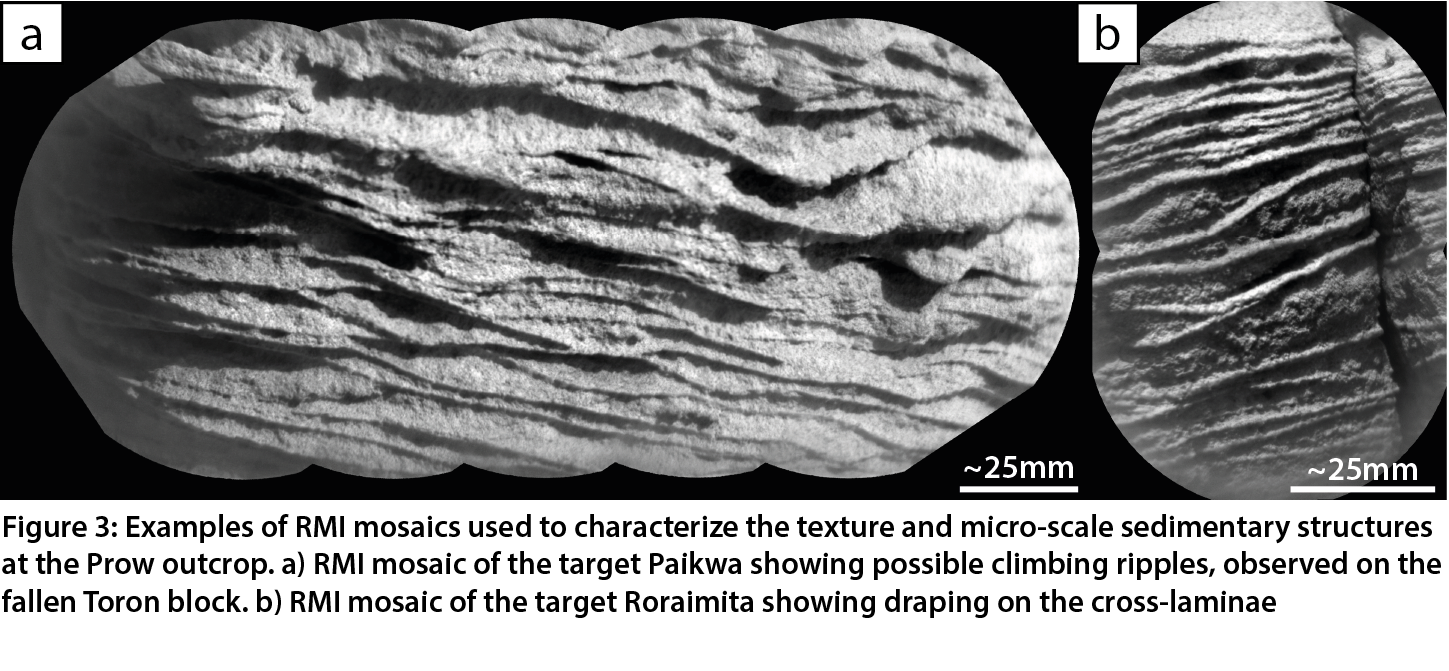
At the Prow, we characterize several sets of sedimentary structures such as (but not limited to) meter-scale cross-stratifications, cm-scale symmetric ripples but also probable climbing ripples (Fig. 3a). These structures, mostly indicating a direction of transport toward the NW (similar to what is observed in underlying Glen Torridon area), denotates sustained aqueous conditions compatible with a fluvial setting. We also observe in some place at the Prow, and notably in the upper layers, mm-scale fine-grained draping (Fig. 3b) deposited at the surface of (cross-)stratifications, reminiscent of flaser bedding on Earth. These fine muddy levels indicate recurrent intervals of low-energy deposition in-between higher-energy periods. Put together, these elements help us to characterize sustained aqueous conditions in a dynamic setting of combined flow and wave action at the time the sediments were deposited (e.g., [8]), helping us to determine probable mixed fluvio-aeolian settings around the critical climatic transition observed within this sulfate-bearing unit characterized by alternating wet and dry conditions.
References: [1] Miliken et al., 2010, Geophys. Res. Lett. 37, L04201; [2] Rapin et al., 2021, Geology 49; [3] Caravaca et al., 2021, Remote Sensing, 13(20), 4068; [4] Rapin et al., 2022, EPSC, this meeting; [5] Schieber et al., 2022, LPSC, Abstract #1304; [6] Meslin et al., 2022, LPSC, Abstract #2492; [7] Caravaca et al., 2020, Planet. Space Science 182, 104808 ; [8] Gupta et al., 2022, ESPC, this meeting.
How to cite: Caravaca, G., Le Mouélic, S., Gupta, S., Mangold, N., Rapin, W., Schieber, J., Le Deit, L., Gasnault, O., and Lanza, N. L.: The Prow outcrop: an “open catalog” of multiscale 3D fluvial sedimentary structures in the lower sulfate unit of Gale crater (Mars), Europlanet Science Congress 2022, Granada, Spain, 18–23 Sep 2022, EPSC2022-336, https://doi.org/10.5194/epsc2022-336, 2022.
Fluvial landforms on Mars are important because they indicate past liquid water. The landforms can provide information about past environmental and climate conditions and the potential for past life. Ancient fluvial sediment transport fluxes have been estimated for several channels on Mars. However, it is also important to understand the differences between sediment transport on Earth and Mars. Fluxes can differ significantly due to gravity, sediment density, lack of ecology and the possible presence of ice. Only when we understand the effects of such differences on sediment fluxes, we can apply and adapt knowledge of fluvial geomorphology on Earth to the surface of Mars. Additionally, such understanding will greatly improve the use of Earth analogues.
In this study, we isolate the effects of gravity on fluvial sediment transport with a 1D model of a simple static channel and a 2D depth-averaged numerical hydro-geomorphological model of a growing delta. The results show that sediment transport on Mars is more efficient than on Earth for the same water discharge, sediment distribution, and channel geometry. The 1D results show that mainly fine sediment is transported more efficiently on Mars, because the effect of gravity is stronger on suspended transport compared to bedload transport and bigger grains travel in suspension on Mars compared to Earth for the same boundary conditions. Because gravity affects fine and coarse sediment fractions differently, we also expect differences in geomorphology due to different ratios of sediment fractions and disparities in sediment sorting. We are exploring these morphological effects in our 2D delta model. Our preliminary results suggest that the lower gravity on Mars results in faster-growing deltas with lower slopes and wider channels. These results suggest that unexpected differences with Earth might also occur in the delta stratigraphy, which is important to realise when drilling for sediment samples in the search for biosignatures.
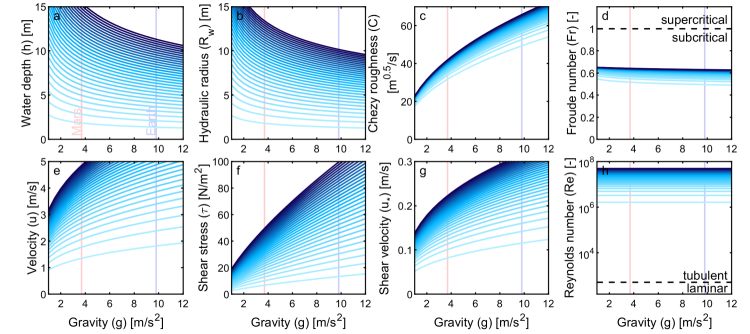
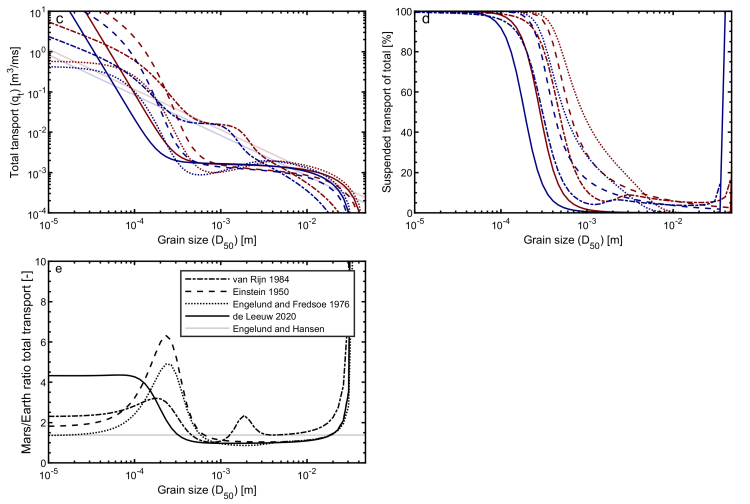
How to cite: Braat, L. and Lamb, M. P.: Isolated effects of gravity on sediment fluxes and delta morphology, Europlanet Science Congress 2022, Granada, Spain, 18–23 Sep 2022, EPSC2022-356, https://doi.org/10.5194/epsc2022-356, 2022.
Introduction: On Earth, sharp drops in temperature can cause ground cemented by ice to contract, forming surficial cracks (Figure 1a) that can join to form polygonal patterns. These polygons show no elevation difference between their margins and centres, and are called here flat-centred polygons (FCPs). Water and/or sand [1, 2, 3] can infill the troughs and freeze, forming ice or sand wedges. These grow seasonally, uplifting polygon margins above the centres, forming low-centred polygons (LCPs). When wedges degrade, the elevation of the margins decreases below that of the centre, forming high-centred polygons (HCPs).
The martian mid-latitudes exhibit similar polygons (Figure 1b), currently thought to form by ground thermal-contraction [4]. Whereas debate ensues over the nature of trough infill, recent work provided evidence for ice wedges in Utopia Planitia [5] – with implications for liquid water stability and subsurface water ice availability.
Here we study variations in polygon distribution/morphology in relationship with different geological units in UP (Figure 2) and Arcadia Planitia (AP; Figure 3), where polygonised units have been reported [6]. Our study seeks to understand: 1. how the substrate nature favoured/inhibited the formation and/or preservation of ground ice, and 2. whether polygon characteristics (e.g. morphology, spatial density) can give insights into geological properties of their substrate.
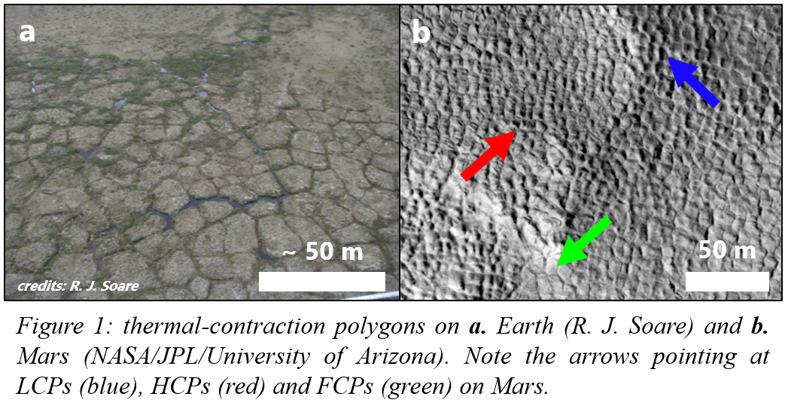
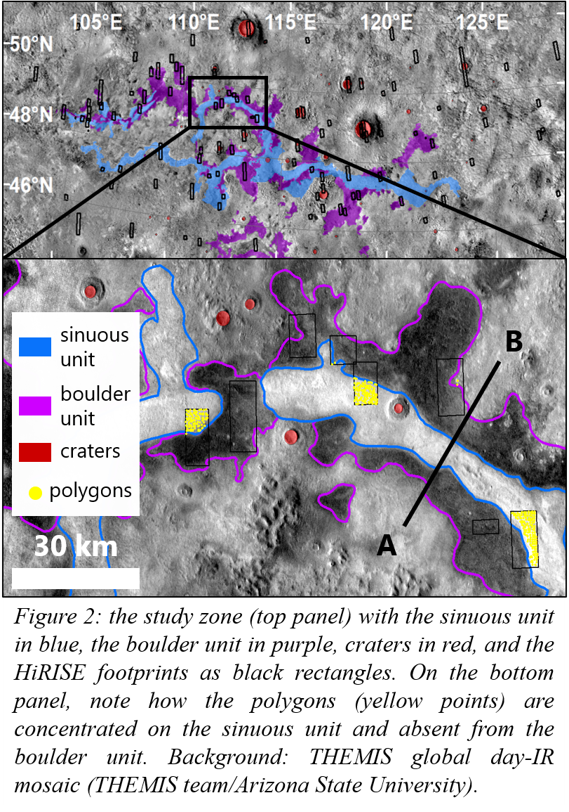
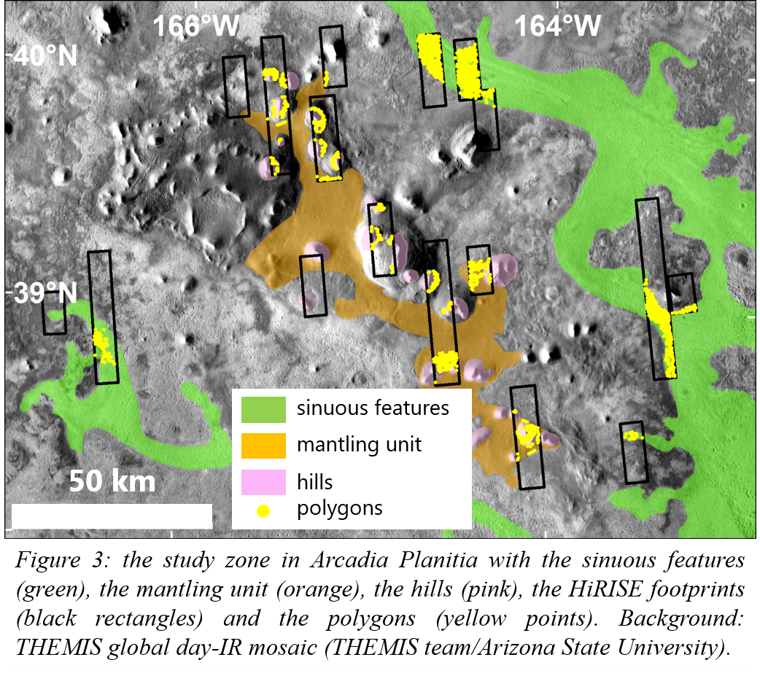
Methods: In UP (Figure 2a) we mapped polygons (5-25 m scale) on 104 images from the High-Resolution Imaging Experiment (HiRISE, 25-50 cm/pixel) – 55 from [5] and 49 new ones. We used a grid-based mapping approach [7]: we gridded images into 500x500 m squares, and in each square the presence of a given polygon type was noted when at least five specimens were present. We mapped the extent of three units: a sinuous unit, a boulder unit, and craters (Figure 2) with imagery from the Thermal Emission Imaging System (THEMIS), the Context Camera (CTX) and HiRISE. We also produced a topographic cross-section of contacts between the sinuous and the boulder units (Figure 2b) with data from the Mars Orbital Laser Altimeter (MOLA).
For each unit we calculated three parameters: 1. the percentage of polygonised squares (%pol), 2. the percentage of polygonised squares containing solely FCPs (%FCPs), and 3. the ratio number of squares containing LCPs / number of squares containing HCPs (LCP/HCP). We suggest that these parameters reflect properties of the substrate: 1. its cementation by ice, 2. its capacity to grow ice wedges (i.e. massive ground ice), and 3. its capacity to preserve ground ice.
We used the same approach on 18 HiRISE images in AP, where we mapped the extent of three units based on [6]: hills, a mantling unit, and sinuous features.
Results: We display and compare results for each unit in Table 1. In UP, topography and cross-section data (Figures 2b & 4) show that the boulder unit is at a lower elevation than the sinuous unit and also the surrounding terrains. In AP, hills exhibit FCPs around their central mound (Figure 5a); sinuous features bear FCPs, HCPs and what we interpret as degraded HCPs (Figure 5b); and the mantling unit bears few polygons, but is mostly covered in extensive brain terrain and linear ridges [6] (Figure 5c).
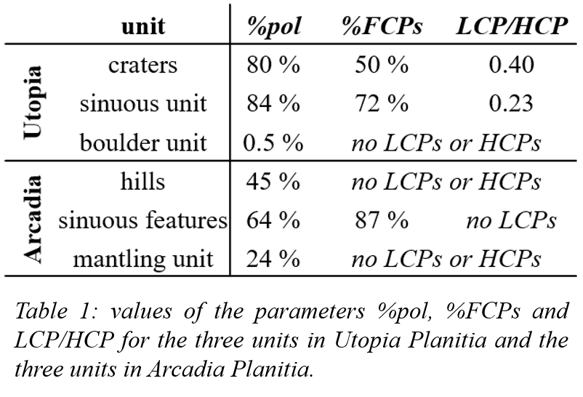
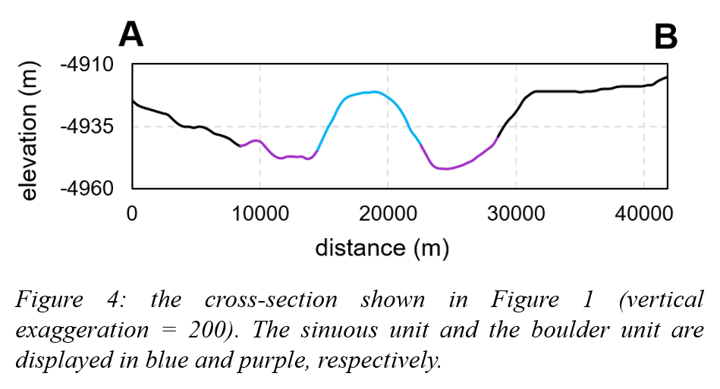
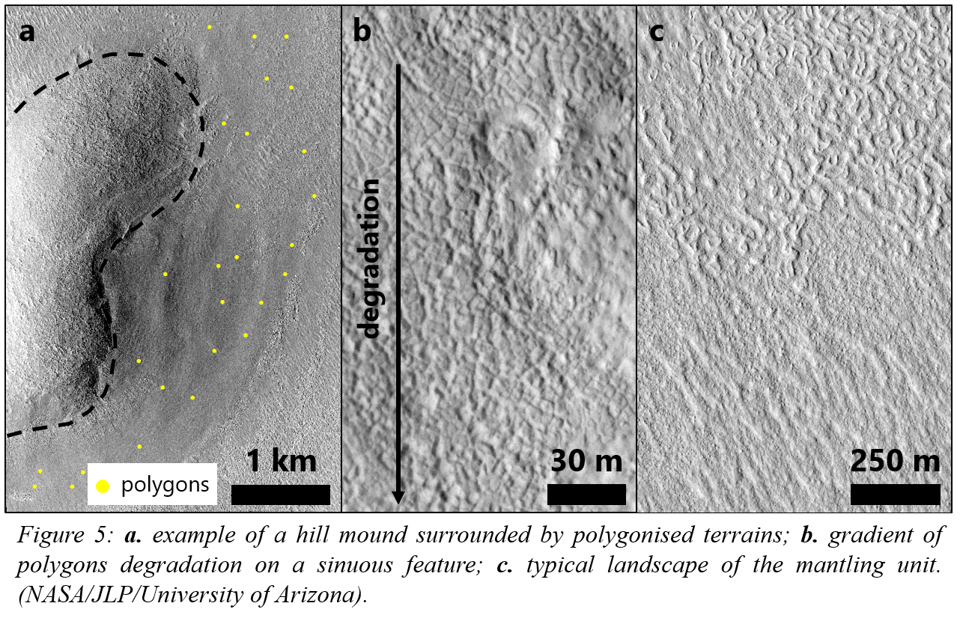
Discussion:
Utopia Planitia: The material infilling craters is highly polygonised (high %pol), show evidence of past ice wedge formation (low %FCPs), and preserved more ice wedges (high LCP/HCP). Therefore, it should be porous and ice-rich [8, 9], suggesting sediment that underwent ice deposition events. This could have been enhanced by a cold-trap effect [5, 10].
The boulder unit exhibits boulders, fractured rocks and nearly no polygons - suggesting a massive material hindering ground ice emplacement and thus ground cracking. The sinuous unit is higher in elevation and highly polygonised (high %pol), showing evidence of ice wedge activity and of LCP preservation – but less than craters (higher %FCPs and lower LCP/HCP). Substrate here should thus favour massive ice emplacement and preservation - but to a lesser extent than craters. Moreover, the study zone is located at the terminus of Hrad Vallis, a valley thought to have conveyed both lava and mudflows [11]. Therefore, we suggest that the boulder unit is an ancient low-viscosity lava flow [12], superposed by the sinuous unit which is a more recent mudflow, both having been conveyed by Hrad Vallis.
Comparison Utopia/Arcadia Planitia: Despite both being at similar latitudes, the polygonisation in AP is different to that in UP: AP exhibits degraded HCPs and no LCPs. Therefore, we suggest that AP underwent an ancient period of ice (or sand) wedge aggradation, which stopped and was followed by landform degradation.
Conclusions: We have shown that the morphology of thermal-contraction polygons can give insights into substrate properties, and help define its geological origin. In UP, it allowed us to infer the origins for both the boulder and the sinuous units, consistently with the regional geological context. In future work we will explore the timing of polygonisation in the mid-latitudes: did this process start and stop earlier in AP than in UP? or did the ice wedge activity last longer in UP? how old are the units bearing polygons, and how long does it take to erode them? These points could have important implications concerning the timing of liquid water stability on Mars.
References: [1] Péwé T. L. (1959) AJS 257, 545-552. [2] Lachenbruch A. H. (1962) GSA Special Paper 70. vol. 69. [3] Black R. (1976) Quaternary Research 6(1), 3-26. [4] Mellon M. T. (1997) JGR 102 (E11), 25,617-25,628. [5] Soare R. J. et al. (2021) Icarus 358, 114208. [6] Hibbard S. M. et al. (2021) Icarus 359, 114298. [7] Ramsdale J. D. et al. (2017) PSS 140, 49-61. [8] Lefort A. et al. (2010) Icarus 205, 259-268. [9] Levy J. S. et al. (2009) JGR 114, E01007. [10] Conway S. J. et al. (2012) Icarus 220, 174-193. [11] Hamilton C. W. et al. (2018) JGR Planets 123, 1484-1510. [12] Hopper J. P. and Leverington D. W. (2014) Geomorphology 207, 93-113.
How to cite: Philippe, M., J. Conway, S., J. Soare, R., and E. Mc Keown, L.: Relationship between the density/type of thermal-contraction polygons and the geology of the substrate at the Martian mid-latitudes., Europlanet Science Congress 2022, Granada, Spain, 18–23 Sep 2022, EPSC2022-425, https://doi.org/10.5194/epsc2022-425, 2022.
Abstract
Northwestern part of Terra Cimmeria displays a wide range of fluvial, lacustrine and glaciofluvial geomorphological features, indicative of presence of liquid water in this area early in the Martian history. These features were previously mapped as part of global studies, but not in relation to the area itself. Here we present our reconstruction of hydrologically correct model of northwestern Terra Cimmeria based on algorithm assisted mapping exercise of unprecedented precision. Based on our findings we are able to contextualize the geomorphological specifics of individual subbasins within the framework of Late Noachian Icy Highlands model and subsequent climatic transition towards the dry and cold state of the Amazonian period.
Physiographic Characteristic
Terra Cimmeria is an extensive region of the Martian southern highlands. Its northwestern portion (Northwestern Terra Cimmeria, NWTC) lies in the equatorial area of the planet and likely did so even before the Tharsis-induced true polar wander event (Bouley et al., 2016). It is nested between the volcanic province of Hesperia Planum to the southwest and the Utopia highland-lowland boundary to the north (Skinner and Tanaka, 2007). In the setting of the disputed Arabia Level ocean shoreline (Sholes et. al, 2021 and references therein) NWTC would stand out as the longest peninsula on Mars. The surface of NWTC is dominated by the Late Noachian highland unit with „undifferentiated impact, volcanic, fluvial and basin material“ (Tanaka et al., 2014). There are several open-basin lakes as mapped by Fassett and Head (2008), craters in different stages of degradation, and numerous valley networks which dissect the terrain (Carr, 1995; Hynek et al., 2010; Alemanno et al., 2018) and few on which terminate as deltaic deposits previously mapped by Achille and Hynek (2010). The variety and density of geomorphological features whose formation is tied to the presence of volatiles suggests a rich history of fluvial, lacustrine, and glaciofluvial activity and importantly fluvially dominated erosion and deposition. We incorporated available imagery and previously derived datasets in our algorithm assisted mapping exercise in order to contextualize the putative sources of the valley carving runoff within the local climatic background.
Methodology
NWTC valley networks were mapped several times in different level of detail starting with Carr (1995) who based his mapping on Viking imagery. This initial campaign was followed by Hynek et al. (2010) who utilized THEMIS daytime IR imagery and MOLA DEM and later by Alemanno et al. (2018) who in addition to THEMIS daytime IR and MOLA DEM used the ConTeXt (CTX) camera imagery to improve their recognition capability where the forementioned datasets lacked sufficient resolution.
Our mapping is based on the high resolution global CTX image mosaic rendered at 5 m/pixel (Dickson et al., 2018), THEMIS nighttime IR dataset, and MOLA DEM with the vectorized valley network dataset of Alemanno et al. (2018) serving as a baseline. We used Whitebox GAT surface flow accumulation model with hybrid breaching-filling sink removal capability (Lindsay, 2015) to digitalize the thalwegs as well as subbasins based on MOLA DEM. The algorithm-derived thalwegs and previously mapped valley networks were used to guide and double check the manual mapping which was based strictly on the CTX and THEMIS nighttime IR mosaics. Subsequently, digitalized subbasin borders were checked against the CTX mosaic and corrected based on the underlaying terrain. Notable geomorphological features were identified and marked as point features and putative headwater areas we delineated based on the previously logged data.
Results
We mapped an area spanning more than 8✕105 km2 and reconstructed 7 main valley networks. The valley networks were divided into over 80 subbasins based on manual correction of flow accumulation model. We managed to identify and connect seemingly isolated stretches of valleys and incorporate them into their respective networks thus creating a hydrologically correct reconstruction of the area. We identified several headwater-specific geomorphic features, pingos and paleolakes.
Discussion
In Noachian NWTC was situated between the equilibrium and terminus lines of a Late Noachian Icy Highlands (LNIH) ice sheet (Fastook and Head, 2015) and as such it would favor the formation of subglacial channels fed by meltwater (Galofre et al., 2020) and accumulation of ice (Wordsworth et al., 2013; Fastook and Head, 2015). The presence of developed dentritic networks which could have been carved by glavial meltwater is proven by our mapping exercise. Head et al. (2022) proposed that the climate of Mars underwent a transitional period during which a decrease in the atmospheric pressure induced a shift from altitude dependent temperature regime typical for the Noachian period (Wordsworth et al., 2013) towards latitude dependent temperature regime of the Amazonian period. This transition would start with ablation and melting of the lower altitude icy deposits and end with desiccation of equatorial ice reservoirs – both of which are in broader sense applicable to NWTC. In the beginning of this transitional period, meltwater released during the phases of peak temperatures would return to the highland cold traps in the time between these episodes. It is therefore plausible that given the specific combination of altitude, latitude, and location of NWTC, this area could sustain active surface or near-subsurface hydrology for an extended period of time up to 106 -108 years. This is supported by the variety of geomorphic features present in NWTC, but remains to be further tested with buffered crater counting and development of conceptual and hydrological models based on the newly created datasets.
Acknowledgements
VC & YM were supported by Czech Science Foundation (#20-27624Y).
References
Carr, Michael H. (1995), doi:10.1029/95je00260; Skinner, J. A., & Tanaka, K. L. (2007), doi:10.1016/j.icarus.2006.08.013; Fassett, C. I., & Head, J. W. (2008), doi:10.1016/j.icarus.2008.06.016; Achille, G. D., & Hynek, B. M. (2010), doi:10.1038/ngeo891; Hynek, B. et al. (2010), doi:10.1029/2009je003548; Wordsworth, R et al. (2013), doi:10.1016/j.icarus.2012.09.036; Tanaka, K. L. et al. (2014), doi:10.3133/sim3292; Fastook, J. L., & Head, J. W. (2015), doi:10.1016/j.pss.2014.11.028; Bouley, S. et al. (2016), doi:10.1038/nature17171; Lindsay, J. B. (2016), doi:10.1002/hyp.10648; Alemanno, G. et al. (2018), doi:10.1029/2018ea000362; Dickson, J. et al. (2018). A Global, Blended CTX Mosaic of Mars with Vectorized Seam Mapping: A New Mosaicking Pipeline Using Principles of Non-Destructive Image Editing; Galofre, A. G. et al. (2020), doi:10.1038/s41561-020-0618-x; Sholes, S. F. et al. (2021), doi:10.1029/2020je006486
How to cite: Cuřín, V. and Markonis, Y.: Reconstruction of Northwestern Terra Cimmeria Watersheds, Europlanet Science Congress 2022, Granada, Spain, 18–23 Sep 2022, EPSC2022-549, https://doi.org/10.5194/epsc2022-549, 2022.
Introduction.
Earth's most-ancient crust has been recycled through plate tectonics processes making it unlikely that we will ever directly sample it (although, one can imagine finding ancient Earth meteorites one the Moon [1].) Mars, on the other hand, hosts ancient crustal outcrops on its surface. The uplifted massifs surrounding Argyre, Hellas, and Isidis – the three largest, well-preserved impact basins on Mars - formed in the chaotic aftermath of the basin-forming impacts due to normal faulting caused by crustal thinning from impact excavation [2]. Our goal is to understand the igneous minerals associated with uplifted massifs using the Compact Reconnaissance Imagining Spectrometer for Mars (CRISM) [3] around Argyre, Hellas, and Isidis (Fig. 1). Here, we present initial results in this effort for the north Hellas area and expect to present preliminary results for Argyre and Isidis, as well, at the conference.
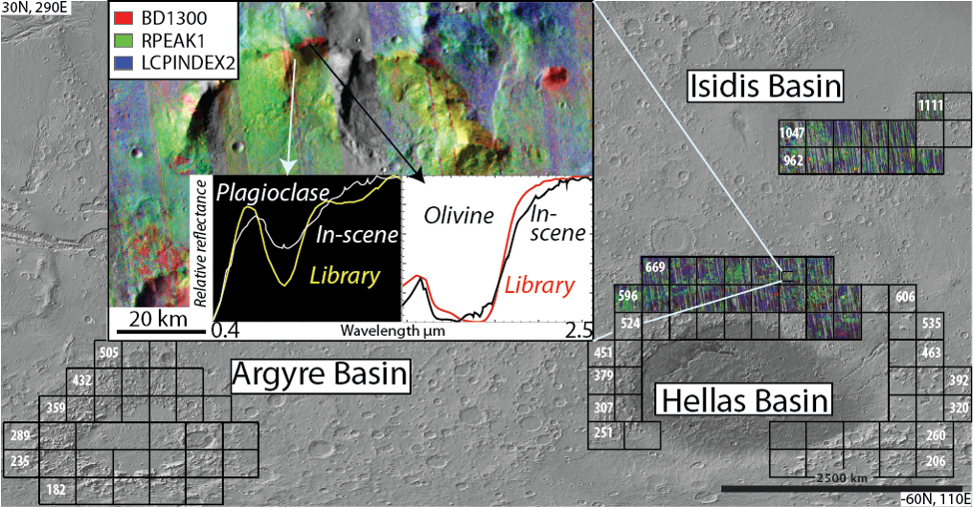
Fig. 1 Context view of the study area. Squares outline 5°x5° CRISM tiles. Number of tiles is 100, covering an approximate 5% of the surface. CRISM coverage is >80 % over tiled areas. Inset shows a region at the map scale of 1:250,000 with CRISM spectra of uplifted massifs compared to library spectra. In the spectral parameter combination, red is consistent with olivine, yellow with plagioclase, and blue with low-calcium pyroxene.
Methods.
CRISM Data Processing. We used CRISM multispectral mapping data (MSP) and hyperspectral mapping data (HSP). The MSP mapping strips have 19 visible to near-infrared (VNIR, 0.4-1 µm) spectral channels and 55 short-wavelength infrared (SWIR, 1-4 µm) channels, and the HSP mapping strips contain 107 VNIR channels and 154 SWIR channels. Both mapping datasets have a ground sampling distance of approximately 180 m. The set of wavelength channels contained in the MSP dataset were chosen to sample more densely in wavelengths regions known to contain absorption features of minerals likely to be detected on Mars (primary rock-forming silicates, phyllosilicates, etc. [3]). For our study, HSP data were resampled to the MSP wavetable to increase the spatial coverage. Typical coverage of the MSP+HSP dataset is ~85%, with sufficient overlap to allow for mosaicking and radiometric reconciliation. We processed these data through a custom pipeline [4] that includes initial noise filtering, photometric and atmospheric corrections [5], [6], and an empirical correction for “spectral smile” [7]. The final products of this pipeline are 5°x5° mosaic tiles with improved inter-strip variability in atmospheric residuals [8].
A typical method for condensing the information contained in a CRISM image into an interpretable form is by calculating “spectral parameters”, i.e., mathematical summations of particular characteristics of the spectra [9]. Spectral parameters can be combined into 3-band RGB images that highlight specific, thematically-related, combinations of interest. Fore example, the MAF summary product combines indexes intended to highlight mafic mineralogy: olivine (OLINDEX3), low-calcium pyroxene (LCPINDEX2), and high-calcium pyroxene (HCPINDEX2). From the CRISM mapping tiles, we constructed summary products that are well-suited for compositional mapping over large areas [10] (e.g., Fig. 1).
Compositional Mapping. Regions of interest were identified with the map tile summary products in ArcGIS followed up by detailed spectral analyses in IDL/ENVI (specialized software for analyzing hyperspectral images) with custom add-on analysis tools. Point locations of compositions, confirmed through spectral analysis, were imported back into ArcGIS and “outcrops” were mapped using summary products. We define outcrop in the context of this work as a spatially contiguous region with an internally consistent spectral signature distinct from its surroundings (e.g., Fig. 2).

Fig. 2 Example plagioclase-bearing massif north of Hellas basin. (A) CRISM browse product (same as in Fig. 1). Yellow tones are consistent with plagioclase. Black boxes indicate 8 regions over which spectra were taken and plotted in C. (B) CTX 5 m/pixel image of the same massif as in (A). White dashed lines denote outcrops mapped in this A and B. (C) Average CRISM ratioed I/F spectra from the 8 regions indicated in A and B.
Results and Discussion.
Thus far, we have mapped 12 high-calcium pyroxene-bearing outcrops, 97 plagioclase-bearing outcrops, 128 LCP-bearing outcrops, and 129 olivine-bearing outcrops (Fig. 3). Outcrops with distinct mineralogical signatures are often observed adjacent to each other on the same massif, or on massifs in close spatial proximity (relative to the size of the massifs, ~several kilometers). We also identified Fe-, Mg-, and Al-phyllosilicate minerals associated with the massifs and, more commonly, with impact crater ejecta along the northern Hellas rim.
The number and spatial extent of plagioclase-bearing outcrops was surprising and is described in [11]. The massifs pre-date Hellas (≥ 4.1 Ga) and are situated stratigraphically above putative mantle material. The north Hellas massif outcrops may expose the remains of an ancient large igneous complex, perhaps similar to terrestrial layered mafic intrusions. Preliminary results from the Argyre and Isidis uplifted massifs will be presented at the conference and compared to those from north Hellas.
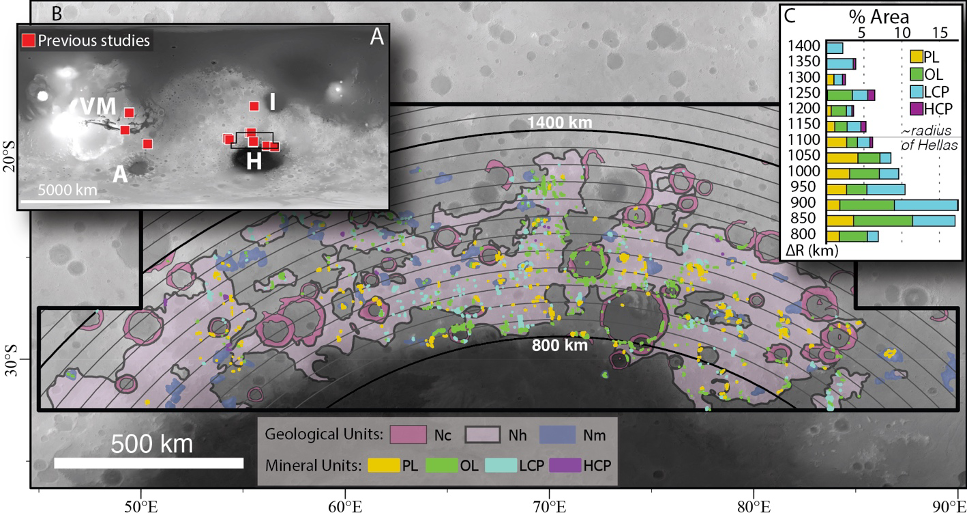
Fig. 3 Summary of detections over north Hellas. (A) Red squares indicate all locations of plagioclase-rich outcrops discovered previous to our work. (B) Context map showing all mafic mineral outcrops mapped in our study. Arcs are 50-km interval bins measured radially from the center of Hellas. Geologic units are Noachian crater (Nc), Noachian highland (Nh) and Noachian massif (Nm) from Leonard and Tanaka, 2001. (C) %Area is the area of each mineral outcrop normalized to the area of the Nc, Nh, and Nm geologic units in each radial bin. Note the concentration of detections interior to the nominal radius of Hellas, highlighting the stratigraphically low position of the outcrops.
[1] J. J. Bellucci et al. doi: 10.1016/j.epsl.2019.01.010.
[3] G. J. Leonard and K. L. Tanaka, 2001.
[4] S. L. Murchie et al. doi: 10.1029/2009je003344.
[5] F. P. Seelos and S. L. Murchie, LPSC. p. 2325, 2018.
[6] F. P. Seelos, et al., LPSC. p. 1783, 2016.
[7] F. Morgan et al., LPSC. p. 2453, 2011.
[8] F. P. Seelos et al., LPSC. p. 1438, 2011.
[9] F. P. Seelos, et al., LPSC p. 2635, 2019.
[10] C. E. Viviano‐Beck et al. doi: 10.1002/2014JE004627.
[11] C. E. Viviano et al., LPSC, p. 1485, 2020.
[12] Phillips, M. S., et al., Geology, accepted.
How to cite: Phillips, M., Viviano, C., Moersch, J., Rogers, A. D., and Seelos, F.: Mars uplifted massifs: unique and extensive samples of ancient crust., Europlanet Science Congress 2022, Granada, Spain, 18–23 Sep 2022, EPSC2022-736, https://doi.org/10.5194/epsc2022-736, 2022.
1. Introduction
Some terrestrial concretions may be analogs of Martian concretions "blueberries". They were discovered on Mars in the Meridiani Planum area (0°12′N, 357°30′E) by the Opportunity rover. The conditions for the sedimentation of Martian concretions are still unknown. They could have arisen in a similar sedimentation environment as some terrestrial concretions. Therefore, it is important to determine which Earth concretions are analogs of Martian concretions and under what conditions they were formed. This would significantly enrich knowledge about the conditions prevailing on Mars during the formation of Martian concretions, and would be an important evidence for the presence of liquid water in the history of the red planet [1], [2].
2. Concretions from Utah
Near the MDRS (Mars Desert Research Station) base in Utah, USA, sandstone concretions of Cretaceous Dakota Formation were collected. In contrast, the early Jurassic concretions in the Navajo Formation adjacent to Dakota are additionally covered with a thick layer of hematite and other iron compounds. It is known that they crystallized in layers of fine sandstone. As the sandstones were eroded, concretions fell out of them by gravity. Then it can reach to a re-crystallization on the surface of these concretions in a similar way as on the concretions from Jurassic layers of the Navajo Formation from Utah [3], [4].
|
|
|
|
|
Fig.1. A layer of Cretaceous sandstone from the Dakota Formation in Utah with concretions. The size of the visible layer with concretions of about 0.5 m.
|
|
Fig.2. Sandstone concretions of the Cretaceous sandstone of the Dakota Formation in Utah.
|
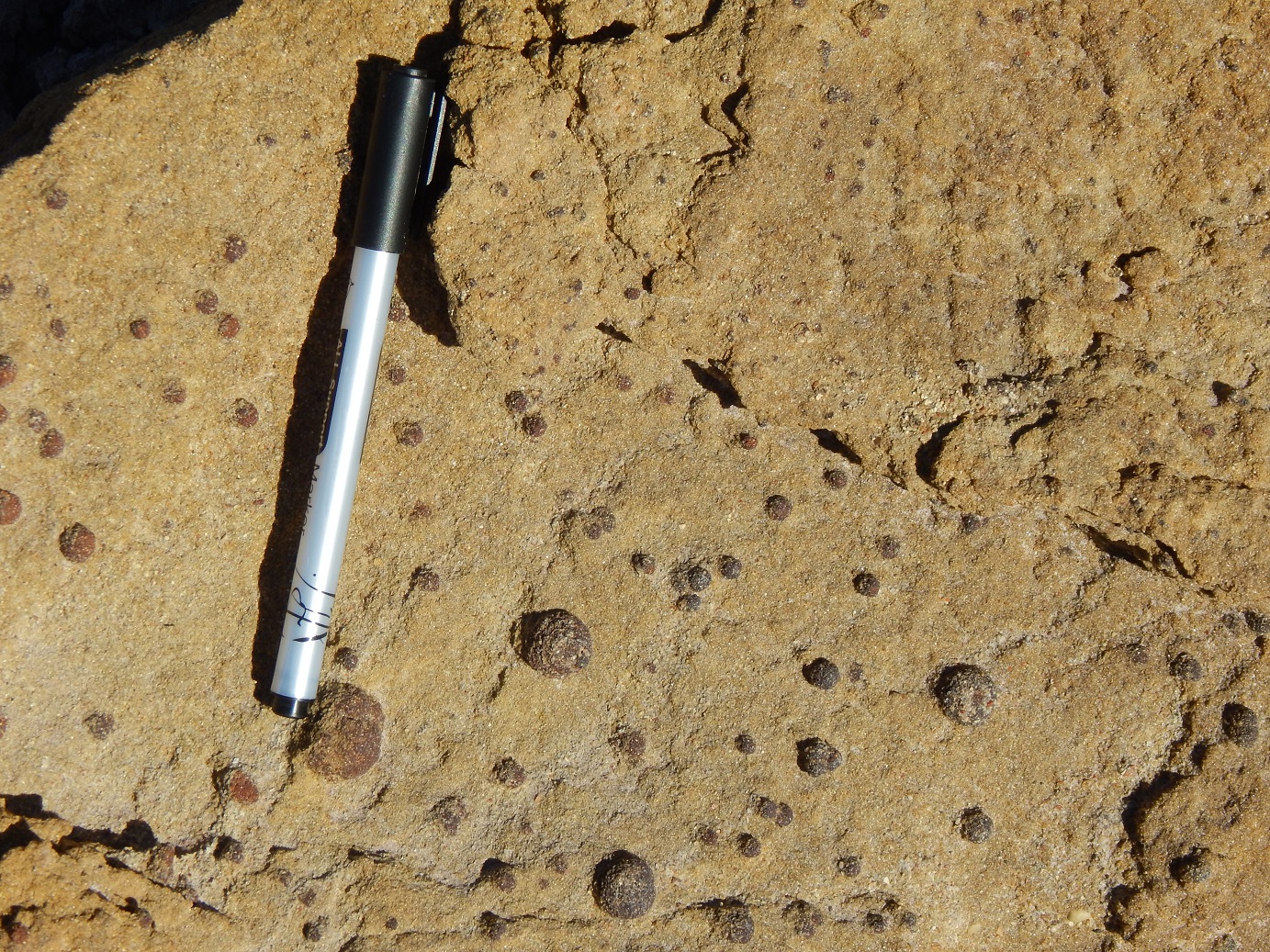
Fig.3. Surface of the Dakota Cretaceous sandstones with distinct mineralization of iron oxides.
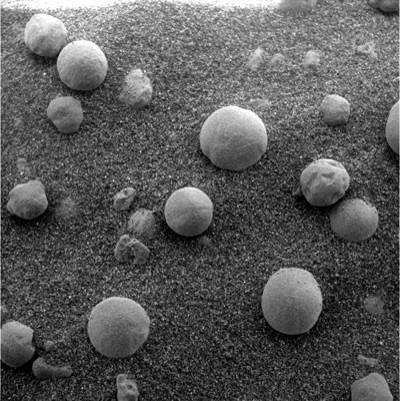
Fig.4. Image from the Microscopic Imager camera showing concretions taken by the Opportunity rover on Meridiani Planum. This image is ~3 cm across and was taken on the 15th day of Opportunity's journey (NASA Feb. 8, 2004).
Figs 1,2 show concretions in the Cretaceous layer, leached by migrating waters and re-mineralized, for which carbonates also contribute [5]. Fig. 3 shows concretions highly mineralized with iron oxides with a large proportion of hematite and goethite. When these concretions fall out by gravity, another mineralization takes place on their surface, in the case of Utah again with iron oxides, which creates a kind of glassy shell on the concretion [6].
In many publications, scientists emphasize that these concretions were formed in presence of water. Their chemical mineralization is quite complex because the water that migrates through the porous sandstones is responsible for the crystallization of these formations thanks to the dissolved chemical compounds. There is a repeated mineralization and demineralization, and therefore the chemical composition of concretions in different regions of the world may differ despite the similar origin of their formation [7], [8], [9].
3. Comparison of spectra
In our research we used the results obtained with the Mossbauer spectrometer for Martian soil with "blueberries", Fig.4, [10]. We identified the minerals likely to be present at the sample. We used appropriate spectra for these minerals from the USGS library and compared them to the infrared spectra of concretions from Utah- Fig.5.
Since the Mossbauer spectrometer does not provide information about all possible minerals because it focuses on minerals containing the Fe element, it is possible that the mineralization of Martian concretions is much richer. Jarosite and hematite discovered by the Mossbauer spectrometer fit well with the bands of the infrared spectra of the Utah concretions. Moreover, the minerals that can be recognized in the spectra of concretions from Utah are also clay minerals and gypsum. The sandstones in which this mineralization took place, of course, contain quartz, but in the short infrared range it has no spectral characteristics, therefore quartz is not visible in the spectrum.
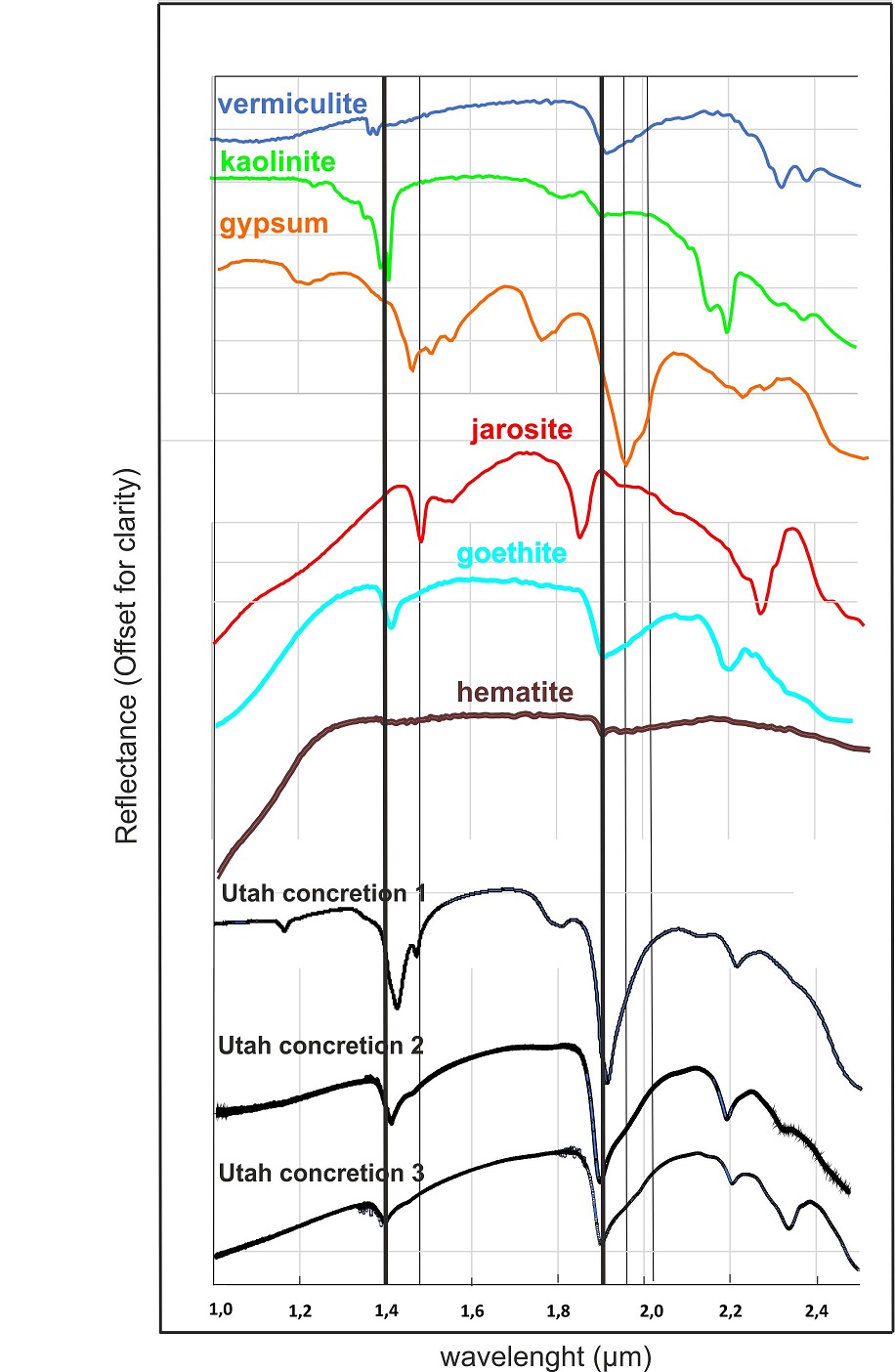
Fig.5. NIR spectra of the Cretaceous Dakota Formation in Utah (spectrometer Nicolet iS50) compared with minerals from the USGS library. The 1.4 and 1.9 µm bands reveal the influence of clay minerals and iron oxides, and additionally sulphates (gypsum and jarosite).
4. Conclusions
We found significant correlation between the Utah concretions of the Dakota Formation and those found by the Opportunity rover. A common feature of these concretions is a similar ferric sulphate mineralization. It follows that Martian and Utah concretions might have formed in an acidic environment and water was important for their formation.
References
[1] Chan, M., et al., (2005) GSA Today, 15, 8, 4-10
[2] Fan, Ch., et al., (2010) Planet. Space Sci., 58, 401–410
[3] Busigny, V., and Dauphas, N., (2007) Earth and Planet. Sci. Let., 254, 272–287
[4] Potter, S., and Chan, M., (2011) Geofluids
[5] Parry, W., (2011) Sediment. Geol., 233, 53-68
[6] Chan, M., et al., (2007) Geofluids, 7, 1–13
[7] Mika, K., et al., (2018) Geofluids of Utah, 47, 197-219
[8] Di Bella, M., et al., (2021) Minerals, 11, 460, 1-18
[9] Ray, D., et al., (2021) Planet. Space Sci., 197, 105163
[10] Klingelhofer, G., et al., (2004) Science, 306, 1740-1745
How to cite: Zalewska, N. and Czechowski, L.: Some remarks about Martian "blueberries" and spherical concretion from Utah, Europlanet Science Congress 2022, Granada, Spain, 18–23 Sep 2022, EPSC2022-737, https://doi.org/10.5194/epsc2022-737, 2022.
Introduction
Apart from the Earth, no planetary body is mapped more extensively and to such fine resolution as Mars. The increasing volume of remote sensing data means we are better equipped than ever to answer the fundamental questions about the history of the planet. However, the volume of data grows much faster than the number of scientists who can use it. Machine Learning (ML) is a powerful tool for automating the analysis of ever-increasing volumes of remote sensing data.
Aeolian bedforms exhibit varied morphologies at different scales in remote sensing imagery, therefore, automated detection is a complicated problem. Linear dune fields have been successfully characterized at regional scales using edge detection on Titan from synthetic aperture radar images [1]. Within the field of Earth observation, an edge detection algorithm has been proposed that is optimized for recognizing linear dune fields in panchromatic Landsat 8 data and digital elevation models [2]. Fingerprint minutiae extraction software designed for forensic applications has also successfully detected dune crests and their bifurcations and terminations for linear dunes in the Namib Sand Sea and Strzelecki Desert, and for Transverse Aeolian Ridges (TARs) on Mars [3].
A method for mapping aeolian ripples has been demonstrated using HiRISE imagery from Gale crater [4]. Similarly to earlier studies, this uses a two-step algorithm that segments the bedforms from the surrounding terrain and then detects the crestlines [5]. This study uses the same approach but with a segmentation step that classifies bedforms according to scale and morphology as opposed to foreground-background.
The aim of this study is to create a more general bedform detector that can be applied over larger and more texturally diverse areas of Mars. Moreover, it should perform as well as classic methods employed by geologists such as manually mapping crestlines. This will be assessed in terms of orientations and crest line maps produced but also in terms of the inferred wind regime. The secondary goal of this study is to demonstrate how ML terrain classifications designed for rover navigation can be repurposed for science.
Method
A machine learning system called the Novelty or Anomaly Hunter – HiRISE (NOAH-H) has been developed to classify terrain in HiRISE images from Oxia Planum and Mawrth Vallis according to texture. It was designed to assess terrain for rover traversability but also demonstrates great potential to be used for science [6]. Each pixel of an input HiRISE image is assigned one of 14 classes. These classes represent every type of terrain that can be found at the Oxia Planum and Mawrth Vallis landing sites, summarized in table 1. Classes 8 through to 13 are the six types of ripple morphology that are recognized by NOAH-H.
| 1 | Non-bedrock | Smooth, Featureless |
| 2 | Smooth, Lineated | |
| 3 | Textured | |
| 4 | Bedrock | Smooth |
| 5 | Textured | |
| 6 | Rugged | |
| 7 | Fractured | |
| 8 | Large Ripples | Simple form, Continuous |
| 9 | Simple form, Isolated | |
| 10 | Rectilinear form | |
| 11 | Small Ripples | Continuous |
| 12 | Non-continuous, Bedrock substrate | |
| 13 | Non-continuous, Non-bedrock substrate | |
| 14 | Other Cover | Boulder fields |
Table 1: Ontological classes used by NOAH-H. Large refers to decimeter scale features and small refers to meter scale features.
Class 9, "large simple form isolated ripples", corresponds to the larger-scale TARs in these regions and we use the NOAH-H output to segment the TARs from the surrounding terrain. Some of these classified regions contain more than one TAR, therefore the next step splits these into separate regions. Now that we can assume that every region corresponds to a single TAR, we calculate an orientation for each region using second order central image moments.
Planned Analysis
This method will be applied to HiRISE images already classified by NOAH-H in Oxia Planum. We will compare the spatial distribution and orientation of TARs using the proposed method with those measured from a study that measured 10,753 TARs by manually digitizing crestlines [8]. They will also be compared in terms of inferred wind regime and compared with a global climate model to see if they give the same conclusions. The next step to build on this work is to implement existing or new methods for the remaining 5 bedform classes detectable by NOAH-H, in order to make a more general bedform characterization method.
References: [1] Lucas A. et al. (2014) JGR, 41, 6093–6100. [2] Telfer M. W. et al. (2015) Aeolian Research, 19, 215-224. [3] Scuderi L. (2019) Aeolian Research, 39, 1-12. [4] Vaz D. A. and Silvestro S. (2014) Icarus, 230, 151-161. [5] Pina P. et al. (2004) LPS XXXV, Abstract #1621. [6] Barrett A. M. et al. (2022) Icarus, 371, 114701. [7] Canny J. (1986) IEEE TPAMI, PAMI-8, 6, 679-698. [8] Favaro E. A. et al. (2021) JGR Planets, 126, e2020JE006723.
How to cite: Bohacek, E., Barrett, A., Favaro, E., Balme, M., and Sefton-Nash, E.: Transverse Aeolian Ridges at the ExoMars Rover landing sites, Europlanet Science Congress 2022, Granada, Spain, 18–23 Sep 2022, EPSC2022-957, https://doi.org/10.5194/epsc2022-957, 2022.
TP5 | Mars Science and Exploration
Introduction:
Between March 2018 and December 2019, millions of spectra of Mars' surface and atmosphere thermal emission have been recorded in nadir geometry by TIRVIM/ACS, a thermal infrared spectrometer onboard the ExoMars Trace Gas Orbiter (TGO) [7]. From this wealth of data, we characterized in detail the thermal structure of the Martian lower atmosphere at a great variety of local times. Here we focus on the study of migrating thermal tides derived from TIRVIM observations, including during the Global Dust Event of MY34.
Observations and Methods:
We have developed an algorithm coupling line-by-line radiative transfer and optimal estimation theory to retrieve the surface temperature, the vertical profiles of the temperature between a few km and 50-55 km (2–3 Pa), and the integrated optical depth of dust and water ice clouds [3]. The retrieved temperature profiles have a vertical resolution of 10 km in the lower atmosphere and a coarser resolution of 15-20 km in the range 2–20 Pa. They were validated against thousands of co-located observations from the Mars Climate Sounder, acquired in limb viewing geometry [3].
Thermal structure and tides:
Thermal tides are planetary-scale oscillations resulting from the diurnal solar forcing of the thin Martian atmosphere. Migrating tides describe sun-synchronous modes propagating westward with the sun. The diurnal mode has one maximum and one minimum per day and a zonal wavenumber of one; the semi-diurnal mode has two maxima and two minima per day and a zonal wavenumber of two; etc. One of the main advantage of TGO’s orbit is that the local time of TIRVIM nadir observations drifts by 13 minutes earlier each sol. After 54 sols, or 25-35° of Ls, a full coverage of the daily cycle is achieved, allowing to separate between diurnal and seasonal temperature variations. This is clearly an asset to study thermal tides compared to previous studies, mostly based on 2-4 AM and 2-4 PM temperatures obtained from sun-synchronous orbiters [1,4,6,9].
An example of the zonally-averaged temperature retrieved from TIRVIM at 30 Pa in the period March 13 - April 28, 2018 (Ls~150° of MY34) is shown below, as a function of latitude and local time. At the equator, the temperature is found maximum near 3~AM and minimum near 7~PM. This feature of warm nighttime temperatures at this altitude is well known and is a manifestation of the diurnal thermal tide [8]. The fact that these two temperature extrema are not separated by 12 hours is a first hint that the thermal field is also influenced by a semi-diurnal tide.
Figure 1: Zonally-averaged temperature retrieved from TIRVIM/ACS at 30 Pa, with latitude and local time. This figure gathers 45 sols of data around Ls~150°, MY34.
To study migrating tides qualitatively, we consider the zonally-averaged temperature in a fixed local time reference frame, in which other types of wave signatures (stationary waves, non-migrating tides,…) are averaged out. Following [6], we decompose the observed zonally-averaged temperature into a daily-averaged temperature plus sinusoidal functions at diurnal, semi-diurnal and ter-diurnal frequencies. We obtain the amplitude and phase of the migrating tides at each pressure level and 10°-wide latitudinal bin (see below an example of fits).
An amplitude of 4K is found for the diurnal mode near the equator, which decreases to 2K near 20°, and increases to 6K near 50°N. Very similar results are found at Ls~90° for MY35 [2]. We employ the same methodology to derive tides characteristics simulated in the LMD GCM. Temperature profiles from the model are extracted at the same locations and times as TIRVIM observations and are smoothed vertically using the appropriate averaging kernel matrix. The modeled tides exhibit very similar characteristics as those observed, except for a 1 to 2 hours phase shift; temperature extrema occurring at later local times in the model.
Figure 2: Fit (purple) to TIRVIM equatorial temperatures at 50 Pa (black stars, upper part) as a function of local time. It combines a daily average temperature (horizontal dashed line), diurnal and semi-diurnal signals, as labeled. The bottom part shows the same for GCM outputs (shifted by -15K).
One caveat is that even small seasonal variations over a martian month can hamper our analysis when characterizing the semi-diurnal tide [2]. To overcome this issue, we de-trend the data for seasonal variations using MCS observations. The derived amplitude of the semi-diurnal tide near the equator at Ls=150° ranges from 2K (at 100 Pa) to 6K (at 2 Pa), confirming that this tide mode is significant even in non-dusty seasons [6].
Impact of the MY34 GDE: A Global Dust Event started locally on 2 June 2018 and became planet-encircling on 21 June [5]. Compared to pre-storm conditions, we find that the diurnal tide amplitude strongly increases, reaching 32K at 50-60°S and 20K at 50-60°N at 50 Pa, while it remains unchanged (~4K) near the equator. The semi-diurnal mode increases slightly (6-8K at 30-50 Pa, equator), while the ter-diurnal mode is also detected (amplitude of 5K near 50 Pa, equator). GCM simulations run with the MY34 dust scenario agree very well with TIRVIM observations, both in terms of thermal structure and tide characteristics.
Bibliography:
[1] Banfield et al., JGR Vol. 105, 2000. [2] Fan et al., GRL Vol. 49, 2022. [3] Guerlet et al., JGR Vol. 127, 2022. [4] Guzewich et al., JGR Vol. 117, 2012. [5] Kass et al., GRL Vol. 47, 2020. [6] Kleinbohl et al., GRL Vol. 40, 2013. [7] Korablev et al., SSR Vol. 214, 2018. [8] Lee et al., JGR Vol. 114, 2009. [9] Wilson et al., GRL Vol. 27, 2000.
How to cite: Guerlet, S., Fan, S., Forget, F., Millour, E., Ignatiev, N., Vlasov, P., Shakun, A., Trokhimovskiy, A., Korablev, O., Grigoriev, A., and Montmessin, F.: Migrating Thermal Tides in the Martian Atmosphere from TIRVIM-ACS onboard TGO, Europlanet Science Congress 2022, Granada, Spain, 18–23 Sep 2022, EPSC2022-113, https://doi.org/10.5194/epsc2022-113, 2022.
The NOMAD (“Nadir and Occultation for MArs Discovery”) spectrometer suite on board the ExoMars Trace Gas Orbiter (TGO) has been designed to investigate the composition of Mars' atmosphere, with a particular focus on trace gases, clouds, and dust. The instrument probes the ultraviolet and infrared regions covering large parts of the 0.2-4.3 µm spectral range [1,2], with 3 spectral channels: a solar occultation channel (SO – Solar Occultation; 2.3–4.3 μm), a second infrared channel capable of nadir, solar occultation, and limb sounding (LNO – Limb Nadir and solar Occultation; 2.3–3.8 μm), and an ultraviolet/visible channel (UVIS – Ultraviolet and Visible Spectrometer, 200–650 nm). NOMAD performs solar occultation, nadir and limb observations dedicated to the determination of the composition and the structure of the Martian atmosphere.
TGO started its science phase in April 2018 and instruments have now been accumulating data for more than two Martian years. We will present selected results obtained by the NOMAD instrument covering the atmosphere composition with observations of several trace gases, dust, and clouds. We also report on the different discoveries highlighted by the instrument by pointing to a series of contributions to this conference that will present in detail several specific studies, like recent progress in the instrument calibration, the latest CO2 and temperature vertical profiles, studies of aerosol nature and distribution, water vapor profiles and variability, carbon monoxide vertical distribution, ozone vertical profiles, climatology and relation with water, airglow observations, detection of CO2 ice clouds, surface ices and in general advances in the analysis of the spectra recorded by the three channels of NOMAD.
References
[1] Vandaele, A.C., et al., 2015. Planet. Space Sci. 119, 233-249.
[2] Vandaele et al., 2018. Space Sci. Rev., 214:80, doi.org/10.1007/s11214-11018-10517-11212.
How to cite: Vandaele, A. C., Daerden, F., Thomas, I. R., Depiesse, C., Erwin, J., Flimon, Z., Neary, L., Piccialli, A., Ristic, B., Trompet, L., Viscardy, S., Willame, Y., Aoki, S., Gérard, J.-C., Villanueva, G., Mason, J., Patel, M., Bellucci, G., Lopez-Valverde, M., and Lopez-Moreno, J. J.: Two Martian years at Mars: Observations by NOMAD on ExoMars Trace Gas Orbiter, Europlanet Science Congress 2022, Granada, Spain, 18–23 Sep 2022, EPSC2022-241, https://doi.org/10.5194/epsc2022-241, 2022.
In the framework of the MMX (Martian Moons Exploration) mission, a geodesy team from CNES has joined Geodesy Sub-Science Team to study the estimation of geodetic parameters of a natural satellite of Mars: Phobos.
The MMX mission aims to return a sample of Phobos to Earth, but during the mission, exceptional observations of this natural satellite will be made. What insight into the geodetic parameters of Phobos will be gained from these measurements? The available measurements will be: LIDAR measurements between the probe and the surface of Phobos, 2-way Doppler and range measurements between ground stations on Earth and the probe, as well as optical measurements from photos taken by the probe.
The presentation will focus on the results obtained on the restitution of gravity field parameters, Phobos ephemerides, as well as rotation and orientation parameters of the natural satellite, from synthetic measurements simulated on coherent QSO (Quasi Satellite Orbit) of the current mission analysis.
The LIDAR measurements correspond to a distance measurement between the surface of the body and the onboard instrument. This very accurate measurement (sigma = 22m @ 100 km) [R1] allows the trajectory to be constrained, but is dependent on the quality of the body shape model.
The 2-Way Doppler measurements contain information on the velocity of the probe in the line of sight. These measurements are available during spacecraft observation sessions by ground stations which can be multiple at a rate of one measurement per minute.
Optical measurements are angular landmark measurements on the surface of the body. Like LIDAR measurements, these contain information on the relative position of the probe with respect to the natural satellite. These measurements are derived from a pre-processing of the wide angle and narrow angle photos taken by the OROCHI and TENGOO instruments [R2].
The combination of these three types of measurements will be used to estimate the various geodetic parameters of Phobos throughout the mission. Indeed, the first and most distant orbits (QSO-H) should allow to estimate the ephemeris of Phobos as well as the low-degree coefficients of the gravity field and rotation parameters including amplitude of libration in longitude. As the mission progresses, the spacecraft will orbit Phobos with closer and closer trajectories (QSO-M, QSO-L) which will allow to refine the first estimates made at QSO-H as well as the coefficients of the higher degree field.
This knowledge of the field and the attitude of Phobos will thus allow a precise study of the internal structure of the body.
[R1] Light detection and ranging (LIDAR) laser altimeter for the Martian Moons Exploration (MMX) spacecraft - Senshu et al. (2021) https://doi.org/10.1186/s40623-021-01537-7
[R2] Design of telescopic nadir imager for geomorphology (TENGOO) and observation of surface refectance by optical chromatic imager (OROCHI) for the Martian Moons Exploration (MMX) - Kameda et al. (2021) https://doi.org/10.1186/s40623-021-01462-9
How to cite: Laurent-Varin, J., Marty, J.-C., Matsumoto, K., Yamamoto, K., Hitoshi, I., Hiroshi, A., and Lee, J.: Preliminary geodesy study for MMX mission, Europlanet Science Congress 2022, Granada, Spain, 18–23 Sep 2022, EPSC2022-330, https://doi.org/10.5194/epsc2022-330, 2022.
ESA's Mars Express (MEX) spacecraft has operated in Mars orbit since 2003. On-board MEX, the ASPERA-3 (Analyser of Space Plasma and EneRgetic Atoms) instrument is providing a unique dataset of the space plasma near Mars for more than 18 years, covering a complete solar cycle, allowing long-term inverstigation of the interaction of Mars with the solar wind.
The large number of observations also enables unique statistical studies. Here we present two ASPERA-3 Ion Mass Analyzer (IMA) higher level data sets that will be available through the ESA's Planetary Science Archive (PSA): Solar wind ion moments and Ion differential flux.
How to cite: Holmström, M., Ramstad, R., Futaana, Y., Persson, M., Nilsson, H., and Barabash, S.: High Level Datasets for ASPERA-3 IMA on Mars Express, Europlanet Science Congress 2022, Granada, Spain, 18–23 Sep 2022, EPSC2022-412, https://doi.org/10.5194/epsc2022-412, 2022.
Abstract
The SHAllow RADar (SHARAD) is a synthetic aperture radar (SAR) onboard Mars Reconnaissance Orbiter, in Martian orbit since 2006 [1]. With its 20MHz frequency, it can fathom the first hundreds of meters of the subsurface with a range resolution of about 10m in typical Martian materials. In order to detect subsurface interfaces with radars, we need to eliminate the echoes coming from the surface : as the design of most radars in orbit gives them a large antenna lobe, off-nadir echoes could arrive at the same delay as a subsurface nadir reflection. The classical method to remove this so called “clutter” consists in comparing the radar signal to simulations of the surface echoes using Digital Terrain Models (DTMs). Our aim is to study the first tens of meters of the Martian subsurface with SHARAD. To do so, we need high resolution DTMs because in theory, the higher we get in resolution, the more detailed the simulation will be and the clearer the discrimination between surface and subsurface features will be. We will present results on high resolution simulations performed with SPRATS, our coherent simulator. We will show that while being high resolution, models obtained by photogrammetry sometimes contain artifacts that can be misleading for radar data interpretation.
Simulations with SPRATS : first study with MOLA DTMs
SPRATS is a toolset developed at IPAG that allows to perform both coherent radar simulations of surfaces and 3D SAR processing of them [2], [3]. Those capabilities enable the simulation of the actual signal sensed by SHARAD, with the same processing applied to it, in order to get as close as possible from the instrument results. It allows for a direct power comparison and thus finer analysis. To begin, we performed simulations with DTMs generated with MOLA, a laser altimeter [4]. While having a relatively low resolution, the nature of the acquisition method give those DTMs a high accuracy and precision, resulting in very low artifacts. To study deep reflectors in areas of relatively low rugosity (i.e. the northern plains [5]), those models are sufficient. But the low resolution is a limiting factor when studying close subsurface, or simply to reproduce surface roughness effects on the radar signal. To improve the simulations, higher resolution models are necessary.
HRSC models, higher resolution but sometime containing artifacts
With a resolution of 50 to 100m, HRSC DTMs [6] yield better results in simulating smaller details. It allows to confirm or discard reflectors identified with MOLA [7]. However, these models are acquired by photogrammetry, a technique that is an estimation of the surface topography, compared to MOLA which is a direct measurement. Photogrammetry introduces artifacts that are not easy to estimate, because they depend on the actual topography. We will show a comparative study of simulations with HRSC and MOLA models on a region of interest located in Terra Cimmeria, following a study made by [8]. The amplitude of the artifacts on the HRSC models is too high to study the first tens of meters of the subsurface with SHARAD. Following the idea of getting as close as possible to the actual SHARAD data, we need models that describe the surface at a resolution better that the radar’s wavelength.
Simulations with models at wavelength-scale resolution (CTX)
We will present a comparative study of simulations using CTX models — with a resolution of 12m — and HRSC models. We will also show that the scale of the artifacts on these DTMs being below the SHARAD’s wavelength, CTX DTMs yield near perfect surface echoes simulation, allowing for a fine detail comparative analysis of the SHARAD data. However, given their acquisition method [9], CTX DTMs have a relatively poor surface coverage compared to HRSC, so we used photoclinometry with CTX images on lower resolution models [10] to keep the high resolution information. Comparing high resolution simulations using these models to SHARAD data allowed to highlight small-scale artifacts on the CTX DTMs, as they introduce noise in the radargram.
Conclusions
This study shows that wavelength-scale or smaller artifacts on DTMs are needed to perform shallow subsurface analysis of SHARAD data. It also showed that high resolution models acquired by photogrammetry are prone to artifacts, which can perturb the simulated signal. This artifacts issue can prove to be helpful for DTM quality estimation, especially for missions where no laser altimeter is present to validate the altimetry measurements.
References
[1] R. Seu et al., « SHARAD sounding radar on the Mars Reconnaissance Orbiter », 2007, doi: 10.1029/2006JE002745.
[2] Y. Berquin, A. Herique, W. Kofman, et E. Heggy, « Computing low-frequency radar surface echoes for planetary radar using Huygens-Fresnel’s principle: COMPUTING RADAR SURFACE ECHOES », oct. 2015, doi: 10.1002/2015RS005714.
[3] J.-F. Nouvel, A. Herique, W. Kofman, et A. Safaeinili, « Radar signal simulation: Surface modeling with the Facet Method: RADAR SIGNAL SIMULATION » , febr. 2004, doi: 10.1029/2003RS002903.
[4] M. T. Zuber et al., « The Mars Observer laser altimeter investigation », 1992, doi: 10.1029/92JE00341.
[5] C. M. Stuurman et al., « SHARAD detection and characterization of subsurface water ice deposits in Utopia Planitia, Mars: SHARAD DETECTION OF ICE UTOPIA PLANITIA », sept. 2016, doi: 10.1002/2016GL070138.
[6] G. Neukum et R. Jaumann, « HRSC: the High Resolution Stereo Camera of Mars Express », 2004.
[7] C. W. Cook et al., « Sparse subsurface radar reflectors in Hellas Planitia, Mars », sept. 2020, doi: 10.1016/j.icarus.2020.113847.
[8] S. Adeli, E. Hauber, G. G. Michael, P. Fawdon, I. B. Smith, et R. Jaumann, « Geomorphological Evidence of Localized Stagnant Ice Deposits in Terra Cimmeria, Mars », juin 2019, doi: 10.1029/2018JE005772.
[9] M. C. Malin et al., « Context Camera Investigation on board the Mars Reconnaissance Orbiter », 2007, doi: 10.1029/2006JE002808.
[10] S. Doute et C. Jiang, « Small-Scale Topographical Characterization of the Martian Surface With In-Orbit Imagery », janv. 2020, doi: 10.1109/TGRS.2019.2937172.
How to cite: Desage, L., Herique, A., Kofman, W., and Zine, S.: SHARAD Data Analysis with High Resolution Digital Terrain Models, Europlanet Science Congress 2022, Granada, Spain, 18–23 Sep 2022, EPSC2022-457, https://doi.org/10.5194/epsc2022-457, 2022.
An upward transport of water via the Hadley cell has been suggested as one of the mechanisms to transport water vapor to the upper atmosphere [Shaposhnikov et al., 2019], which would enhance the hydrogen escape on Mars [cf. Chaffin et al., 2017]. Carbon monoxide is one of the tracers which can measure the dynamics in the Martian atmosphere because CO distribution is a combination of photochemistry and dynamics. Above ~60 km altitude, the CO mixing ratio increases with altitude due to the production from photodissociation of CO2 and is further enhanced around the polar regions because of downwelling from the thermosphere [Daerden et al., 2019; Holmes et al., 2019; Olsen et al., 2021; Yoshida et al., accepted]. In the lower atmosphere, CO is recycled to CO2 by the catalytic cycle by odd hydrogen. The photochemical lifetime of CO is too slow, and then its lifetime is ~6 years in the lower atmosphere [Krasnopolsky, 2007]. Thus, seasonal variation of CO in the lower atmosphere is a consequence of CO2 sublimation/condensation at the polar cap [Encrenaz et al., 2006; Smith et al., 2009, 2021]. In addition, transport of rich CO atmosphere from southern to northern hemispheres during Ls = 90 – 180 has been measured by Smith et al. (2008, 2018) as predicted due to the breaking of the polar vortex by the GCM model. Although the vertical distribution of CO VMR is an index to determine the condensation of CO2, photochemistry, and dynamics, there is no direct comparison between measurements and simulations because we did not obtain the CO vertical distribution before the Trace Gas Orbiter (TGO) ExoMars mission. To clarify the vertical and horizontal transport of CO in the Martian atmosphere, we investigate the CO VMR retrieved from the solar occultation (SO) channel of Nadir and Occultation for MArs Discovery (NOMAD) instrument aboard TGO [Vandaele et al., 2018].
The SO channel operates at wavenumbers from 2325.6 to 4347.8 cm-1 with relatively high spectral resolution (R = 17,000). CO (2-0) band spectra features between 3970.7 and 4360.1 cm-1 are measured regularly in orders 186 to 191 of the instrument. We retrieved CO number densities using CO spectra features in orders 186 to 191 and radiative transfer code, ASIMUT [Vandaete et al., 2006], based on the Optimal Estimation Method [Rogers, 2006]. ASIMUT was performed for each spectrum at each tangential altitude independently [e.g., Aoki et al., 2019]. The latest updated instrument calibrations [Villanueva et al., submitted; Thomas et al., 2022] have been applied. We used the GEM-Mars model temperature and CO2 profiles [Neary et al., 2018; Daerden et al., 2019] to derive the CO VMR. The CO spectra were investigated from April 2018 to September 2021, corresponding from MY 34 Ls ~ 150 to MY 36 Ls ~ 105. The total number of dataset is 31,000.
Firstly, we found that the retrieved CO VMR in orders 187 to 191 does not correspond to that in order 186 below ~60 km altitude. The CO VMR derived from orders 187 to 191 is underestimated. The strongest 2-0 band of CO is located at 4288.3cm-1, which corresponds to order 190, and it saturates around ~60 km. The saturation of CO lines would be related to the underestimation of CO VMR. When we tested the retrieval sensitivity of saturated lines in order 186, the underestimation of CO VMR also appears below 40 km altitude in the case that we perform the ASIMUT using the entire wavenumber range of order 186 (4179.0 – 4212.2 cm-1) compared with using a partial wavenumber range, 4189.0 – 4198.0 cm-1, of order 186. To avoid the underestimation of CO VMR, the retrieved CO VMR derived from CO spectra in the orders 187 – 191 is limited between 60 and ~110 km altitude, that from CO spectra in order 186 is limited between 40 and ~110 km, and that from CO spectra in 4189.0 – 4198.0 cm-1 is limited between the near-surface to 40 km altitude.
The retrieved CO VMR distributes from 300 to ~5000 ppm. In the polar regions, the CO VMR increases above ~40 km and reaches 4000 ppm at 70 km, which is attributed to the production of CO from photodissociation of CO2 and transport of CO-enriched air via meridional circulation [Daerden et al., 2019]. That is consistent with the results measured by the Atmospheric Chemistry Suite aboard TGO [Olsen et al., 2021]. In the lower atmosphere, the enriched CO VMR up to ~3500 ppm appears from 90 to 200 in Ls in the southern hemisphere, which would be attributed to the CO2 condense in the southern winter season. We will report the CO distribution in more detail while distinguishing the dataset into season and latitude along with altitude.
How to cite: Yoshida, N., Aoki, S., Vandaele, A. C., Nakagawa, H., Thomas, I., Erwin, J., Daerden, F., Trompet, L., Murata, I., Terada, N., Neary, L., Lopez-Valverde, M., Modak, A., Villanueva, G., Liuzzi, G., Kasaba, Y., Patel, M., Ristic, B., Bellucci, G., and López-Moreno, J. J.: CO distributions retrieved from TGO NOMAD SO using multiple orders, Europlanet Science Congress 2022, Granada, Spain, 18–23 Sep 2022, EPSC2022-753, https://doi.org/10.5194/epsc2022-753, 2022.
Introduction
The large enrichments of D/H currently measured in atmospheric water suggest that a large fraction, beyond 80%, of this water was lost over time1,2, and Ar and O isotopic ratios measured with MAVEN3 and TGO4 indicate Mars has lost a large fraction of its atmosphere. As we attempt to trace back the history of water on Mars, it is unknown how much water remains locked in non-labile/sub-surface reservoirs, and an important question is whether all current labile reservoirs have evolved in the same way and undergone extensive exchange.
New measurements with TGO
We have analyzed data over the entirety a Martian year as measured with TGO/NOMAD, which probed the release of water from the two polar caps using the instrument’s solar occultation mode. Specifically, the measurements presented here have been collected by the NOMAD10 instrument suite onboard TGO. The data were collected employing the Solar Occultation (SO) channel/mode of the instrument.
Interpretation and extraction of molecular abundances from the calibrated data is done by employing the Planetary Spectrum Generator (PSG, https://psg.gsfc.nasa.gov)11, and as reported in 12. The model employs a layer-by-layer line-by-line method in a spherical and refractive geometry. We employ the latest linelists for H2O, HDO, and CO2 as compiled in the HITRAN-2020 database13, which are complemented to include the latest H2O and HDO broadening coefficients for a CO2 atmosphere14,15.
Probing the seasonal release from both caps
During Martian Year 34, the planet was engulfed in a global dust storm (GDS) that greatly perturbed the temperature and vertical structure of the Martian atmosphere. In addition, the lingering effects of the GDS were joined by a large regional dust storm that started during late southern summer (LS 320). These two major events greatly affected the climate of Mars, primarily leading to a strong increase in atmospheric temperature, a substantial rise in altitude of the hygropause, and subsequent transport of water to unexpectedly high altitudes16–22.
Interestingly, during the GDS when the northern hemisphere was in the winter season, the climate was substantially warmer there than normal23–25, leading to high-altitude water also in the northern hemisphere. Typically, the largest seasonal water columns are observed during summer in the northern hemisphere26, and that may be true in MY35, but the vertical profile of water is highly compact (confined to altitudes below 20 km), even at the peak of northern summer (LS 90-130).
In all cases (all seasons and regions of the planet) the D/H declines quickly above the hygropause, from a nominal value above 5 VSMOW to a very low value near <2 VSMOW when HDO is not present (owing to its preferential freeze-out). For the values during the peak of the northern summer release (LS 80-130) and closer to the surface, the D/H varies in the range of 4-7 VSMOW near the hygropause. Importantly, this would mean that the D/H of the water liberated from the seasonal northern polar cap is the same as that of the water liberated from the seasonal southern polar cap, roughly 6-7 VSMOW. Yet, due to the confinement of water relatively close to the surface during northern summer, and the challenges associated with solar occultation probing of such narrow vertical region, our results cannot rule out an alternative scenario with a D/H different than that of the southern seasonal cap.
Discussions and conclusions
The new results presented here, which probe the vertical profiles of water and D/H for both seasonal caps, together with previous ground-based and orbital measurements, suggest a common and highly enriched value for this labile reservoir of water.
Atmospheric D/H behaves as an integrator of the differential individual atomic (H and D) escape rates, and therefore without any new supply of water into the system, the D/H of the labile sources will continue to increase. Among other phenomena, the chaotic changes in obliquity that Mars has experienced, and the corresponding impact on climate and regions of ice stability28,29, could lead to large exchanges between the reservoirs and further homogenization of the D/H across the planet. Thus, the D/H value of the polar caps could be similar to the modern labile D/H value observed in the seasonal releases.
References
1. Jakosky, B. M. Annual Review of Earth and Planetary Sciences 49, 71–93 (2021).
2. Villanueva, G. L. et al.. Science 348, 218–221 (2015).
3. Jakosky, B. M. et al. Science (2017) doi:10.1126/science.aai7721.
4. Alday, J. et al. JGR: Planets 126, e2021JE006992 (2021).
5. Scheller, E. L., et al. Science 372, 56–62 (2021).
6. Plaut, J. J. et al. Science 316, 92 (2007).
7. Zuber, M. T. et al. Science 282, 2053 (1998).
8. Byrne, S. & Murray, B. C. JGR: Planets 107, 11-1-11–12 (2002).
9. Fishbaugh, K. E. & Head, J. W. Icarus 174, 444–474 (2005).
10. Vandaele, A. C. et al. Planetary and Space Science 119, 233–249 (2015).
11. Villanueva, G. L., et al. JQSRT 217, 86–104 (2018).
12. Villanueva, G. L. et al. Science Advances (2021) doi:10.1126/sciadv.abc8843.
13. Gordon, I. E. et al. JQSRT 107949 (2022) doi:10.1016/j.jqsrt.2021.107949.
14. Devi, V. M. et al. JQSRT 187, 472–488 (2017).
15. Régalia, L. et al.JQSRT 231, 126–135 (2019).
16. Aoki, S. et al. JGR: Planets 124, 3482–3497 (2019).
17. Belyaev, D. A. et al. GRL 48, e2021GL093411 (2021).
18. Chaffin, M. S. et al. Nat Astron 5, 1036–1042 (2021).
19. Heavens, N. G. et al. Nature Astronomy 2, 126–132 (2018).
20. Holmes, J. A. et al. Earth and Planetary Science Letters 571, 117109 (2021).
21. Neary, L. et al. GRL 47, e2019GL084354 (2020).
22. Stone, S. W. et al. Science (2020) doi:10.1126/science.aba5229.
23. Daerden, F. et al. JGR: Planets n/a, e2021JE007079 (2022).
24. Montabone, L. et al. JGR: Planets 125, e2019JE006111 (2020).
25. Rossi, L. et al. GRL 48, e2020GL090962 (2021).
26. Crismani, M. M. J. et al. JGR: Planets 126, e2021JE006878 (2021).
27. Laskar, J. et al. Icarus 170, 343 (2004).
28. Jakosky, B. M., Henderson, B. G. & Mellon, M. T. JGR: Planets 100, 1579–1584 (1995).
29. Levrard, B., Forget, F., Montmessin, F. & Laskar, J. JGR: Planets 112, (2007).
How to cite: Villanueva, G., Liuzzi, G., Aoki, S., Stone, S., Brines, A., Thomas, I., Lopez-Valverde, M., Trompet, L., Erwin, J., Daerden, F., Ristic, B., Smith, M., Mumma, M., Faggi, S., Kofman, V., Robert, S., Neary, L., Patel, M., Bellucci, G., and Vandaele, A.-C.: Measurements of water and its D/H as released from both Martian polar caps, Europlanet Science Congress 2022, Granada, Spain, 18–23 Sep 2022, EPSC2022-766, https://doi.org/10.5194/epsc2022-766, 2022.
Introduction: CO is one of the important trace gas species in the Martian atmosphere which is linked to the Martian photochemistry through its production in the upper atmosphere in the photolysis of CO2 and its destruction in the lower altitudes in a chemical reaction with OH radicals. Thus it can be used as a proxy to study the HOx chemistry. CO is also one of the long-lived species in the atmosphere and its global distribution is controlled by the atmospheric dynamics. The observations made by the Solar Occultation (SO) spectrometer onboard TGO ExoMars space-craft presents with opportunity for systematic mapping of CO density profiles in the atmosphere for the first time.
Retrieval Methodology: SO is one of the spectrometers in the NOMAD suite onboard Exo Mars Trace Gas Orbiter designed for the observations of the trace species active in the spectral range 2.3 – 4.3 μm [2]. The spectrometer is built using diffraction grating in Littrow configuration. It uses Acousto Optical Tunable Filter (AOTF) to select one wavelength range corresponding to a single diffraction order. The selected order passes through a set of parabolic mirrors before getting incident on the grating. The diffracted light is then guided through the same mirrors to the detector of the spectrometer. The spectrometer is operated usually to record diffraction orders from 110 to 191, but in regular operations, up to six different diffraction orders can be selected. In this wide range of diffraction orders, CO sounding is suitable only in the diffraction orders 186 – 191 where the CO absorption lines are strong and well separated from each other.
The diffraction orders 186 – 191, however, are not measured simultaneously. Orders 186, 189, and 190 are the most commonly used so far, and therefore, a better geographical coverage was obtained from them compared to the other orders. Our aim is to obtain a similar retrieval performance for these orders using the state-of-the art retrieval method developed at IAA/CSIC. The transmission spectra for every order suffer from residual calibration effects like spectral shift and bending which are corrected using a cleaning methodology described in [3,4]. We use line-by-line radiative transfer model KOPRA (Karlsruhe Optimized and Precise Radiative transfer Algorithm)[5] as a forward model, which was adapted for Mars and to the NOMAD instrument characteristics, in conjunction with an interactive solver (RCP) to retrieve CO from the cleaned spectra [6]. This follows a similar work for the diffraction order 190 and is applied to the first year of TGO observation [1].
Acknowledgement: The IAA/CSIC team acknowledges financial support from the State Agency for Research of the Spanish MCIU through the ‘Center of Excellence Severo Ochoa’ award for the Instituto de Astrofísica de Andalucía (SEV-2017-0709). MALV was funded by grant PGC2018-101836-B-100 (MCIU/AEI/FEDER, EU). ExoMars is a space mission of the European Space Agency (ESA) and Roscosmos. The NOMAD experiment is led by the Royal Belgian Institute for Space Aeronomy (IASB-BIRA), assisted by Co-PI teams from Spain (IAA-CSIC), Italy (INAF-IAPS), and the United Kingdom (Open University). US investigators were supported by the National Aeronautics and Space Administration.
References
[1]A. Modak, et al. Retrieval of martian atmospheric CO vertical profiles from the first year of NOMAD/TGO solar occultation observations. JGR-submitted , 2022.
[2]A. C. Vandaele, et al. NOMAD, an integrated suite of three spectrometers for the exoMars trace gas mission: Technical description, science objectives and expected performance. Space Science Reviews , 214(5):1–47, 2018.
[3]M.-A. López-Valverde, et al, Martian atmospheric temperature and density profiles during the 1st year of NOMAD/TGO solar occultation measurements. JGR-submitted , 2022.
[4]A. Brines, et al. Water vapor vertical distribution on Mars during the perihelion season of MY34 and MY35 from ExoMars TGO/NOMAD solar occultation measurements. JGR-submitted, 2022.
[5]Stiller, G. P. The Karlsruhe Optimized and Precise Radiative transfer Algorithm (KOPRA), 2000.
[6]Á. A. Jurado Navarro et al. Retrieval of CO2 and collisional parameters from the mipas spectra in the earth atmosphere. 2016.
How to cite: Modak, A., Lopez-Valverde, M.-A., Brines, A., Stolzenbach, A., Funke, B., Gonzalez-Galindo, F., Lopez-Moreno, J.-J., Aoki, S., Villanueva, G., Liuzzi, G., Bellucci, G., Yoshida, N., Erwin, J., Trompet, L., Thomas, I., Daerden, F., Ristic, B., Patel, M., Vandaele, A. C., and Montmessin, F.: Mapping of Martian CO from NOMAD solar occultation measurements for MY35 and 36, Europlanet Science Congress 2022, Granada, Spain, 18–23 Sep 2022, EPSC2022-853, https://doi.org/10.5194/epsc2022-853, 2022.
Abstract
The European Space Agency’s (ESA) Mars Express (MEX) mission to Mars has been returning valuable scientific data for ~18 years. This data is available to the public for free via the Planetary Science Archive (PSA), which houses the raw, calibrated, and higher-level data returned by the ESA’s planetary missions, including data provided by the various MEX instrument teams. The High Resolution Stereo Camera (HRSC) has provided several types of datasets throughout the mission, and its images have proven popular not only among scientists but also the public for the spectacular images of the red planet. A new version (version 4.0) of the radiometrically calibrated HRSC data has been made available which covers the entirety of the mission’s operation up to now.
This new version utilizes an updated calibration, which is especially important for later images as it improves the adjustments for the aging of the instrument [1]. In addition to the new calibration, the data is now split into mission phases. Previous versions of the radiometrically calibrated data incorporated all observations into a single dataset, which led to increasing lag in some access methods as the dataset continued to grow in size and number of files. All this data and more can be accessed at the PSA at: https://archives.esac.esa.int/psa/
Introduction
MEX was inserted into Mars orbit in December 2003, though several instrument test observations also exist from the cruise phase of the mission, prior to arrival at Mars. Thus, this long-lived Mars mission covers 18+ years of data with its 7 instruments. Later in the mission’s lifetime, the camera used for the Beagle 2 lander separation was reactivated and used for public outreach. Over time, the camera began to be used for scientific observations as well, making MEX an unusual mission in that it now has more scientific instruments in operation than it was launched with.
The PSA user interface
The ESA’s PSA uses the Planetary Data System (PDS) format developed by NASA to store the data from its various planetary missions. In the case of MEX, the data is stored in the PDS3 format, which primarily uses ASCII files to store and describe the data. Newer missions, from ExoMars onward use the PDS4 data standard, which uses XML files. There are three primary ways in which to find the data. One is the FTP area, which houses all the public data in the PSA. Here, there are no advanced search capabilities, but it does provide access to all the supporting files and documentation for the various datasets. When first searching for new data, users would benefit from using the Table View search interface [2]. Here the user can search using various parameters, such as mission name, target, instrument name, processing level, observation times, etc. The Table View is also linked to the Image View, where users can view the browse images provided by the PI teams. The Table View interface also has a section for “Free Search”, allowing one to use Contextual Query Language (CQL) to search over additional parameters. Finally, there is also a Map View for viewing the footprints of data from those instruments where such calculations can be of some utility. These various search methods rely in part on the metadata provided by the instrument teams in the labels associated with each of the data products, though the Map View also benefits from a homogenized approach to calculating geometrical parameters for all data across various missions.
Conclusion
The redelivery of the HRSC data provides an improved dataset with newer calibration factors applied. This data can be freely accessed at the ESA’s PSA, at https://archives.esac.esa.int/psa/. There are multiple ways of browsing the HRSC and other instrument teams’ data, including from other planetary missions, which will be explained in this poster. The development of the PSA’s user interface is an ongoing project, and we welcome feedback from the community for suggestions on new ways to search this wealth of data. Feedback and suggestions can be sent to psahelp@cosmos.esa.int.
Acknowledgements
The MEX Archive Scientist and the entire PSA team would like to extend their thanks to the HRSC team for their effort in updating previous deliveries and continuing to deliver new data from Mars to the public via ESA’s PSA. Our thanks go also to the European taxpayers, whose contributions to the European Space Agency enable the gathering and dissemination of this scientific knowledge, and preserving it for future generations of scientists to work on.
References
[1] Gwinner, K. et al.: The High Resolution Stereo Camera (HRSC) of Mars Express and its approach to science analysis and mapping for Mars and its satellites, Planetary and Space Science, Vol. 126, pp. 93-138, 2016.
[2] Besse, S., Vallat, C., Barthelemy, M., Coia, D., Costa, M., De Marchi, G., Fraga, D., Grotheer, E., Heather, D., Lim, T., Martinez, S., Arviset, C., Barbarisi, I., Docosal, R., Macfarlane, A., Rios, C., Saiz, J., and Vallejo, F.: ESA’s Planetary Science Archive: Preserve and present reliable scientific data sets, Planetary and Space Science, Vol. 150, pp. 131-140, 2018.
How to cite: Grotheer, E., Breitfellner, M., Godfrey, J., Heather, D., Martin, P., Titov, D., Wilson, C., Cardesin-Moinelo, A., Esquej, P., Marin-Yaseli, J., Merritt, D., Sierra, M., Coia, D., Lim, T., Arviset, C., Bentley, M., De Marchi, G., Merin, B., Docasal, R., and Felix-Redondo, F. and the PSA Archive engineering team: New MEX-HRSC radiometrically calibrated data released in the ESA’s Planetary Science Archive, Europlanet Science Congress 2022, Granada, Spain, 18–23 Sep 2022, EPSC2022-939, https://doi.org/10.5194/epsc2022-939, 2022.
Introduction
The detection of anomalous bright reflections beneath the Martian SPLD by MARSIS radar has sparked a vast debate on the characterization of the basal material. The source of the reflections has been interpreted by someone as an evidence of basal liquid salty water [1, 2], while by others as clay sediments or volcanic rocks [3, 4]. Though it has been demonstrated that clays cannot be the responsible of the strong reflections [5], it has not yet been well understood if the dielectric permittivity of the volcanic rocks can be so high as to cause the reflectivity seen by MARSIS. Furthermore, although there are in literature several attempts to demonstrate a correlation between the dielectric properties of volcanic rocks and their whole-rock compositions [6], these data can hardly be compared with each other, since every work employs different experimental setup and procedures. Therefore, a definitive dataset of the permittivity of such samples and planetary simulants does not yet exist, especially at the operating frequencies of planetary radar sounders ( 1 MHz - 1 GHz). The present work aims to be a first step towards a reliable dataset of electromagnetic measurements of volcanic rocks, investigating the relation between their geochemical and their electric and magnetic properties.
Methodology
Sample characterization
We studied the granular samples of three different volcanic rocks that are plausibly representative of the overall surface compositions of the terrestrial planets [7]. In the following, the samples are named as: St. Augustine (2006), Etna (1991-1993) and Etna (Holocene). The St. Augustine (2006) sample is a lava rock coming from the 2006 eruption of the St. Augustine stratovolcano in Alaska [8]. Sample Etna (1991-1993) comes from the Piana del Trifoglietto lava field at SE of Etna summit craters generated by the eruption started on December 1991 and stopped on March 1993 [9]; the rock is characterized by a potassic geochemical signature. Sample Etna (Holocene) is a mugearite from Pizzi Deneri Formation and it comes from an ancient eruption (57000-15000 years ago), representing the more sodic volcanic activity [10]. In Fig. 1 and Tab. 1 are shown respectively the TAS diagram of the samples and their geochemical composition.
The samples exhibit different grain densities: ρSt. Augustine(2006) = (2.736± 0.001) g/cm3, ρEtna(91-93)= (2.961 ± 0.001) g/cm3 and ρEtna(Holocene)= (2.787 ± 0.001) g/cm3.
Table 1. Whole-rock compositions of the samples.
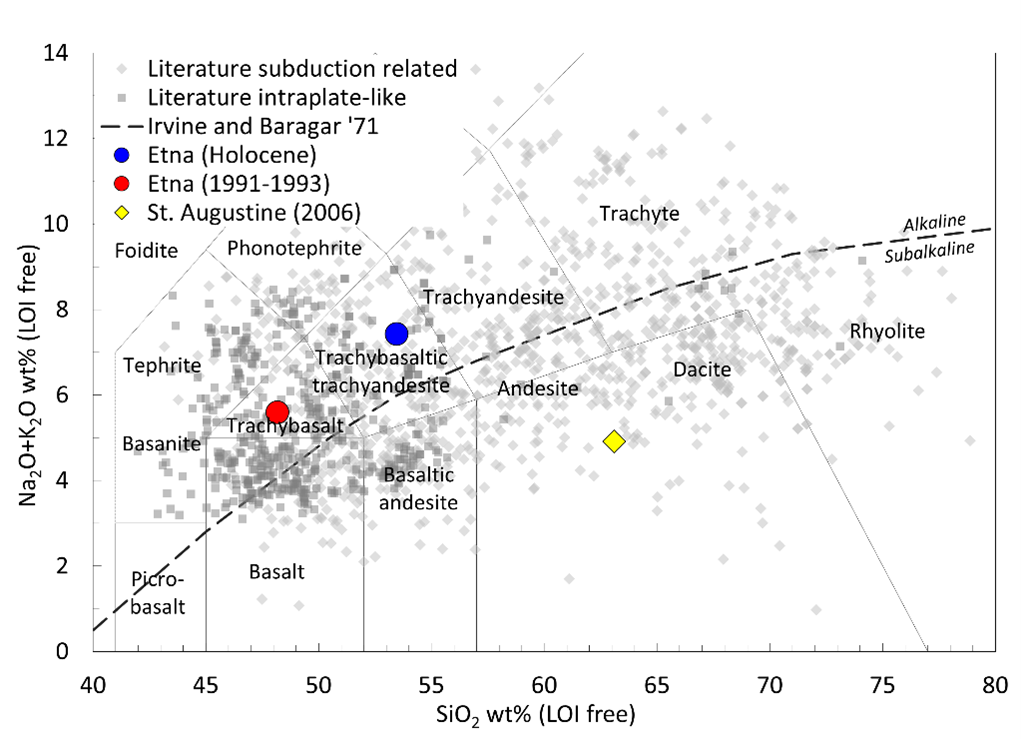
Figure 1. Total Alkali vs. Silica diagram of the samples.
Electromagnetic measurements and mixing formulas
The electromagnetic measurements were carried out with a two port Vector Network Analyzer (VNA), employing a cage coaxial cell and using the experimental procedure and setup described in [11]. The complex permittivity ε and magnetic permeability µ were estimated by using the Nicholson-Ross-Weir algorithm and the equations slightly modified in [12]:
where Fg is a factor related to the geometry of the cell, Γ and Ψ are the reflection and transmission coefficients, le = 5 cm is the electrical length of the cell, c is the velocity of the light in a vacuum and ν is the frequency. The complex effective permittivity of the two phases granular rock-air was studied using Lichtenecker and Bruggeman mixing formulas:
where εi and εeare respectively the permittivity of the environment (the solid grains) and inclusions (air) and f = 1- Φ is the volume fraction of the grainsin the sample, with Φ the porosity.
Results and conclusions
Measurements with the VNA were performed on the granular samples at room temperature, for percentage porosities ranging from 31% to 55%. The magnetic permeability µ is not reported because the three samples do not show a magnetic behavior (and then we can consider µ ≃ 1). Fig. 2 illustrates the complex dielectric permittivity as a function of frequency and at Φ = 0.36. Gray areas in the plots show values that are not reliable since at high frequencies the NRW algorithm diverges because of the cell resonances. Data have larger uncertainties at low frequencies due to VNA instrumental limits. The two Etna samples show a similar dielectric behavior, instead the St. Augustine sample has lower values of both real and imaginary part of permittivity. In the end, we fitted at 80 MHz the complex permittivity as a function of porosity using eqs. 3 and 4. In Tab. 1 we show the measurements at Φ = 0.36 and the values obtained with the mixing formulas at Φ = 0. The St. Augustine sample has the lower values of the solid complex permittivity, probably due to its lower iron abundances and higher abundances of SiO2, while the two Etna samples show a similar dielectric behavior. Further measurements will be required in the future in order to identify the relation between the electromagnetic properties and the geochemical compositions of volcanic rocks that can be accounted as good simulants of the surface and subsurface of terrestrial planets, such as Mars and Venus.
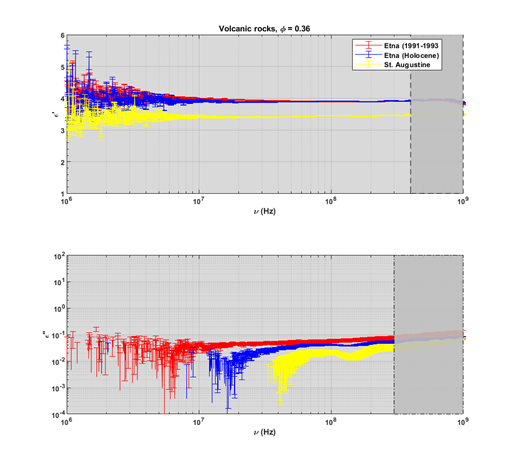
Figure 2. Complex permittivity frequency spectra of the samples.
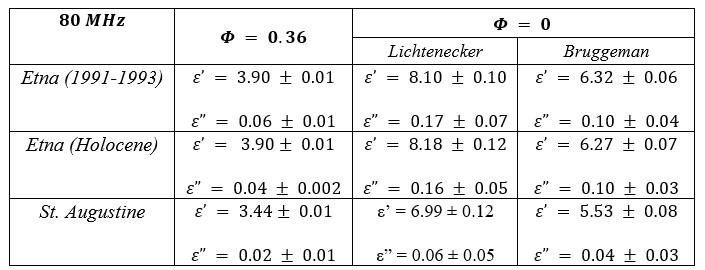
Table 2. Complex permittivity measured at Φ = 0.36 and fitted at Φ = 0 with eqs. 3 and 4.
References
- Orosei R. et al. (2018) Science, 361(6401), 490-493
- Lauro S. E. et al. (2020) Nat. Astron., 5(1), 63-70
- Smith I. B. et al. (2021) Geophys. Res. Lett. 48, 15
- Grima C. et al. (2022) Geophys. Res. Lett. 49.2, e2021GL096518.
- Mattei, E. et al. (2022). Earth and Plan. Sci. Lett. 579, 117370.
- Rust A. C. (1999) Jour. of Volc. and Geoth. Res. 91.1: 79-96.
- McSween Jr et al (2009) Science, 324.5928: 736-739.
- Larsen J. F. et al. (2010). Rapp. tecn. US Geological Survey.
- Calvari S. et al. (1994) Acta Vulcan., 4: 1-14.
- Vona A. et al. (2017) Chem. Geol., 458: 48-67.
- Brin A. et al. (2021) Icarus 114800.
- Mattei E. et al. (2013). IEEE trans. on instr. and meas., 62(11), 2938–2942.
How to cite: Brin, A., Salari, G., Lauro, S. E., Cosciotti, B., Mattei, E., and Pettinelli, E.: Electromagnetic and geochemical characterization of volcanic rock samples in the framework of radar exploration of terrestrial planets, Europlanet Science Congress 2022, Granada, Spain, 18–23 Sep 2022, EPSC2022-956, https://doi.org/10.5194/epsc2022-956, 2022.
Introduction:
The ESA ExoMars rover mission mainly focuses on the search for potential life-relevant molecules (large, non-volatile organic or biological molecules that suggest current or ancient prebiotic activity) at the Mars surface and near-subsurface. The Mars Organic Molecule Analyzer (MOMA) aboard the Rosalind Franklin rover will be a key analytical tool to provide chemical (molecular) information from solid samples collected by the rover. The characterization of the organic content in the sample is the main purpose of the instrument. The MOMA instrument comprises a gas chromatograph coupled to a mass spectrometer (GC-MS) which offers the unique capability to analyze and identify a wide range of organic molecules, including species of interest for life and prebiotic chemistry. Here we present an evaluation of the performance of the instrument from the analysis of a full set of samples of interest for Mars, using the Engineering Test Unit of the GC and MS instruments.
Method:
The samples delivered to MOMA will be analyzed either by UV laser desorption/ionization ion trap mass spectrometry (LDI-ITMS) or pyrolysis gas chromatography ion trap mass spectrometry (pyr-GC-ITMS). Samples containing organic compounds previously detected by LDI-ITMS and/or pyr-GC-ITMS can undergo further analysis through reaction with chemical derivatization reagents before characterization. These reagents (MTBSTFA, DMF-DMA, or TMAH), stored inside sealed capsules, induce a chemical reaction with the sample (in particular with its organic compounds) enhancing the volatility of complex organic species. Due to the need to prevent organic contamination of the Flight Model (FM) and Spare Model (SM) of MOMA, it was not possible to perform extensive analytical tests on them. For that reason, a series of tests were performed by coupling the GC and the MS Engineering Test Units (ETU) which are very close replica of the FM on board the Exomars rover.
The ETU GC (developed in France by LISA and LATMOS laboratories) was mated to the ETU ion trap mass spectrometer (developed in the USA by Goddard Space Flight Center) in a flight-like configuration (Fig. 1) for the coupling campaign. The MOMA GC ETU includes a tank filled with the carrier gas (helium), four separate analytical modules including columns and thermal conductivity detectors (TCDs) and two thermal injection traps. A homemade oven designed and built at LISA is used to mimic MOMA FM ovens. During the pyrolysis of the sample or after its chemical derivatization with one of the three reagents, the volatile compounds are injected and pre-concentrated in one of the traps. The trap is then flash-heated with a backflush carrier gas flow to release the trapped chemical species as quickly as possible into one of the GC columns. The GC column separates the different molecules. They are then ionized by the electron impact ionization source in the MS chamber and analyzed by the linear ion trap mass spectrometer. During the ETU campaign, the derivatization reagents (MTBSTFA, DMF-DMA, and TMAH) are added inside the oven by a syringe mimicking the release of reagent from the MOMA capsules.
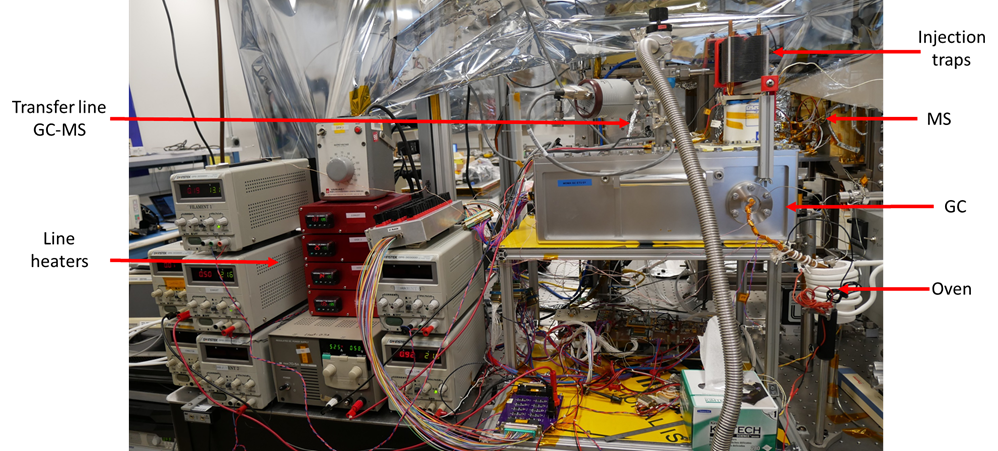
Figure 1: picture of the ETU gas chromatograph and the ETU MS ion trap.
Samples:
Several samples were studied during this campaign. Standard samples (standard gases, amino acids, carboxylic acids) were used to obtain the reference data. Then organic carbon-bearing natural and synthetic (mixing organic molecules and inorganic phases) Mars analog samples were analyzed, using both pyrolysis and derivatization as used in the MOMA instrument. These samples included JSC Mars-1, fragments of Murchison meteorite and synthetic samples composed of an organic-free mineral (vermiculite) doped with phenylalanine, phthalic acid and undecanoic acid. Also a synthetic “unknown” sample was used to run a blind analysis and to test the capability to identify a range of organic species under more realistic analytical conditions. This sample was used to simulate a day in the life of the instrument.
Results and conclusion:
The results described show the current state of end-to-end performance of the gas chromatography-mass spectrometry mode of operation. We show that from a technical point of view, the MOMA instrument works as expected. From a chemical perspective, we have shown that the four different types of MOMA analyses conducted here (pyrolysis and MTBSTFA, DMF-DMA, or TMAH derivatization) are efficient. Specific molecules have been detected (as expected) when using chemical standards. Analysis of the natural and synthetic samples reveals that a large number of molecules are released, and many species have been positively detected and identified (Fig. 2).
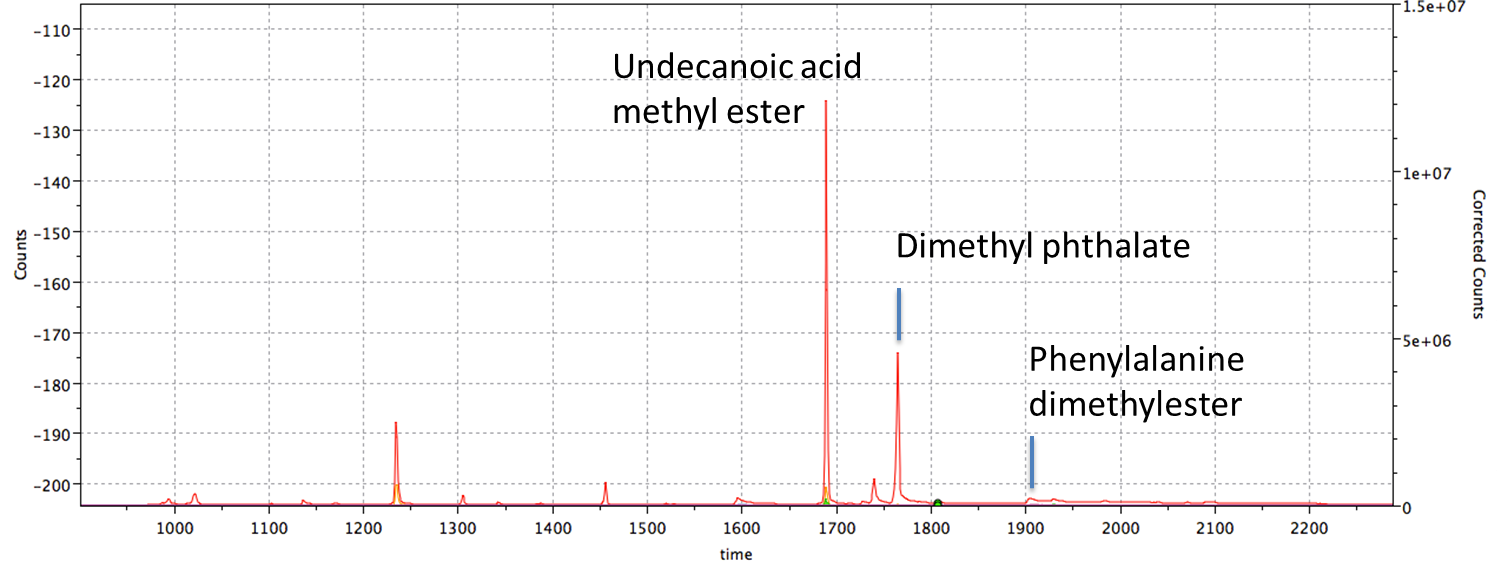
Figure 2 : Total ion chromatogram (TIC) for vermiculite doped with phenylalanine, phthalic acid and undecanoic acid after online DMF-DMA derivatization.
How to cite: Azémard, C., Stalport, F., Kaplan, D., Danell, R., Szopa, C., Buch, A., Chaouche, N., Freissinet, C., van Amerom, F., Grand, N., Zapf, P., Raulin, F., Guzman, M., Fornaro, T., Li, X., Grubisic, A., Siljeström, S., Cottin, H., Brinckerhoff, W. B., and Goesmann, F.: Analytical capabilities of the MOMA GC-MS instrument of the Exomars mission assessed from the analysis of a variety of samples with the Engineering Test Units (ETU), Europlanet Science Congress 2022, Granada, Spain, 18–23 Sep 2022, EPSC2022-1008, https://doi.org/10.5194/epsc2022-1008, 2022.
The Raman Laser Spectrometer (RLS) is part of the analytical payload located inside Rosalind Franklin rover for the Exomars Mission to Mars.
The RLS instrument consists of three main units: 1) the optical head that focus the laser excitation on the sample and collect the scattered light from the same area (with a 50 microns spot); 2) the spectrometer analyzing the Raman signal in the spectral range 150-3800 cm-1 with an average spectral resolution of 8 cm-1 and 3) an electronic control unit in which the laser is included. These units are connected by optical fibers and electrical hardness. The instrument will investigate powdered samples collected by the rover at the surface and subsurface of Mars at the mineral grain scale. (1)
The RLS development stages comprised the development, verification, test and evaluation of the scientific performances of two main models: Engineering Qualification Model (EQM) and Flight Model (FM).
Because the consecutive delays in Exomars launch to Mars an important aspect related with this situation is the evaluation of the scientific performances with time of these models comparing the results obtained at the pre-delivery stage with those obtained at the rover analytical laboratory drawer (ALD) and rover integrated stages.
Additionally it is also of great interest evaluate the scientific results obtained in the framework of dedicated science activities currently ongoing at the ALD and rover levels in which the evaluation of the combined science potential among the three instruments inside Rosalind Franklin rover (MicrOmega, RLS and MOMA) is outstanding.
In the present work interest is devoted to the scientific performances evaluation of the RLS-FM at the different levels: pre-delivery, rover analytical drawer (ALD) and finally integrated on the Rosalind Franklin rover.
For that, observation of the data obtained on the calibration target (CT) is mainly used although data obtained on standard and natural samples at the pre-delivery stage are also presented and discussed.
Instrument response as function of temperature, atmospheric pressure conditions and changes on the main acquisition parameters was evaluated. Estimation of the different band parameters observed (band position, intensity, bandwidth and SNR) allowed performances comparison along the different phases of the process and comparison with the established scientific requirements.
References:
- Rull, S. Maurice, I. Hutchinson, A. Moral et al., Astrobiology, 2017, 17, 627-654.
How to cite: Rull, F., Moral, A., Lopez-Reyes, G., Perez, C., Seoane, L., Zafra, J., Veneranda, M., Manrique, J. A., Rodriguez, E., Rodriguez, P., Belenguer, T., and Prieto, O.: Scientific performances evaluation of the Raman Laser (RLS) FM-instrument for Exomars mission to Mars, Europlanet Science Congress 2022, Granada, Spain, 18–23 Sep 2022, EPSC2022-1068, https://doi.org/10.5194/epsc2022-1068, 2022.
Mars Express has the distinction of being one of the oldest operational spacecraft at Mars, with over 18 years since its injection into Martian orbit in December 2003. Designed for a nominal mission of one Martian year to survey the red planet, it is currently applying for its 9th mission extension. A recent technical review has concluded that Mars Express was technically fit to continue providing excellent science return for the 2023-25 and 2026-28 extension intervals.
The spacecraft subsystems, scientific payload and ground segment are in overall good health, allowing continued smooth mission and science operations. The 3 lifetime-limiting elements of the spacecraft are the gyros, the batteries, and the fuel remaining onboard. The situation of the gyros has been improved by the successful implementation of a gyroless operations mode in May 2018 by the Mars Express teams at ESOC and ESAC. This difficult modification saved the mission and now allows an IMU duty cycle currently reduced to a monthly figure of about 3 to 4 % of the original usage. Mars Express can expect its gyro lifetime to be extended well beyond the 2025 timeframe.
Studies performed in 2019 and 2020 have shown the spacecraft batteries to be much less degraded than had previously been assumed. The findings of these studies were substantiated in subsequent eclipse seasons. A new battery power model now used operationally allows for more flexibility in science planning particularly during eclipse seasons. The longest, most challenging eclipses of the mission were passed successfully in 2021. With shorter eclipse durations in the coming years the outlook is very favourable for continuing to operate the batteries well beyond 2030.
The fuel situation remains satisfactory based on regularly actualised estimates and on a very low fuel consumption (assuming no safe modes; the last one was in 2011). The estimated ~3kg of usable hydrazine (with high confidence based on the Venus Express experience) left onboard can take the spacecraft mission operations to beyond 2030 with the current load of science operations.
Planning and execution of science operations have been improved by upgrades to the mission operations run from the MOC at ESOC and to the Science Ground Segment operations done at ESAC near Madrid. More flexible, rationalised and in some cases even reduced constraints are now in place which enhance the capability of the spacecraft and its payload in performing scientific observations and data taking.
Finally, new science opportunities are presenting themselves in the coming years, illustrated recently by the routine implementation of mutual radio occultations between Mars Express and the ExoMars Trace Gas Orbiter. This will greatly expand the number of atmospheric observations in the future. Automated dual-band radio science occultation observations have now been implemented at egress. The MARSIS subsurface radar is implementing two new promising modes of operation, one to investigate the subsurface at a better sampling rate and one to characterise Phobos, the largest Martian moon and future target for Japan’s MMX mission. Another proposed mission capability will be to perform active sounding of the local plasma environment using combined operation of the ASPERA particle detector and the MARSIS radar. MELACOM relay operations have increasingly taken place with regular Mars Surface Laboratory overflights and were also recently upgraded to implement CNSA’s Zhurong rover overflights and prepare for supporting the ExoMars rover mission as well as other NASA landed assets. These are only a limited set of examples of how Mars Express keeps delivering new and exciting science return.
Interplanetary missions can operate over many years and learning how to use the technology in ways that were maybe not part of the original operational concept is an incredibly important ability. The above demonstrates that the Mars Express teams have been able throughout the mission’s many years of life to render Mars Express a better spacecraft now than at any time before, with in-flight upgrades that kept the mission flying. Those teams were able to make such changes thanks to: robust in-house control and support of the ESAC-run MAPPS planning software allowing for continuous improvement; Flight Control Team with enough skill and resources to modify and fully test the flight code; instrument teams with enough funding and support to allow for software updates/testing late in the mission. This might help younger and upcoming missions assemble the resources now so that they can attempt life-extending changes later.
Combining a special set of payload instruments onboard Mars Express, very resilient spacecraft and payload health and a favourable orbit configuration, this makes for a still unique mission at Mars, very much complementary to newer orbiting elements with different capabilities. ESA is getting the most out of Mars Express and will continue to do so in the coming years, contributing to and enhancing the international cooperation at Mars.
How to cite: Martin, P., Titov, D., Wilson, C., Godfrey, J., Cardesin-Moinelo, A., Blake, R., Dressler, T., Lucas, L., Johnstone, A., Mueller, M., Wood, S., Esquej, P., Merritt, D., Sierra, M., Marin-Yaseli de la Parra, J., Heather, D., Grotheer, E., Breitfellner, M., and Muniz-Solaz, C.: Getting the Most Out of Mars Express, Europlanet Science Congress 2022, Granada, Spain, 18–23 Sep 2022, EPSC2022-1080, https://doi.org/10.5194/epsc2022-1080, 2022.
Mars Express
With almost two decades of Mars observation behind it, Mars Express remains a dependable and highly productive mission.
Recent science highlights include (1) continued mapping of subsurface reflectors beneath the south polar layered ice deposits, and associated work to explain the cause of these reflections; (2) a global map of minerals on Mars with 200 m/px resolution, obtained from analysis of infrared spectra; (3) release of 50 m resolution Digital Elevation Models based on HRSC stereo topography for quadrangles covering an ever-increasing proportion of the global surface; (4) detailed characterization of the landing sites of the ESA, NASA and Chinese rovers; (5) a global climatology of ozone and water from both nadir and occultation observations and its relation to atmospheric dust; (6) transient atmospheric phenomena, such as a recurrent orographic cloud feature at Arsia Mons; (7) detailed investigation of the ionospheric structure, its variability, and coupling to the lower atmosphere; (8) continued monitoring of both the upstream solar wind conditions and of downstream escaping ions; (9) detailed study of Phobos during flybys at altitudes as low as 50 km.
Spacecraft and instrument teams continue to implement new and improved observation modes. One example is new MARSIS instrument software which now allows raw data to be returned from much longer subsurface sounding passes, improving the search for basal reflectors beneath polar ice caps; another example is mutual radio occultation observations between Mars Express and ExoMars Trace Gas Orbiter, potentially providing vertical profiles of ionospheric electron content with good spatial and temporal coverage.
ExoMars Trace Gas Orbiter
TGO has now completed two full Martian years of observations.
Highlights include (1) continuing non-detection of methane, with upper limits as low as 20 ppt by volume. Reconciling this continued non-detection by TGO with the background levels of several hundred ppt in Gale crater by MSL remains an enigma, stimulating further research. (2) detection of HCl, the first reported halogen-containing species in the atmosphere of Mars. (3) further detail of the transport of water to high altitudes, a critical step in the escape of water from Mars. (4) mapping of atomic hydrogen in the top 1-2 m of regolith, indicative of water ice and hydrated minerals, suggesting surprisingly high abundances of subsurface water ice in low latitude regions including one in central Valles Marineris; and (5) continued acquisition of 5 m colour imagery and digital elevation models over a wide range of terrain and target types, including landing site characterization.
Future plans: Mission extension cases for both missions have been submitted for the years 2023-2025 and 2026-2028. The extension of the observations would allow several new and optimized observation types; in particular, it will allow many collaborative observation opportunities with other missions and with ground- and space-based observatories. Of particular note are joint observations with James Webb Space Telescope, for which dedicated observations of Mars are due to be conducted in 2022-2023. Science goals include mapping of the water D/H ratio, search for trace gases including methane, and mapping of thermospheric structure using 4.3 μm CO2 emission; the full-disk views provided by JWST are highly complementary to the vertical profiling and long temporal coverage provided by MEx and TGO.
How to cite: Wilson, C., Titov, D., Martin, P., Cardesin Moinelo, A., Frew, D., Carter, J., Giuranna, M., Holmstrom, M., Montmessin, F., Orosei, R., Paetzold, M., Roatsch, T., Sanchez-Lavega, A., Korablev, O., Mitrofanov, I., Thomas, N., and Vandaele, A. C.: Mars Express and Trace Gas Orbiter – status, science highlights, plans, Europlanet Science Congress 2022, Granada, Spain, 18–23 Sep 2022, EPSC2022-1136, https://doi.org/10.5194/epsc2022-1136, 2022.
TP6 | Martian dust and clouds: from lab to space
Due to the specific atmospheric pressure of a few mbar, Mars is the only planet in the Solar System where thermal creep gas flow occurs naturally within its soil [1,2,3,4,5,6]. As with most flows, this comes with pressure variations. Especially below the top layers of grains, an overpressure develops which sets the soil under tension and supports the lifting of grains from the ground [1,2]. In de Beule et al. 2015, the thickness of an ejected dust layer was measured to be on the order of 200 µm, though upward directed (lifting) forces might also be present further down. This is also in agreement to numerical calculations [2,7]. However, pressure varies on rather small distances of sub-mm which is not easily measurable in a granular bed directly, as small disturbances or changes in the setting already influence the gas flow. So any method of verification of a sub-soil overpressure seems desirable.
Here we use diffusive waves spectroscopy to study the subtle motion of grains within the soil. Illuminating the side of a model soil with a laser beam, scattering and interference lead to a speckle pattern. This pattern changes if particles slightly move. Therefore, a correlation of the patterns over time gives positions depending on the depth where grains move more or less, showing a stratified soil with respect to motion. Among other features, we find a first minimum of particle motion below the surface which shows the characteristic pressure dependence of thermal creep. Specifically, a characteristic maximum depth of about 2 mm is found at about 4 mbar. This depth is somewhat larger than found by de Beule et al. 2015 but in view of the different methods, our measurements are yet another verification that thermal creep sub-soil overpressure is very likely a general mechanism on Mars supporting particle lift [8].
- C. de Beule, G. Wurm, T. Kelling, M. Kuepper, T. Jankowski, and J. Teiser, The Martian Soil as a Planetary Gas Pump, Nature Physics, 10:17-20, 2014.
- C. de Beule, G. Wurm, T. Kelling, M. Köster, and M. Kocifaj, An Insolation Activated Dust Layer on Mars, Icarus, 260:23-28, 2015.
- M. Kuepper and G. Wurm, Thermal Creep Assisted Dust Lifting on Mars: Wind Tunnel Experiments for the Entrainment Threshold Velocity, Journal of Geophysical Research – Planets, 120:1346-1356, 2015.
- M. Kuepper and G. Wurm, Amplification of Dust Loading in Martian Dust Devils by Self-Shadowing, Icarus, 274:249-252, 2016.
- F. Schmidt, F. Andrieu, F. Costard, M. Kocifaj, A.G. Meresescu, Formation of recurring slope lineae on Mars by rarefied gas-triggered granular flows. Nat. Geosci. 10:270–273, 2017.
- M. Koester, T. Kelling, J. Teiser, and G. Wurm, Gas Flow within Martian Soil: Experiments on Granular Knudsen Compressors, Astrophysics and Space Science, 362:171 1-10, 2017.
- M. Kocifaj, J. Klačka, T. Kelling, G. Wurm, Radiative Cooling within Illuminated Layers of Dust on (Pre)-Planetary Surfaces and its Effect on Dust Ejection, Icarus, 211:832-838, 2011.
- T. Bila, J. Kollmer, J. Teiser, and G. Wurm, Thermal Creep on Mars: Visualizing a Soil Layer under Tension, (in prep), 2022.
How to cite: Wurm, G., Bila, T., Teiser, J., and Kollmer, J.: Martian Soil under Tension: Visualizing Thermal Creep Gas Flow by Diffusive Wave Spectroscopy, Europlanet Science Congress 2022, Granada, Spain, 18–23 Sep 2022, EPSC2022-65, https://doi.org/10.5194/epsc2022-65, 2022.
The atmosphere of Mars is driven by different cycles – seasonal cycles of temperature, dust, ice, water vapour, CO2, etc. – which are coupled through transport: dust is blown from the surface by winds, carried aloft where it absorbs solar radiation and heats the atmosphere, impacting temperature, composition and winds. Formation of water ice crystals scavenges dust back from the surface. Water, being involved in the creation processes of clouds, is one of the most important species in the atmosphere. It controls the stability of the atmosphere, dominates its chemistry, and has a radiative impact through the formation of clouds.
Dust is present everywhere on Mars, yet its abundance, physical properties, size distribution as well as impact on the composition, structure and dynamics of the atmosphere has today only barely been addressed and understood. However, knowledge of the characteristics of aerosols (such as dust, ices, clouds and haze) is crucial for the interpretation of the IR and UV spectra because they absorb in these spectral regions, and their absorption signature overlaps the absorption features of other species (such as O3 in the UV), and they regulate the travelling path of light in the atmosphere through absorption and (multiple) scattering. Their impact is difficult to accurately estimate because their spectral characteristics are not known with enough accuracy.
The goal of the ROADMAP project (ROle and impAct of Dust and clouds in the Martian AtmosPhere) is to better characterize the Martian dust and clouds in terms of size, shape and loading within the atmosphere, but also to provide laboratory reference data which will be used to improve our knowledge on the genesis, transport and impact of dust and clouds on the Martian atmosphere.
The team behind the RoadMap project brings together the laboratory community, scientists involved in space missions and numerical modellers to promote synergies through their different perspectives and experiences: laboratory scientists understand the reference data and know-how to extract the most value from their experiments; mission scientists know the intricacies and potential of the instruments and the details of their calibration; numerical modellers know what data, information and parameters are most pertinent to their simulations and how best to interpret the results.
We will describe the methodology behind the project and show how we intend to improve space exploration (observation and modelling of the atmosphere) using new laboratory results (dust resuspension induced by saltation, scattering properties, etc).
The RoadMap (ROle and impAct of Dust and clouds in the Martian AtmosPhere) project has received funding from the European Union’s Horizon 2020 research and innovation programme under grant agreement No 101004052.
How to cite: Vandaele, A. C., Merrison, J., Wurm, G., Munoz, O., Jardiel, T., Lindqvist, H., Wolff, M., Neary, L., Willame, Y., Piccialli, A., Trompet, L., Flimon, Z., Abesha, A., Becker, T., Martikainen, J., Gomez-Martin, J. C., and Peiteado, M.: RoadMap to understand the role of dust in the atmosphere of Mars, Europlanet Science Congress 2022, Granada, Spain, 18–23 Sep 2022, EPSC2022-576, https://doi.org/10.5194/epsc2022-576, 2022.
Thermal infrared observations made from the surface of Mars by the Perseverance rover and from orbit by the Emirates Mars mission enable the retrieval of dust aerosol optical depth at all local times, both day and night. Observations from the rover are useful for characterizing the localized, short timescale changes in dust optical depth, particularly during dust storms, while observations from the orbiter and useful for identifying global trends and temporal variations on longer timescales, from diurnal to seasonal. Together, these two vantage points provide complementary information that helps to understand the variations of dust over different temporal and spatial scales.
1. Introduction
1.1 Perseverance TIRS data:
The Thermal InfraRed Sensor (TIRS) package on the Perseverance rover consists of five sensors used to characterize the upward and downward fluxes of visible and infrared radiation at the rover site (Rodriguez-Manfredi et al., 2021). Of interest here are the sensors TIRS IR1, which covers a broad portion of the thermal-infrared spectrum over the range 6–35 µm and TIRS IR2, which covers the CO2 band between 14.5 and 15.5 µm. Both sensors view upward at an elevation angle centered at 35° above the rover deck. As part of the MEDA suite of atmospheric sensors, TIRS observations are taken systematically throughout the sol at a frequency of 1 Hz. Observations in one-hour blocks are generally taken so that odd-numbered hours are covered on odd-numbered sols, while even-numbered hours are covered on even-numbered sols. In that way the entire 24-hour diurnal cycle is fully covered over a span of 2 sols. These observations are a part of the background baseline set for MEDA that runs essentially every day providing excellent diurnal and seasonal coverage.
We use a radiative transfer model to compute the expected TIRS IR1 and IR2 signal for a given aerosol optical depth and temperature profile. We can then perform the retrieval by varying the atmospheric temperatures and aerosol optical depth to match the values observed by TIRS. The radiative transfer model includes aerosol scattering using a 2-stream approximation (e.g., Smith et al., 2006) and treats absorption by CO2 gas using the correlated-k approximation (Lacis & Oinas, 1991).
1.2 Emirates Mars Mission EMIRS data:
EMIRS is a thermal infrared spectrometer that observes Mars at wavelengths between ~100 and 1600 cm-1 (~100 and 6 µm) at a spectral resolution of 5 or 10 cm-1 (Edwards et al., 2021). From its 55-hour period orbit that varies between 20,000 and 43,000 km altitude, EMIRS raster scans the disk of Mars ~20 times during each orbit to provide a global, synoptic view of Mars that samples all local times, both day and night (Amiri et al., 2021). Over the course of approximately 4 orbits (or 10 days), sufficient observations are taken to provide a broad sampling of all local times at nearly all latitudes and longitudes. The typical footprint size is ~100–300 km, which is consistent with modern global circulation models and is sufficient to provide a detailed global view of the current climate state.
We follow the constrained linear inversion algorithm of Conrath et al. (2000) and Smith et al. (2006) to retrieve atmospheric state parameters that best match the observed spectra of Mars from EMIRS. The radiative transfer model includes a discrete ordinates treatment of multiple scattering (e.g., Goody & Yung, 1989; Thomas & Stamnes, 1999) to accurately model dust and water ice cloud aerosols, and it accounts for the absorptions from CO2 and water vapor gases using the HITRAN database (Gordon et al., 2022) and the correlated-k approximation (Lacis & Oinas, 1991).
Given that the spectral signatures of gases and aerosols are relatively well separated in the spectral range observed by EMIRS, the retrieval is performed sequentially for the atmospheric temperature profile, the column optical depths of dust and water ice aerosol, and the column abundance of water vapor. This sequence can be iterated to obtain a self-consistent solution.
2. Results
Figure 1 shows an example of Perseverance/TIRS retrieval of the complex time history of dust optical depth during a regional dust storm that occurred during January 2022. Here, the sol numbers label midnight LTST. During the active period of this dust event between sols 313 and 317 (5–9 January 2022, Ls=153°–156°) there were numerous spikes in aerosol optical depth with several exceeding unity (at 9 µm). These spikes in aerosol (dust) optical depth occurred preferentially during the day but appear equally in both the morning and the afternoon. Retrievals of dust optical depth outside the dust storm period showed a combination of variations on many timescales from very short (minutes), to diurnal, to the overall seasonal trend.
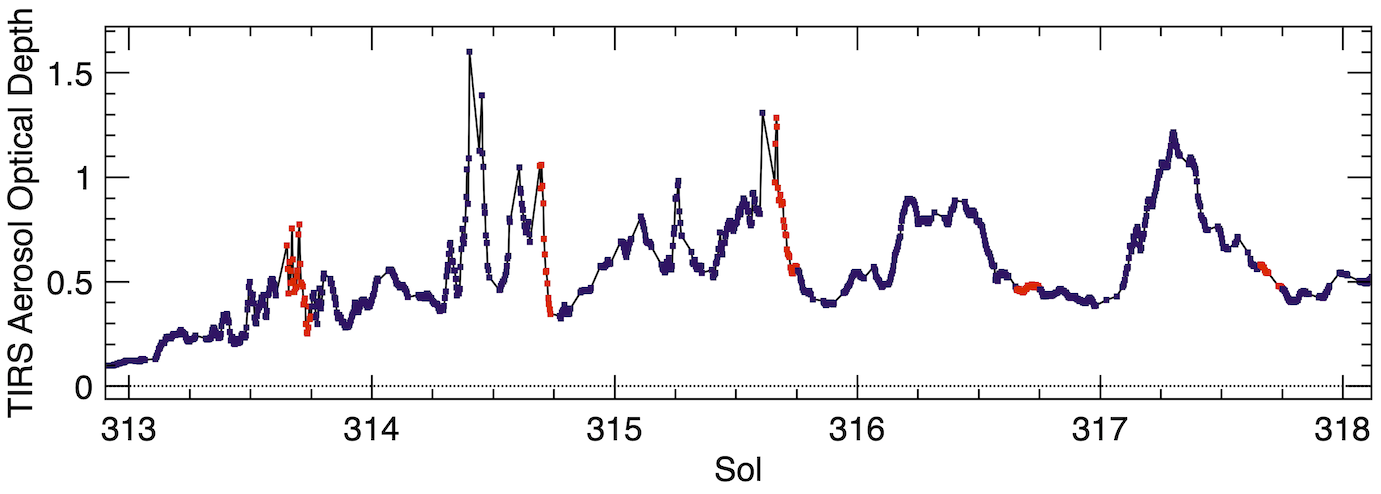
Figure 1. The detailed time history of dust optical depth retrieved from Perseverance TIRS observations during the January 2022 regional dust storm. Local variations on short timescales are apparent.
The January 2022 regional dust storm was also observed by the Emirates Mars Mission/EMIRS instrument. Figure 2 shows a global-scale view of the initiation, growth, and decay of the storm as observed from orbit. Over the course of several days localized dust activity intensified and spread equatorward becoming a regional storm. New dust lifting quickly diminished and the dust was carried by the general circulation to all longitudes before slowly settling out of the atmosphere. These dust retrievals provide global context to those from the rover.
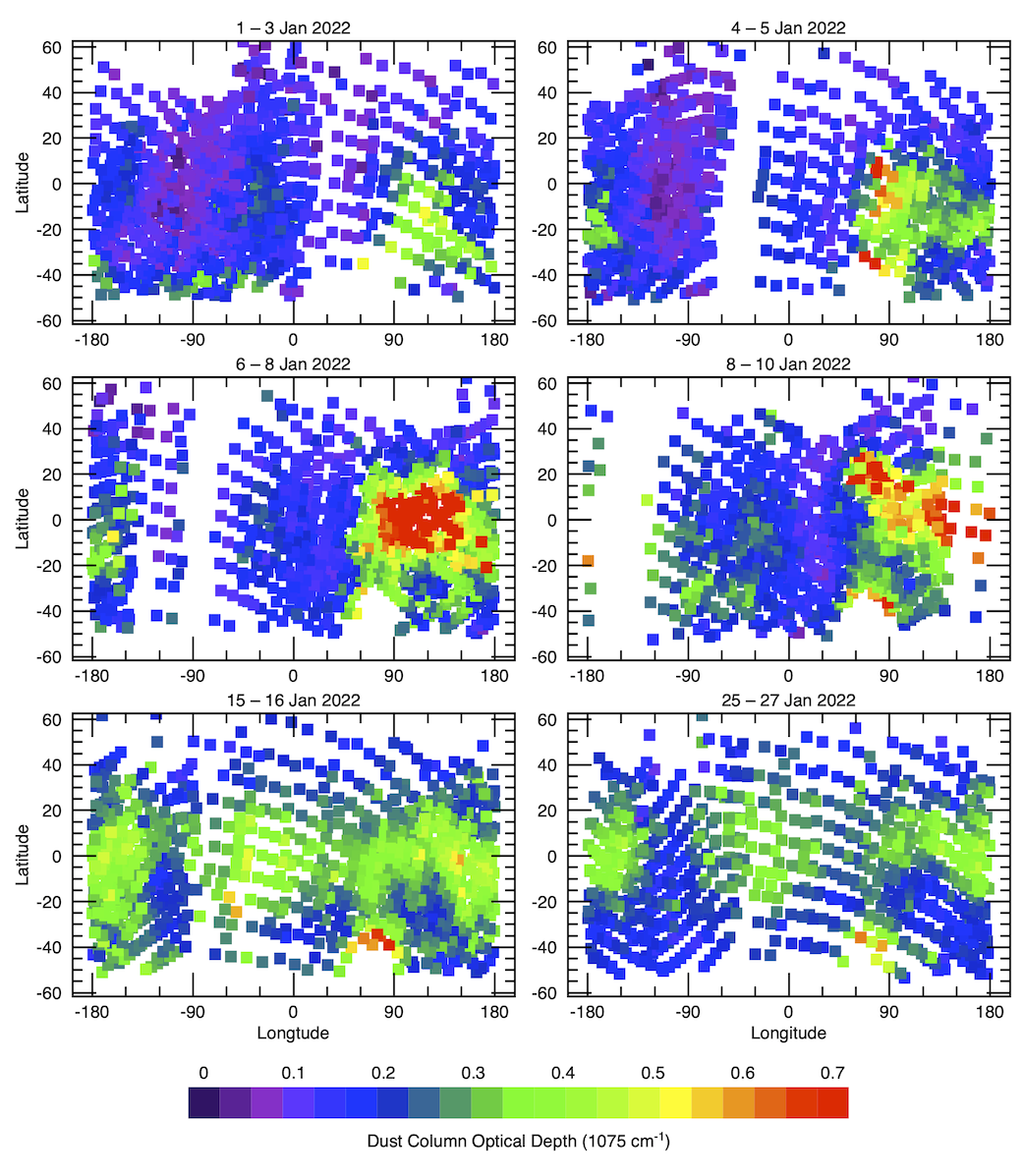
Figure 2. The time history of the global aerosol dust optical depth retrieved from EMIRS observations during the January 2022 regional dust storm. A global view of the evolution of dust is possible from orbit.
References
Amiri, H.E. S. et al., 2021. Space Sci. Reviews, 218:4, doi:10.1007/s11214-021-00868-x.
Conrath, B.J. et al, 2000. J. Geophys. Res., 105, E4, 9509–9519.
Edwards, C.S. et al., 2021. Space Sci. Reviews, 217:77, doi:10.1007/s11214-021-00848-1.
Goody, R.M. & Yung, Y.L., 1989. Atmospheric Radiation: Theoretical Basis. Oxford Univ. Press.
Gordon, I.E., et al., 2022. JQSRT, 277, doi:10.1016/j.jqsrt.2021.107949.
Lacis, A.A. & Oinas, V., 1991. J. Geophys. Res., 96, 9027–9063.
Rodriguez-Manfredi, J.A. et al., 2021. Space Sci. Reviews, 217:48, doi:10.1007/s11214-021-00816-9.
Smith, M.D., et al., 2006. J. Geophys. Res., 111, E12S13, doi:10.1029/2006JE002770.
Thomas, G.E. & Stamnes, K., 1999. Radiative Transfer in the Atmosphere and Ocean, Cambridge Univ. Press.
How to cite: Smith, M., Badri, K., Atwood, S., Martínez, G., Sebastián, E., Apéstigue, V., Arruego, I., Toledo, D., Viúdez, D., Manfredi, J. A., Edwards, C., Smith, N., Wolfe, C., Wolff, M., Christensen, P., Anwar, S., Lemmon, M., AlTunaiji, E., and de la Torre, M.: The diurnal and seasonal variation of dust observed by the Perseverance rover and Emirates Mars Mission, Europlanet Science Congress 2022, Granada, Spain, 18–23 Sep 2022, EPSC2022-599, https://doi.org/10.5194/epsc2022-599, 2022.
Abstract
We present our progress on improvements to the GEM-Mars GCM in the context of the Horizon 2020 RoadMap Project. Through an integrated approach involving lab measurements, micro-modelling, global climate modelling and remote sensing observations, the project aims to better understand the role and impact of dust and clouds on the Martian atmosphere.
Within this project, we use the data from lab experiments and micro-modelling to improve the GEM-Mars Global Climate Model (GCM), with a focus on dust optical properties, mechanisms for dust lifting and microphysical processes.
Introduction
There are still many unknowns and limitations in GCM simulations which cause inaccuracies in the modelled fields, and many of the uncertainties are related to aerosols in the Mars atmosphere. For example, the size distribution and radiative properties of dust and water ice particles are not well known. Through better characterisation of dust from laboratory measurements, we can improve the GCM simulations, and therefore improve the a priori required for data retrieval. As dust is the condensation nuclei for water ice clouds, we can also improve the microphysical representation of these clouds in the model, which in turn will provide more realistic temperatures and global circulation. The interactions in the RoadMap project will also allow to improve the representation of dust lifting, and better define the locations where dust is lifted from the surface, and when.
The GEM-Mars GCM
GEM-Mars is a three-dimensional grid-point based global climate model for the atmosphere of Mars. The physical processes and atmospheric chemistry included are described in Daerden et al., (2019) and Neary and Daerden (2018). GEM-Mars has been applied and evaluated to several recent science investigations including Smith et al. (2021), Bouche et al. (2021), Aoki et al. (2019), Aoki et al. (2022) and Trompet et al. (2022). The impacts of the 2018 global dust storm on the Martian atmosphere were explored in Neary et al. (2019), Daerden et al. (2022a,b) and Khayat et al. (2021). GEM-Mars also participated in a joint modelling exercise for the meteorological conditions at the landing site of the Mars 2020 mission (Newman et al., 2021).
Dust lifting and aerosol properties
Lab experiments using Martian analogue soils were performed by our partners at Aarhus University and the University of Duisburg-Essen and have contributed to an updated formulation of threshold wind stress to describe when lifting may occur. With the same analogue soils (prepared at the Insituto de Ceramica y Vidrio, CSIC-ICV), the scattering properties are being investigated by our partners at the Instituto de Astrofisica de Andalucia (CSIC-IAA). Results from both these lab experiments are then applied and tested in the GEM-Mars GCM.
Microphysics
Currently, GEM-Mars applies a simple dust and cloud scheme. Dust is lifted from the surface in 3 size bins (0.1, 1.5 and 10 µm) and transported by advection, mixing and sedimentation across the atmosphere. Water ice is formed at saturation (100% RH) and condensed into a single Ice Water Content (IWC) tracer. Sedimentation and radiative effects of water ice are calculated by prescribing a fixed particle radius, and assuming the particles are spherical. To obtain a reasonable water cycle over the planet and over the Martian year, the water ice sizes have to vary over altitude. In the current GEM version, these are: 1 μm above 10 km, 2 μm between 5 and 10 km, and 8 μm below 10 km. In addition, to prevent the formation of optically thick clouds over the north polar water ice cap, particle sizes are set to 150 µm below 10 km in summer (Ls = 80°–150°) (Daerden et al., 2022a).
As part of the RoadMap project, we implement a more sophisticated microphysical representation of the formation of ice clouds based on the work of Daerden et al. (2010). The scheme includes the nucleation of water ice on dust particles, deposition and sublimation of water vapour on size-resolved ice and the sedimentation of particles. In Daerden et al. (2010), a one-dimensional model with 100 particle size bins was used. Sensitivity tests using this model helped to improve the computational time for implementation in the 3D GCM. By using fewer particle size bins, we can maintain the basic features of cloud formation while greatly reducing the computational time.
Summary
We will present our progress on the implementation of new dust lifting parameters, and on the development of the size-resolved microphysical representation of dust and clouds. We will first focus on the radiative impact of the increased number of dust particle sizes on the overall global dust cycle.
Acknowledgements
This project has received funding from the European Union’s Horizon 2020 research and innovation programme under grant agreement No 101004052. The authors acknowledge funding by the Belgian Science Policy Office (BELSPO), with the financial and contractual coordination by the ESA Prodex Office (PEA 4000103401, 4000121493).
How to cite: Neary, L. and Daerden, F. and the The RoadMap Team: Improvements to dust and aerosols in GEM-Mars GCM simulations: Results from the RoadMap project, Europlanet Science Congress 2022, Granada, Spain, 18–23 Sep 2022, EPSC2022-637, https://doi.org/10.5194/epsc2022-637, 2022.
1. Introduction
Thermal infrared datasets from planetary bodies have the potential to provide key insights for the understanding of a planet's climate evolution and history: valuable information about composition, temperature and state of the atmosphere can be retrieved from thermal spectral data.
In this work, we present the application of a methodology based on Principal Component Analysis (PCA) and Target Transformation (TT) Factor Analysis (FA) techniques to thermal infrared data of the ExoMars2016 Trace Gas Orbiter (TGO) with the main goal to retrieve the different particulate atmospheric contributions present in the spectra and separate them from the surface contributions.
2. Instrument and dataset
TGO has a suite of spectroscopic instruments for the investigation of the Red Planet in the infrared spectral range known as Atmospheric Chemistry Suite (ACS) [1] consisting of three spectrometers observing Mars in solar occultation, nadir and limb geometry in the Near-InfraRed (NIR), Mid-InfraRed (MIR) and Thermal InfraRed (TIR) spectral channels. Among them, the ACS thermal-infrared channel (TIRVIM) covers the spectral range between 1.7-17 μm with apodized resolution varying from 0.2 to 1.3 cm−1 [1]. TIRVIM has similar capabilities to IRIS (Mariner 9), TES, and PFS in several aspects, but has some advantages: - higher spectral resolution; - better noise equivalent radiance (from 0.08 mW/m2/sr-1/cm-1); - dense spatial coverage (TGO has a circular orbit of 400 km) [1].
Martian TIRVIM spectra acquired along the orbits that cross Elysium Planitia, landing site of the NASA’s Insight (Interior exploration using Seismic Investigations, Geodesy and Heat Transport) lander, were here analyzed. The selected data orbits span from Ls=150°C to Ls=210°C, covering part of the Martian summer and of the Martian autumn going through the autumn equinox in the northern hemisphere of the planet. Corresponding Local Times cover Martian days and nights.
3. Methodology
To analyze the ExoMars TIRVIM data and retrieve and characterize the number of varying atmospheric components present in these data and their spectral shape, a methodology was applied based on a combination of PCA and TT – FA techniques [2, 3]. These techniques are demonstrated to be able to extract the composition of laboratory samples [4, 5]; to extract the principal varying components from a big spectral dataset in the thermal infrared [3], and then to identify them as components of the atmosphere and separate their contribution from surface emission [6]. This methodology, previously successfully adopted for the analysis of TES and PFS data [2, 7], was, here, applied for the first time to the analysis of the new and at higher spectral resolution TIRVIM dataset. Considering that the PCA works best when the different components have significant variation in the data, we selected data where these variations are more likely to occur: the analyzed data cover diurnal as well as seasonal variations.
A list of PFS and TES atmospheric end-members extracted from [3] and [2] were used as initial guess for the TT, to interpret the abstract eigenvectors retrieved from the PCA and attribute them a physically coherent meaning.
4. Results and future developments
Spectral shapes of atmospheric dust and water ice aerosols were recovered from the analyzed TIRVIM data. Comparisons with results previously obtained on PFS and TES data (Figure 1) validate the methodology used and show that it is capable of determining the number of independently variable components and recovering the spectral endmembers present in the TIRVIM data.
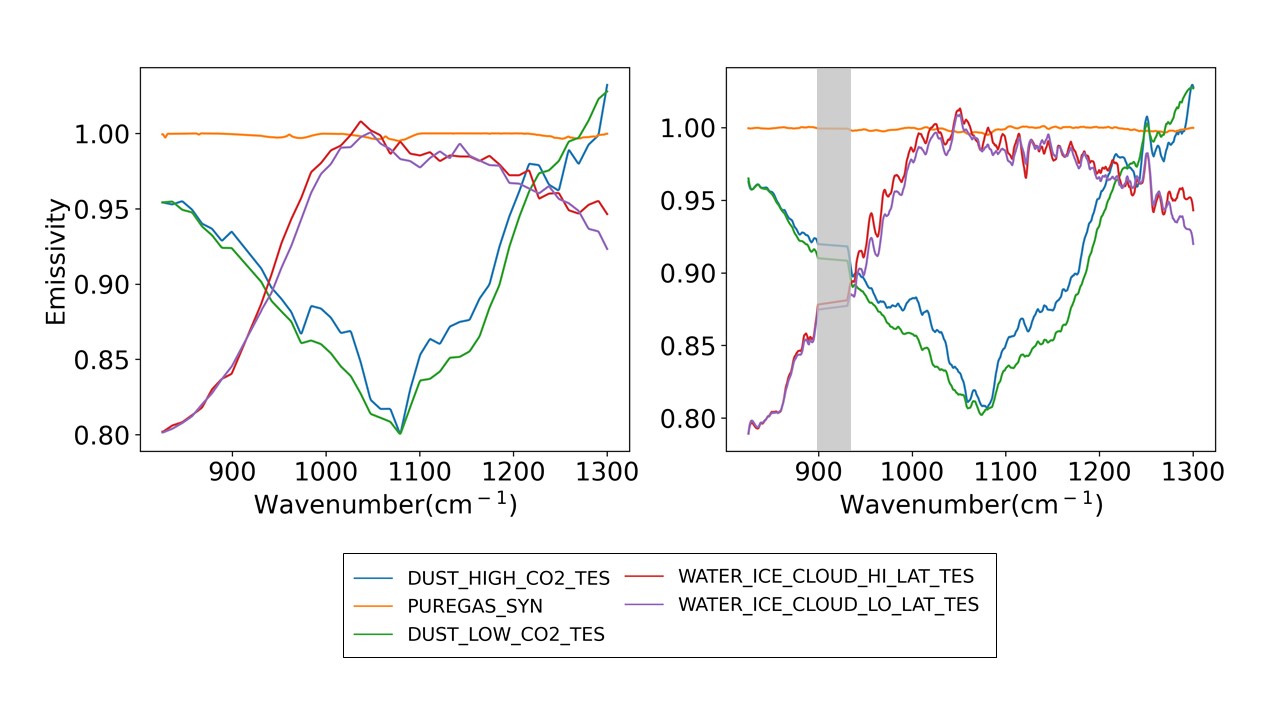
Figure 1. Comparison between the general TES/PFS extracted endmembers [2, 3] (upper panel) and the endmembers extracted from the TIRVIM data in this work (bottom panel). Grey area: wavelength cut due to high instrumental noise.
Deconvolution of the original spectra using the recovered spectral end-members allowed us to obtain the concentration coefficients of the dust and water ice end-members and retrieved abundances maps. The results obtained are promising in terms of identification and separation of the atmospheric components and have strong impact on the identification of surface contributions in the spectra. We are further investigating this point with the main goal of showing the potential of this method to extract valuable information from TIRVIM data not only on the atmosphere, but also on the surface of the Red Planet. Derived surface emissivity products are being analyzed by linear deconvolution analysis with the laboratory spectral database of Martian analogues measured at the Planetary Spectroscopy Laboratory (PSL) of DLR, in Berlin [5].
Acknowledgments
ExoMars is a space mission of ESA and Roscosmos. The ACS experiment is led by IKI, the Space Research Institute in Moscow, assisted by LATMOS in France. The science operations of ACS are funded by Roscosmos and ESA.
References
[1] Korablev et al. (2018) Space Science Review, 214:7. [2] D’Amore M. et al. (2013) Icarus, 226, 1294-1303. [3] Bandfield J.L., Christensen P.R., Smith M.D. (2000) JGR, 105 (E4), 9573-9587. [4] Smith, M.O., Adams, J.B., Johnson, P.E. (1985) JGR, 90, 797-804. [5] Alemanno G., Maturilli A., D’Amore M., Helbert J. (2021) Icarus, 368. [6] Smith M. D., Bandfield J. L. and Christensen P.R. (2000) JGR, 85 (E4), 9589-9607. [7] Maturilli, A., Helbert, J., D’Amore, M. (2009) EPSC2009, Abstract #EPSC2009-106.
How to cite: Alemanno, G., D'Amore, M., Maturilli, A., Helbert, J., Arnold, G., Korablev, O., Ignatiev, N., Grigoriev, A., Shakun, A., and Trokhimovskiy, A.: Particulate atmospheric endmembers retrieval from ExoMars Thermal Infrared (TIRVIM) spectral data, Europlanet Science Congress 2022, Granada, Spain, 18–23 Sep 2022, EPSC2022-862, https://doi.org/10.5194/epsc2022-862, 2022.
The Nadir and Occultation for Mars Discovery (NOMAD) is one of the four instruments on board the 2016 ExoMars Trace Gas Orbiter. The instrument is a suite of three spectrometers, mainly designed to study minor atmospheric species at high spectral resolution (A.C. Vandaele et al., 2015; E. Neefs et al., 2015). Nevertheless, Oliva et al. (2022) demonstrated the capability of NOMAD infrared nadir channel to investigate surface ice composition in the 2.3 – 2.6 μm wavelength range. Ice signatures have been also observed at mid/equatorial latitudes suggesting, after analysis, the first detection of CO2 ice clouds through the study of the narrow 2.35 μm absorption band.
In this work, we also use observations of the NOMAD infrared LNO channel in order to evaluate its capability to detect H2O ice clouds. We present a technique taking advantage of the 2.7 µm strong ice absorption band. For this study, we select LNO spectral orders 167, 168, 169 and combine them to derive a spectral index for H2O ice detection, namely the Frost and Clouds Index (FCI). The acquisition of data during Mars Year 34 and 35 (March 2018 to February 2021) allows us to construct seasonal maps for H2O ice clouds. The results appear in agreement with previous studies focused on Mars Express SPICAM/UV and OMEGA data analysis (Willame et al., 2017; Olsen et al., 2021). FCI is sensitive to the Polar Hood clouds, although the full structure is not detected. Moreover, detections in the Aphelion Cloud Belt (ACB) are limited. This is consistent with previous OMEGA spectrometer observations (Olsen et al, 2021) showing different physical properties between the two main Martian atmospheric structures and making the ACB less detectable in the infrared. We hence derive the LNO channel sensitivity limit for these clouds detection.
Acknowledgements
ExoMars is a space mission of the European Space Agency (ESA) and Roscosmos. The NOMAD experiment is led by the Royal Belgian Institute for Space Aeronomy (IASB-BIRA), assisted by Co-PI teams from Spain (IAA-CSIC), Italy (INAF-IAPS), and the United Kingdom (The Open University). This project acknowledges funding by the Belgian Science Policy Office (BELSPO), with the financial and contractual coordination by the ESA Prodex Office (PEA 4000103401, 4000121493), by Spanish Ministry of Science and Innovation (MCIU) and by European funds under grants PGC2018-101836-BI00 and ESP2017-87143-R (MINECO/FEDER), as well as by UK Space Agency through grants ST/V002295/1, ST/V005332/1 and ST/S00145X/1 and Italian Space Agency through grant 2018-2-HH.0. This work was supported by the Belgian Fonds de la Recherche Scientifique – FNRS under grant number 30442502 (ET_HOME). The IAA/CSIC team acknowledges financial support from the State Agency for Research of the Spanish MCIU through the ‘Center of Excellence Severo Ochoa’ award for the Instituto de Astrofísica de Andalucía (SEV-2017-0709). US investigators were supported by the National Aeronautics and Space Administration. Canadian investigators were supported by the Canadian Space Agency. SR thanks BELSPO for the FED-tWIN funding (Prf-2019-077 - RT-MOLEXO).
References
A.C. Vandaele, et al., 2015. Optical and radiometric models of the NOMAD instrument part I: the UVIS channel. Optics Express, 23(23):30028–30042.
Neefs, et al., 2015. NOMAD spectrometer on the ExoMars trace gas orbiter mission: part 1—design, manufacturing and testing of the infrared channels. Applied optics, 54(28):8494–8520.
Oliva, F., et al., 2022. Martian CO2 Ice Observation at High Spectral Resolution With ExoMars/TGO NOMAD. Journal of Geophysical Research: Planets, 127, e2021JE007083.
Willame, Y., et al., 2017. Retrieving cloud, dust and ozone abundances in the martian atmosphere using spicam/uv nadir spectra.Planetary and SpaceScience, 142:9–25.
K.S. Olsen, et al., 2021 Retrieval of the water ice column and physical properties of water-ice clouds in the martian atmosphere using the OMEGA imaging spectrometer, Icarus, Volume 353, 2021, 113229, ISSN 0019-1035.
How to cite: Ruiz Lozano, L., Karatekin, Ö., Dehant, V., Bellucci, G., Oliva, F., D'Aversa, E., Altieri, F., Carrozzo, F. G., Willame, Y., Thomas, I., Daerden, F., Ristic, B., Patel, M., López Moreno, J. J., and Vandaele, A. C.: Evaluation of the capability of ExoMars-TGO NOMAD infrared nadir channel for water ice clouds detection on Mars, Europlanet Science Congress 2022, Granada, Spain, 18–23 Sep 2022, EPSC2022-946, https://doi.org/10.5194/epsc2022-946, 2022.
TP7 | Atmospheres and Exospheres of Terrestrial Bodies
It is evident that a variety of metals are deposited in the Earth’s mesosphere and lower thermosphere (MLT, ~70-120 km) through meteoric ablation when the cosmic dust particles enter the atmosphere at high entry velocity (11-72 km/s). However, it is still unclear how much and accuarate cosmic dust enters the atmosphere of Mars (though the estimation of global dust input would be a few tons per sol) and what is the difference comparing to Earth’s atmosphere (which has a 1-2 order global input range from different estimations).
We have developed global atmospheric meteoric models of Na, Fe, K, Mg, Ni, Ca, Al, Si, P, S etc) into the Whole Atmosphere Community Climate Model (WACCM) and its vertical extensions to 600 km (WACCM-X) from US National Center for Atmospheric Research (NCAR, termed WACCM-metals), which simulate well the metal layers compared with the available lidar/rocket/satellite measurements.
New observations of some metals for the Martian atmosphere (i.e., Mg+ observations from IUVS (Imaging UV Spectrometer) and Mg+, Na+ and Fe+ from NGIMS (Neutral Gas Ion Mass Spectrometer)) instruments on NASA’s Mars Atmosphere and Volatile Evolution Mission (MAVEN) spacecraft are available from 2014. Therefore, we have incorporated the chemistry of three metals (Mg, Na and Fe) in the Laboratoire de Météorologie Dynamique (LMD) Mars global circulation model (termed as LMD-Mars-Metals), following similar work we have done for the Earth’s atmosphere. The model has been developed by combining three components: the state-of-the-art LMD-Mars model covering the whole atmosphere from the surface to the upper thermosphere (up to ~ 2 x10-8 Pa or 240 km), a description of the neutral and ion-molecule chemistry of Mg, Fe and Na in the Martian atmosphere (where the high CO2 abundance produces a rather different chemistry from the terrestrial atmosphere), and a treatment of injection of the metals into the atmosphere from the ablation of cosmic dust particles. The LMD-Mars model contains a detailed treatment of atmospheric physics, dynamics and chemistry from the lower atmosphere to the ionosphere. The model also includes molecular diffusion and considers the chemistry of the C, O, H and N families and major photochemical ion species in the upper atmosphere, as well as improved treatments of the day-to-day variability of the UV solar flux and 15 mm CO2 cooling under non-local thermodynamic equilibrium conditions.
We have incorporated the chemistries of Mg, Fe and Na into LMD-Mars because these metals have different chemistries which control the characteristic features of their ionized and neutral layers in the Martian atmosphere. The Mg chemistry adds 7 neutral and 8 ionized Mg-containing species, connected by 42 neutral and ion-molecule reactions. The corresponding Fe chemistry has 39 reactions with 14 Fe-containing species. Na chemistry adds 7 neutral and only 2 ionized Na-containing species, with 32 reactions. The injection rate of these metals as a function of latitude, solar longitude at different pressure levels is pre-calculated from the Leeds Chemical Ablation Model (CABMOD) combined with an astronomical model which predicts the dust from Jupiter Family and Long Period comets, as well as the asteroid belt, in the inner solar system. The model has been evaluated against by Mg+, Na+ and Fe+ observations from IUVS and NGIMS measurements.
The comparison of these metal layers between Earth’s and Mar’s atmospheres will be discussed, which allows us to understand the meteor astronomy, chemistry and transport processes that control the different metal layers in the upper atmosphere on different planets.
How to cite: Feng, W., Plane, J., González-Galindo, F., Marsh, D., Chipperfield, M., Carrillo-Sánchez, J. D., Janches, D., Chaufray, J.-Y., Forget, F., Millour, E., Crismani, M., Tyo, R., Schneider, N., and Benna, M.: Differential Ablation of meteoric metals in the LMD-Mars-Metals and NCAR WACCM-Metals models, Europlanet Science Congress 2022, Granada, Spain, 18–23 Sep 2022, EPSC2022-236, https://doi.org/10.5194/epsc2022-236, 2022.
The study of the atmospheric circulation in the planets and moons of our solar system and exoplanets is critical for the advances in Meteorology. In slowly rotators like Venus, Titan and tidally-locked exoplanets, the Coriolis effect is too weak to balance the pressure gradients and other metric terms (centrifugal forces) generate a different balance called “cyclostrophic”. For reasons yet not fully understood, these slowly rotating bodies tend to exhibit atmospheres which rotate much faster than the solid globe, a phenomenon called atmospheric “superrotation”. Venus constitutes the most extreme case known in our solar system, with its clouds rotating up to 60 times faster than the surface, although numerical models yet fail to accurately reproduce this superrotation, especially at the deeper atmosphere. Besides, despite the richness of information provided by the space missions that explored Venus in the past and the varied and numerous Earth-based observations, accuracy in wind measurements at present is yet insufficient to isolate and characterize the several contributors of the observed speeds of the lower clouds of Venus located within 48-60 km. As a result, the net meridional circulation, influence of the solar tides or the magnitude of transient waves and eddied are yet uncertain.
In this work we intend to provide new insights about the circulation at the deeper atmosphere of Venus obtaining wind speeds with an accuracy better than 1 m·s-1 taking advantage of the long-term coherence of the lower clouds’ patterns, which enables confidently tracking cloud tracers in images separated by more than 5 hours. These high-precision winds were obtained from sequences of images taken at 1.74, 2.26 and 2.32 µm by space missions Venus Express/VIRTIS-M (2006-2008) and Akatsuki/IR2 (2016), as well as with pairs of images acquired co-ordinately by Earth-based telescopes located at different geographical locations: IRTF/SpeX in Hawaii and HCT/IRCAM in India (May and July 2004, December 2010), IRTF/SpeX in Hawaii and NOT/NOTCam (July 2020). Our results extend those from VIRTIS-M recently published by Gorinov et al. (Atmosphere 2021, 12, 186) and confirm some of their results.
How to cite: Peralta, J., Galeote, A., Lee, Y. J., Bullock, M., Young, E., Machado, P., Espadinha, D., and Baena, R.: The circulation at the nightside lower clouds of Venus with high-precision winds, Europlanet Science Congress 2022, Granada, Spain, 18–23 Sep 2022, EPSC2022-398, https://doi.org/10.5194/epsc2022-398, 2022.
TP11 | Structural Geology and Deformational Histories of Terrestrial Bodies
Introduction: In the Martian North Polar Cap, troughs are formed and enlarged by the erosive action of katabatic winds, blowing perpendicularly with respect to steep edges of the cap. Along these valleys deeper layering of the polar deposits are often exposed making it possible to study the stratigraphy of the upper part of the polar cap [1]. We focused our attention on a 140 km long and 500 m high scarp located in the North-Western edge, facing Olympia Planum, and where part of the North Polar Layered Deposits (NPLD) are exposed. NPLD deposits are finely layered and laterally continuous sequence of light and dark strata with sporadic unconformities in between, whose periodicity has been attributed to climatic and orbital variations [2]. In the polar cap, Tanaka et al. [3] has distinguished different polar units by means of surface image interpretation, hence our scarp exposes Planum Boreum 1 unit overlapped by Planum Boreum 3 unit, both composed of variable ice/dust content, but different thickness. Putzig et al. [4] identified instead seven units inside the polar cap on the basis of the pattern of radar reflections in the radargram-based stratigraphy thanks to the data provided by SHARAD. The stratigraphic sequence of our interest correlates with the upper part of the packet-inter-packet sequence of the unit G by Putzig et al. [4]. The aim of our work is to relate the composition and stratigraphy of the visible layered deposits with the subsurface radar reflectors, using the data acquired by the NASA Mars Reconnaissance Orbiter instruments.
Data selection: We performed stratigraphic and geomorphologic interpretation on images of the Context Camera (CTX) and High Resolution Imaging Science Experiment (HiRISE); band ratios and spectral signatures on a hyperspectral cube of the Compact Reconnaissance Imaging Spectrometer for Mars (CRISM); subsurface reconstructions on radar reflectors obtained by the Shallow Radar (SHARAD). The integration of the results obtained by such a multi-score data-set underlies the possibility to join the SHARAD stratigraphy with the stratigraphic record recognisable at the surface including its compositional variability (Fig.1).
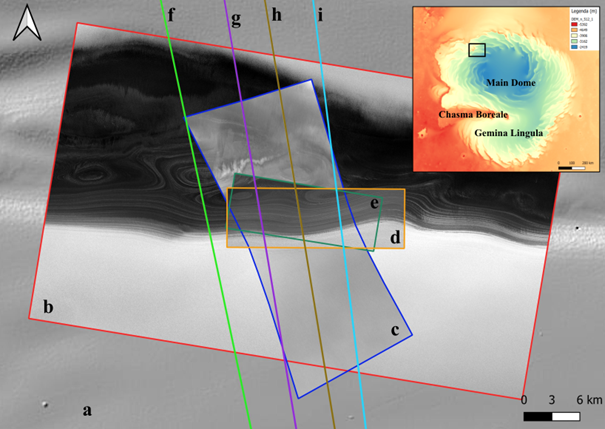
Fig.1 – Data-set: MOLA DEM (a), CTX image (b), CRISM cube (c), HiRISE images (d, e) and SHARAD radargram tracks (f, g, h, i). Black rectangle in the North Polar Cap region shows the study area.
Spectral analysis: Spectra for five Regions of Interest (ROIs) of about 50 pixels were acquired and are shown in Fig.2a-b.
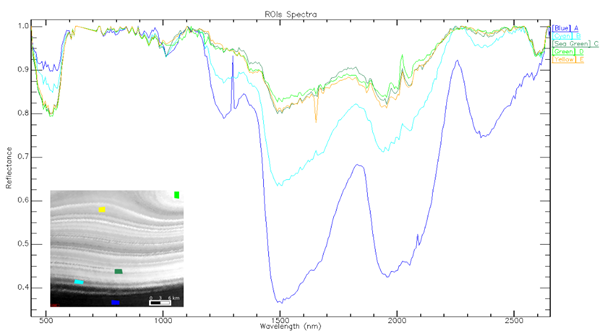
Fig.2 – (a) Regions of Interest over CRISM image detail; (b) Plot of five ROI average spectra: each colour line represents a ROI spectrum (continuum is removed).
The exposed stratigraphy is composed of different amount of dry ice, water ice and basaltic dust [3]. Spectra A and B are well distinguishable, whereas the signatures of C, D and E appear similar, indicating comparable compositions. Spectrum A exhibits well developed water-ice absorption bands (1.5 and 1.95 µm), less development of same peaks might imply an increase of dry ice content. The 1 µm peak (water ice) is well visible in both A and B spectra, but less evident in C, D and E. Multiple absorptions at 1.65 and 2.06 µm, associated to CO2, are well visible in C, D and E. Other absorption bands (at 0.50, 1.02 and 2.30 µm for example) can be related to femic and aqueous alteration minerals. Spectrum A is similar to the signature of pure water ice, with less altered minerals, while C, D and E appear to be characterized by dry ice and femic minerals. Spectrum B appear to be transitional between these two end-members.
Spectral indexes: Spectral indexes were produced using CRISM Analysis Toolkit (CAT) [5]. Indexes allowed us to create false colour images to highlight the presence/absence of specific minerals. Example of these are shown in Fig. 3 (see FED for the index definition).
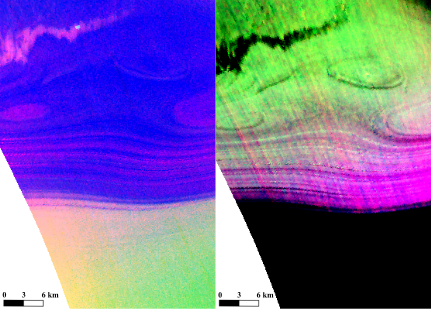
Fig.3 – Two false colour images created with spectral indexes (a) BDI1000VIS_BD15002_BD1435 representing ice compositions and (b) OLINDEX3_LCPINEX2_RBR to highlight mineral composition.
Mapping and correlation to radar reflectors: Geological units were identified on CRISM and CTX data on the basis of morphology, composition, albedo and their stratigraphic relationship. Fig.4 displays the mapped units.
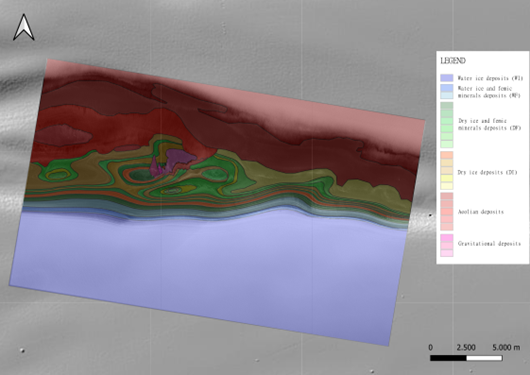
Fig.4 – Geological map and relative units. WI-units: water-ice-rich deposits (blue), WF-unit: water ice and femic minerals deposits (light blue); DF-units: dry ice and femic minerals deposits (green); DI-units: dry-ice-rich deposits (yellow); Aeolian deposits (red); Gravitational deposits (purple).
Fig.5 shows the geological units correlated with radargrams features. Variations of dielectric constant among strata are due firstly to presence of water ice in the surficial layers and dry ice in deeper ones, secondly to different amount of dust in radar units. These affect the signal reflectance: stronger if it is from water-ice layers. Additionally, high content of dust significantly decrease the radar signal, so units appear darker [4] [6]. The lines in Fig.5 represent lower contact of the geological units.
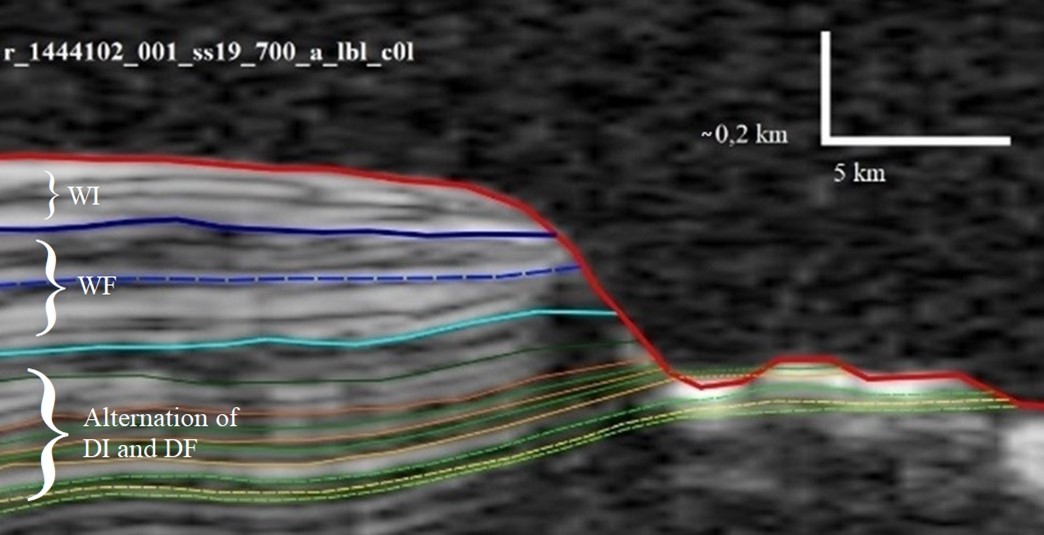
Fig.5 – Correlation between geological units and radar reflectors. The colours of units are the same of geological map (vertical axis in time). Section track is shown in Fig.1.
Discussion and conclusions: We provide a detailed compositional and geometrical characterization (using CRISM, HiRISE, CTX) of outcropping layered deposits of the North Polar Cap, to evaluate the potential for performing sound stratigraphic correlations with the subsurface reflectors identified in SHARAD radargrams. At a scale of single layers, compositional variations of basaltic dust content in the stratigraphic sequence were identified. This variability is visible especially in dry-ice-rich layers. Basaltic dust showed aqueous alteration, especially in water-ice-rich strata.
Acknowledgments: We acknowledge support from the EU’s H2020 research and innovation program under grant agreement N° 871149 (GMAP).
References: [1] Masse, M. et al. (2012) Earth and Planetary Science Letters, 317, doi: 10.1016/j.epsl.2011.11.035; [2] Byrne, S. (2009) Annual Review of Earth and Planetary Science, 37, doi: 10.1146/annurev.earth.031208.100101; [3] Tanaka, K. et al. (2008) Icarus, 196(2), doi: 10.1016/j.icarus.2008.01.021; [4] Putzig, N. et al. (2009), Icarus, 204(2), doi: 10.1016/j.icarus.2009.07.034; [5] Viviano-Beck, C. et al (2014), Journal of Geophysical Research, 119(6), doi: 10.1002/2014JE004627; [6] Lauro, S. et al. (2012), Icarus, 219(1), doi: 10.1016/j.icarus.2012.03.011.
How to cite: Costa, N., Massironi, M., Penasa, L., Nava, J., Pozzobon, R., and Ferrari, S.: Compositional and subsurface analysis of an outcrop close to Olympia Planum on Mars, Europlanet Science Congress 2022, Granada, Spain, 18–23 Sep 2022, EPSC2022-167, https://doi.org/10.5194/epsc2022-167, 2022.
The ExoMars rover mission will be looking for biosignatures (i.e. signs of past and present life) in Oxia Planum, Mars [1]. The landing site is located between 16° and 19° N and 334° to 337° E where the ancient cratered terrains transition into the low-lying plains of Chryse Planitia. The area of interest is situated between Ares Vallis and Marwth Vallis in a wide basin at the outlet of Cogoon Vallis. The fractures, extensively spread over the terrains of the landing site, range from meters to decameters in spacing and length and have been preliminary interpreted as desiccation cracks or the result of burial and unloading of sediments [2,3]. We mapped these fractured terrains and we tested an automatic method for alignment tracing which contributes to our study in an effort to evaluate the directional aspects of fracturing and their spatial distribution within the study area.
The data we used come from VNIR pushbroom imager camera HiRISE, which produces the highest resolution images of the martian surface (25 to 60 cm/pixel) [4]. 31 greyscale HiRISE RED products (25 cm/pixels) and three HiRISE colour product (60 cm/pixel) covering the landing ellipse were selected and downloaded from the Planetary Data System (PDS) [5], and imported into QGIS (version 3.24.1 Tisler) [6]. To map these fractures over a submeter resolution basemap within the ≥1000 km2 landing ellipse area, we opted to use a 1:5000 scale. We mapped the boundaries of the fractured area as lines, generating category areas from the boundaries of the mapped area through the Mappy QGIS plugin [7]. We classified the fractures by their association with sand, dunes, TARs and ridges. Using the resulting map of the fractured terrains, we placed a 200 m2 Scan Area on a place where fracturing was more evident: we extracted HiRISE data that was input into the Slope Intersect Discrete Analysis (SID) software version 3.04-10 for automatic tracing of the fractures. The results of automatic tracing, whose algorithm is based on a modified Hugh transform [8], was further processed in to GRASS GIS [9]: the GRASS Toolset v.clean was used to snap vertices of SID output. To compare the manual and automatic methods, the Scan Area input by SID has been used to manually trace fractures at 1:1000 scale, whose orientation in the space was obtained using Daisy software version 3-5.51-3. The map of the fractured terrains was then used to place multiple Scan Areas where fracturing is more evident (Fig.2). The automatic fracture tracing method will be applied on other areas of interest in future studies.
We classified fractured terrains into three categories where we placed 28 Scan Areas (Fig.1) : we placed nine of them in terrains characterized mainly by fractures (MF, lower portion of the map), 10 in terrains associated with the presence of linear topographic rises (ridges) (RF, central portion of the map) and nine in fractured terrains with an abundance of sand and dunes (SF, upper portion of the map). 507 fractures were traced manually ranging 1.14-68.4 m in length (Fig.2, b). In the automatic method, SID mapped 1712 elements between 2 and 21 m in length (Fig.2, a). Regarding the directional Azimuth-Frequency analysis carried out by Daisy, the average orientation is very similar: fractures traced manually indicate a value of 92.26° (sd: 12.5°) and fractures traced via SID correspond to a value of 93.06° (sd: 15.97°) (Fig.2, a, b below).
The spatial distribution of fractures traced manually is homogeneous, including both the longest and the shortest fractures. The few areas where the absence of fractures is observed are those where there is a strong cover of sand. The longer fractures do not create intersections, if not with the shorter ones, which cross each other, forming small networks. The homogeneous distribution of manually traced fractures is the same as those traced unsupervised via SID. The differences instead occur mainly in the number and in the length of lines traced in the two methods: SID’s sensitivity to low variations of DN result in a greater number of identified fractures through segments with a defined minimum and maximum length. However, not all manually traced fractures have been identified by SID. No matter how efficient the GRASS GIS toolset is, fractures traced by SID too far apart from eachother were not considered a single element, which the human interpretation would have done. As far as orientation is concerned, the two methods show very similar values.
This study shows how, although the clear differences between manually and automatic method, the latter may prove to be efficient, even considering their limitations. SID’s fracture tracing in fact guarantees a strong effectiveness for the calculation of their orientations. Further analysis in the Scan Areas placed on the fractured terrains of the landing ellipse will verify whether or not there are anisotropies in the orientation of the fractures, which will help improve our knowledge about the formation and evolution of Oxia Planum.
References
[1] Vago et al.(2017), Astrobiology, Vol. 17, No. 6-7. [2] Quantin-Nataf et al. (2021) Astrobiology 21, 345. [3] Bowen et al. (2022) Planetary and Space Science Volume 2014. [4] McEwen et al. (2007) Journal of Geophysical Research: Planets Volume 112, [5] McMahon (1995) Planetary and Space Science Volume 44 [6] Casagrande et al., (2014) Dario Flaccovio Editore p. 220 [7] Penasa et al. (2020) European Planetary Science Congress, Volume 14 [8] Hough (1959) HEACC, Proceedings of the 2nd International Conference on High-Energy Accelerators and Instrumentation [9] Neteler and Mitasova (2013) The Springer International Series in Engineering and Computer Science
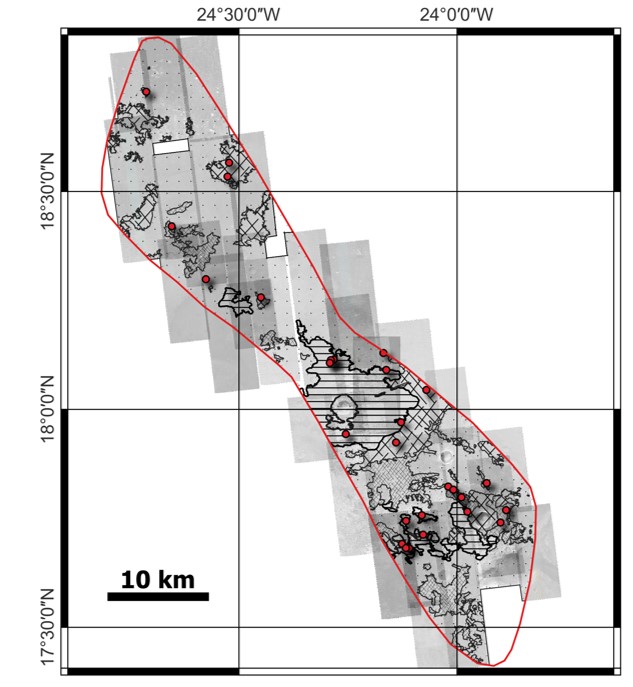
Figure 1 – Fractured terrains mapping and Scan Area locations within the ExoMars landing ellipse. Geospatial data is in simple cylindrical projection, considering Mars Sphere (IAU2018:49910).
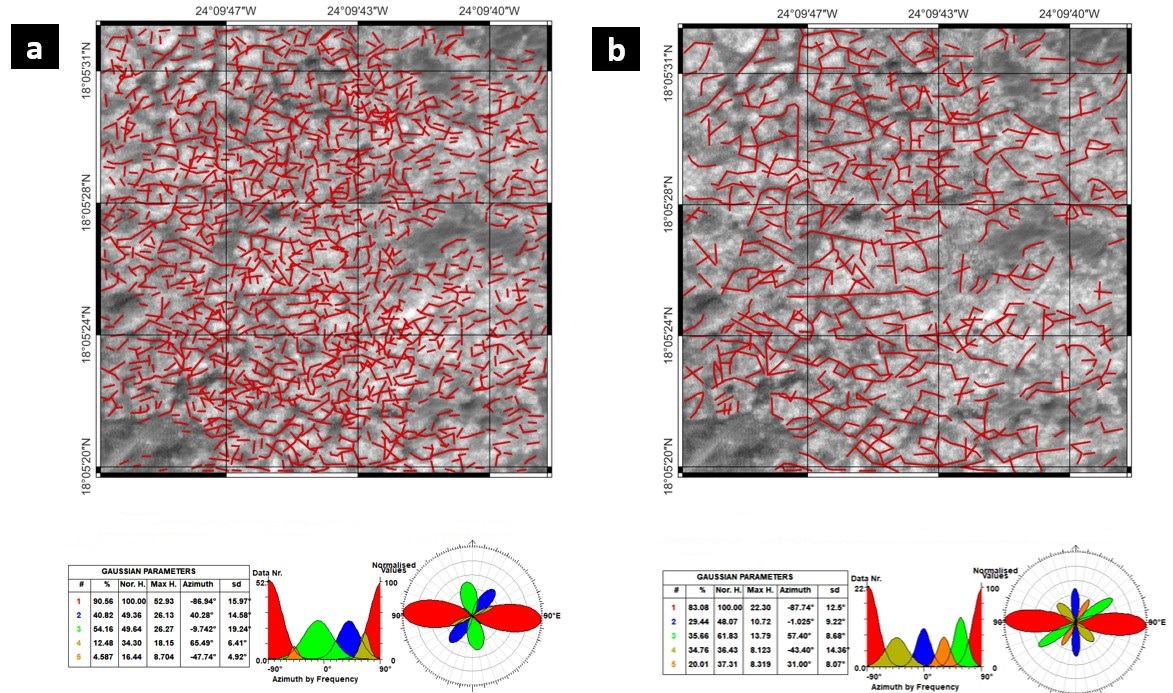
Figure 2 - Comparison between automatic (a) and manual tracing (b). The tables show results of the directional analysis effectuated by Daisy.
How to cite: Apuzzo, A., Frigeri, A., Salvini, F., Brossier, J., De Sanctis, M. C., Costa, N., and Schmidt, G. W.: Automatic Fracture Tracing by Image Processing on Oxia Planum, Mars, Europlanet Science Congress 2022, Granada, Spain, 18–23 Sep 2022, EPSC2022-350, https://doi.org/10.5194/epsc2022-350, 2022.
INTRODUCTION
In recent years, the Martian world has drawn the attention of researchers all over the globe. Mars’ rich geological record and fascinating history led scientists and space organisations to be keen on studying the planet more closely. Several studies on Mars are primarily focused on determining the potential for life. (Nazari-Sharabian et al., 2020). The similarities between Mars and early Earth are a big part of why people want to study it. Little has changed on Mars since the Hesperian epoch, 2.9 billion years ago, due to the lack of plate tectonics (Victoria et al., 2018). As a result, unlike Earth, it is possible to look at Mars as a blank canvas due to no artificial structural advancements. The discovery of geological features that resemble small valleys and river plains (Rice et al., 2008) has only raised the possibilities of finding water on Mars in some form. Many dramatic events occurred on Mars' glacial past, leading to the construction of valleys, river plains, glacial landforms, and other features. We have recently learned a lot more about such features.
Mars’ extreme glacial history led to significant changes and the formation of interesting features such as glacial-like landforms on the planet. Changes in the orbital and rotational parameters have allowed ice from ice-rich polar regions to shift towards the equator (Mischna et al., 2003). This process is termed mid-latitude glaciation (Hepburn et al., 2020; Milliken et al., 2003). Furthermore, these formations have flow-like geomorphology as shown in figure 1, indicating the presence of ice underneath these landforms (Holt et al., 2008; Souness et al., 2012). Examining the depths of these GLFs may yield information on the events that have manifested in significant geographical and climatic changes.
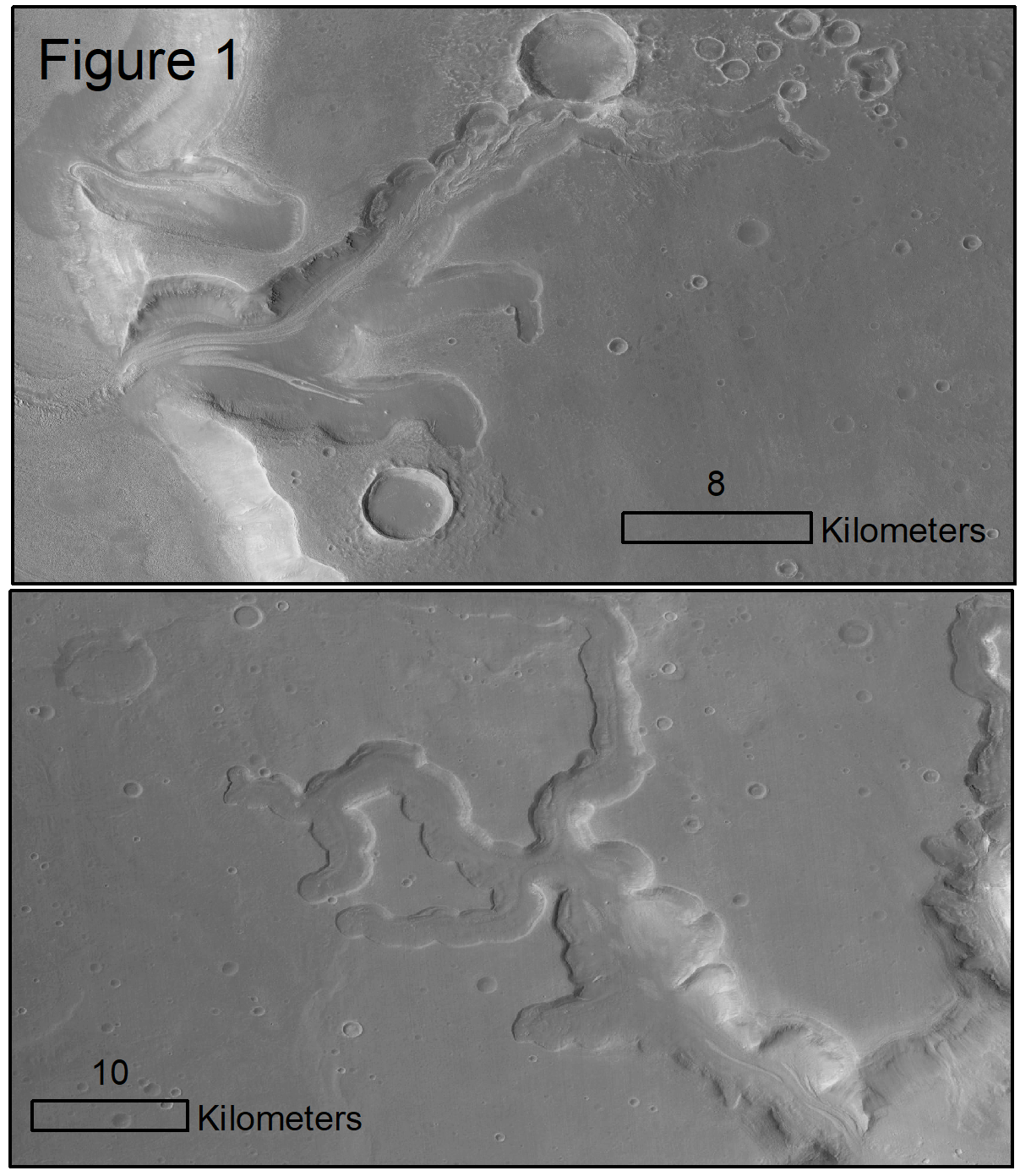
1.1 Research Gaps and Objective
There are studies that focus on the GLFs and their formation over the years (Degenhardt and Giardino, 2003; Holt et al., 2008; Karlsson et al., 2015; Souness et al., 2012). Attempts to date these viscous flow features by studying their composition (Hepburn et al., 2020) have resulted in some progress in understanding Mars' glacial past through these landforms. However, there is still a lack of knowledge of the depths of the GLFs. The reasons for the absence or presence of any buried deposits beneath these landforms are largely uncertain. Although there have been papers targeting these landforms and layers underneath them, there is a requirement to evaluate their complete potential through the extension of radar datasets. Because the undersurface deposits on Mars are mostly dust and dirt (Dundas et al., 2018), detecting them with optical images is difficult. Therefore, this study attempts to examine the depths of glacier-like forms in the mid-latitudes of Mars using SHARAD radargrams.
1.2 Data
The Shallow Subsurface radar instrument on Nasa's Mars reconnaissance orbiter produces very long wavelength radar imagery and can be utilized to detect subsurface layers on Mars. Unlike Earth, ice on the mid-latitudes of Mars sublimates when on the surface and can be found underneath the surface (subsurface). Therefore, to confirm or reject the presence of subsurface deposits on Mars, SHARAD's pulses are used for better penetration of signals into the target landforms. SHARAD’s radar pulses can reach up to 1000-1500 m depth and operate between 15-25 MHz frequencies. The data obtained by the instrument are in the form of radargrams which can be used for geospatial analysis. As shown in figure 2, the radargrams represent power returned at several time delays (Y-axis) along the track of the distance traveled by spacecraft (X-axis) (Bramson and Petersen, 2020). There is an increase in the power (at the time delay) returned from the radar if contrast is realized in the material properties. A material's response can be expressed by dielectric constant or permittivity and is related to the material's refractive index.
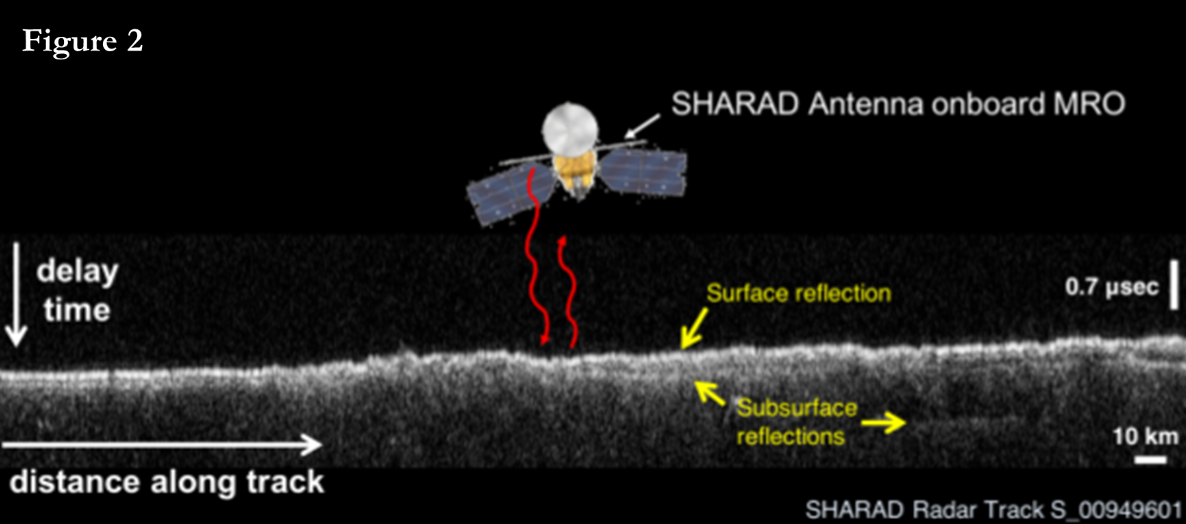
1.3 Methodology
1.3.1 Target glacial-like forms
Most small-scale lobate debris aprons, i.e., features that stretch for less than 5 km, are present in the Northern Lowlands (Hepburn et al., 2020) as shown in figure 3. The selection of a few interesting GLFs is made based on the evidence of hydrous minerals in the area. In the study (Pan and Ehlmann, 2018), Deuteronilus Mensae is closely studied for phyllosilicates and hydrated silica using CRISM images. In this study, the target landforms are selected based on the locations of these hydrous minerals shown in Pan and Ehlmann’s research.
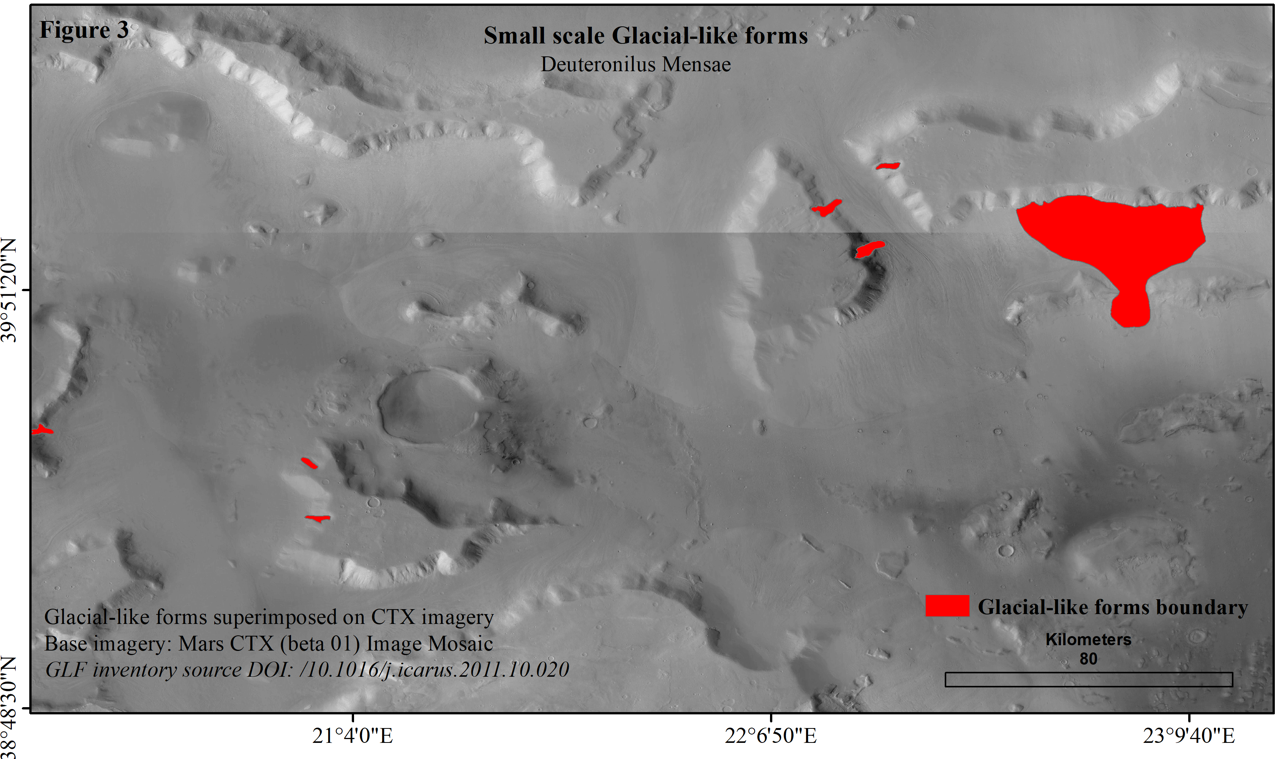
1.3.2 Processing Radargrams
Off-nadir reflections: The performance of the radar sounder is determined by several factors, including surface and subsurface reflectance, receiver noise level, and topography. At longer delays, topographic features away from the nadir track will add undesired noise or "clutter" power (Seu et al., 2007). Therefore, topographical changes can induce different levels of clutter echoes. Bright reflections from off-nadir surface topography cause radar clutter, resulting in late returns that could be misinterpreted for subsurface returns (Bramson et al., 2015). Hence, we compare our radargrams to their respective clutter simulations produced using Mars Orbiter Laser Altimeter.
1.4 Results
In figure 4 original radargram covering a GLF rich in Fe/Mg phyllosilicates in the Deuteronilus Mensae region is shown along with the Themis mosaic indicating the cross-section profile of the radargram. The radargram is compared to a clutter simulation generated using the Colorado SHARAD Processing System. The subsurface reflections can be recognized with the use of clutter simulations. Specific subsurface interfaces are visible in the radargrams directly under the GLFs which are absent in the simulations. This indicates the presence of subsurface deposits under the phyllosilicate-rich GLF.
However, utilizing SHARAD radargrams to look under small-scaled GLFs has inherent difficulties, and due to resolution restrictions, it is difficult to look closely at the radargrams. Deuteronilus Mensae has a complex terrain; hence, in some instances, subsurface reflectors are very similar to the surface reflector caused due to the instrument’s sidelobes (Bramson et al., 2015). Therefore, the radargrams need to be very carefully compared with the simulations to grasp better what can be called a subsurface deposit under the target landforms.
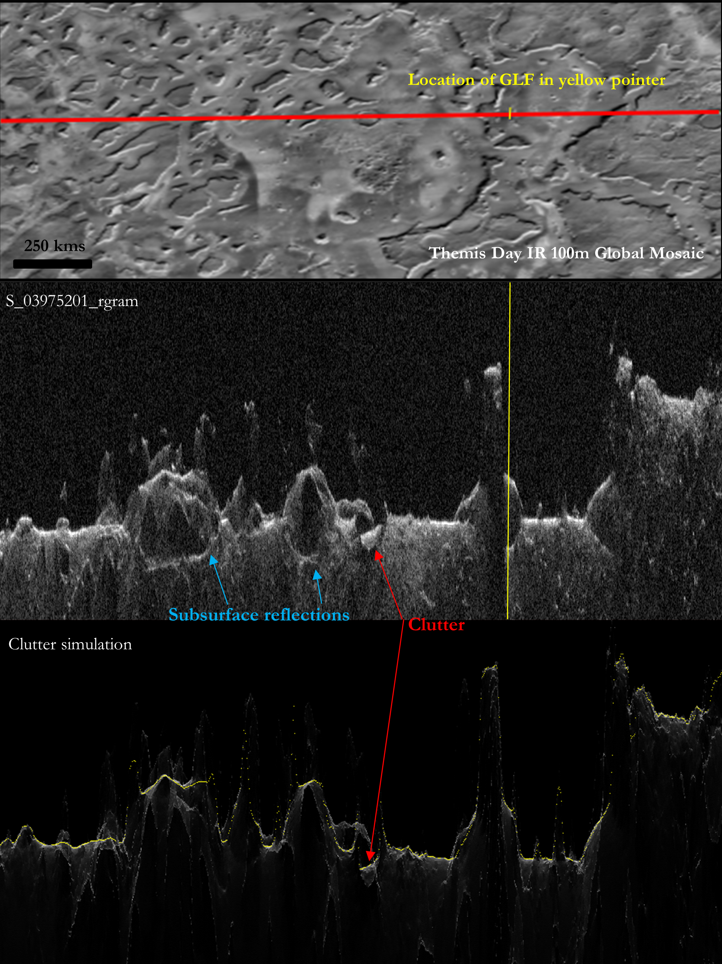
How to cite: Kacholia, D., Bakker, W. H., and Aghababaei, H.: Subsurface layer investigation of the glacial-like forms using SHARAD data, Europlanet Science Congress 2022, Granada, Spain, 18–23 Sep 2022, EPSC2022-382, https://doi.org/10.5194/epsc2022-382, 2022.
Introduction: The Moon exhibits globally dispersed tectonic landforms due to thermal contraction, solid-body tides, and loading of the crust. Wrinkle ridges and lobate scarps are both formed as a result of compressional stresses, however, their appearance and formation mechanisms are different [1-5]. Wrinkle ridges are interpreted as blind thrust faults, where horizontal shortening is accommodated by a fault that does not reach the surface. These faults are suggested to extend to depths between 100’s of meters to several kilometers [6-8]. It is thought that wrinkle ridges formed 0.1-0.65 Ga after basalt emplacement as a result of basin subsidence [6-11]. Lobate scarps on the other hand are among some of the youngest landforms on the Moon, with derived model ages < 700 Ma [12-16]. The faults that created the scarps are thought to offset the upper kilometer of the crust and are predominately in the highlands [15-16]. While wrinkle ridges and lobate scarps are typically not co-located, global mapping revealed at least nine cases where wrinkle ridges transition to lobate scarps at a mare-highland boundary [5,16-18]. These transitions are of interest as they are complex examples of recent tectonism [18-20].
The ridge-scarp transition in eastern Mare Serenitatis (21.7°N, 28.9°E) ruptures the surface at a contact between mare basalts and dark mantle deposits, approximately 70 km NW of the Apollo 17 landing site. The ridge is part of the southern section of the Dorsa Aldrovandi ridge system. Derived model ages for the mare units range from ~3 – 3.8 Ga [21], while the ridge-scarp transition has been active in the last 100 Ma [18]. Detailed mapping around both the ridges and scarp revealed a large network of small-scale graben. To better understand the relationship between the small extensional features and the compressional landforms, a geomorphologic map was produced as a first order investigation.
Data and Methods: We used NAC (Narrow Angle Camera; 1 m/pixel) image data from the Lunar Reconnaissance Orbiter Camera (LROC) with incidence angles of 60-75° for detailed geomorphological mapping [22]. The geomorphologic units and landforms were mapped on the basis of their morphology and albedo (Fig. 1). Wrinkle ridges, lobate scarps and small-scale graben are the mapped tectonic landforms as well as two volcanic units: dark mantle pyroclastic deposits and mare deposits. Impact craters were not included into the map.
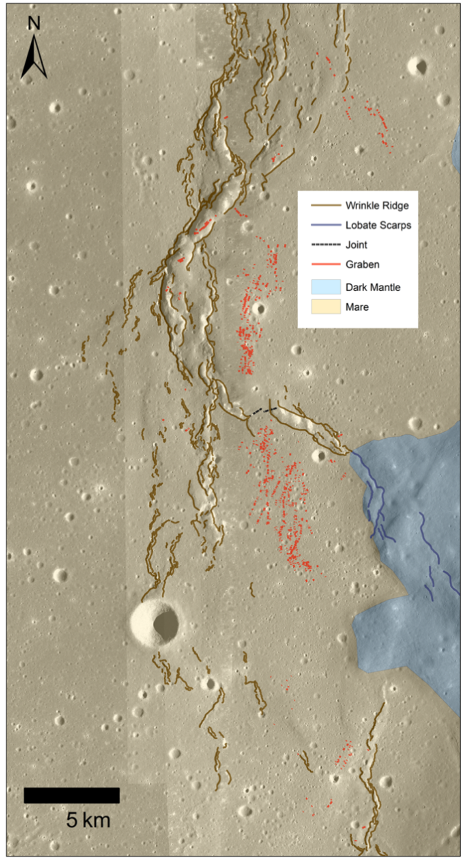
Figure 1: Geomorphologic map of the wrinkle ridge-lobate scarp transition (white arrows) in eastern Mare Serenitatis (21.7°N, 28.9°E) on NAC image data. Brown lines are wrinkle ridge compound scarps, lobate scarps are mapped with blue lines, and small-scale graben are shown with red lines, dashed black lines are joints. Tan color represents the mare, while the light blue areas are dark mantle deposit
Geologic Interpretations (Fig 1.): The wrinkle ridges exhibit typical sinuous and braided morphology [10]. Many ridge sections are discontinuous with some segments as short as 1-2 km in length. The summits of the wider ridge segments occasionally host small-graben that are oriented along strike. Where the ridge crosses the mare-pyroclastic boundary the fault transforms into lobate scarp morphology, likely due to differences in substrate strength and or fault structure. Here, the scarps are simple, curvilinear landforms. The small graben (Fig. 2) are contained within the mare and are mostly tens of meters in length. Graben widths are only a few meters wide and either exhibit typical flat-floors bounded by an escarpment on both sides or v-shaped troughs with irregular edges.
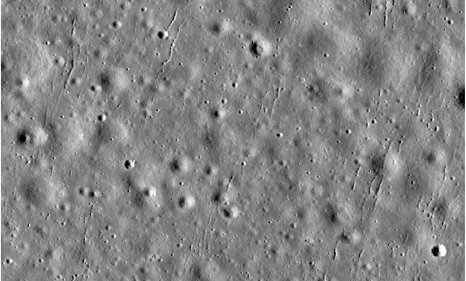
Figure 2: Small-scale graben (21.7º, 28.7º) just south of the ridge section of the transition are approximately perpendicular to the fault.
A smaller ridge, which we tentatively mapped as a joint, traverses the gap (relay ramp) between two segments of the main wrinkle ridge complex and is perpendicular to the main wrinkle complex.
Discussion: Located around the compressional landforms are small-scale graben (Fig. 2). These graben are often found in other locations across the Moon and have been suggested to be the result of localized flexural bending or dilation from recent fault movement at compressional landforms, and are typically found in clusters of ≤20 [23, 24]. However, the graben here occur as a relatively large network (n=991) that spans over ~25 km and they likely formed as a secondary effect (extension) of recent tectonism in the ridges and scarps. These graben have a strong SSW-NNE orientation, which is roughly perpendicular to the section of the wrinkle ridge that transitions into a lobate scarp and parallel to the main Dorsa Aldrovandi ridge. Graben are also observed on the crests of the wrinkle ridges due to extension on the ridge and lateral extrusion of wedge material.
Conclusion: In addition to the late-Copernican ages determined for the wrinkle ridge-lobate scarp transition, the discovery of small-scale graben additionally suggests recent tectonism at the compressional landforms. This supports the hypothesis of a tectonically active Moon [5, 13, 19, 20, 24] that produces not just compressive, but also extensional landforms.
References: [1] Watters & Schultz (2010) Planetary Tectonics, Cambridge Univ. Press. [2] Schultz (1976) Moon Morphology, University of Texas Press. [3] Binder (1982) Earth, Moon, and Planets, 26. [4] Watters and Johnson (2010) Planetary Tectonics, Cambridge Univ. Press. [5] Watters et al. (2010) Science, 329. [6] Schultz (2000) JGR, 105, E5. [7] Solomon and Head (1979) JGR, 84. [8] Watters (1993) JGR-Planets, 98. [9] Solomon and Head (1980) Rev. Geophys. Space Phys., 18. [10] Plescia and Golombek (1986) GSA Bull., 97. [11] Yue et al. (2017) LPSC, #1926. [12] Binder and Gunga (1985) Icarus 63. [13] van der Bogert et al. (2018) Icarus 306. [14] Clark et al. (2015) LPSC, #1730. [15] Clark et al. (2016) LPSC, #1380. [16] Watters et al. (2015) Geology 43, 10. [17] Thompson et al. (2017) LPSC, #2665. [18] Clark et al (2019) LPSC, #2084 [19] Clark et al. (2017) LPSC, #1001. [20] Williams et al (2019) Icarus 326. [21] Hiesinger et al. (2000) JGR, 105. [22] Robinson et al. (2010) Space Sci. Rev. 150. [23] Watters et al (2012) Nature Geo. Sci. 5. [24] French et al (2015) Icarus 252.
How to cite: Clark, J. D., Bernhardt, H., and Robinson, M. S.: Extensional Features at East Serenitatis Wrinkle Ridge-Lobate Scarp Transition Indicate Recent Tectonic Activity, Europlanet Science Congress 2022, Granada, Spain, 18–23 Sep 2022, EPSC2022-757, https://doi.org/10.5194/epsc2022-757, 2022.
The increasing availability of radar sub-surface/surface imaging of the terrestrial planets allowed to highlight the structural architecture of buried geological structures. The reconstruction of the 3D subsurface geometries, besides supporting the classic geologic mapping of planetary surfaces, allows to constrain models to unravel the 4D evolution of a region. This is of utmost importance in key regions where trapped subsurface fluids and their (possible) migration to the surface might impact local/global climate conditions , atmospheric composition, as well as the presence of water close to the maritan surface.
Shallow Subsurface Radar (SHARAD) data [1] revealed that the Martian caps are composed primarily of water ice that was deposited in layers that contain varying amount of dust. They are referred to as martian Polar Layered Deposits (PLD). The internal stratigraphy of these deposits strongly resemble the internal layering in key sites of the East Antarctic Ice Sheet, where the ice tectonics (e.g. ice faulting) and dynamics, revealed to be the causes of the observed architecture.
Mechanisms responsible for the formation and evolution of the martian PLD are still under debate and exogenous processes are considered among the best candidates [2]. Steep troughs dissecting the polar ice caps with spiral shapes provide an optimal view of the layered internal structures. Ice reflectors interpretations suggested a migration of these troughs accompanied by katabatic winds that produce erosion/sublimation at the exposed layers and accumulation/deposition at the opposite slopes [2]. Nevertheless, the SHARAD profiles crosscutting these canyons revealed the lateral change in thickness of ice layers, with thickening as they approach the canyon structures (Fig.1). It is well known from the terrestrial analogues/structures that such geometry may well result from the activity of normal faults with sintectonic sedimentation (ice and dust deposition in the martian case).
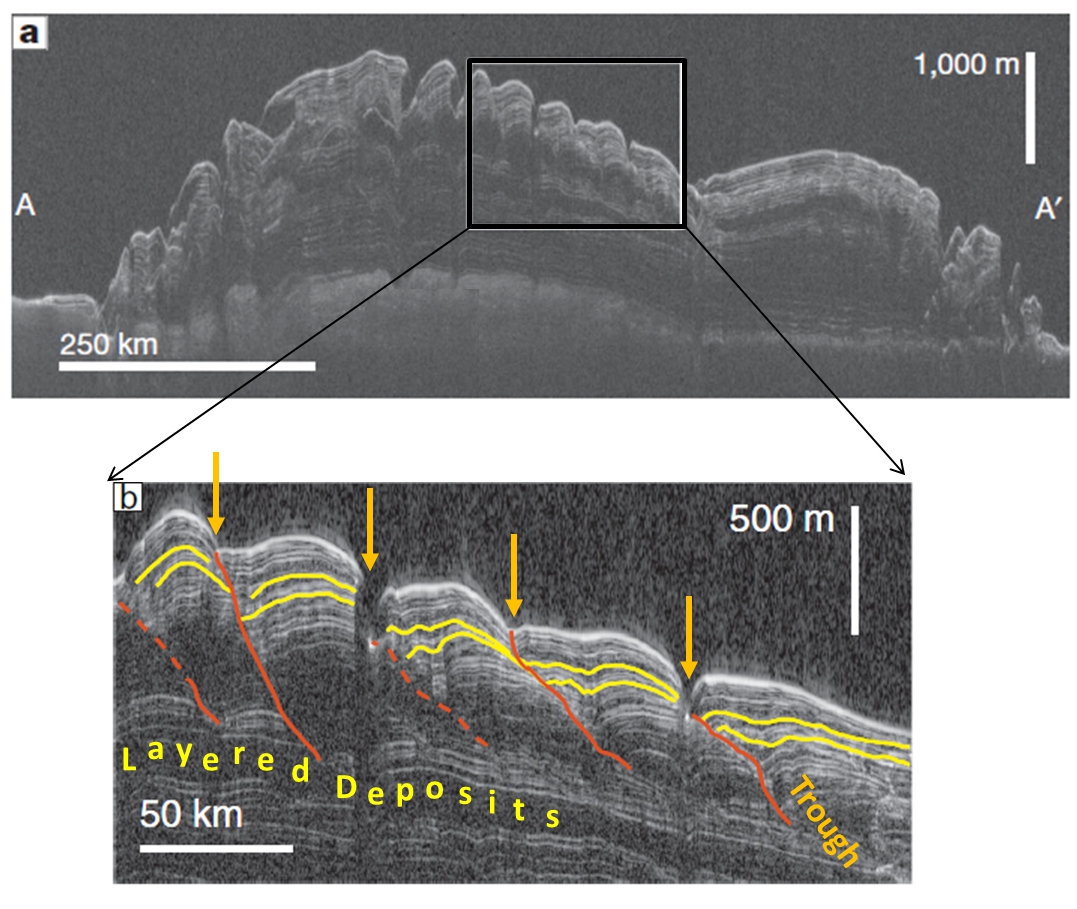
Figure 1. Sharad Image showing examples of the stratigraphic architecture of the North Polar Layered Deposits and spiral through dissecting the ice cap.
In this work we present the results the forward numerical modeling by HCA technique [3] of the PLD structure evolution.. The layered ice is simulated by a mesh of cells whose links replicate the physical and rheological characteristics of the material as well as the presence of ruptures such as faults. The observed ice stratigraphy of the PLD, the lateral thickness variations, and their vertical offset are successfully simulated through the activity of shear discontinuities with a series of listric shapes and normal displacements (Fig.2).
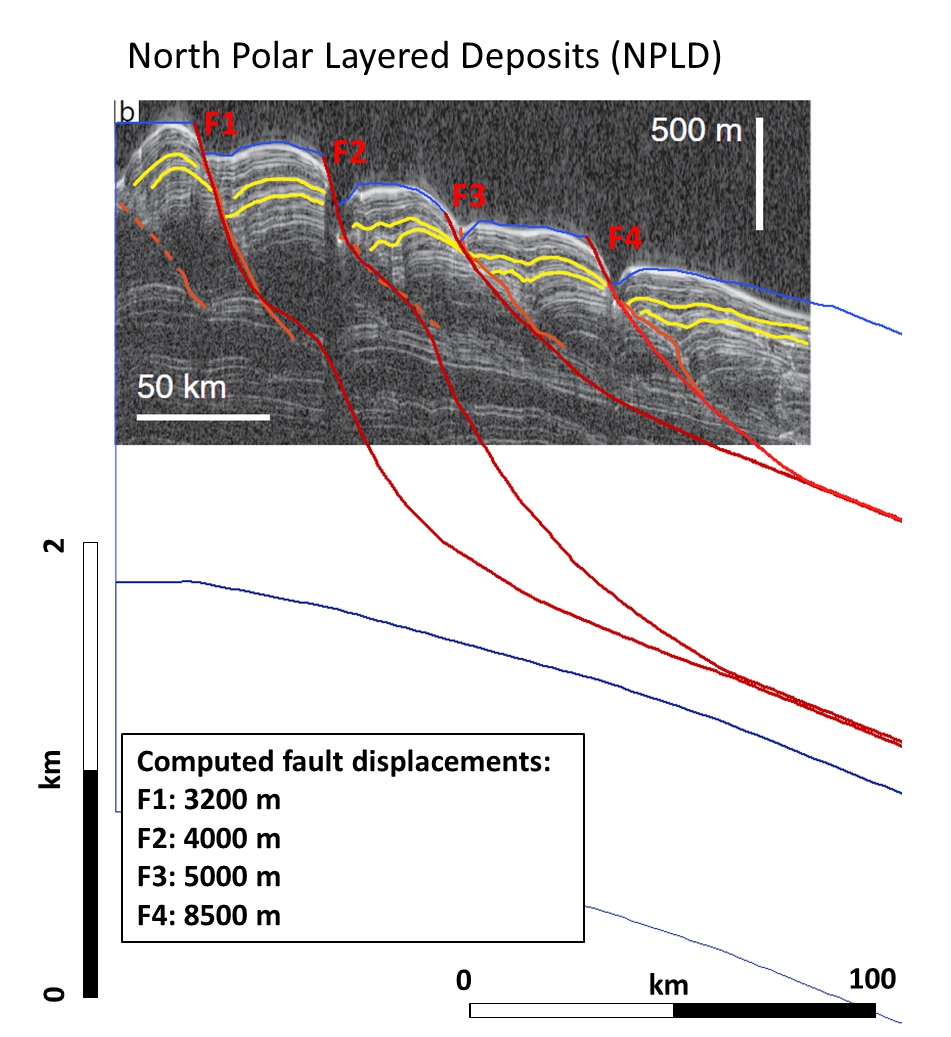
Figure 2. HCA numerical model of the ice layered deposits from Mars north polar region. Subset of SHARAD radargram 1294501 [3]
The HCA kinematic modeling thus revealed the existence faults with size of the order of hundreds of km within the Martian ice caps. Faults with similar size and displacement of the order of several kms are associated with well developed and extended fault core and damaged zones, characterized by strong variation in permeability due to secondary fracturing. In this way the martian ice cap faults produce corridors of brittle deformation that dissect the entire ice cap, provide conduits for fluid migration, and enhance the development of the observed troughs.
The width of the fault damaged zones is of the order of the hundreds of meters and the presence of the fault core, the attitude of fault-related fractures (synthetic fractures, antithetic fractures, extensional fractures, pressure solutions seams) and their spatial distribution and frequency in the ice volume affected by the damage zone of the shear discontinuities has been quantified by the analytical-numerical modeling performed with FRAP software using the found fault geometry [4]. This model takes into account the kinematic conditions of the modeled fault, the physical properties of the ice material and environmental parameters (e.g. acting stresses, gravity, fluid pressure …) which influence the computation of the secondary permeability (Fig 3).
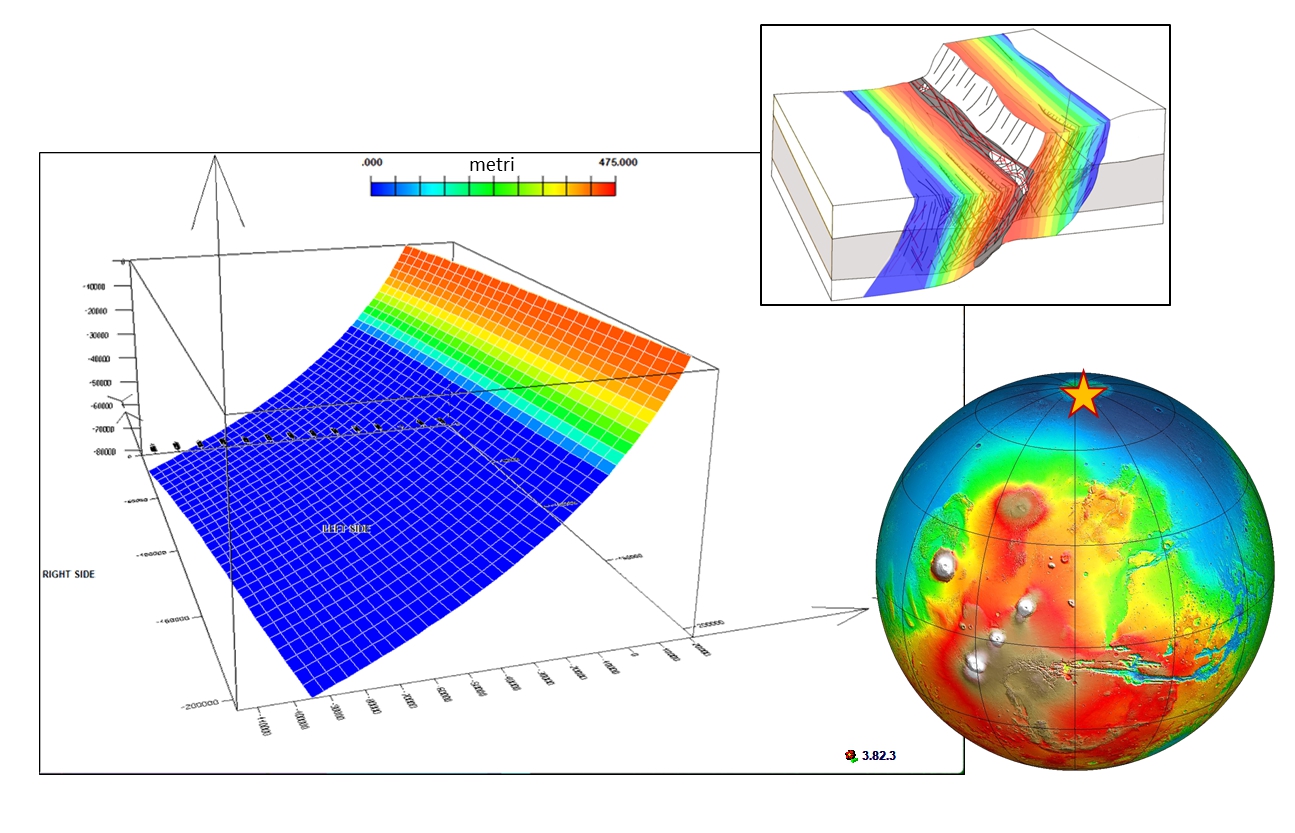
Figure 3. Schematic 3D sketch showing the ice volume affected by fault-related fractures and the development of secondary permeability in the fault damage zone (example of FRAP output).
Results of this study represent a contribute to better understand the hitherto underestimated ice tectonic setting of the Martian ice caps. Highlighting the hydraulic properties of these faults is pivotal to understand the enhanced pathway of fluid that are trapped both within the ice layers and at the base of the ice caps. Fluids and biological material can thus approach the surface and the atmosphere and may be easily detectable/sampled to improve the success of future onland missions.
References
[1] Seu, R., Biccari, D., Orosei, R., Lorenzoni, L. V., Phillips, R. J., Marinangeli, L., ... & Zampolini, E. (2004). SHARAD: The MRO 2005 shallow radar. Planetary and Space Science, 52(1-3), 157-166.
[2] Smith, Holt, Spiga, Howard, Parker (2013). The spiral troughs of Mars as cyclic steps. Journal Of Geophysical Research: Planets, 118, 1835–1857.
[3] Salvini F. Storti F., McClay K (2001)) Self-determining numerical modeling of compressional
fault-bend folding. Geology, 29, 839-842.
[4] Salvini F. (2005). FRAP – Fault-Related fracturing by Analytic-numerical aPpproach. Inhouse developed application at the GEoQuTe Lab, Roma Tre University.
How to cite: Cianfarra, P., Salvini, F., Balbi, E., and Maggi, M.: Structural glaciology of the Martian ice caps unveils conduits for fluid migrations, Europlanet Science Congress 2022, Granada, Spain, 18–23 Sep 2022, EPSC2022-844, https://doi.org/10.5194/epsc2022-844, 2022.
TP12 | Planetary Seismology and Geophysics
The InSight (Interior Exploration using Seismic Investigations, Geodesy and Heat Transport) lander is providing an unprecedented set of high frequency records of ground deformations, pressure and wind at the surface of Mars. Seismic and acoustic waves from impacts have been observed by SEIS seismometer through the ground movements that they generate, and their sources as impacts have been confirmed with orbital images of newly appearing craters. Three impacts have been identified and located, and one additional seismic event is consistent with a date-constrained new impact. Several other events are currently being investigated as well. Arrival times and polarization of seismic and acoustic waves were used to estimate impact locations. These estimated locations were subsequently confirmed by orbital imaging of associated craters and temporal matches to the events times, with previous orbital images showing no craters. Crater dimensions and estimates of meteoroid trajectories from images allow us to understand and model the recorded seismograms. The precise source locations provided by impacts as compared to tectonic sources provide direct constraints on the structure of the martian interior. First arrival seismic waves confirm the previously determined crustal models, and the dispersion of trapped acoustic waves confirms the current models of sound speed and wind in the atmosphere. In addition, these observations provide the first ground-truth for distance-amplitude scaling relationships between impacts and the mechanical waves for Mars. They confirm the relationship between the seismic moment of impacts and the vertical impactor momentum, and demonstrate the capability of planetary seismology to constrain impact rates and internal structure of terrestrial planetary objects throughout the solar system.
How to cite: Garcia, R. F. and the InSight and CTX science teams: First seismo-acoustic location and orbital imaging of recent impacts on Mars: constraints on atmosphere and interior structure and impact processes, Europlanet Science Congress 2022, Granada, Spain, 18–23 Sep 2022, EPSC2022-10, https://doi.org/10.5194/epsc2022-10, 2022.
The Interior Exploration using Seismic Investigations, Geodesy and Heat Transport (InSight) mission has discovered over thirteen hundreds seismic events since landing on Mars in 2018, shedding the light on the internal structure of Mars (InSight Marsquake Service, 2022). These events have been applied in various Martian seismology studies such as interiors determination and scattering estimation (Lognonné et al., 2020). Site effect study, which is commonly conducted on Earth to estimate the seismic hazard and invert the surficial subsurface structure, has been implemented to Martian ambient noise and event records (Carrasco et al., 2022; Xiao et al., 2022). Nevertheless, a recently detected big event S1222a that reach the magnitude of about 5.0 would further aid to the site effect study beneath the landing site. The amplification of ground accelerations is thought to be related to the subsurface layers and mostly event-independent. Therefore, site effects from different events are expected to share similar features and help to obtain a better result with lower uncertainty compared to result from single event.
The main focus of this study is to investigate the subsurface resonances excited by seismic events in high frequencies above 1.0 Hz. We adopted the classical horizontal to vertical spectral ratio (HVSR) method (Nakamura, 1989) and coherency analyses and explored the optimal parameters for these time-frequency analyses in order to balance both time and frequency resolutions. We used the ambient noise to serve as a baseline in order to distinguish the effects of seismic events and environmental contaminations. Results from ambient noise show that the HVSR spectrogram and coherogram are consistent to each other and both show diurnal variation controlled by the local meteorological conditions. Several H/V peaks are found in the averaged H/V curve, most likely originating from the wind-induced lander vibrations. In contract, we calculated the H/V curves within the P-wave and S-wave windows provided by InSight Marsquake Service (2022) to compare with the results from ambient noise. S1222a stands out to exhibit abundant high frequency content well above the noise level, while other events present energy close to noise level for frequencies above 5.0 Hz. Besides, we identified the excitation of lander modes by seismic events, which is most obvious for the magnitude ~5 S1222a event perhaps due to its very high signal-to-noise ratio. All the analyses above indicate the existence of site effects and both subsurface and lander mechanical resonances could be excited. It is thus important to study how to separate the subsurface resonances and further use them for sublayer inversion.
Previous studies from InSight hammering experiments and jointly seismic-geodetic inversion obtained the physical properties of surficial regolith (Lognonné et al., 2020). Together with these results, it is possible to better constrain the very shallow layers beneath the landing site. Since the site effects would basically have influence on all observation of InSight seismic data, this study also has implication to environmental contamination removal, sublayer velocity inversion, and any other seismic studies that could be affected by strong site effects.
References
[1] Carrasco, S., et al. (2022). Empirical H/V spectral ratios at the InSight landing site and implications for the martian subsurface structure. Geophysical Journal International, submitted.
[2] Lognonné, P., et al. (2020). Constraints on the shallow elastic and anelastic structure of Mars from InSight seismic data. Nature Geoscience, 13(3), 213-220. https://doi.org/10.1038/s41561-020-0536-y
[3] InSight Marsquake Service (2022). Mars Seismic Catalogue, InSight Mission; V10 2022-04-01. ETHZ, IPGP, JPL, ICL, Univ. Bristol. https://doi.org/10.12686/a16
[4] Nakamura, Y. (1989). A method for dynamic characteristics estimation of subsurface using microtremor on the ground surface. Railway Technical Research Institute Quarterly Report, 30(1), 25–33.
[5] Xiao, W., et al. (2022). Characteristics of Horizontal to Vertical Spectral Ratio of InSight Seismic Data from Mars. Journal of Geophysical Research, under review.
How to cite: Xiao, W., Lognonné, P., Kawamura, T., Xu, Z., Carrasco, S., and Knapmeyer-Endrun, B.: Site Effect Study based on Magnitude 4~5 InSight Marsquakes, Europlanet Science Congress 2022, Granada, Spain, 18–23 Sep 2022, EPSC2022-816, https://doi.org/10.5194/epsc2022-816, 2022.
We report the results of more than 2 years of monitoring the rotation of Mars with the RISE instrument on InSight. Small periodic variations of the spin axis orientation, called nutations, can be extracted from the Doppler data with enough precision to identify the influence of the Martian fluid core. For the first time for a planetary body other than the Earth, we can measure the period of the Free Core Nutation (FCN), which is a rotational normal mode arising from the misalignment of the rotation axes of the core and mantle. In this way, we confirm the liquid state of the core and estimate its moment of inertia as well as its size.
The FCN period depends on the dynamical flattening of the core and on its ability to deform. Since the shape and gravity field of Mars deviate significantly from those of a uniformly rotating fluid body, deviations from that state can also be expected for the core. Models accounting for the dynamical shape of Mars can thus be tested by comparing core shape predictions to nutation constraints. The observed FCN period can be accounted for by interior models having a very thick lithosphere loaded by degree-two mass anomalies at the bottom.
The combination of nutation data and interior structure modeling allows us to deduce the radius of the core and to constrain its density, and thus, to address the nature and abundance of light elements alloyed to iron. The inferred core radius agrees with previous estimates based on geodesy and seismic data. The large fraction of light elements required to match the core density implies that its liquidus is significantly lower than the expected core temperature, making the presence of an inner core highly unlikely. Besides, the existence of an inner core would lead to an additional rotational normal mode the signature of which has not been detected in the RISE data.
How to cite: Rivoldini, A., Le Maistre, S., Caldiero, A., Yseboodt, M., Baland, R.-M., Beuthe, M., Van Hoolst, T., Dehant, V., Folkner, W., Buccino, D., Kahan, D., Marty, J.-C., Antonangeli, D., Badro, J., Drilleau, M., Konopliv, A., Peters, M.-J., Plesa, A.-C., Samuel, H., and Tosi, N. and the InSight/RISE team: A view into the deep interior of Mars from nutation measured by InSight RISE, Europlanet Science Congress 2022, Granada, Spain, 18–23 Sep 2022, EPSC2022-1101, https://doi.org/10.5194/epsc2022-1101, 2022.
TP13 | Planetary Dynamics: Shape, Gravity, Orbit, Tides, and Rotation from Observations and Models
1) Introduction
In the context of the Artemis program, the interest of lunar study has been renewed. The Lunar Laser Ranging (LLR) experiment allows since fifty years to determine the Earth-Moon distance at a few centimeters accuracy and the Moon’s librations at a one milliarcsecond accuracy ([4], [3]) Such accuracy allows a refined description of the Moon’s rotation.
The tidal response of the Moon depends on its density and rheology and it affects its rotation. Therefore it provides important information on the lunar internal structure (e.g. [6], [7], [5], [1]). The variation of the harmonic degree 2 gravitational potential due to the tidal response can be quantified by the tidal Love number k2. The latter depends on the forcing frequency, which are mainly exerted by the Earth and the Sun. The dissipation is quantified by the dissipation factor Q which is related to the value of the time delay.
2) Time-delay lunar tides
Furthermore, because of the dissipation due to the viscosity of the lunar interior, the tidal deformation is not instantaneous. The current version of the planetary and lunar ephemeris INPOP only account for unique k2 and time delay [4]. Time delay can be described by a complex Love number k2, which in this case, depends also on the forcing frequency [7]. The dissipation factor Q is related to the imaginary part of the Love number.
Here we explore the introduction of tidal models in numerical ephemerides. We aim to include the k2 and Q frequency dependency in INPOP.
The formulation in Fourier series of the distortion coefficients (also called variation of the Stokes coefficients) by Williams and Boggs (2015) ([7]) allows to describe the tidal gravitational variation in accounting for the frequency dependency of the complex k2. The distortion coefficients vary according to the forcing frequencies formulated as linear combinations of the Delaunay arguments, the latter being described as a polynomial expansion with respect to the time.
3) Representation of the orbit of the Moon
However, the representation in series of the distortion coefficients needs to be consistent with the ephemerides that we use. For that, we can use a semi-analytical representation of the ephemerides.
Numerical ephemerides can described the orbit and the rotation of the Moon with a good accuracy according to the observational error. In complement, the semi-analytical approach is useful to extract information and to disentangle the different physical contributions contains in the numerical approaches. The Éphéméride Lunaire Parisienne (ELP) provides the most accurate semi-analytical model of the orbital motion of the Moon, in the form of Fourier and Poisson series [2].
Figure 1 shows that the difference of the Earth-Moon distance between the solution of INPOP19a and the solution of ELP fitted to INPOP19a reach a maximum value of the order of 4 m. Then, we deduce the amplitude of the distortion coefficients from the fitted semi-analytical representation.

Figure 1. Difference of the Earth-Moon distance between the solution of IN- POP19a and the solution of ELP fitted to INPOP19a. The origin of time is J2000.
References
[1] A. Briaud, A. Fienga, D. Melini, N. Rambaux, A. M ́emin, G. Spada, C. Sal- iby, H. Hussmann, and A. Stark. Constraints on the Moon’s Deep Interior from Tidal Deformation. In LPI Contributions, volume 2678 of LPI Contri- butions, page 1349, March 2022.
[2] J. Chapront and G. Francou. The lunar theory ELP revisited. Introduction of new planetary perturbations. , 404:735–742, June 2003.
[3] Ryan S. Park, William M. Folkner, James G. Williams, and Dale H. Boggs. The JPL Planetary and Lunar Ephemerides DE440 and DE441. , 161(3):105, March 2021.
[4] V. Viswanathan, A. Fienga, O. Minazzoli, L. Bernus, J. Laskar, and M. Gastineau. The new lunar ephemeris INPOP17a and its application to fundamental physics. , 476(2):1877–1888, May 2018.
[5] V. Viswanathan, N. Rambaux, A. Fienga, J. Laskar, and M. Gastineau. Observational Constraint on the Radius and Oblateness of the Lunar Core- Mantle Boundary. , 46(13):7295–7303, July 2019.
[6] James Williams, Dale Boggs, Charles Yoder, James Ratcliff, and J. Dickey. Lunar rotational dissipation in solid body and molten core. Journal of Geo- physical Research, 106:27933–27968, 11 2001.
[7] James G. Williams and Dale. H. Boggs. Tides on the Moon: Theory and determination of dissipation. Journal of Geophysical Research (Planets), 120(4):689–724, April 2015.
How to cite: Baguet, D., Rambaux, N., Fienga, A., Mémin, A., Briaud, A., Hussmann, H., Stark, A., Hu, X., Viswanathan, V., and Gastineau, M.: Introduction of tidal models in lunar ephemerides, Europlanet Science Congress 2022, Granada, Spain, 18–23 Sep 2022, EPSC2022-978, https://doi.org/10.5194/epsc2022-978, 2022.
Ejection of solid bodies from comets and its dynamical significance for velocity and rotation of comet
Introduction
Observations of comets 9P/Tempe 1 and 67P/Churyumov – Gerasimenko revealed existence of several ejections of significant masses [1, 2, 3].
In the present paper we investigate dynamic effects for the comet of similar ejections. Contrary to research presented in [6], we consider here ejections with higher velocity, i.e., 0.71 m s-1 or higher from different places mainly on the surface of the comet 67P/Churyumov – Gerasimenko and some our model body.
Gravitational field and mechanism of ejection
The gravitational field of considered comet is complicated [1, 4]. There are several regions of different slopes of the comet's surface in respect to the local gravity. Note also non-spherical shape of cometary surface of constant potential [6].
In [6] there are considered slow ejecta (i.e. ejecta with velocity below escape velocity). Here we consider the ejecta with the velocity 0.71 m s-1 or higher. Often, the initial velocity is higher than the escape velocity. Note, however, that the for comets of irregular shape, the escape velocity depends strongly on the site of ejection.
A following model of processes leading to the ejection is assumed. It is based on [3, 4]. The phase changes supply the heat to a certain underground volume. If the pressure exceeds some critical value then some fragments will be ejected into space. Many places in the comet could be a result of such processes [3]. Note that the initial velocity of ejecta are assumed to be perpendicular to the physical surface. This assumption is used successfully in [4].
Calculations
We consider ejecta from different places on comet 67P/G-C. For the comet dynamical effects of slow ejecta is more limited but also more complicated because the comet obtained back some momentum and spin from the landing ejecta.
We performed calculations for 530 ejected particles from different places in the comet 67P/C-G and some for our model body. Total mass of ejecta for the comet 67P is chosen to be: 10-6 or 10-5 of the mass of the whole comet. These values correspond to ~105 kg and ~106 kg for each ejected particles (it depends on the number of particles used for given calculation). The following velocities of ejecta are used: 0.7, 1.0, 10 m s-1. Other values are used for the model body. For calculations the program developed by L. Czechowski was used.
Preliminary results and conclusions
In general, the effect of ejecta on comet's motion is primarily determined by the total momentum and angular momentum of the ejected particles. However, unlike the gases ejected by comet jets, the movement of solid particles depends heavily on the comet's gravitational field. The solid particles can return to the comet, giving up some of their momentum. Therefore, they have a different effect on comet motion and should be taken into account in more accurate calculations of comet's motion.
Acknowledgements
The research is partly supported by Polish National Science Centre (decision 2018/31/B/ST10/00169)
References
[1] Czechowski L., (2017) Dynamics of landslides on comets of irregular shape. Geophysical Research Abstract. EGU 2017 April, 26, 2017
[2] Jorda, L., R. et al. (2016) The global shape, density and rotation of Comet 67P/Churyumov-Gerasimenko from preperihelion Rosetta/OSIRIS observations, Icarus, 277, 257-278, ISSN 0019-1035, https://doi.org/10.1016/ j.icarus.2016.05. 002.
[3] Kossacki K., Czechowski L., 2018. Comet 67p/Churyumov–Gerasimenko, possible origin of the depression Hatmehit. Icarus vol. 305, pp. 1-14, doi: 10.1016/j.icarus.2017.12.027
[4] Czechowski L. and Kossacki K. J. 2021. Dynamics of material ejected from depression Hatmehit and landslides on comet 67P/Churyumov–Gerasimenko. Planetary and Space Science 209, 105358, https://doi.org/10.1016/j.pss.2021. 105358
How to cite: Czechowski, L.: Ejection of solid bodies from comets and its dynamical significance for velocity and rotation of comet, Europlanet Science Congress 2022, Granada, Spain, 18–23 Sep 2022, EPSC2022-1029, https://doi.org/10.5194/epsc2022-1029, 2022.
The classical approach to estimate an asteroid's mass is to analyze its gravitational interactions with another object such as a spacecraft, Mars, a companion asteroid, or a separate asteroid during an asteroid-asteroid close encounter. The latter case leads to gravitational perturbations on a small, generally assumed massless, test asteroid, by the larger perturber asteroid involved in the encounter. By measuring and modeling these perturbations it is possible to estimate the mass of the larger asteroid. This can be described as an inverse problem where the aim is to fit six orbital elements for each asteroid in addition to masses for the perturbing asteroids into astrometric data for each asteroid.
Given that the signals of the perturbations are generally very weak, high precision astrometry and long observational arcs are vital for estimating asteroid masses with acceptable accuracy. It follows that the milliarcsecond-precision astrometry produced by the Gaia spacecraft is a great boon to the field and asteroid mass estimation is considered one of the main applications of Gaia's Solar System Object (SSO) astrometry (Gaia Collaboration et al. 2018a). Indeed, we have recently demonstrated that usage of SSO astrometry from the second Gaia Data Release (DR2) (Gaia Collaboration et al. 2018b) in combination with Earth-based astrometry can reduce the associated uncertainties by up to an order of magnitude in comparison to results computed with Earth-based alone (Siltala & Granvik 2022). In that work, we observed that DR2 does remain limited by the relatively short observational arc of the astrometry as well as the low number (14,099) of asteroids included, which excludes a large number of potentially interesting asteroids.
The third Gaia Data Release (DR3), to be released in June 2022, is expected to remedy these issues to a certain extent. DR3 will include astrometry approximately 11 times more asteroids (158,152) over a much longer timespan. In addition, the SSO data processing has improved and correspondingly we expect further improvements in data quality. Thus, DR3 will enable a large number of asteroid mass estimates beyond what is already possible with DR2 while leading to further improvements to the uncertainties of the masses in cases where DR2 was already usable.
In this presentation, we demonstrate the practical impact of DR3 on asteroid mass estimation. We re-compute asteroid masses from several test cases we previously studied with Gaia DR2 and compare the results to those previously obtained in Siltala & Granvik 2022. Both mass estimation with DR3 alone and in combination with Earth-based astrometry are attempted. Such comparisons will reveal the extent of the improvements to asteroid masses enabled by DR3.
Finally, we briefly discuss future prospects for the application of DR3 to mass estimation, including a comprehensive study of a much larger sample of asteroids,
References
Gaia Collaboration, Spoto, F., Tanga, P., Mignard, F., and 621 co-authors (2018a). Gaia Data Release 2. Observations of solar system objects. A&A, 616:A13.
Gaia Collaboration, Brown, A. G. A., Vallenari, A., Prusti, T., and 621 co-authors (2018b). Gaia Data Release 2. Summary of the contents and survey properties. A&A, 616:A1.
Siltala, L. and Granvik, M. (2022). Masses, bulk densities, and macroporosities of asteroids (15) Eunomia, (29) Amphitrite, (52) Europa, and (445) Edna based on Gaia astrometry. A&A, 658:A65.
How to cite: Siltala, L. and Granvik, M.: Asteroid Mass Estimation with the Third Gaia Data Release, Europlanet Science Congress 2022, Granada, Spain, 18–23 Sep 2022, EPSC2022-1081, https://doi.org/10.5194/epsc2022-1081, 2022.
TP14 | Impact Processes in the Solar System
1. Introduction
Previous studies of resurge sediments from several marine-target impact craters indicate a relationship between the sedimentology, , the target water depth, H, and the magnitude of the event, d. This offers a valuable opportunity to obtain one of these variables if the other two are known. However, the mechanisms controlling this relationship have not been unraveled yet. During the cratering process fragments from the solid target are mixed with the seawater and, after an initial turbulent phase, they get deposited inside the seafloor crater when filled up by the resurging water. We present a mathematical model for the aquatic settling process of the resurge material as a feasible explanation for the observational data.
2. Methods
2.1. Fractal model for particle settling
The impact-related sediments considered here are formed from primary fragmented material, giving rise to a distribution of particles and aggregates that can be interpreted as a cumulative function. Thus, for the study of the particle settling a fractal model is considered [1][2].
In this study, we assume that size segregation is correlated to the concentration of the solid particles [3][4] giving rise to the different settling patterns observed in the core samples. The density and viscosity of the solid/water mixture depend on the solid concentration causing a different settling velocity of the particles. For low concentrations, velocities of coarse particles are higher and fine particles are excluded from the lower part of the sediment, while for high values of the concentration the settling of the coarse clasts become hindered by the higher concentration of fine grains in the solid/water mixture, thus reducing the packing of coarse fragments at the bottom of the sediment column.
In order to analyze the size segregation effect, Herreros and Ormö [5] proposed a fractal model in two steps, considering the settling process of two types of particles: (1) Fine particles, s; and (2) coarse particles, p, with radius Rp > Rs, taking the settling time for the coarse particles in pure water as a time reference (tmax):
Step 1: Settling of fine particles in pure water. The suspended mass fraction of fine particles, s, in pure water is calculated. At this step, the settling of the fine particles is considered independent on the solid/water concentrations.
Step 2: Settling of coarse particles in a solid/water mixture. In this case, the coarse particles, p, are assumed to be immersed in a fluid mixture whose viscosity and density are both functions of the volumetric concentrations.
According to [5], the number of settled coarse particles per unit length, i.e. the mean clast frequency , can be approximated by:
where Rm is the average size of the coarse particles and lds and ldp are the heights of an equivalent cylindrical volume of deposited mass.
2.2. Application to marine impacts
After a meteorite impact, the transient crater diameter, Dt, can be related to the impactor diameter, d [6]. Considering the height of excavated material [7], Hexc = Dt/10, as a solid/water mixture column, HT = Hexc = Hs+Hw, the impactor diameter, d, can be expressed as:
where standard values for impactor’s velocity, density and impact angle have been considered [8][9]:
2.3. Mass excess
The effect of the relative fraction of external mass apported to the system, δ, of different origin to the target fragmentation, can be evaluated by just considering the new values for the volumetric concentrations:
which involves an increase in the concentration of solids.
3. Results
As shown in [5], it is possible to represent as a function of d/Hw (in the following just d/H) since both are functions of the solid/water concentrations.
As a result, we obtain a family of curves depending on two parameters: the suspended mass of solid material when all the particles with r > Rp have been settled (i.e. t= tmax), and the excess of solid material apported to the system (Figure 1).
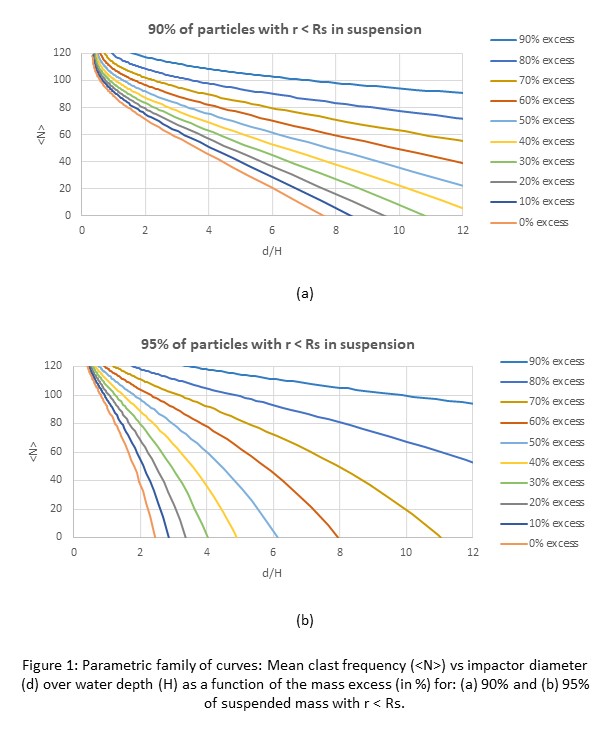
4. Discussion
In order to understand the physics behind the relationship observed in [10], the proposed model has been applied. Figure 2 shows the model results along with the nine drill cores extracted from seven natural impact craters.
The presented model allows the physical interpretation of the observational data, providing a better understanding of the settling conditions. According to the model, the lower position curve (orange curve) represents stable settling conditions, closer to slack-water along with a null excess of mobilized material. This ideal situation, predicted by the model, is compatible with the position and characteristics of the related drill cores. However, the cases laying on the high position curve (blue curve) are those mobilizing a larger amount of solid material and with a higher depositional time for the finest particles, probably related to turbulent flow conditions during the settling process [10].
5. Conclusions
A fractal model for the study of size segregation and particle settling after an impact event in a marine target is presented. The model explains the observed tendency for nine cores obtained from seven natural impact craters, shedding light on the physical processes behind the observations.
Acknowledgements
The authors would like to gratefully acknowledge CSIC financial support for i-LINK project LINKA20203 and to the AEI for project MDM-2017-0737.
References
[1] Filgueira et al., Soil Sci. Soc. Am. J. 67, 1703–1706, 2003.
[2] Filgueira et al., Geoderma 134, 327–334, 2006.
[3] Snabre et al., Rheol Acta 48, 855–870, 2009.
[4] Spearman and Manning, Ocean Dynamics 67, 465–483, 2017.
[5] Herreros and Ormö, EPSC2020-931, 2020.
[6] Johnson et al., Icarus 271, 350–359, 2016.
[7] Melosh, Impact Cratering: A Geologic Process. Oxford University Press Inc, USA, 1989.
[8] Shoemaker, San Diego: Academic Press, 283–359, 1962.
[9] Shoemaker, New York: Pergamon Press, 617–628, 1977.
[10] Ormö et al., Earth and Planetary Science Letters, Vol. 564, 116915, 2021.
How to cite: Herreros, I. and Ormö, J.: Magnitude of marine impacts: Size segregation patterns as an observational assessment., Europlanet Science Congress 2022, Granada, Spain, 18–23 Sep 2022, EPSC2022-41, https://doi.org/10.5194/epsc2022-41, 2022.
INTRODUCTION
The Tabernas Basin (Betic Cordillera) is filled with Neogene, Pliocene and Pleistocene sediments, discordant on a metamorphic basement (Fig. 1). During the Tortonian sedimentation an up to 70 m thick bed of breccia (the Gordo Megabed) was deposited. It consists of up to several tens of meters large, rotated sedimentary megablocks frequently capped and/or surrounded by a polymict breccia of mainly up to m-sized clasts of the crystalline (schist) basement. Previous workers have suggested the bed to be a seismite. The polymict composition of the studied breccias intercalated within the otherwise shallow-marine sediments, the presence of megablocks, plastically deformed megablocks and shock metamorphic features in quartzs of polymict breccias have led us to the description and reinterpretation of sediments and geomorphological features in the Tabernas Basin that could be related to an impact structure.
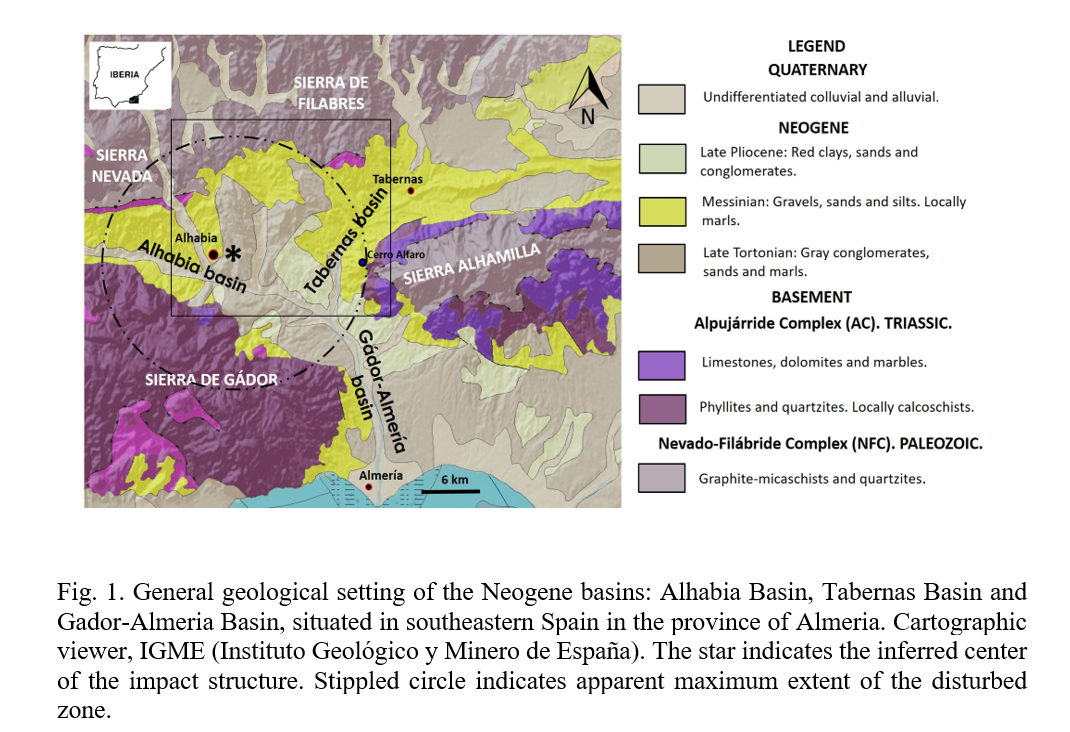
MATERIALS AND METHODS
Multiple field studies were carried out over the course of several years to study the geology and geomorphology of the Tabernas Basin and its surroundings with special focus on the Gordo Megabed. These studies were carried out in conjunction with geological mapping and the measurement of parameters of the observed geological structures.
Thin sections (97 in total) from the different lithologies and locations were prepared and studied for shock metamorphic features under an optical microscope. Quartz grains displaying planar features were studied using the techniques described in Stöffler and Langenhorst (1994) and Ferrière et al. (2009).
RESULTS
Megablocks
We define megablocks as coherent rock blocks that are tilted or rotated, lithologically homogeneous, and that extend in outcrops over at least 30 meters (i.e. having dimensions of several tens of meters).
The material of the megablocks is often made up of sets of turbidites belonging to the Gordo Megabed and three zones have been identified and mapped:
- Zone 1: Central part of the Neogene basin of Tabernas (Rambla de Tabernas).
- Zone 2: Borders to zone 1 to the east and features such as Cerro Alfaro.
- Zone 3: Neogene basin of Alhabia, on the northern flanks of Sierra de Gador.
Plastically Deformed Megablocks
Only three outcrops of these structures SB1, SB2 and SB3 (Fig. 2). They involve recumbent folds with reverse limb whose fold axes follow the direction: N25E, N275E and N210E. They represent plastic internal deformation of the within the slump unit mobilized stacks of Late Tortonian turbiditic marl and sandstones beds, inclined to the NE, W and SW and their directions do not match the main tectonic structures that formed these Neogene basins E-W to NE-SW (Martínez et al., 2017).
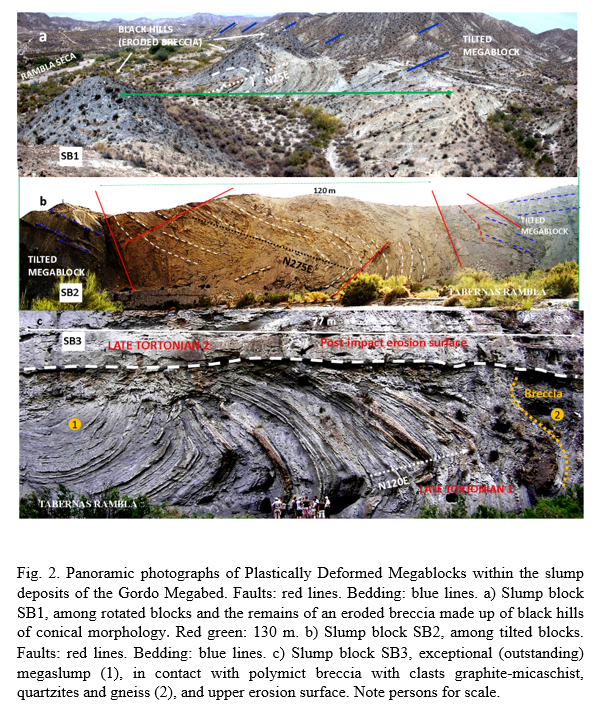
Polymict breccias
Most of the polymict breccias studied (28 in total) are located at the Rambla de Tabernas and present a single lithostratigraphic, mainly graphite-micaschist, quartzite and gneiss, as well as brecciated dolomite. These breccias are massives, unstratified, clast supported and lacks visible sedimentary structures. The angular shape of the fragments indicates short transport, but the basement clast lithologies of the breccia originates far from the present locations.
Breccia 29 is in an anomalous stratigraphic position on Triassic phyllites in Sierra Alhamilla. This is a variable 10-50 cm thick deposit of Neogene material (loams, sands and limestones).
Breccia 30 (sample 2) is located in Sierra de Gádor and constitutes an intermixture of different materials, from both the metamorphic substrate and the Neogene sedimentary sequence.
These features in both breccias could be compatible with a proximal ejecta layer and may clearly be identified by the presence of shock-metamorphic features (Osinski et al., 2013).
Shock-metamorphic features
The systematic search for quartz grains with shock metamorphic features in breccias, resulted in six quartz grains, five grains displaying one set of planar features and one grain with two sets. The features are straight, parallel, sets of planes with a typical spacing between each plane of 1-5 μm. The planar features penetrate the entire grain in four cases, and in two cases they were only visible near the grain boundary in part of the host grain. The features are generally fresh, but occasionally decorated, i.e., lined by minute fluid inclusions (Fig. 3).
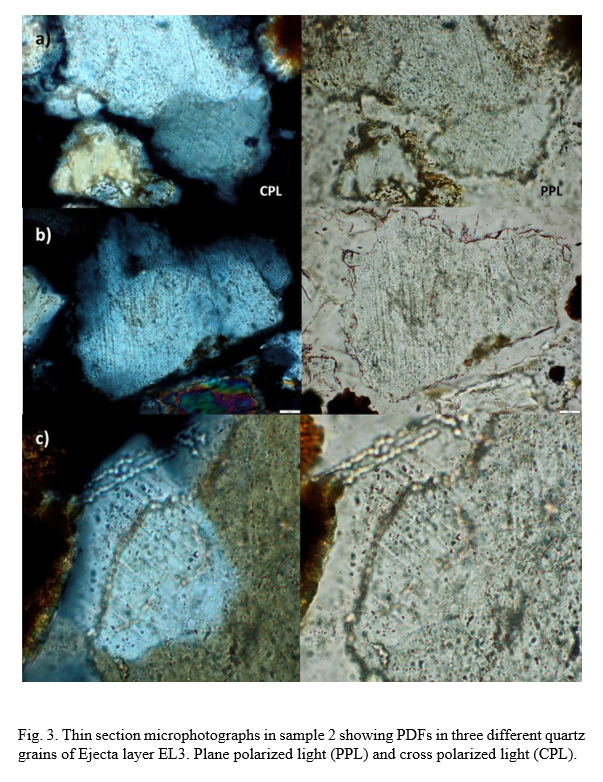
Nevertheless, in light of the indicative, albeit not affirmative, presence of a shocked quartz grains in what we find as analogous lithologies to known impactites based on their composition, appearance, stratigraphic position and geographical distribution, as well as the other sedimentological, stratigraphic, petrographic and geomorphological observations, lead us to propose the existence of a possible impact crater in the Tabernas Basin of Almeria. In our model, the crater is still to large parts preserved, but covered by post-impact materials, which only leaves an already heavily eroded part of the structure visible on the eastern edge.
CONCLUSIONS
A comparison with established impact craters showing similar geological features suggests that the Tabernas Basin still holds a well-preserved, concentric impact structure with a mainly buried, 8-km wide nested crater in the basement surrounded by a 22-km wide, outer crater formed by extensive gravitative collapse of a tens of meters thick, upper target layer of semi-consolidated sedimentary strata, likely in a shallow aquatic paleoenvironment.
REFERENCES
Ferrière, L., Morrow, J. R., Amgaa, T. Koeberl, C. 2009. MAPS 44:925–940.
Martínez, M., Galindo, J., Martínez, F. J. 2017. International Journal of Earth Sciences 106 (7), 2461-2471.
Osinski, G. R., Grieve, R. A. F., Tornabane, L. L. 2013. In Impact Cratering: Processes and Products. Osinski G. R. and Pierazzo E. Eds. Wiley-Blackwell Publishing.
Stöffler, D., Langenhorst, F. 1994. Meteoritics 29(2):155–181
How to cite: Sánchez Garrido, J. A., Ormö, J. O., Alwmark, C., Alwmark, S., Zachen, G., Lilljequist, R., and Sánchez Gómez, S. T.: A probable impact structure in Betic Cordillera, Almeria, SE Spain, Europlanet Science Congress 2022, Granada, Spain, 18–23 Sep 2022, EPSC2022-217, https://doi.org/10.5194/epsc2022-217, 2022.
Introduction
The flux of interplanetary matter hitting our planet can be analyzed by studying the flashes generated when meteoroids impact the lunar ground at hyperspeed regime. Our team at the Institute of Astrophysics of Andalusia (IAA-CSIC) has been involved in the observation and analysis of these impact events since 1997 [1]. Since then, impact flashes have been unambiguously detected during the peak activity of several major meteor showers by using this technique, and flashes of sporadic origin have been also recorded [2].
For the detection of lunar impact flashes we have employed telescopes endowed with high-sensitivity CCD video cameras. Most of our telescopes are Schmidt-Cassegrain instruments with an aperture ranging between 28 to 50 cm, although some observational campaigns have been also performed with much larger instruments, such as, for instance, the 3.5 m telescope located at the Calar Alto Observatory [3].
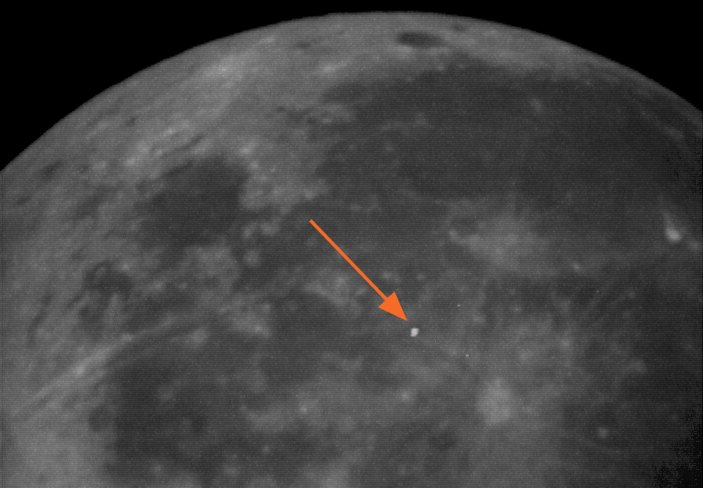
Figure 1. Lunar impact flash recorded in the framework of the ESA CARMEN project on 5 March 2022 at 19h23m16s UT, with a peak apparent magnitude of 5.
During the last decade we have performed important improvements in the systems employed to detect and analyze these flashes. Most of these advances involved the use of faster cameras with higher resolution working at different wavelengths. Here we focus on the systems employed by our team in the framework of ESA's CARMEN project, and also on two new systems deployed at the Calar Alto Observatory in Spain. One of these has been designed to perform observations in three wavelengths.
Contribution to the CARMEN project
Since 2021, and as a continuation of ESA's P3-NEO-I project, our team at IAA is member of a consortium of several astronomical observatories leaded by the companies Deimos Space and 6Roads. This consortium is conducting ESA's project “Consolidating Activities Regarding Moon, Earth and NEOs (CARMEN)”. and are one of the groups responsible for the work package (WP) dedicated to the detection and analysis of lunar impact flashes. One of the aims of this WP is the quantification of the flux of interplanetary matter that impacts our planet. For this purpose we have employed several telescopes located at two observatories in the south of Spain: La Sagra, and Sevilla. We are employing CMOS cameras with a maximum frame rate of 168 fps at full resolution (1920x1200 pixels). Figure 1 shows a sample lunar impact flash recorded with one of these devices in the framework of CARMEN.
New systems at Calar Alto
Our team has deployed a new telescope at the Calar Alto Observatory (Spain) and one of its goals is to observe lunar impact flashes. This instrument, which has an aperture of 60 cm, was initially intended to employ a system consisting of high-speed CMOS cameras (with a frame rate of 300 fps) to observe, simultaneously, at three different wavelengths (I, V and R). The telescope, which has been founded by the Spanish Ministry for Science and Innovation, is located within a dedicated 4-m automated dome. Figure 2 shows an image of this new instrument, which can be controlled remotely. However, it was finally decided to attach this 3-channel system to the 1,25m telescope located at that observatory. The 60-cm telescope would employ a single CMOS camera instead. Both systems are expected to enter operation in 2022, and would imply an important step for the analysis of the collision of meteoroids with the lunar ground.
Figure 2. The new 60 cm telescope deployed at the Calar Alto Observatory.
References
[1] Ortiz, J.L. et al., J., 1999. A search for meteoritic flashes on the Moon. Astron. Astrophys. 343, L57–L60.
[2] J.L. Ortiz, et al., 2000, Optical detection of meteoroidal impacts on the Moon. Nature 405, 921–923.
[3] Madiedo J. M., Ortiz J. L., Yanagisawa M., Aceituno J. and Aceituno F. (2019b). "Impact flashes of meteoroids on the Moon". Meteoroids: Sources of Meteors on Earth and Beyond, Ryabova G. O., Asher D. J., and Campbell-Brown M. D. (eds.), Cambridge, UK. Cambridge University Press, ISBN 9781108426718, 2019, p. 136-158
How to cite: Madiedo, J. M., Ortiz, J. L., and Morales, N.: Lunar impact flashes: observations in the framework of the ESA CARMEN project and development of new monitoring systems, Europlanet Science Congress 2022, Granada, Spain, 18–23 Sep 2022, EPSC2022-648, https://doi.org/10.5194/epsc2022-648, 2022.
The idea of commercially exploring small asteroids in the neighborhood of the Earth-Moon is not new. The interest in such minor objects is due to the fact that many of them have high concentration of metals and volatile (Elvis 2012, 2014), especially water. Exploratory missions could collect water from a near-Earth asteroid (NEA) and transfer it to a lunar orbit, where it could be used to produce fuel for rockets, to maintain human population in space systems, from which round-trip trajectories to other bodies in solar system would be less costly (Sercel 2017, Jedicke 2018, Steklov 2019). However, whether in terms of asteroid resource mining or to improve the scientific techniques for extraction, processing and storage of materials from low-gravity bodies, the cis-lunar space has been considered as a good location (Brophy et al. 2012, Mazanek et al. 2016, Jedicke et al 2018).
We numerically investigate the evolution and fate of ejecta produced by a supposed impact of an artificial projectile with a small asteroid or a boulder from it. In this scenario, we develop an idealized, realistic model to set up the initial state of the ejected particles, considering ejecta released at speeds at or below 1ms−1 from those stable Distant Retrograde Orbits previously determined by Pires & Winter (2020). The purpose of this study is to verify how much material might be delivered to the Earth or to the Moon, besides collision time relative to the position it was ejected in orbit. Our approach allows to gain insight into the dynamics of ejecta clouds generated by mining asteroids in the Earth-Moon vicinity. We verify how long do particles take to fall on each body. The time it took for particles to collide with massive bodies is an important measure when we deal with the realistic prediction of moving material as a result of impact cratering events or for human deflection. Regardless of the ejection speed, particles that fall on the Earth or on the Moon, completed they journey in less than 5 years after being launched into space, or take more than 500 years to have about 1% of them colliding with both bodies. Between 5 and 500 years, the number of collisions is practically null. Most part of the low-speed regolith are lost to space. They escape the system as time advances. The process of loss of ejecta is stronger at the beginning of the numerical simulations and goes to approximately 10 years. There were a sample of ejected particles that remain bounded to the Earth-Moon system during the whole time of numerical simulations (10 K-years). Our methodology is based on several numerical simulations of ejecta using an N-Body code to calculate their evolution accounting its gravity interaction with the massive bodies: the Earth and the Moon, beyond the Sun. Our numerical simulations inputs covers a small range of low-speed ejecta as a result of impact cratering events. We have come up with results that have shown impact ejecta moving at speeds of order millimeter to meters-per-second reach the Earth or the Moon very quickly (less than 5 years) for a given range of initial conditions and assumptions. We will present our main results in terms of histograms and orbital evolution.
How to cite: Pires dos Santos, P. M., Winter, O. C., and Amarante Luiz, A.: Analysis of the evolution of particles ejected from Lunar Distant Retrograde Orbits, Europlanet Science Congress 2022, Granada, Spain, 18–23 Sep 2022, EPSC2022-718, https://doi.org/10.5194/epsc2022-718, 2022.
Polycyclic aromatic hydrocarbons (PAH) are ubiquitous organic molecules populating the interstellar medium of galaxies and they are the major responsible of interstellar infrared spectral features (e.g., Allamandola et al. 1989, Tielens 2008). PAH are also found as constituents in carbonaceous chondrites (e.g., Kalpana et al. 2021). Similarly to silicate dust, carbon-rich micrometric and submicrometric aggregates occur in different astrophysical environments where they are subjected to several weathering processes such as impact shock events and grain-grain collisions. These processes change the chemistry and structure of the original materials giving rise to new chemical species which contribute to the chemical richness of the cosmic environment (e.g., Murri et al. 2022; Mimura et al. 1995). The study of the chemical and structural evolution of aggregates of PAH subjected to extreme conditions is relevant for examine in depth the origin of the densest phases of carbon (e.g., pre-solar grains) as that of prebiotic building blocks of life (Giese et al. 2022). For this purpose, a lot of effort has been made by the whole scientific community for reproducing in laboratory the planetary conditions which trigger the processing of cosmic dust. In this framework, high-energy pulsed lasers represent consolidated tools for reproducing the high energy-density conditions similar to those occurring in shock events in the interstellar medium as a consequence of supernova explosions. Liquid-phase pulsed laser ablation (LP-PLA) is a technique in which high-energy laser pulses are focused on the surface of a solid target immersed in a liquid to induce ablation of material as a result of the ignition of a plasma plume, and recondensation of the ablated material in the surrounding liquid in the form of suspended nanoparticles. The presence of the liquid augments to a great extent the pressure achieved at the solid/liquid interface and allows the onset of cooling rates of the order of 105 K s-1, likewise to what occurs in circumstellar environments. Using this technique, nanodiamonds are commonly produced from graphite targets in water or organic liquids (e.g., Amans et al., 2017).
In this paper we report the results of the high-energy laser processing of a pure nano-phase of rubrene (5,6,11,12-tetraphenyltetracene), a PAH constituted by a backbone of four fused benzene rings (tetracene) bonded to four phenyl rings (Figure 1). The choice of rubrene is motivated by the possibility to obtain commercially available batches of purity higher than 99.9%, its ability to organize in a high-symmetry molecular crystalline phase, and the in-depth knowledge of the photophysical and photochemical properties of both the isolated molecule and molecular aggregates. All these characteristics make rubrene an ideal model system to study the evolution of PAH in response to high-energy processing. We performed LP-PLA of rubrene nano-phases dispersed in water (i) to simulate space weathering in a water environment (e.g., hydrous or volatile-rich bodies) and (ii) to study its chemical and structural evolution. The laser processing of the water suspension was monitored by optical spectroscopy (absorption and luminescence) and high-resolution transmission electron microscopy and diffraction analyses.
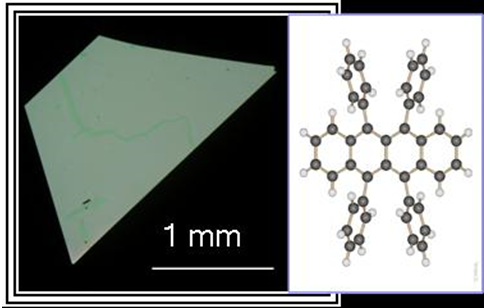
Figure 1. Molecular structure of rubrene (C42H28) and optical micrograph collected with cross polarizers on a thin orthorhombic single crystal or rubrene.
We observed that laser processing brings about a progressive suppression of the absorption band in the visible range of the pristine rubrene nanocrystals, with increment of the signal in the UV range, indicating their transformation into a different phases. The structural and chemical features of these new phases are inferred by high-resolution transmission electron microscopy and analysis and compared with known carbon-rich phases populating the interstellar medium.
Acknowledgments
Funding of the University of Milano – Bicocca through grant 2021-ATEQC-0054 is acknowledged. We are grateful for the support of Giancarlo Capitani for electron microscopy analyses.
References
Allamandola et al. (1989), The Astrophysical Journal Supplement Series 71, 733−775.
Amans et al. (2017), Journal of Colloid and Interface Science 489, 114–125.
Giese et al. (2022), ACS Earth Space Chemistry 6, 468−481.
Kalpana et al. (2021), Planetary and Space Science 198, 105177.
Mimura et al. (1995), Geochimica et Cosmochimica Acta 59, 579−591.
Murri et al. (2022), ACS Earth and Space Chemistry 6, 197−206.
Tielens (2008), Annu. Rev. Astron. Astrophys. 46, 289–337.
How to cite: Campione, M. and Murri, M.: Laboratory simulation of space weathering of nano-aggregates of polycyclic aromatic hydrocarbons dispersed in the water environment, Europlanet Science Congress 2022, Granada, Spain, 18–23 Sep 2022, EPSC2022-801, https://doi.org/10.5194/epsc2022-801, 2022.
Introduction: The dating of geological surfaces on the Moon is crucial for understanding its geological history and evolution. The measurement of Crater Size-Frequency Distributions (CSFDs) can be used for determining relative and absolute ages of surfaces. Older surfaces reflect more and larger craters than younger geological units [1-4]. To determine the relative surface ages, a production function (PF) is constructed to which the CSFD is fitted. One frequently used PF was empirically-derived by measuring craters on reference surfaces using Apollo era data (Neukum, 1983 [1]), which was revised in 2001 [5], and is valid for crater diameters of 10 m - 300 km and 10 m - 100 km, respectively. With increased image resolution of more recent missions [e.g., 6], it has been possible to measure CSFDs for crater diameters down to a few meters. Therefore, it would be beneficial to be able to extend the PF to smaller crater diameters, which would allow the determination of relative and absolute ages for young/small geological units.
A crucial influence on small craters formed in the strength regime are target properties, which has been investigated in several studies [e.g., 7, 8, 9]. Therefore, we aim to perform the crater counts exclusively on continuous ejecta blankets. Secondary craters [e.g., 10-12] influence the CSFD as well and can contaminate the count area, causing a steeper CSFD-slope [e.g., 10, 13, 14]. To avoid this effect and obtain the cleanest PF possible, we selected ejecta areas derived from young Copernican-aged craters. This minimizes the number of field secondary craters on the ejecta and also avoides major degradation of the small craters [15, 16]. However, the identification of self-secondary craters remains problematic, since they occur irregularly distributed on the ejecta blankets and often have morphologies similar to primary craters [e.g., 12, 13].
Method: We used Lunar Reconnaissance Orbiter Narrow Angle Camera (NAC) images [6] including M180509194LE, M1122929850LE and M103831840LE/RE at Giordano Bruno (GB), M1107052575RE and M1112971104RE at Moore F, M129187331LE/RE at North Ray (NR), M119754107RE at South Ray (SR) and M114064206LE at Cone. The resolutions vary between 1.6 m/px and 0.5 m/px, the incidence angles are from 54° to 78°. The CSFDs were measured in ArcGIS with the CraterTools add-in of [18] and displayed in CraterStats with pseudo-log binning [19].
Two areas were investigated at Cone, three at GB, Moore F and SR, respectively. Four areas were investigated by [17] at NR. The selected counting areas are all on the ejecta blakets of the named craters.
Results: Similar to [17] we combined the statistics from the separate count areas into one file and display these CSFDs in a cumulative plot in Figure 1.

Figure 1: Display of the combined CSFDs at GB (green), Moore F (blue), NR (violet), SR (red) and Cone (orange), respectively. The vertical lines of individual data points represent the error bars.
The comparison between the individual CSFD-slopes at GB, Moore F, NR, SR and Cone generally show slightly steeper slopes than the nominal -3 slope of [1] for crater diameters between 10 m and 23 m (in our case 20 m, see Table 1).
Table 1: Display of the considered crater diameter range and the respective CSFD-slopes.
Discussion: We found that the CSFD-slopes on the ejecta blakets of the investigated craters show a tendency regarding the crater diameter. Considering only diameters ≤10 m the slope is marginally shallower than Neukum’s [1] -3 slope, except at GB, which might be explained through secondary cratering. This trend was also observed by [15] (and references therein) and [20] who investigated NR, Cone, Copernicus and Tycho. This might suggest that CSFDs of young Copernican craters have actually a slightly shallower slope at smaller crater diameters. Another possible explanation is the faster degradation of smaller craters [e.g., 21]. Further effects might be the coverage of ejecta material of nearby craters; NR (52.3 Ma [20]), might be influenced by the ejecta of SR (2 Ma [22]), SR by Baby Ray. Moreover, larger craters in two areas at NR and Cone probably penetrated through the ejecta blanket, which can lead to mixed target propertie effects.
Further investigations are required to quantify the effects of secondary cratering, target properties, crater degradation or impactor flux on the determination of our CSFDs. Additional investigation is necessary to determine at which crater diameter the slope becomes shallower or if a transition zone is present.
Acknowledgments: This Project is funded by the Deutsche Forschungsgemeinschaft (DFG, German Research Foundation) – Project-ID 263649064 – TRR 170.
References: [1] Neukum (1983), NASA TM-77558. [2] Öpik (1960), RAS 120(5), 404-41. [3] Shoemaker et al. (1970), Science, 167 (3918), 452-455. [4] Baldwin (1971), Icarus, 14, 36-52. [5] Neukum et al. (2001), Space Sci. Rev., 96, 55. [6] Robinson et al. (2010), Space Sci. Rev. 150, 81-124. [7] van der Bogert et al. (2010), LPSC 41, #2165. [8] Wünnemann et al. (2011), Proceedings of the 11th hypervelocity impact symposium., Vol. 20. [9] van der Bogert et al. (2017), Icarus, 298, 49-63. [10] McEwen and Bierhaus (2006), Annu. Rev. Earth Planet. Sci. 34, 535-567. [11] Xiao and Strom (2012), Icarus 220, 254. [12] Zanetti et al. (2017), Icarus 298, 64-77. [13] Plescia et al. (2010), LPSC 41, #2038. [14] Plescia and Robinson (2011), LPSC 42, #1839. [15] Moore et al. (1980), Moon and Planets, 23, 231-252. [16] Fassett and Thomson. Journal of Geophysical Research: Planets 119.10, 2255-2271. [17] Hiesinger et al. (2012), JGR 117, E00H10. [18] Kneissl et al. (2011), PSS 59, 1243-1254. [19] Michael et al. (2016), Icarus 277, 279-285. [20] Williams et al. (2014), Icarus 235, 23-36. [21] Mahanti et al. (2018), Icarus, 299, 475-501. [22] Stöffler and Ryder (2001), Space Sci. Rev., 96, 9-54.
How to cite: Oetting, A., Hiesinger, H., and van der Bogert, C.: Refinement of the Lunar Production Function - The CSFD-Slope of Small Crater Diameters on Ejecta Blankets, Europlanet Science Congress 2022, Granada, Spain, 18–23 Sep 2022, EPSC2022-828, https://doi.org/10.5194/epsc2022-828, 2022.
1. Introduction
Asteroid impacts, ranging from small-scale cratering events to catastrophic disruption, have played a crucial role in the formation and evolution of asteroids (Jutzi et al., 2015). Thanks to the increasing performance of computers, shock-physics numerical codes have become commonly used in the field of hypervelocity impacts, to extrapolate experimental results and help us be better prepared for space missions devoted to asteroid deflection using the kinetic impactor techniques, such as the NASA DART (Rivkin et al. 2020) and ESA Hera missions (Michel et al. 2022), and evaluate the outcomes.
Past numerical studies showed us that it is possible to divide the asteroid impact process into two stages that occur at very different time scales, the early stage of fragmentation of the asteroid and the late stage of gravitational reaccumulation of the fragments (e.g, Michel et al. 2001). For the early stage, various numerical methods have been developed to solve this short but extreme physical process, such as the Smooth Particle Hydrodynamics (SPH) technique used in codes like the Bern SPH and grid techniques used in codes like CTH or iSALE. Each method has its unique advantages, but they share a common challenge that the contact and the boundary condition are not well handled (El Mir et al., 2019).
In this study, we exploit the Material Point Method (MPM) framework, an extension of the particle-in-cell method, to simulate the early stage of impact in order to offer a new approach and solutions to the above problems.
2. Methods
MPM is a meshfree method, characterizing the material domain by a group of points. These Lagrangian material points carry all state variables. Meanwhile, a predefined regular background grid is used. In each timestep, material information is mapped to grid nodes, to solve the momentum equations, and material points deform with the grid. Then the information is mapped back to the points to update their positions and velocities, discard the deformed grid, and reset a new one to calculate the next timestep (Zhang et al., 2013). MPM framework combines the advantage of both Lagrangian description and Eulerian description, which not only avoids the undesirable mesh tangling caused by large deformations, but also eliminates the difficulties in solving contact and boundary conditions.
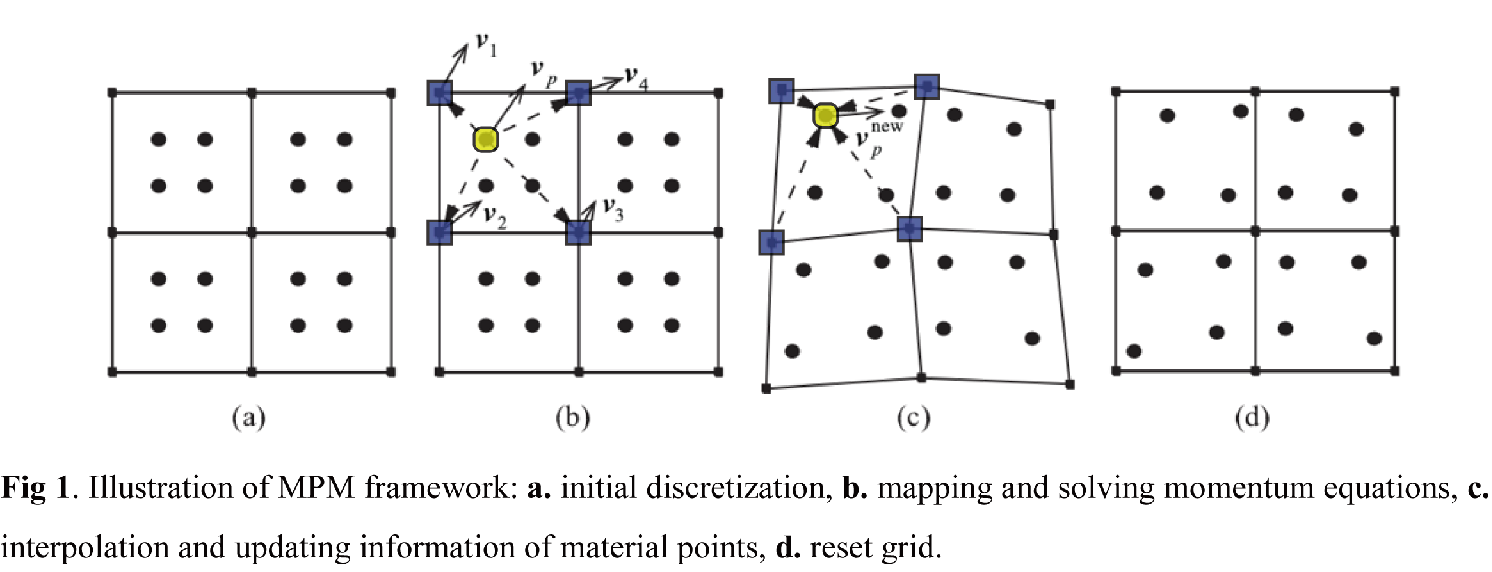
As such, MPM is well used in simulating impacts, explosions, and metal forming of on-earth situation (Zhang et al., 2013). So far, it has not been commonly used to model hypervelocity impacts on asteroids (El Mir et al., 2019). Hence, we start with building material models that are applicable to asteroids made of porous and brittle materials.
The material models include Drucker-Prager strength model that describes cohesion and pressure-dependent strength effect. We also use the Tillotson equation of state for basalt coupled with the P-alpha model which accounts for porosity, and as stress-based failure criterion consistent with Weibull distribution. The framework is thus similar to that used by other studies using the SPH numerical method (Raducan and Jutzi, 2021). Our MPM model is then validated by comparing with laboratory impact experiments and the simulations using the SPH method.
3. Results
We compare our simulations with SPH simulations (Benz & Asphaug, 1994) and the impact experiments (Nakamura et al., 1991) on non-porous basalt sphere used to validate them. Our result shows that our material model under the MPM framework can successfully characterize the shell-like propagation of the failure zone (Fig 2.c2). However, a concentration of stresses reflected back from the boundary subsequently occurres, resulting in a severe secondary failure in the nuclear region. (Fig 2.c3) This stress concentration may cause by the unsmooth discrete boundary and the lack of energy dissipation. The analysis of large fragments reveals this problem too: although with a similar mass distribution, the velocity of the largest fragment in MPM simulation is significantly higher (Fig 3.a). Apart from that, the simulation results are otherwise in good agreement with the previous studies, especially the shape of the largest fragment of MPM simulation (Fig 3.b) versus a recent experiment (Fig 3.c). Noting the usual spreading in experimental outcomes using same conditions, the MPM method can thus be considered valid.
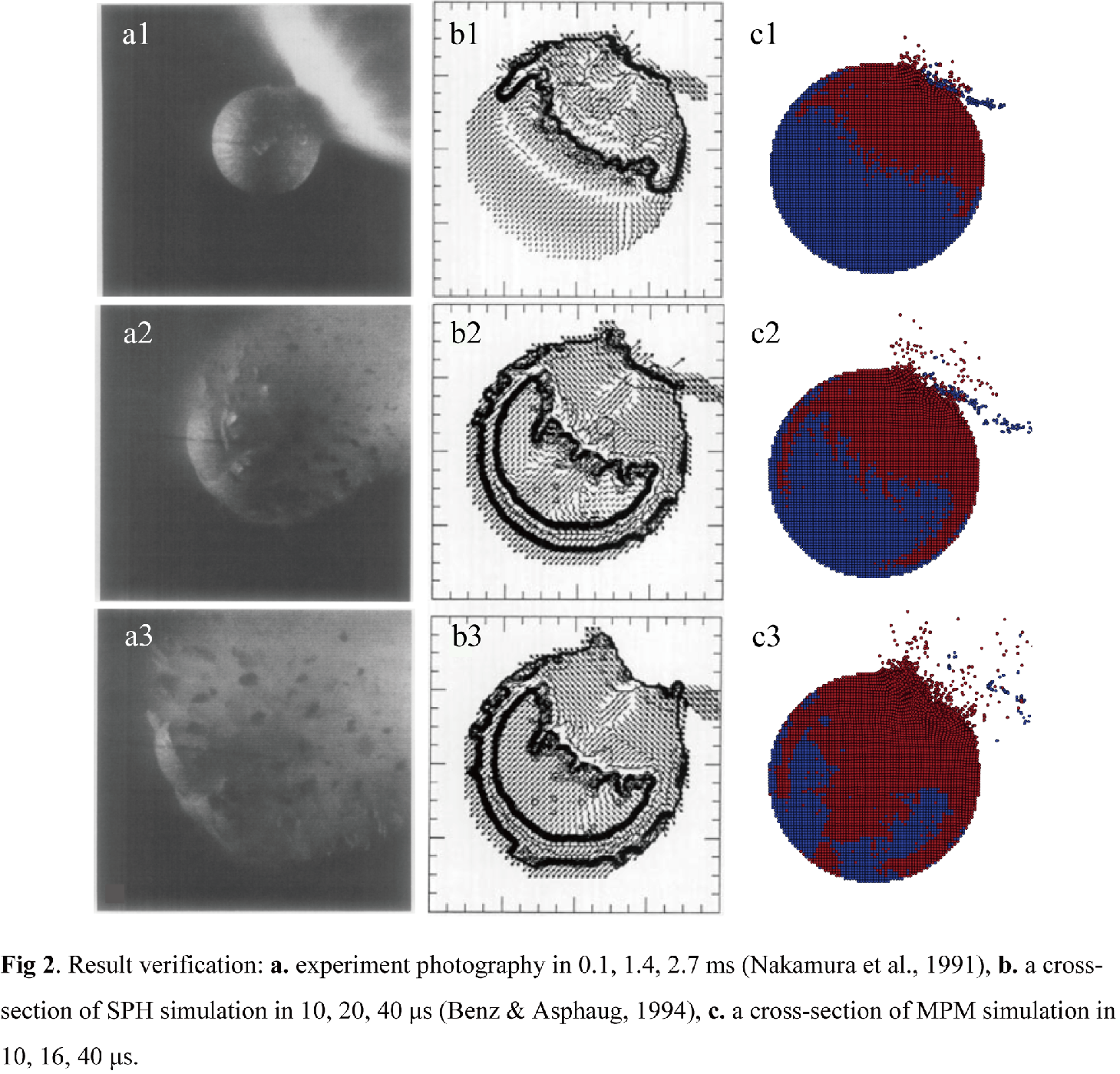
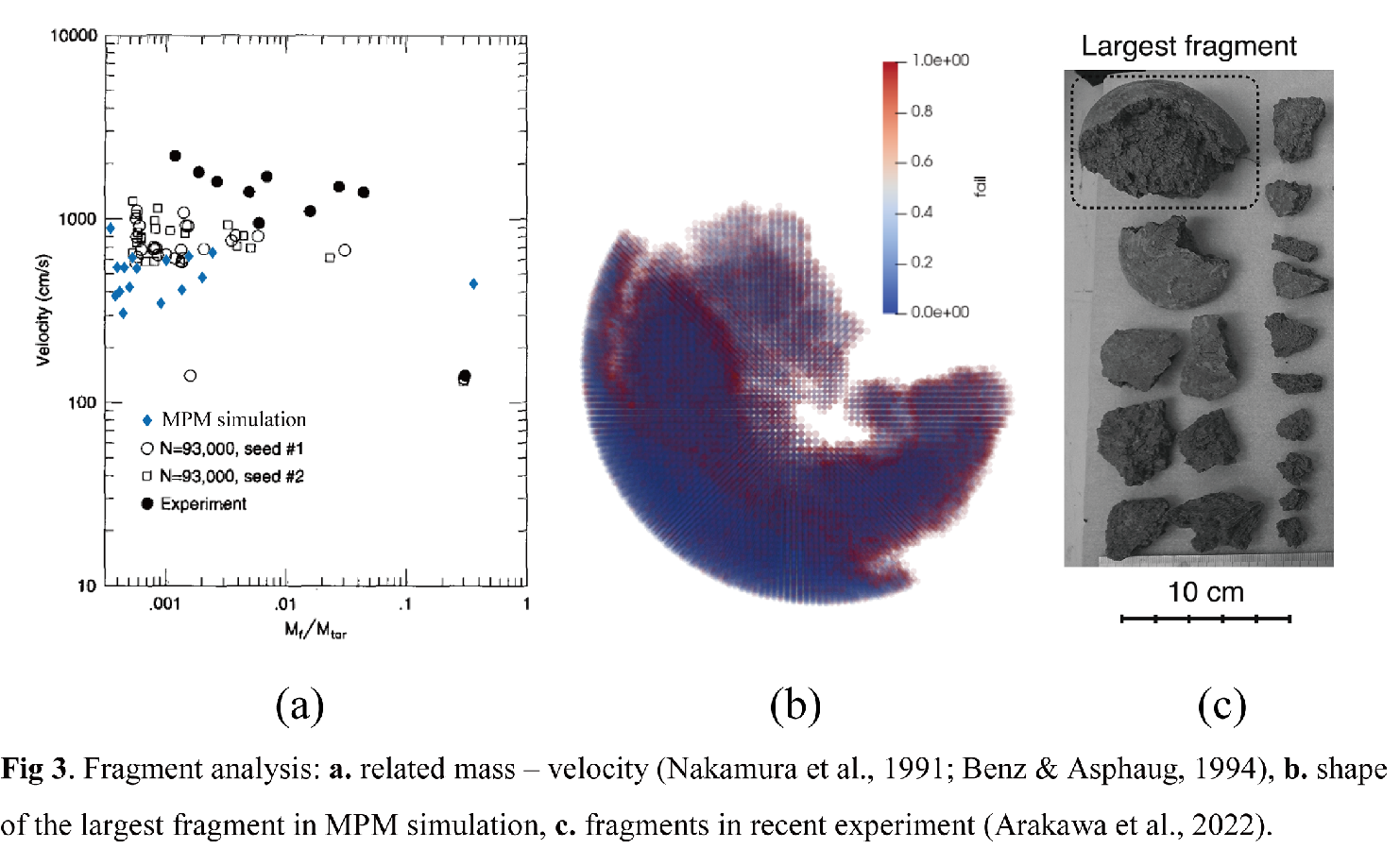
Further research will be centered on verifying the P-alpha model and the correct treatment of porosity (Jutzi et al., 2009).
4. Conclusion and Discussion
The MPM framework can complement of other shock-physics code to balance the accuracy and efficiency of calculation. Furthermore, the mentioned features of solving contact and boundary conditions with MPM broadens the application of the simulation algorithm in the hypervelocity impact stage, and may make it easier than SPH models to combine with the Soft-Sphere Discrete Element Method (SSDEM) code (Fig 4) to simulate the two-stage impact process (SPH-SSDEM method refers Zhang et al., 2021).
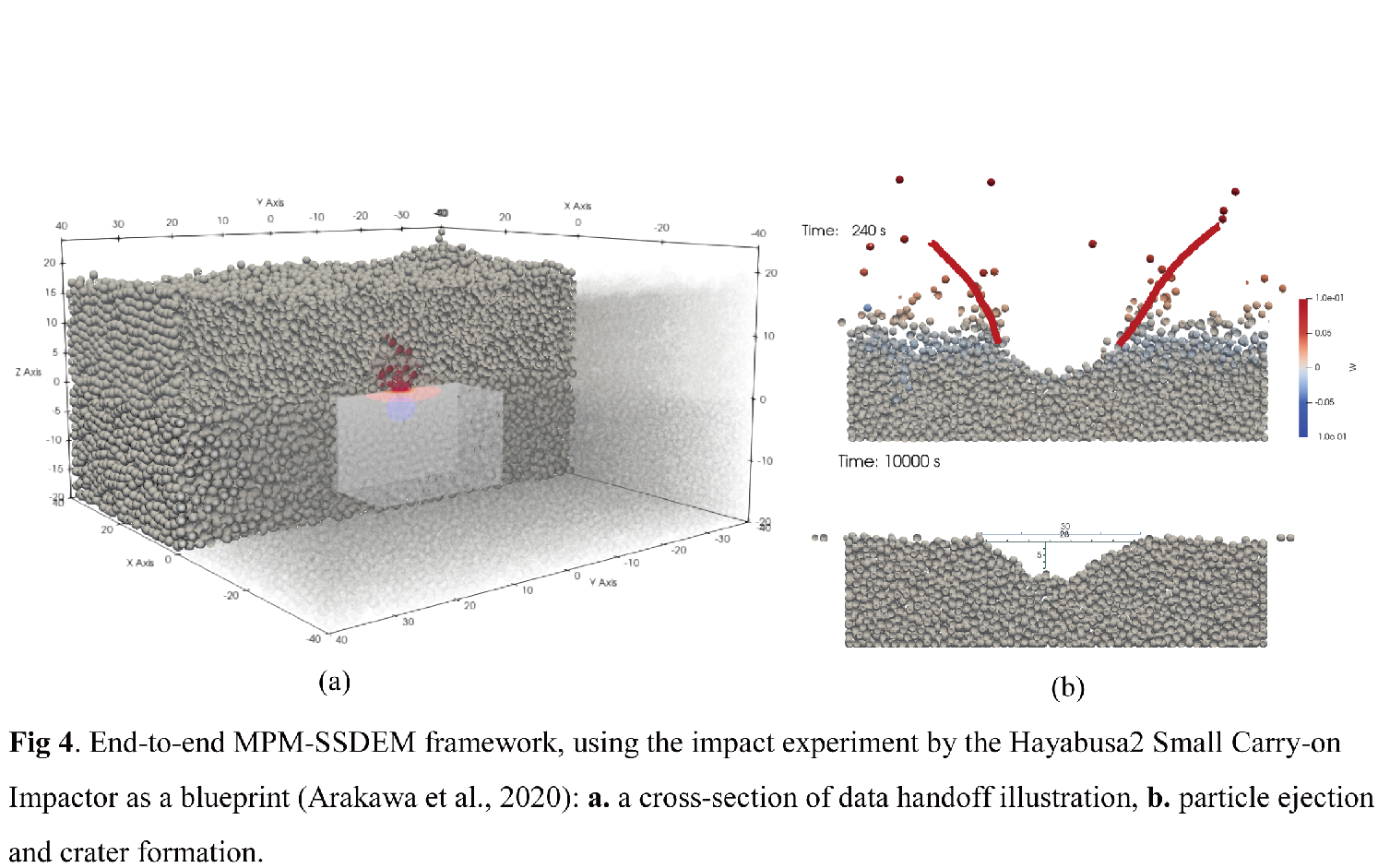
All these studies will offer a glimpse into the active processes from the early formation of the solar system to the current epoch, and contribute to planetary defense.
Acknowledgements:
We acknowledge support from the Université Côte d’Azur. X.Y. acknowledges support from Tsinghua University, funding from the Chinese Scholarship Council, and the National Natural Science Foundation of China (No. 11872223). P.M. acknowledges funding from CNES, from the European Union’s Horizon 2020 research and innovation program under grant agreement No. 870377 (project NEO-MAPP) and from the CNRS through the MITI interdisciplinary programs.
References:
Arakawa, M. et al. (2020) Science, 368, 67–71.
Arakawa, M. et al. (2022) Icarus, 373, 114777.
Benz, W., & Asphaug, E. (1994) Icarus, 107(1), 98–116.
El Mir, C. et al. (2019) Icarus, 321, 1013–1025.
Raducan, S.D. & Jutzi, M. (2021) 52nd LPSC, #1900.
Jutzi, M. et al. (2009) Icarus, 201(2), 802–813.
Jutzi, M. et al. (2015) In: Asteroids IV (Michel P. et al., eds.) 679–699.
Michel et al. (2001) Science, 294, 1696-1700.
Michel et al. (2022) Planetary Science Journal, accepted.
Nakamura, A., & Fujiwara, A. (1991). Icarus, 92, 132–146.
Rivkin, A. et al. (2020) Planetary Science Journal, 2, 173.
Zhang, X. et al. (2013) Beijing: Tsinghua University Press.
Zhang, Y. et al. (2021) 52nd LPSC, #1974.
How to cite: Yan, X., Liu, Y., Zhang, Y., Michel, P., and Li, J.: Hypervelocity impact simulation on asteroids with MPM framework, Europlanet Science Congress 2022, Granada, Spain, 18–23 Sep 2022, EPSC2022-1064, https://doi.org/10.5194/epsc2022-1064, 2022.
Introduction
A lunar impact flash (LIF) is a rapid burst of light caused by a hypervelocity impactor hitting the moon, releasing a fraction of its energy as light. They are observable though moderately sized (0.4m) telescopes, and are therefore observable by both amateur and professional astronomers.
LIF observations are typically performed in visible or NIR, and can only take place when the lunar phase is between 10-50%, during local night, and are only observable against the lunar night-side; the most commonly observed LIFs are faint, approximately MagI = 9, MagR = 10 [1], making them indistinguishable against the illuminated lunar background. This limits potential observations of LIFs to ~30h per month on average, with weather limiting this further.
In order to increase the average number of observable hours that LIF observations can be made, and thereby increase the number of observed LIFs, we have developed new techniques to perform LIF observations at all local times, and all lunar illuminations. This technique theoretically only requires clear weather and a visible moon.
Theory
LIFs have been shown to behave as black bodies, releasing energy according to Planck's law [2]. The temperature of LIFs observed by NELIOTA is between 1300-5800 k, with average temperature, Tavg = 2800k [3]. This average has peak wavelength of λpeak = 1.035 μm. The illuminated portion of the lunar surface is reflecting light from the sun (T = 5778 k, λpeak = 0.5 μm). In R-band and I-band, the ratio of energy radiated by the sun is greater by a factor of 57 in R-band, and 28 in I-band. My observing in wavelengths closer to the λpeak of the flash, we can improve this ratio greatly.
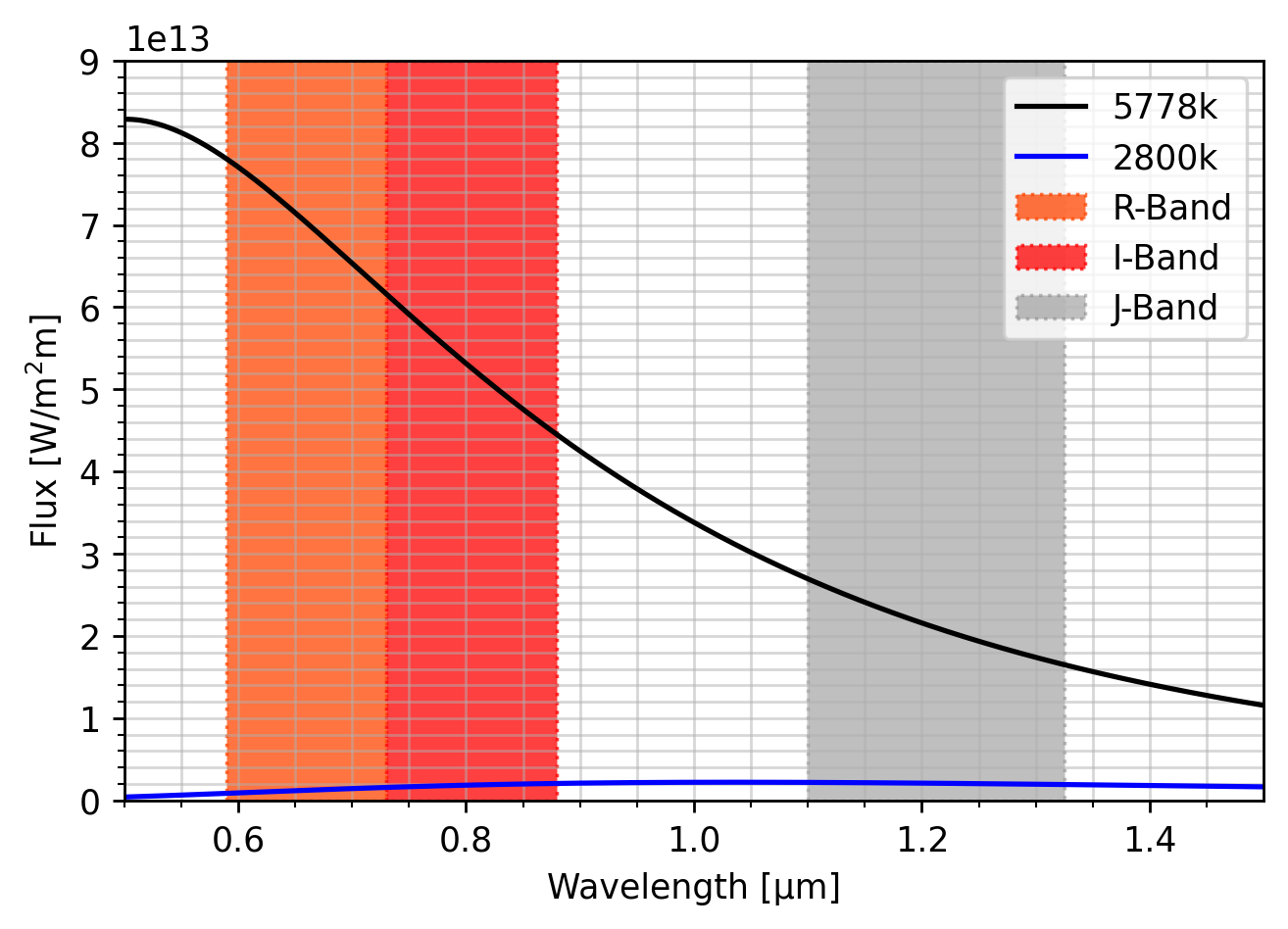
Figure 1:The Planck curve for the sun (5778k) and the average LIF (2750k), R, I, and J-band regions are highlighted in orange, red, and grey respectively.
As illustrated in Fig. 1, by observing in J-band the irradiance of the sun is lowered, being only 10 times greater than the 2800 k LIF. This effective dimming of the background leads to an increase in the signal-to-noise ratio (S/N) of the LIF against the sun-illuminated background.
The S/N ratio is a measure of how detectable a signal is above the background, and can be defined as:
S/N = S" / (σ × √Apix)
Where S" is the total count of the signal, σB is the standard deviation of the background, and Apix is the area of the background measurement. A S/N ratio above ≈10 is generally required for a signal to be considered detectable.
Observations
Observations were performed on 2022-02-23 from the Observatoire de la Côte d'Azur, using a 0.5 m diameter, 2 m focal length telescope with Ninox 640 II camera and J-band filter attached. For the first set of observations, high gain mode was used, for the second set of observations low gain mode was used. A 30 μm exposure time was used for both sets of observations.
The star HD137463 was observed, which has MagJ = 5.423, obtained by Simbad [4] Observations began during the night, and continued until after sunrise in order to measure the brightness of the sky during daytime.
By performing A-B subtraction to remove the dark current and background of the observed frames, as shown in Fig. 2, a pixel count for the clean star signal, S", can be obtained. As it is constant, an average for the star signal can be used as ground truth in order to calculate the S/N ratio for the daytime sky brightness, as well as the illuminated lunar surface.
Figure 2: The A-B subtraction of two observations of HD137463. The subtraction removes any dark current or background to leave only a clean positive and negative signal.
Results
The S/N ratio for the a MagJ = 5.423 star are shown in Fig. 3. A sharp decrease in S/N ratio is observed as air-glow begins around solar altitude = -5. The S/N continues to decrease, slowly levelling off around S/N = 15 as the sun reaches solar altitude = 5. This puts the magJ = 5.423 star well above the detectable threshold, and would correspond to a MagR = 6.7 LIF.
Figure 3: Left: The S/N ratio in high gain mode, of HD137463 against the sky background between solar altitudes -10 & -1. Right: The S/N ratio in low gain mode, of HD137463 against the sky background between solar altitudes -1 & -5.
By taking measurements of the lunar background brightness, we can verify the S/N ratio we would expect from these LIF when observed on the lunar surface. Table 1 contains the results from count-averaged observations of the background, and the S/N of the MagJ star if observed against the background, emulating a flash. Again, even against the illuminated bright limb, the S/N ratio is above the detectable threshold, and shows that with this system, we would be able to detect LIFs of MagJ ≥ 5.423, with the possibility of even fainter magnitudes under more favourable conditions.
Table 1: The S/N ratio of the reference star used against different regions on the lunar surface, from darkest to brightest.
| Region | S/N |
| Lunar Night Side | 147 |
| Terminator | 42 |
| Lunar Day Side | 21 |
| Lunar Bright Limb | 19 |
References
[1] Liakos et al (2019) A&A, 633, 29 pp.
[2] Eichhorn (1975) P&SS, 23, 11, 1519-1525
[3] Avdellidou & Vaubaillon (2019) MNRAS, 484, 5212-5222
[4] Wegner et al (2000) A&A, 143, p.9-22
How to cite: Sheward, D., Delbo, M., Avdellidou, C., Cook, A., and Lognonne, P.: J-Band Measurements for All-Hours Lunar Impact Flash Observations, Europlanet Science Congress 2022, Granada, Spain, 18–23 Sep 2022, EPSC2022-1077, https://doi.org/10.5194/epsc2022-1077, 2022.
TP15 | Astrobiology
To be sustainable, a settlement on Mars should be as independent of Earth as possible in terms of material resources. This independence may be reached with the help of biological systems: those could perform a wide range of functions with a low impact on the surroundings. However, biological systems would best rely on resources available on Mars – as recycling alone would mean that the amounts of available resources decrease over time – and most organisms cannot utilize raw Martian resources directly.
A solution has been proposed which lies in using diazotrophic, rock-weathering cyanobacteria. Their physiology is such that they could, it seems, be fed with materials available on site: water mined from the ground or atmosphere; carbon and nitrogen sourced from the atmosphere; and the local regolith, from which it has been argued that they could extract the other necessary nutrients. The cultured cyanobacteria could then produce various consumables directly, such as dioxygen and dietary supplements but also support the growth of secondary producers (plants or microorganisms) which could, in turn, generate a wide range of critical consumables.
Various proofs-of-concept have been reported in the literature and evidence accumulates that some cyanobacteria could, indeed, be fed from Martian resources and provide feedstock for other organisms of biotechnological interest. But whether a system works at all is not sufficient to decide whether it should be integrated into mission plans: its cost-efficiency must be determined and compared to potential alternatives.
Among the factors that will determine this cost-efficiency is the fitness of cyanobacteria under (i) hypobaria (low pressures), and as a result low partial pressures of dinitrogen; and (ii) a dependence on regolith for all nutrients not provided as gases, which would also lead to high concentrations of highly oxidizing compounds (chiefly, perchlorates) in the extracellular medium. Another key element is the design of specific cultivation hardware.
In this presentation, we will present the wet-lab and in-silico work performed at the ZARM’s Laboratory of Applied Space Microbiology to study those factors and thereby assess, and improve, the efficiency of cyanobacterium-based, biological ISRU on Mars.
How to cite: Verseux, C. and Ramalho, T.: On the cost-efficiency of cyanobacterium-based, biological ISRU on Mars, Europlanet Science Congress 2022, Granada, Spain, 18–23 Sep 2022, EPSC2022-57, https://doi.org/10.5194/epsc2022-57, 2022.
Introduction
The survivability of bacteria in planetary impacts has previously been investigated using a two-stage Light Gas Gun (as seen in Figure 1). During these experiments, projectiles were doped with bacteria (Rhodococcus erythropolis) and fired at hypervelocity into rock [1,2], metal [2], water-ice [3,4] and agar [4,5] targets. These experiments were designed to investigate the feasibility of the panspermia theory, which details how indigenous life forms may be spread beyond their host body via the ejecta created by hypervelocity impacts and go on to seed neighbouring bodies. These studies showed that bacteria do survive hypervelocity impact; however, the methods do not accurately quantify the survival rate on the target compared to the initial cell load on the projectile, nor do they quantify or characterise any sub-lethal effects.
Figure 1: The Light Gas Gun impact facility at the University of Kent.
Creating A Successful Target
Attempts have been made to develop new methods that give greater quantitative insights into both survival and sub-lethal effects of hypervelocity impacts. As well as investigating the survival rate of the bacterial population, we are looking at whether the transient extremes of pressure which occur as a result of hypervelocity impact modulate phenotypic change amongst the surviving bacteria, and thus could be a factor in the evolution of life.
The bacteria (in this case Escherichia coli) in our experiments have been placed inside the target instead of the projectile. This decision was made in order to remove the potential issues of the loss or death of cells as a result of the acceleration of the projectile. Several different target designs were trialled, largely involving the use of agar as a medium for housing the bacteria. These attempts led to a set of criteria being defined for a successful target, including efficient propagation of the shock wave through the sample to ensure that the bacteria are experiencing the intended conditions, and clean recovery of the majority of the sample with little or no contaminants.
The Liquid Target Setup
Following much experimentation, a liquid target setup was created, as seen in Figure 2. A 50 ml liquid sample containing the bacteria is housed inside a thin polythene bag and placed inside a steel tube, which upon impact collects the liquid and allows for ease of recovery and analysis. The impacted plastic bag produces a large amount of debris within the collected sample, which interferes with some of the optical data gathered during post-impact analysis of the bacteria. Also, there is concern that the entirety of the sample is not experiencing the full force of the impact. To address these issues, we are designing a secondary tube with a much smaller diameter which can be inserted and secured inside the primary steel tube; this should mean that more of the sample volume will experience higher shock pressures in the range of several GPa, which can be verified by simulating the impacts using Autodyn modelling. To replace the polythene bag, and thus attempt to minimise the quantity of debris entering the system, the liquid sample will be sealed directly inside the secondary tube with an extremely thin foil.
Impacts have been completed across the velocity range of 1-5 km/s using this setup. The following analysis methods have been applied to the recovered samples post-impact:
- OD600 (optical density) recordings to understand changes in whole cell numbers by measuring the number of particles within a given sample
- Protein assays to understand the amount of physical damage or lysis to the cells
- Growth on agar plates to understand how the viability of the population has changed via the counting of colony forming units (CFUs)
- Oxygen electrode analysis to see if the metabolic pathways of the cells have been affected by measuring cellular respiration in the presence of glucose
So far, no significant changes to the survival rate or the phenotype of the population have been observed following these impacts using the analysis methods described.
Figure 2: The liquid target setup within the target chamber of the Light Gas Gun.
Influence of Exposure Time to Impact Conditions
The results from the liquid target impacts have raised the question of whether the extremely short duration of the shock pressure is insufficient to lead to any meaningful change in the bacterial population. To investigate this, E. coli samples prepared in the same manner as for the impacts are instead placed inside a sonicator, where the sound waves generate pressures within the sample of around 200 MPa, compared to the impact shock pressures of several GPa created in the Light Gas Gun. The sonication exposure times were varied, using 4 bursts of 0, 5, 10, 30 and 60 seconds, compared to the milliseconds or less that the peak shock pressures are applied to the sample in the Light Gas Gun.
A steady decline of surviving bacteria and a significant increase in cell lysis was observed as the exposure time was increased, supporting the idea that time is the key factor in generating populational changes. At burst exposure times of 30 seconds or more, an unusual phenotype emerges following growth of the sonicated samples in the form of a new colony type displaying a concentric ring pattern of growth, as shown in Figure 3. This is currently being investigated further with repeat experiments, antibiotic testing and 16S rRNA sequencing to confirm that this is indeed a change in phenotype and not a result of a separate factor such as contamination.
Figure 3: An agar plate spread with a sample of E. coli cells following 4 30-second bursts of sonication.
References
[1] Burchell et al. (2000) In Gilmour I., Koeberl C. (eds) Impacts and the Early Earth. Lecture Notes in Earth Sciences, vol 91.
[2] Burchell et al. (2001) Adv. Space. Res. 28(4), 707-712.
[3] Burchell et al. (2003) Origins of Life and Evolution of the Biosphere 33, 53-74 (2003).
[4] Burchell et al. (2004) Mon. Not. R. Astron. Soc. 352, 1273-1278 (2004).
[5] Burchell et al. (2001) Icarus 154, 545-547 (2001).
How to cite: Wilkinson, R., Wozniakiewicz, P., and Robinson, G.: Exploration of Methodologies to Investigate Bacterial Survival in Planetary Impacts, Europlanet Science Congress 2022, Granada, Spain, 18–23 Sep 2022, EPSC2022-121, https://doi.org/10.5194/epsc2022-121, 2022.
Exploring the limits of life is one of the objectives for better understanding how organisms have arisen on Earth, how they tolerate extreme conditions and how they might survive on other planets or moons. These investigations could help with understanding which Earth microorganisms could survive on other celestial bodies, such as the icy Moons: Europa (Jupiter) and Enceladus (Saturn). Furthermore, it might help with indicating how life could have developed on Earth or on the icy Moons of the Solar system. This project focuses on the insights from prokaryotic, eukaryotic and archaea organisms which can tolerate the simulated subsurface ocean environment of Europa and Enceladus. The moons have been speculated to have subsurface oceans which are heated by tidal movements or hydrothermal vents. These combined factors could create an environment suitable for life. Furthermore, the mechanism of radiation, desiccation and temperature survival could help us understand whether the organisms could survive a hitchhike on spacecraft surfaces travelling to the moons. During space exploration it is essential to avoid the contamination of planets and moons of astrobiological interest by microorganisms from Earth.
The projects’ main question is: What are the boundaries of tolerance for cold-adapted halophilic microorganisms as determined by simulated space conditions? Furthermore, we also want to investigate the survival to simulated icy moon conditions. At this stage of the project two organisms have been investigated, the bacterium Planococcus halocryophilus and the yeast Rhodotorula frigidalcoholis. Our aim is to use one organism from each domain of life: prokaryote, eukaryote and archaea. Preliminary results have shown a fair survival of R. frigidalcoholis but not of P. halocryophilus to some simulated space conditions. In order to find better suited bacterial and archaea candidates we will be investigating cold adapted microorganisms from astrobiologically relevant sites. Examples include the Shaban deep, a brine sediment in the Northern Red sea, permafrost core, Antarctic soil samples, glacier ice and arctic sea-ice cores. The bacteria we have selected are the following: Paenisporosarcina antarctica, Psychromonas boydii, Cryobacterium flavum, Virgibacillus arcticus and Chromohalobacter saracensis. The archaea are: Halorubrum luteum and Halorhabdus tiamatea.
The results we processed have shown that R. frigidalcoholis is more tolerant than P. halocryophilus to monochromatic UV-C (254 nm) and polychromatic UV (200-400 nm) as well as X-ray. When exposed to desiccating conditions, at different temperatures, the difference between the two organisms is not so noticeable. The results which we present here have been developed from the microorganisms grown under minimal media conditions, supplemented with a sole carbon source (L-Glutamic acid for R. frigidalcoholis and D-Alanine for P. halocryophilus). The decision to use minimal media and single carbon sources, not as common as glucose, was in support of simulating stress growth conditions to an extent similar to the ones on Europa and Enceladus. Planetary bodies where some simple organics have been detected in low concentrations.
Despite the two organisms being isolated from similar environments, R. frigidalcoholis from ice cemented permafrost in University valley (Antarctic) and P. halocryophilus from permafrost active-layer soil in the Canadian High Arctic, they have great differences in their tolerance to extreme conditions. Tested conditions include desiccation survival at: room temperature, -20 and -80°C under oxic and anoxic conditions. Additionally, we can describe a fair survival of R. frigidalcoholis to weekly freeze-thaw conditions from -80°C to 25°C respectively.
Being two organisms isolated from arctic-like environments, our hypothesis supported a great tolerance to freeze and thaw conditions. The reduction in relative survival of R. frigidalcoholis to an order of magnitude of 10-2, supports our hypothesis. Of importance to note for this experiment are the -80°C freezing conditions. In the literature similar tests are conducted at higher temperatures (-40 and -10°C).
The preliminary results exposing R. frigidalcoholis and P. halocryophilus to harsh growth conditions are useful for initial expectations to survival in environments similar to the ones on Europa or Enceladus. For continuing and future research, this project could be of particular interest for defining a protocol for microbial exposure to simulated extreme environmental conditions. As well as to support the development of suitable planetary protection measures. The following graphs show the results of the described experiments. The figures include in formation on the relative survival of organisms and the F10 values for each condition. The F10 values have been included to represent the dose to which there is 10% survival to the exposed condition.
UV-C Irradiation:
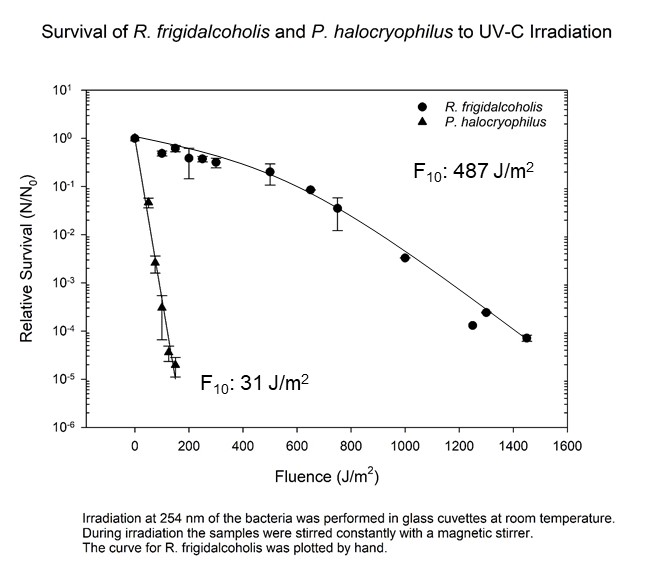
Polychromatic UV Irradiation:
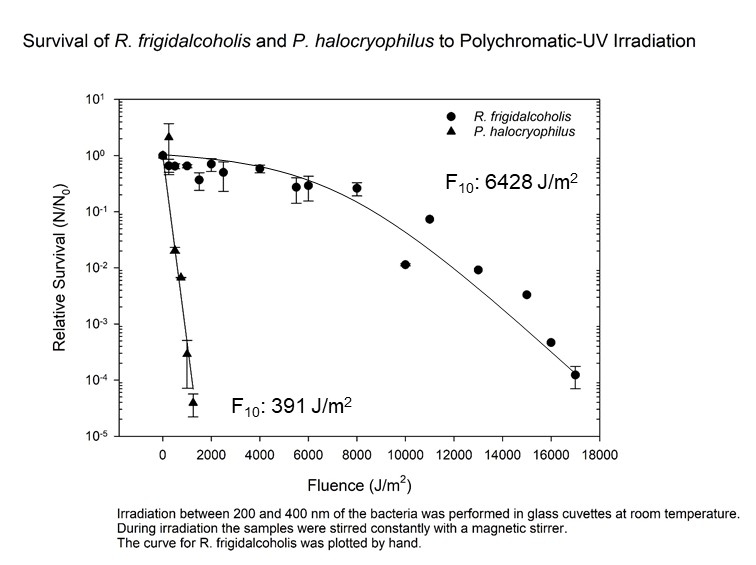
X-ray Irradiation:
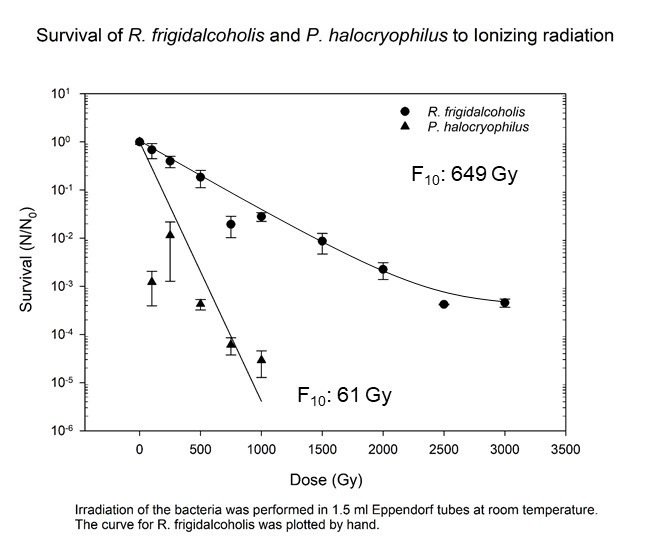
How to cite: Zaccaria, T., Rettberg, P., Beblo-Vranesevic, K., De Jonge, M., and Netea, M.: Investigation of the physiological response of cold-adapted microorganisms to extreme environmental stress factors., Europlanet Science Congress 2022, Granada, Spain, 18–23 Sep 2022, EPSC2022-206, https://doi.org/10.5194/epsc2022-206, 2022.
Abstract
What is life and how could it originate? This question lies at the heart of understanding the cell as the smallest living unit. Although we are witnessing a golden age of life sciences, we are ironically still far from giving a convincing answer to this question. With the aim to examines potential source of energy available to protocells on early Earth and/or elsewhere and mechanisms by which the energy could be used to drive polymer synthesis, experiments aimed at revealing the ability of meteorites and some terrestrial rocks to perform catalytic reactions operative in present-day life have been performed.
1. Indroduction
The aim of this work is to present and discuss results of recent and ongoing wet-lab experiments supporting Multiple Root Genesis Hypothesis (MuGeRo) already proposed elsewhere [1] seeking approaches surrounding the mysterious primeval steps of life emergence on Earth or on planets around distant stars beyond our Galaxy. This is an additional hypothesis to that microbial or early forms of life were already present in our solar system at the time of our Earth’s formation so that we can reconsider that panspermia and abiogenesis are not rival theories but complementary theories [2]. Life on Earth is carbon-based, uses water as solvent, and photosynthesis and chemosynthesis as way to obtain energy. Following a bottom-up approach, I utilized as a model for the emergence of earliest life on Earth, the self-organizing M4 material that I’m producing from L6 condrites and some terrestrial rocks and minerals (olivine and magnetite ) [3].
2. Figures
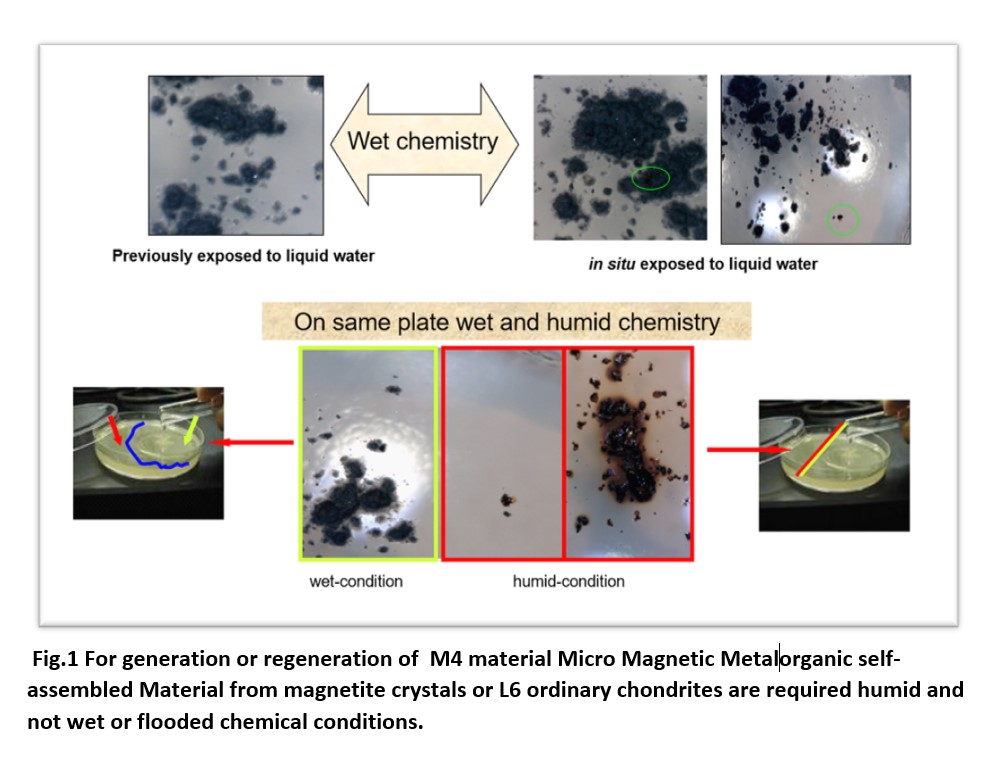
3. Summary and Conclusions
Searching for the very first instants of life on Earth, with several hypotheses in play [4], the challenge has been to replicate the conditions that could have allowed the emergence of early life to emerge. I developed a new approach to stimulate physicochemical processes that may have led to the emergence of the first life forms from inanimate matter on Earth or Earth-like planets via photo-metabolic pathways. My studies does not starts from ground zero, but provide evidence of non-enzymatic catalysis that modifies sugars, aminoacids, urea and other molecules produced in the prebiotic environments on the planets or satellites of our solar system by investigating the effect of physico-chemical stress on the formation of the metal-organic material M4 [3].
References
[1] del Gaudio, R.: Understanding the key requirement and the conditions that sparked life on Earth and beyond:clues and new knowledges supporting MuGeRo hypothesis., Europlanet Science Congress 2020, online, https://doi.org/10.5194/epsc2020-167, 2020.
[2] del Gaudio, R.: Transition from Non-living to living Matter: can integration of MuGeRo hypothesis and synthetic prebiotic biology laboratory approach shed light on the origin of Life? , Europlanet Science Congress 2021, online, 13–24 Sep 2021, EPSC2021-347, https://doi.org/10.5194/epsc2021-347, 2021.
[3] Geraci, G., D’Argenio, B., del Gaudio R. Patent US9328337 B2, granted, 2016.
[4] Bartlett, S. and Wong, L., Defining Lyfe in the Universe: From Three Privileged Functions to Four Pillars Life 2020, 10(4), 42; https://doi.org/10.3390/life10040042
How to cite: del Gaudio, R.: From molecular simplicity to the emergent complexity of earliest life: investigating key features and the role of physicochemical periodic stress on Earth and on Earth-like planets., Europlanet Science Congress 2022, Granada, Spain, 18–23 Sep 2022, EPSC2022-299, https://doi.org/10.5194/epsc2022-299, 2022.
Since the detection of the first exoplanet orbiting a star like the Sun, the University of Geneva has been at the forefront of exoplanet research. Starting from an extensive expertise in planet detection (with radial velocity), the observatory is also now an important actor in the atmosphere characterization of exoplanets (e.g. Ehrenreich et al. 2020). Today the focus is shifting towards the atmospheric characterization of small temperate planets, such as Proxima-b and the TRAPPIST-1 planets. The university is therefore actively participating to the instruments RISTRETTO@VLT and ANDES@E-ELT which aim at characterizing the atmosphere of Proxima-b (among other goals) using a technique based on high-contrast imaging and high-resolution spectroscopy. One of the objectives of these instruments is to detect biosignatures in the atmosphere of rocky temperate planets. However, to be able to correctly identify a biosignature, one needs to be able to identify false positives. So, one needs to know how the atmosphere interacts with planetary interior, with incoming stellar radiation, and with many different other processes. A multi-disciplinary approach is therefore necessary.
Recently, and following the 2019 Nobel prize in physics attributed to Michel Mayor and Didier Queloz for the discovery of 51 Peg b, the University of Geneva decided to create a faculty center: “Centre pour la Vie dans l’Univers” in French or “Center for Life in the Universe” (https://www.unige.ch/sciences/cvu/). The members of the center include experts in astrophysics, geophysics, environmental physics, chemistry, climatology and biology. The center aims at leading interdisciplinary projects on the origin of life on Earth and the search for life in our solar system and in exoplanetary systems to contribute to the world research on fundamental questions: How did life emerge and how did it diversify on Earth? Is the Universe full of life? What is the nature of life? How can we detect life elsewhere than on Earth?
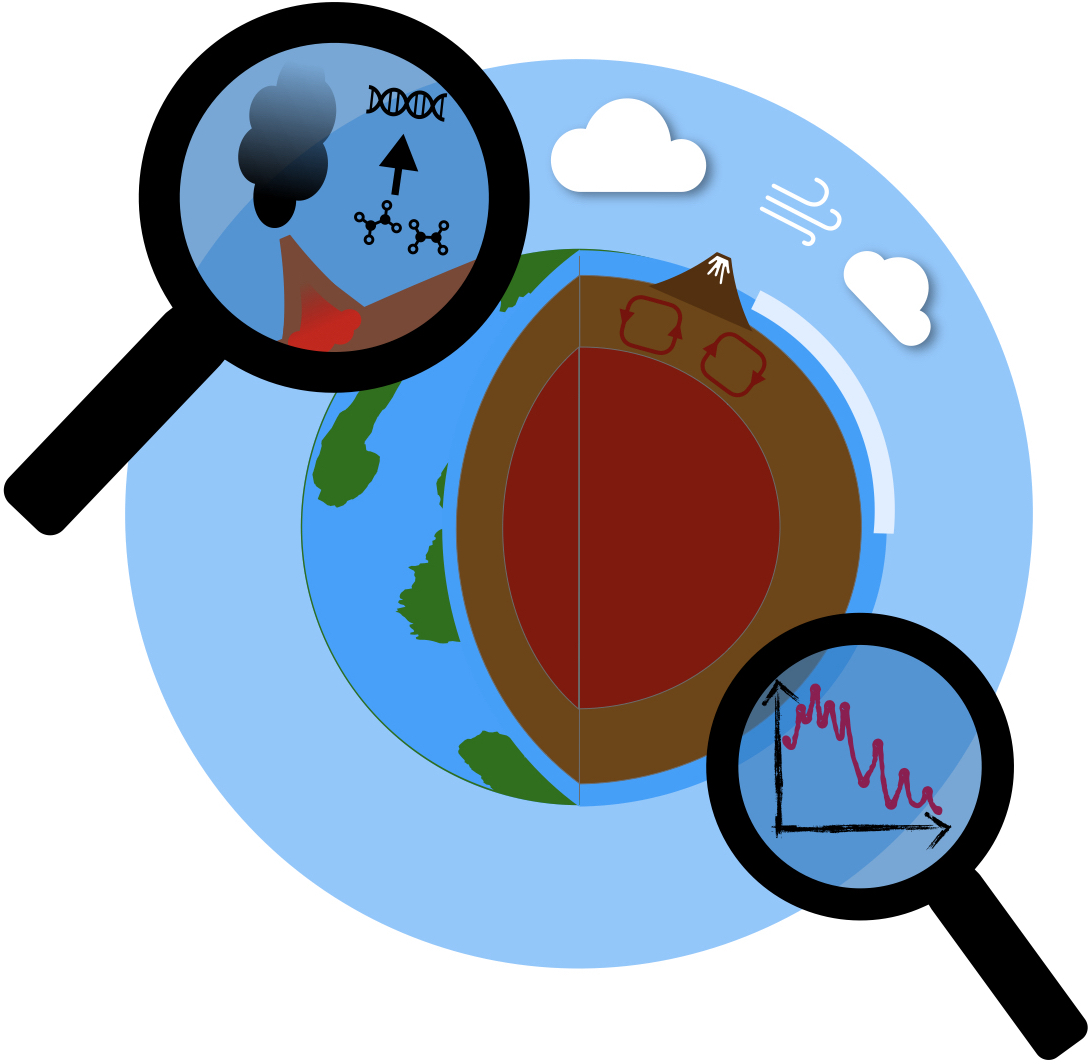
Several projects are starting and will start in the near future in the center on the following topics:
- The rise of molecular complexity on primitive Earth
- Multi-stability of climates and habitability
- Evolution under extraterrestrial conditions
- The atmosphere as a mirror for geological processes
I will present these new interdisciplinary scientific projects, with an increased focus on the second and third ones which are already underway.
How to cite: Bolmont, E., Ehrenreich, D., Kasparian, J., Ibelings, B., McGinnis, D., Winssinger, N., Caricchi, L., Castelltort, S., and Mueller, A.: From experimental evolution to climate simulations: the projects of the newly created Center for Life in Universe, Europlanet Science Congress 2022, Granada, Spain, 18–23 Sep 2022, EPSC2022-386, https://doi.org/10.5194/epsc2022-386, 2022.
We used the Planetary Spectrum Generator (PSG) [1] a radiative transfer suite, with the goal of simulating spectra from observations of Venus, Mars and Jupiter, searching for minor chemical species.
For Venus, sulphur dioxide (SO2) absorption lines were detected and its abundance constrained, by comparing simulations with observations by the Texas Echelon Cross Echelle Spectrograph (TEXES) spectrograph, around 7.4 μm [2]. The mean abundance of SO2 was constrained to 120 ppb, using the Optimal Estimation Method [3] and a line-depth ratio method [2] independently, in agreement with 50-175 ppb obtained by Encrenaz et al [2]. Phosphine (PH3) was not detected in the comparison between simulation and TEXES Infrared (IR) observations [4], around 10.5 μm, due to the presence of a strong telluric water band in the spectra.
For Mars, both a positive and a negative detection of methane were reanalyzed using PSG simulations with the goal of constraining the methane abundance. The related spectra observations in the IR, around 3.3 μm, report, respectively, to the Mars Express (MEx) [5] and ExoMars [6] space-probes.
For Jupiter, the detection of ammonia, phosphine, deuterated methane and methane was studied, by comparing simulations with IR observations by the Infrared Space Observatory (ISO), around 7-12 μm. [7]. The next step is focused in the determination of the abundances of the previous species. Independent simulations will be performed using PSG and the NEMESIS state-of-the-art radiative transfer suite [8]
Funding: This research was funded by the Portuguese Fundacao Para a Ciencia e Tecnologia under project P-TUGA Ref. PTDC/FIS-AST/29942/2017 through national funds and by FEDER through COMPETE 2020 (Ref. POCI-01-0145 FEDER-007672).
Aknowledgments: We credit Thérèse Encrenaz, from LESIA, Observatoire de Paris, for all the support and fruitful discussion; Geronimo Villanueva, from NASA-Goddard Space Flight Center, for discussing issues regarding PSG; Marco Giuranna, PI of the PFS instrument of Mars Express (ESA), Alejandro Cardesín, from ESAC-ESA, Ann Carine Vandaele, PI of the NOMAD instrument of ExoMars (ESA) and Séverine Robert, from the ExoMars team, for all the support regarding Mars dedicated research; Gabriella Gilli (IAA), for the collaboration regarding the LMD-VGCM model; Patrick Irwin, from the University of Oxford (UK), for the collaboration under the NEMESIS radiative transfer code; Asier Munguira, from the University of the Basque Country, for his availability to discuss atmospheric research methods in the context of the present work.
References
[1] Villanueva et al. 2018, Journal of Quantitative Spectroscopy and Radiative Transfer
[2] Encrenaz et al. 2012; Astronomy & Astrophysics
[3] C. D. Rodgers. Inverse methods for atmospheric sounding: theory and practice. World Scientific, 2008
[4] Encrenaz et al. 2020; Astronomy & Astrophysics.
[5] Giuranna et al. 2019; Nature
[6] Korablev et al. 2019.; Nature
[7] Encrenaz et al. 1999 ; Planetary and Space Science
[8] Irwin et al. 2008 ; Journal Of Quantitative Spectroscopy And Radiative Transfer
How to cite: Dias, J., Machado, P., Ribeiro, J., and Freire, C.: Atmospheric evolution and the search for species of astrobiological interest in the Solar System – Case Studies using the Planetary Spectrum Generator, Europlanet Science Congress 2022, Granada, Spain, 18–23 Sep 2022, EPSC2022-437, https://doi.org/10.5194/epsc2022-437, 2022.
Introduction
A planet that harbor water in a liquid state becomes as a study subject for its habitability evaluation. Water is the only known solvent in which the reactions for life as we know it take place, while is also a sink of molecules that include bio-essential elements such as carbon.
On Earth, oceans are reservoirs of CO2 and CH4 and, along with other molecules (H2S, N2, etc.) may be encapsulated in minerals of clathrate hydrates (thereafter clathrates) under high pressure and low temperature conditions [1]. Water molecules begin to arrange in space and join through hydrogen bonds, constructing a tridimensional crystal network that host gases inside by the van der Waals interaction forces [2]. This physical and chemical conditions required for clathrate deposits formation are found on Earth in continental margins and polar regions [3].
On Europa and Enceladus moons, clathrate deposits would not only be found in the seafloor, but also floating into oceans [4, 5, 6]. On Titan, as well as on Europa, they might form part of the composition of water-ice crust [7, 8], whereas on Ganymede and Pluto they may constitute some global layers of its internal structure [9, 10].
Clathrate formation and dissociation would play a role in geological processes and, above all, in (bio)-geochemical cycles of these planetary bodies. As clathrates are sinks of carbon and other chemical elements essential for life, the dissociation of these minerals by changes in physical chemical conditions would release gases into Europan and Enceladus´ oceans, enabling to promote favourable conditions for development of a hypothetical chemolithoautotrophic life [11]. However, gases could also be sequestrated again as carbonates or another salts due to reactions between them and rocky core in the water-rock interphase.
On Earth, encapsulated gases into clathrate structure may be metabolized by organotrophs [15] and/or by a consortium of methanotrophic archaea and sulfate-reducing bacteria after its dissociation [11, 16]. As a consequence carbonate precipitates, known as clathrite [17] because it records the past presence of these deposits. The aim of this study is to simulate the abiotic clathrite formation process under ocean-world-environmental-conditions when there are calcium saturation during clathrate formation and dissociation.
Methodology
For the experiments, we used a high-pressure simulation chamber made of stainless steel (volume capacity 67 ml) which is connected to a tank of CO2 (gas). It is coupled with a thermocouple and pressure sensor to monitor temperature and pressure parameters and with a Raman spectrometer to analyse phase changes. We filled the high-pressure cell with crushed ice made of 7.4 wt% Ca(OH)2 dissolution. The chamber was pressurized at 30 bar and then temperature was reduced down to 260 K. Once CO2 clathrates were formed, the chamber was heated slowly up to 284 K. We studied the synthesis process of clathrite, taking in situ Raman spectra with a 532 nm laser at every pressure and temperature change.
Results
Carbonate precipitation occurred since CO2 was injected to the chamber. The final product phase obtained was calcite. Nevertheless, during experiment of clathrate formation and dissociation, carbonate structure took diverse polymorphs of calcium carbonate different from pure calcite, aragonite and vaterite structures. This was evidenced by the spectral signature within the ranges of 1069.42-1087.75 cm-1 and 709.26-731.94 cm-1 for stretching and bending vibration of the CO32- ion respectively and 150.30-160.62 cm-1, 194.17-211.97 cm-1 and 280.03-289.94 cm-1 for lattice modes.
Acknowledgments
We thank project PID2019-107442RB-C32 funded by MINECO. Ana de Dios is supported by the AEI pre-doctoral contract under the project MDM-2017-0737-19-1.
References
[1] Rajput and Thakur (2016) in Geological Controls for Gas Hydrates and Unconventionals, Elsevier. [2] Sloan (1998) in Clathrate hydrates of natural gases, CRC Press. [3] Ruppel and Kessler (2017) Rev. Geophys., 55, 126-168. [4] Bouquet et al. (2015) Geophys. Res. Lett., 42, 1334-1339. [5] Prieto-Ballesteros et al. (2005) Icarus, 177, 491-505. [6] Boström et al. (2021) Astron. Astrophys. 650:A54. [7] Choukroun et al. (2010) Icarus, 205, 581-593. [8] Bouquet et al. (2019) ApJ, 855 (14). [9] Izquierdo-Ruiz et al. (2020) ACS Earth Space Chem., 4 (11), 2121-2128. [10] Kamata et al. (2019) Nat. Geosci., 12, 407-410. [11] Carrizo (2022) Astrobiology, 22 (5), DOI:10.1089/ast.2021.0036. [12] Choukroun et al. (2010) Icarus, 205, 581-593. [13] Fagents (2003) J. Geophys. Res., 108, 5139. [14] Bouquet et al. (2015) Geophys. Res. Lett., 42, 1334-1339. [15] Snyder et al. (2020) Sci. Rep., 10, 1876. [16] Bohrmann et al. (2002) Proc. Fourth Int. Conf. Gas Hydrates, Yokohama, Japan, 102-107. [17] Kennet and Fackler-Adams (2000) Geology, 28, 215-218. [18] Wehrmeister et al. (2007) J. Gemmol., 37(5/6), 269-276. [19] Eaton-Magaña et al. (2021) Minerals, 11, 177. [20] Chen et al. (2015) Chem. Eng. Sci., 138, 706-711.
How to cite: de Dios Cubillas, A., Muñoz Iglesias, V., and Prieto Ballesteros, O.: Abiotic clathrite synthesis from CO2-clathrate under ocean world conditions, Europlanet Science Congress 2022, Granada, Spain, 18–23 Sep 2022, EPSC2022-544, https://doi.org/10.5194/epsc2022-544, 2022.
Intro
Kerogen is insoluble, macromolecular organic matter in sedimentary rocks. Kerogen is highly abundant on Earth, making this subsurface carbon reservoir larger than any single surface carbon reservoir. Based on the origin of the organic matter, four types of kerogens are distinguished, with each their own chemical composition (Fig. 1). Type 1 is derived from fresh water algae, type 2 from marine algae, type 3 from terrestrial vascular plants, and type 4 is partially decomposed organic matter. Next to the abundance of kerogens on Earth, kerogens also comprise 70% of the organic material in carbonaceous chondrites (Sephton, 2002), and similar macromolecular organics have been discovered on the surface of Mars (Eigenbrode et al., 2018). As kerogens consist of large, insoluble, non-hydrolysable complexes (>1kDa), they are difficult for many microorganisms to access as an energy or carbon source (Vandenbroucke, 2003; Petsch et al., 2001). On the contrary, macromolecular organic material had been shown to be inhibitory to biofilms through occlusion of the biofilm surface (Freeman and Lock, 1992).
There is little understanding in the interaction of microorganisms with macromolecular, kerogenous material. This understanding is important as kerogenous material is a large carbon reservoir on Earth, and microbial degradation could impact the global carbon cycle with influences for climate change. Further, as kerogenous material is highly abundant in carbonaceous chondrites, and macromolecular material has been found on the surface of Mars, potential microbial usage of this material could have astrobiological implications. A proxy for extraterrestrial macromolecular, kerogenous material is kerogen embedded in rocks on Earth. In this research, we investigated the influence of each of the four kerogen types in rocks on the growth of an anaerobic microbial community.
Methods
An anaerobic microbial community capable of growth with a carbonaceous chondrite as the sole carbon and energy source as described in Waajen et al. (2022) was used. This community was grown for 11 days in microcosms containing liquid M9 medium with acetate and powdered rocks. Four types of rocks were tested, either shale or coal, with each rock sample containing one of the four kerogen types. At the end of the growth period, the community composition was determined by 16S amplicon sequencing. We also investigated the production of CO2, CH4 and H2 in the microcosms.
Results and discussion
Kerogen type 1 and 2 enhanced microbial growth to some extent. The microbial community composition did not change in the presence of kerogen type 1, but did change significantly during growth on kerogen type 2. This indicates that the growth of only a subset of the microbial community was enhanced by the presence of kerogen type 2, while another part of the community was not. We are currently investigating the metabolisms present in these environments, which could give an indication as to which compounds in these rocks will have influenced the growth of the community.
Kerogen type 3 did not enhance microbial growth, which could be explained by the abundancy of phenols in this type of kerogen. Phenols can be inhibiting in higher concentrations (Van Schie and Young, 1998).
Since this community has already been shown to grow on carbonaceous chondrite, growth enhancement on kerogen type 4 was to be expected, since this type is the closest analogue to macromolecular organics in meteorites (Matthewman et al., 2013). However, the community changed significantly during the growth in the presence of kerogen type 4, indicating that there are still significant differences between these environments. Further, kerogen type 4 is considered the most inert type of kerogen, containing mainly consisting polycyclic aromatic hydrocarbons (PAHs). Small PAHs can be degraded by microorganisms (Bamforth and Singleton, 2005), but it remains unknown whether the larger PAHs that are found in space can be used by microorganisms.
In addition to kerogens, shales and coal contain a small fraction of soluble organic material that could have been used by the microorganisms. Other compounds in shales and coals, such as metals, could also have influenced microbial growth. Further investigation in the type of material accessed by the microorganisms is needed to understand whether inert material from this type of kerogen can be microbially degraded.
No biological H2, CO2 or CH4 production was observed, which could be caused by the absence of certain metabolisms, or the direct consumption of these gases by other microorganisms. Alternatively, the low concentration of microorganisms in the microcosms could also have resulted in the lack of an observable production of these gases. We are currently analysing microbial community composition to indicate the presence of metabolisms which could produce these gases.
The potential of kerogenous material enhancing microbial growth has implications for the potential of life on Mars and in the presence of meteorites. The enhancement would indicate that the presence of macromolecular organic material in these environments would increase the habitability of these environments. Additionally, the potential degradation of kerogens has implications for carbon cycling on Earth, with the potential of the degradation of a large carbon reservoir. The entry of this stored carbon to the carbon cycle would have a large impact on climate change and should be further investigated.
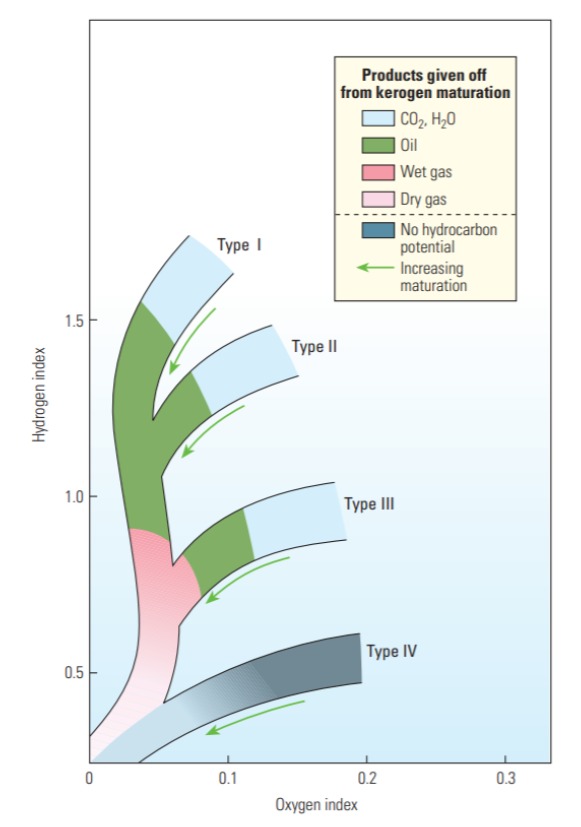
Figure 1: Chemical characteristics of the four kerogen types indicating the thermal maturation and products that can be given off for human oil and gas use. The hydrogen index is the H/C ratio, the oxygen index is the O/C ratio. Taken from McCarthy et al., 2011.
References
References
Bamforth et al., Journal of Chemical Technology & Biotechnology (2005).
Eigenbrode et al., Science (2018).
Freeman et al., Applied and Environmental Microbiology (1992).
Matthewman et al., Astrobiology (2013).
McCarthy et al., Oilfield Review (2011).
Petsch et al., Science (2001).
Sephton, Natural product reports (2002).
Vandenbroucke, Oil & gas science and technology (2003).
Van Schie et al., Applied and environmental microbiology (1998).
Waajen et al., Astrobiology (2022).
How to cite: Waajen, A. C., de Wit, W., Edgar, J. O., Telling, J., and Cockell, C. S.: Different forms of kerogenous carbon shape the growth and composition of anaerobic microbial communities, Europlanet Science Congress 2022, Granada, Spain, 18–23 Sep 2022, EPSC2022-1108, https://doi.org/10.5194/epsc2022-1108, 2022.
Introduction
In environments where it is difficult for life to function, microbial organisms tend to inhabit pockets of locally favorable climatic conditions. Micro-climates conducive to the persistence of life in an otherwise inhospitable environment – “refugia” – are spatially restricted and can be < centimeters in extent [1], [2]. Refugia may have been (and perhaps still are) perennially prevalent on Mars where conditions were likely never globally favorable to life for sustained periods of time [3]. The tendency for refugia to be small means that it may be difficult to locate features that could have served (or perhaps still do serve) as refugia for microorganisms on Mars. The spatial distribution of refugia in extreme environments across larger geographic extents is often non-random and may depend on many factors, biotic and abiotic [4]–[6]. Understanding patterns that refugia follow across larger geographic contexts as well as particular geologic phenomena (e.g., volcanic vents, dikes, stress fields) that are commonly associated with refugia may provide a way to infer regions of astrobiological interest, even if the specific, small, habitable patches (refugia) are below the resolving power of orbital instruments [6]. Here, we explore a case study of two terrestrial habitats in salt-encrusted paleo-lake basins (salars) in the Atacama and Altiplano of Chile to assess their characteristics and what factors are common between them. The Neogene salars of the Atacama and Altiplano are perhaps the best analogs on Earth for the Noachian/Hesperian salt-encrusted paleo-lakes of Mars [4], [7]–[12].
Evaporite habitats at Salar Grande and Salar de Pajonales
Salar Grande hosts decimeter scale nodules made of halite that serve as refugia for endolithic microbes [9]. [1] proposed a model to describe the evolution of nodules in halite-encrusted salars at the edges of polygonal features. To briefly summarize their model, halite nodules initiate at polygon edges in a salar with active ground water. Growth continues after ground water activity ceases as winds drive a moisture gradient, along which brines travel, toward the apex of the relatively higher relief nodules where more halite is deposited (Fig 1). The action of brines in halite nodules generates porosity at multiple spatial scales (nanometers to millimeters), contributing positively to their habitability [1].
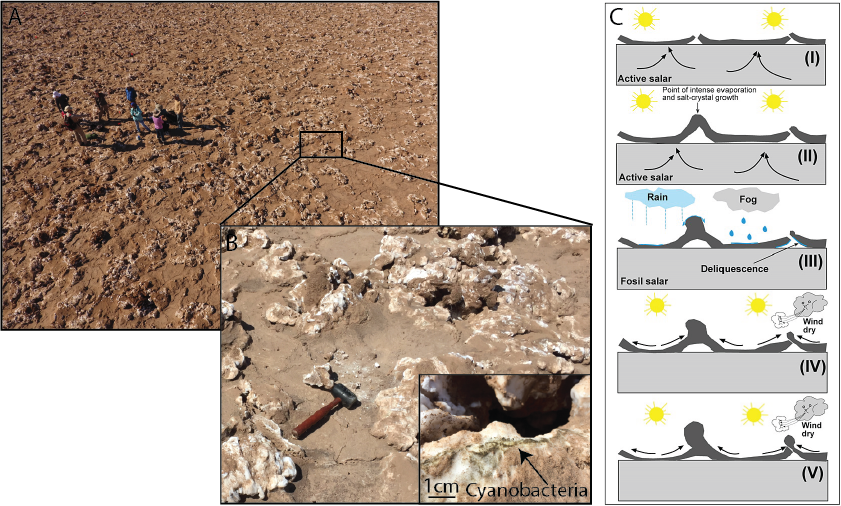
Fig. 1 Halite nodules at Salar Grande. A) Drone-view of nodules and nodule clusters. Humans for scale. B) Close up of halite nodule showing endolithic community. C) Halite nodule evolution from [1].
Like Salar Grande, Salar de Pajonales hosts endoliths in refugia habitats. In a gypsum-covered region of Salar de Pajonales, alabaster (a high-porosity polymorph of gypsum) is the most reliable indicator for the presence of life [4]. Alabaster refugia are most commonly found associated with decimeter- to meter-tall ridges and domes [6], [10]. The domes and ridges form via water-related processes: hydration/dehydration cycles, volume changes associated with mineral precipitation from brines, and/or efflorescence deliquescence [10]. The formation of alabaster is likely predicated on the action of the near-surface water that drives the formation of ridges and domes (Fig. 2), though microbial activity may play a role as well [4]. Therefore, at Salar de Pajonales water activity generates positive topographic salt constructs and physiochemical changes to gypsum (formation of high-porosity alabaster) that foster an environment favorable to life.
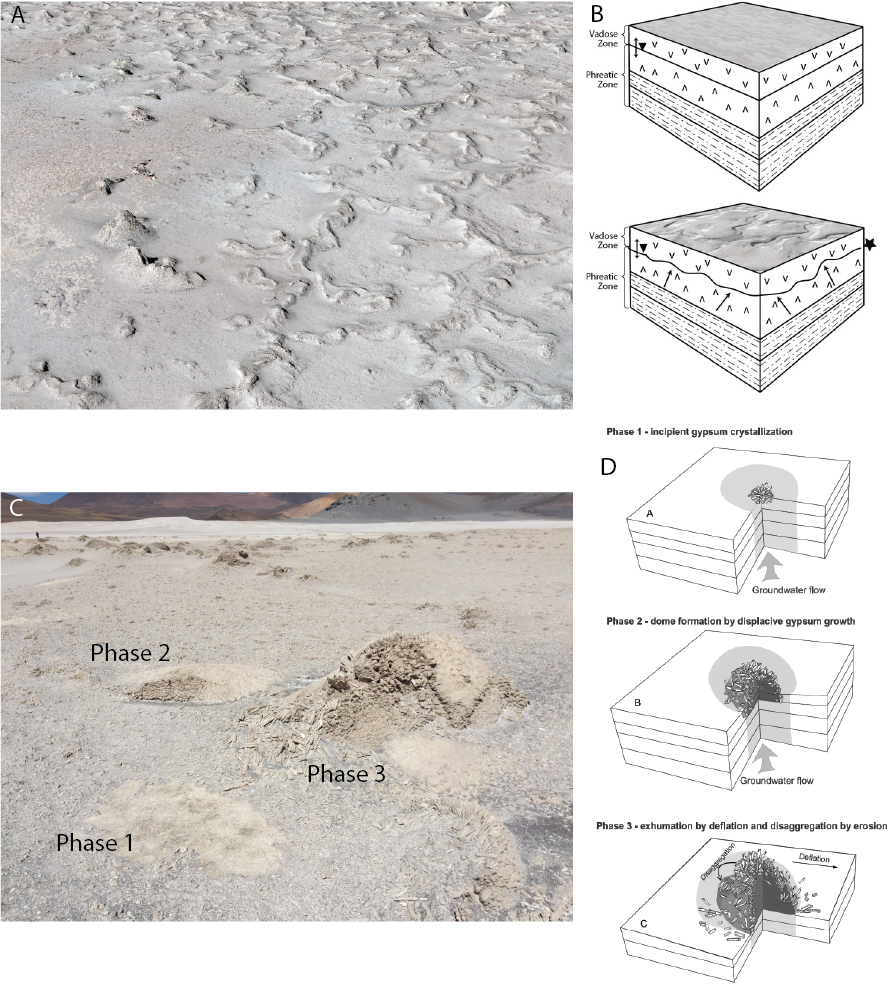
Fig. 2 Models of ridge and dome formation at SdP. A) Drone-perspective view of ridges at SdP. B) Model for ridge formation from [10] involving volume change at the phreatic-vadose zone interface. C) Image of domes at SdP in different stages of development. D) Possible model of gyspsum dome formation from [16].
Discussion
Across two salt-encrusted environments, one in the Atacama and the other in the Altiplano, with distinct evaporite mineralogy (halite versus gypsum), the activity of water resulted in decimeter- to meter-tall topographic constructs with nanometer- to millimeter-scale porosity conducive to the persistence of endoliths. We hypothesize that decimeter- to meter-tall topographic constructs (as opposed to erosional remnants or boulders) may be general indicators for relatively enhanced habitability in salt-encrusted paleo-lake basins because they require water to form. Although refugia – such as the precise location of endoliths in halite nodules or alabaster in gypsum domes and ridges – may not be observable from orbit, decimeter- to meter-scale salt constructs may be possible to identify with HiRISE or future orbital imagers with higher resolving power [6]. Chloride basins should be the targets of high-resolution imaging campaigns and efforts should be made to distinguish salt constructs from erosional remnants, boulders, and other relative topographic highs with which they could be confused. Salt constructs may be one of the few features, other than (fossil) hydrothermal vents, that have a high potential to both host and preserve microbial organisms, and that are specific targets, possibly identifiable from orbit, to which a rover could be driven. These characteristics make them attractive targets for future missions to Mars.
Reference:
[1] O. Artieda et al., 2015, doi: 10.1002/esp.3771.
[2] L. Hays, “NASA Astrobiology Strategy.” 2015.
[3] R. Wordsworth et al., 2021, doi: 10.1038/s41561-021-00701-8.
[4] K. Warren-Rhodes et al., Nature Astronomy. in review.
[5] M. S. Phillips et al., Astrobiology, in review.
[6] K. A. Warren-Rhodes et al., 2019. doi: 10.3389/fmicb.2019.00069.
[7] M. M. Osterloo, et al., 2010, doi: 10.1029/2010JE003613.
[8] T. D. Glotch, et al., 2016, doi: 10.1002/2015JE004921.
[9] A. F. Davila et al., 2008, doi: 10.1029/2007JG000561.
[10] N. W. Hinman et al., 2022, https://www.frontiersin.org/article/10.3389/fspas.2021.797591
[11] N. A. Cabrol et al., 2007, doi: 10.1029/2006JG000298.
[12] E. K. Leask and B. L. Ehlmann, 2022, doi: 10.1029/2021AV000534.
[13] A. Szynkiewicz, et al., JGR, vol. 115, 2010.
How to cite: Phillips, M., Warren-Rhodes, K., Hinman, N., Moersch, J., Hofmann, M., McInenly, M., Davila, A., and Cabrol, N.: Salt constructs in paleo-lake basins as high-priority astrobiology targets., Europlanet Science Congress 2022, Granada, Spain, 18–23 Sep 2022, EPSC2022-1188, https://doi.org/10.5194/epsc2022-1188, 2022.
Molecular oxygen (O2) paired with a reducing gas is regarded as a promising biosignature pair for atmospheric characterization of terrestrial exoplanets. In circumstances when O2 may not be detectable in a planetary atmosphere (for instance, at mid-IR wavelengths) it has been suggested that O3, the photochemical product of O2, could be used as a proxy to infer the presence of O2. While O3 is not directly produced by life, it plays an important role in habitability as the ozone layer is the primary source of UV shielding for surface life on modern Earth. However, O3 production is known to have a nonlinear dependence on O2, as well as being strongly influenced by the UV spectrum of the host star. To evaluate the reliability of O3 as a proxy for O2 we used Atmos, a 1D coupled climate/photochemistry code, to study the O2-O3 relationship for "Earth-like'' habitable zone planets around a variety of stellar hosts (G0V-M5V) for O2 abundances from 0.01%-150% of the Present Atmospheric Level (PAL) on modern Earth. We studied how O3 emission features for these planetary atmospheres varied for different O2 and O3 abundances using the radiative transfer code PICASO. Overall we found that the O2-O3 relationship differed significantly around different stellar hosts, with different trends for hotter stars (G0V-K2V) than cooler stars (K5V-M5V). Planets orbiting hotter host stars experience an increase in O3 when O2 levels are initially decreased from the present atmospheric level, with maximum O3 abundance occurring at 25-55% PAL O2. Although this effect may seem counterintuitive, it is due to the pressure dependency on O3 production, as with less atmospheric O2 incoming UV photons capable of O2 photolysis are able to reach lower (denser) regions of the atmosphere to spark O3 formation. This effect is not present for planets orbiting our cooler host stars (K5V-M5V), as the weaker incident UV flux (especially FUV flux) does not allow O3 formation to occur at dense enough regions of the atmosphere such that the faster O3 production outweighs a smaller source of O2 from which to create O3. As a result, for cooler host stars the O3 abundance decreases as O2 decreases, albeit nonlinearly. Interpretation of O3 emission spectral features was found to require knowledge of the atmosphere’s temperature profiles -particularly the temperature differences between the planetary surface and stratospheric temperature- which are highly influenced by the amount of stratospheric O3. Planets experiencing higher amounts of incident UV have more efficient O3 production and UV absorption leading to larger stratospheric temperature inversions, and therefore shallower emission features. Overall it will be extremely difficult (or impossible) to infer precise O2 levels from an O3 measurement, however, with information about the UV spectrum of the host star and context clues, O3 will provide valuable information about potential surface habitability of an exoplanet.
How to cite: Kozakis, T., Mendonça, J. M., and Buchhave, L. A.: Is ozone a reliable proxy for molecular oxygen?, Europlanet Science Congress 2022, Granada, Spain, 18–23 Sep 2022, EPSC2022-1267, https://doi.org/10.5194/epsc2022-1267, 2022.
TP17 | Planetary field analogues for Space Research
1 Introduction
The Finnish Meteorological Institute (FMI) has developed relative humidity instruments for several Mars lander missions. Calibration of these instruments can be challenging due to the required temperature, pressure and humidity conditions that can be reliably simulated by only a few laboratories. Humidity measurements in Martian conditions have been previously performed for these instruments in the FMI’s laboratory and the Michigan Mars Environmental Chamber (MMEC) at the University of Michigan. A new measurement campaign was performed at the Planetary Analog Simulation Laboratory (PASLAB) of the German Aerospace Center (DLR) during autumn 2020 and spring 2021. The campaign included three ground reference models (REF) of FMI’s relative humidity instruments: REMS-H of the MSL Curiosity rover [1], MEDA HS of the Mars 2020 Perseverance rover [2] and METEO-H developed for the ExoMars 2022 surface platform [3]. All three instruments are based on HUMICAP® capacitive thin-film polymer sensors by Vaisala as well as Vaisala’s ASIC technology. REMS-H has three HUMICAP sensor heads, while MEDA HS and METEO-H both contain two newer types of HUMICAP sensors which provide a larger dynamic capacitance range and include integrated resistive PT1000 sensors for measuring the temperature of the sensor head. The REF models of each instrument are identical to the flight models and have gone through testing and calibration campaigns at FMI together with the flight models.
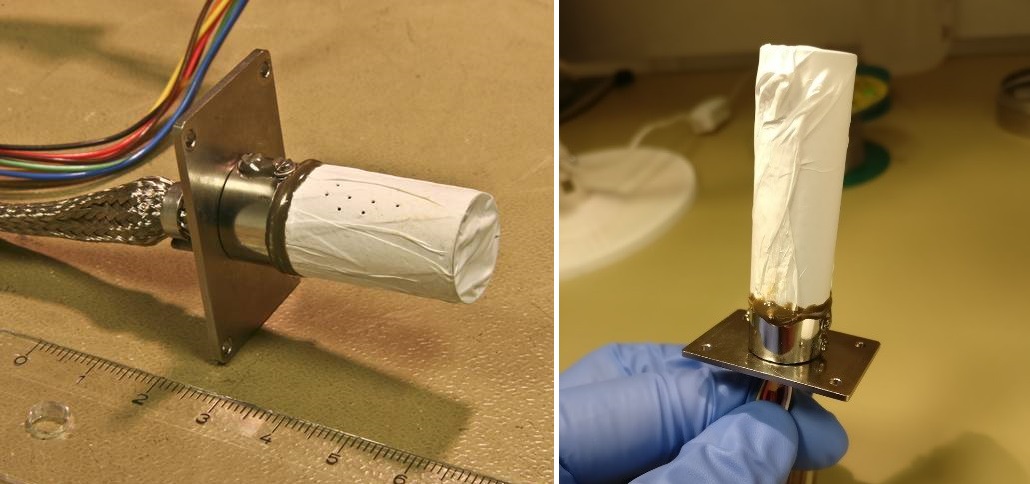
Figure 1: REMS-H (left) of the MSL Curiosity rover and MEDA HS (right) of the M2020 Perseverance rover. METEO-H for ExoMars 2022 is identical to MEDA HS. The electronics and sensor heads are located on a PCB inside a cylindrical Faraday shield. The Faraday shield is covered with PTFE membrane filter to protect the sensor from dust.
The main purpose of the measurement campaign at the DLR was to obtain calibration data in multiple humidity points in CO2 within the instruments’ operational temperature and pressure ranges. The instruments have been calibrated at the FMI using two humidity points in CO2, resulting in satisfactory quality but a notable calibration uncertainty. The new multi-point data are used for complementing the calibration of MEDA HS and METEO-H flight models, as well as to check REMS-H calibration.
2 Test setup
The DLR PASLAB facility, designed to simulate Martian near-surface atmospheric conditions, is used for habitability-related investigations and sensor studies [4][5]. In this measurement campaign the environmental conditions were controlled in terms of gas type, pressure, temperature and relative humidity. The setup is described in Figure 2. The instruments were enclosed in the same measurement chamber as has been used in the FMI’s laboratory (see Figure 3), and the chamber was connected to the environmental control system. As part of the DLR’s own experiment, another chamber with humidity sensors was connected to the system for simultaneous measurements, with one sensor also placed inside the FMI’s chamber for comparison.
The measurements were performed at stable temperature points between -70 °C and -30 °C and pressure points ranging from 5.7 hPa to 9.8 hPa in CO2 gas. At each temperature and pressure combination, a sequence of stable humidity points was run by an automatic program, increasing the humidity in steps from the driest point to the highest humidity and back. Some continuous measurements were also performed in changing humidity. At the end of the campaign, a different gas mixture imitating the true Martian atmospheric composition was tested to investigate possible effects on the sensor behavior.
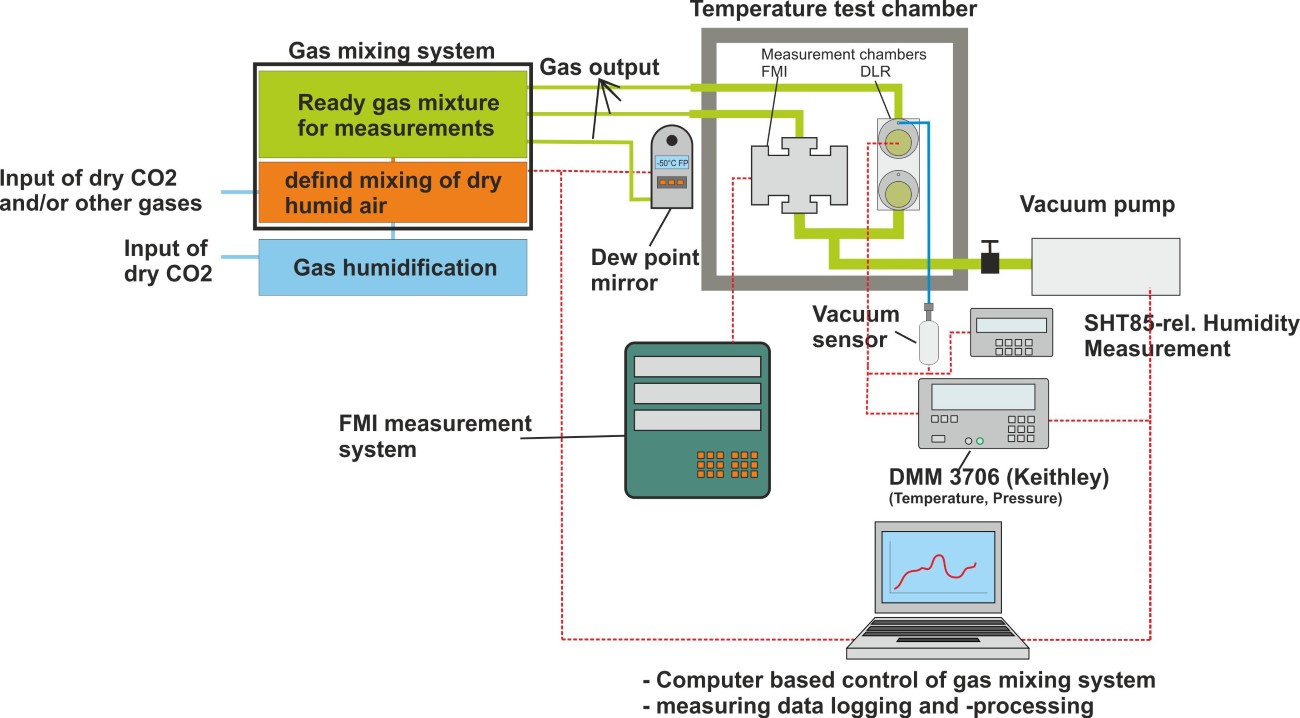
Figure 2: Setup of the environmental control and measurement system at the DLR PASLAB. Credit: DLR.
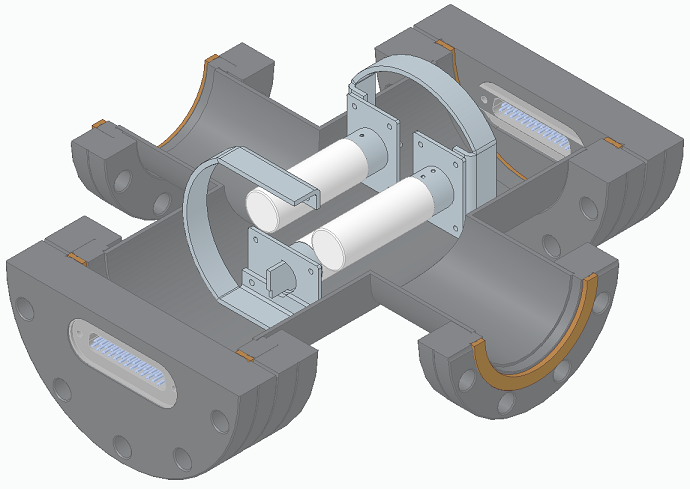
Figure 3: Cutaway illustration of the measurement chamber with the three FMI's ground reference models inside.
3 Campaign outcome
The measurement campaign was completed in May 2021 with successful outcomes. All planned temperature and pressure combinations were performed once or twice with a sufficient range of humidity points. However, at -30 °C temperature only points up to about 30 %rh could be achieved due to system limitations. We obtained a comprehensive set of stable humidity point data for each of the humidity sensors, as well as some data in changing humidity. Figure 4 shows the stable humidity points measured by one HUMICAP sensor from each instrument. The results are as expected: the temperature dependence is observed as a clear spread of capacitance readings and the pressure effect as a slight dispersion. Using the Martian-like gas composition did not seem to affect the sensor behavior compared to pure CO2.
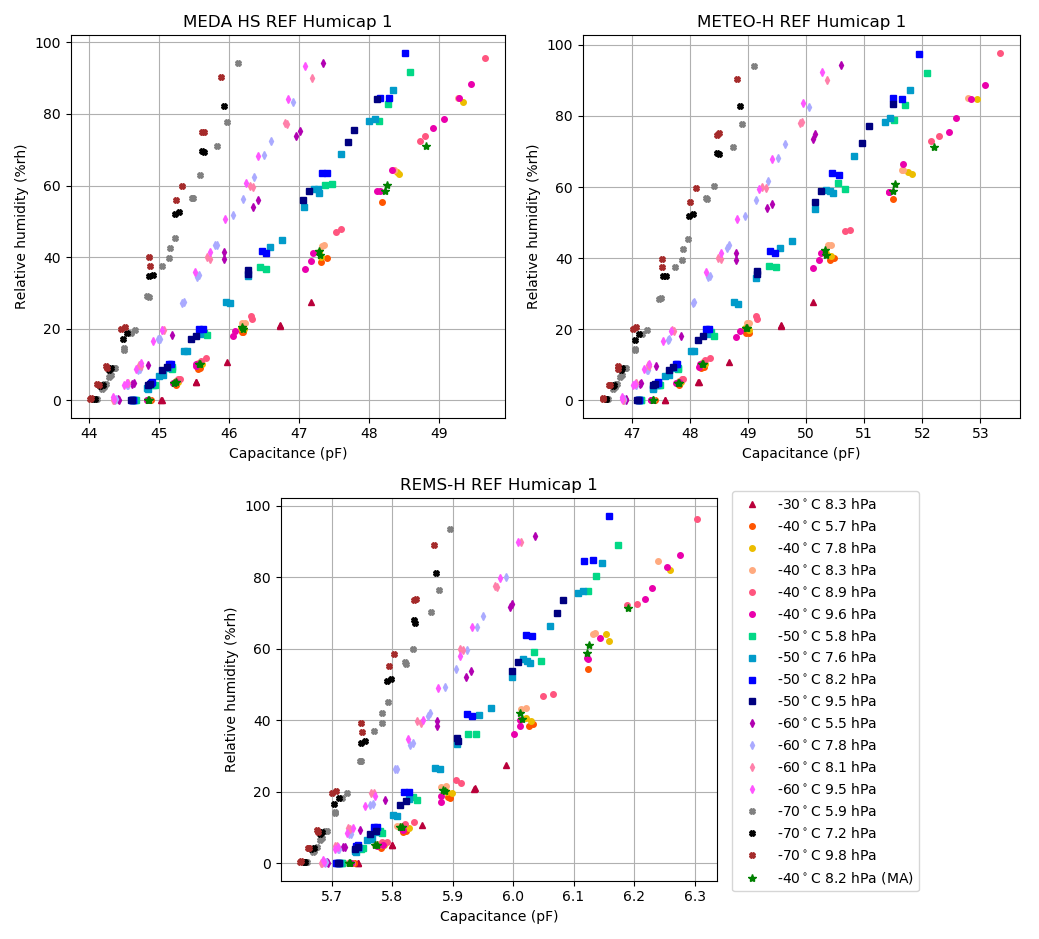
Figure 4: Selected measurement points in different temperature and pressure combinations shown for one HUMICAP sensor of each REF model: MEDA HS (upper left), METEO-H (upper right) and REMS-H (lower center). The y-axis represents the reference relative humidity in the measurement chamber and the x-axis the sensor output capacitance. Measurements in the Martian atmospheric gas composition are marked with green stars.
4 Conclusions
The humidity measurement campaign at the DLR PASLAB was performed between September 2020 and May 2021. As an outcome we obtained valuable datasets for MEDA HS, METEO-H and REMS-H ground reference models consisting of multiple relative humidity points over the sensors’ range from 0 %rh to 100 %rh in low pressure CO2. The results were in line with previous laboratory measurements of these instruments.
References
[1] Harri, A.-M. et al.: Mars Science Laboratory relative humidity observations: Initial results. J Geophys Res Planets 119, 2132–2147 (2014).
[2] Rodriguez-Manfredi, J.A. et al.: The Mars Environmental Dynamics Analyzer, MEDA. A suite of environmental sensors for the Mars 2020 mission. Space Sci Rev 217:3, 48 (2021).
[3] Vago, J. et al.: ESA ExoMars program: The next step in exploring Mars. Sol Syst Res 49, 518-528 (2015).
[4] Lorek A. and Koncz A.: Simulation and measurement of extraterrestrial conditions for experiments on habitability with respect to Mars. In Habitability of Other Planets and Satellites, vol. 28, 145–162 (2013).
[5] Lorek A. and Majewski J.: Humidity measurement in carbon dioxide with capacitive humidity sensors at low temperature and pressure. Sensors 18. (2018).
How to cite: Jaakonaho, I., Hieta, M., Genzer, M., Polkko, J., Lorek, A., Garland, S., de Vera, J.-P., and Harri, A.-M.: Relative humidity laboratory measurements in Martian atmospheric conditions, Europlanet Science Congress 2022, Granada, Spain, 18–23 Sep 2022, EPSC2022-819, https://doi.org/10.5194/epsc2022-819, 2022.
Introduction
Sedimentary deposits developed in High-Altitude Andean Lakes (HAAL) share some extreme and environmental characteristics that made them excellent analogues for planetary geology and astrobiology research. These conditions favor the development of a diverse and abundant microbial biota that influence mineral precipitation (e.g. carbonates) and the develpoment of microbially influenced sedimentary deposits typically know as stromatolites. To recognize and differentiate stromatolites from similar laminated deposits purelly formed by chemical processes is not straightforward, and Archean stromatolites are a good example. This makes HAAL good environmental analogues to study microbe-mineral proceeses, and the associated biosignatures. The recent findings of putative marginal lacustrine and delta deposits in the Jezero crater on Mars surface highlight the potential of these systems from and astrobiology perspective. The origin and characteristics of these martian carbonates is still unknown so the evaluation potential scenarios in comparable environmental conditions may shed some light into this uncertainties.
The Laguna Negra (a high altitude lake in Catamarca Province, Argentina) is an outstaning example of HAAL where an active microbial mat system and associated carbonate deposits is well developed. These are located in the mixing zone between groundwater spring-fed pools and the main lacustrine system. The Laguna Negra is a unique natural laboratory that fulfills the environmental criteria suggested for early Earth (Archean) and Mars (Noachian) where spectrum of biotic and abiotic process can be studied improving our ability to interpret the sedimentary record on our planet and beyond.
Geological setting
The Laguna Negra is a shallow hypersaline lake where the pH of the main lake and the groundwater springs feeding the lake fluctuates between ~6 and ~8 and salinity between ~320 and ~9 ppt respectively. The mixing zone between the main lake and groundwater is oversaturated with respect to calcite and aragonite. The carbonate belt consists of oncoids, stromatolites, and laminar crusts that are spatially localized in different zones and associated to different microbial mats systems and chemical conditions. Particularly interesting are the laminar crusts, developed in a zone where no significant microbial mats has been observed, but where a diversity of morphologies and microtextures has been recorded. Although interpreted as purelly chemically precipitated, unravelling the different processes that controls this morphological varibality is still challenging.
Oncoids, Stromatolites and Laminar crusts
Oncoids represented by concentrically laminated discs, spheres, and flattened domes (cm to dm in diameter) that can coalesce to form more complex structures and are typically associated with well-stratified diatom-rich microbial mats. The external surface surface can be smooth or can show pillar-like to shrub-shaped millimeter scale protrusions and ornamentations, particularly on the side affected by wind and currents. Oncoids are partially buried and can show lateral protrusions at the sediment–water and the air–water interface. Although oncoids are sub-spherical in shape, they can show asymmetric growth (bigger below the sediment–water interface). Complex lamination is also a result of oncoid rotation, particularly by cryoturbation and bioturbation.
Although water mixing, CO2 degassing, and evaporation are particularly important to trigger carbonate precipitation the influence of microbial mats is visible in the macromorphologies (differential growth within the anoxic zone related to metabolisms that increase alkalinity) and a diverse set of microtextures some of which are interpreted as microbially influenced.
Stromatolites more localized and represented by centimeter to decimeter-scale laminated structures (up to 25 cm) that typically have a planar or laminar to columnar shape. They are observed associated with dark colored microbial mats and usually are encrusting the upper surface of oncoids. The columnar structures are usually centimeter-sized. Internal lamination is irregular, overlapping, crenulated-micritic to micro-peloidal laminae that preserve abundant organic remains. These features are suggestive of microbially influenced texture.
Laminar crusts show a patchy distribution and represented by millimeter to decimeter carbonate crusts encrusting volcanic rocks, peloidal sediments as well as organic remains. Can also develop dome-shaped morphologies showing concentric growth patterns. These concentric structures can be slightly assymetrical, showing preferential growth towards the upper half (as opposed to oncoids). Oriented and elongated structures are common (by wind-driven currents in the lake). Plates and domes can be rotated and/or coalesce to form more complex structures or more extensive platforms along the lakeshore. The surface can be smooth or show dendritic to pustular patterns or protusions as well as travertine-like microterracetes.
Isopachous regular laminane is the most common building block, as stated showing a concentric pattern but it is worth mentioning that the wind-oriented structures, in cross-section, develop more complex micro-textures (shrub-like to dendritic/micro-stromatolite microfabrics) that resemble microbially influenced structures.
Given the absence of microbial mats, and the macro-morphologies and micro-textures described (e.g., lamina regularity and degree of inheritance, lack of organic remains within the lamina), these structures have been interpreted as predominantly chemically precipitated carbonates, triggered by oversaturation related to water mixing, strong CO2 degassing, and evaporation.
Final considerations
Both, physocochemical and microbial processes can contribute to a diverse range of morphologies and carbonate microtextures and it is not easy to urvanel their relative contributions. Oncoids, stromatolites and laminar crusts show some distinctive features that suggest some of the driving controls, but also some overlapping characteristics that may be difficult to discriminate. As an example, although laminar crusts generally show (in cross section) a strong lamina regularity, a more diverse set of microtextures can be produced by the influence of advective-diffusive processes, localized scarbonate precipitation, rotation due waves, and cryo-bioturbation, thus increasing lamina complexity that can be confused with microbially influenced textures. Possible origins of the carbonates recorded at Jezero crater, for example including carbonate crusts developed over the basaltic substrate, pore-vein-filling carbonate cements, reworked carbonate material, or even stromatolite-like structures. Although chemical biosignatures (trace element distribution and isotope fractionation) are central in the tool box of astrobiologists, to recognize the putative biogenicity of these carbonates it is necessary to combine chemical analysis with the information provided by the external macro-micro morphology and the internal macro and micro microfabric, something that may not be possible when dealing with rover or image based analysis on outcrops or with sample returned to Earth, where part of the context may be lost.
How to cite: Gomez, F., Matic, M., Perez Valdenegro, P., Boidi, F., and Mlewski, C.: High-Altitude Andean Lakes as Natural Laboratories for Planetary Geology and Astrobiology Research: The Laguna Negra case (Argentina), Europlanet Science Congress 2022, Granada, Spain, 18–23 Sep 2022, EPSC2022-822, https://doi.org/10.5194/epsc2022-822, 2022.
The icy satellites of the Solar System, such as Europa, Ganymede and Enceladus, show widespread evidence for brittle morphotectonic structures (fractures/faults) that provide insights to infer the kinematics and the mechanical properties of their crusts. Their investigation is pivotal for the understanding of the tectonic regimes responsible for their formation. In addition, stress-related structures represent potential conduits or enhanced pathways for fluid migration thus connecting the surface and the sub-crustal layers. Such processes are significant to understand internal processes of icy bodies. Their investigation is constrained at regional-scale coverage of the remote sensing imagery.
Glaciers and ice sheets represent optimal terrestrial analogues, showing deformation styles similar to those in the icy satellites, and being the excellent sites to further explore, verify and confirm what observed through remote sensing on the geology of icy satellites. Although the formation processes differ, the similarity of their structures at surface allows quantifying and predicting the state of deformation in the icy satellites at different scales of investigation.
The UPSIDES project aims to investigate and compare the tectonic structures of the glaciers with those on the icy satellites, by means of multi-scale approach of both remote-sensing and field survey.
We propose a structural investigation in the Russell and Isunguata Sermia glaciers, located at the western margin of the Greenland Ice Sheet. Their investigation attempts: i) to identify scaling laws between the tectonic structures measured in the glacier outcrops and their equivalent mapped on satellite images; ii) to relate and compare such scaling laws with structures mapped on deformed areas of the icy satellites; and iii) to infer the tectonic styles at local-scale on the icy satellites. The knowledge of the tectonic setting at local-scale and its comparison with that at regional-scale, allow us to better understand the tectonic process and to characterize structures that are exclusively identified at regional-scale (such as in the icy satellites).
In this contribution we present the preliminary results of the analyses of data collected during the field campaign conducted on July 2021 in Greenland, at the Russell and Isunguata Sermia Gl., in the Europlanet 2024 RI's Transnational Access field analogue in Kangerlussuaq.
Field measurements include the characterization of the ice brittle deformation (e.g., fractures and fault) by the quantification of their azimuth, dip, length, width, throw and spacing. This allow us to recognize the tectonic settings and regimes responsible for their formation. In parallel, we performed a structural mapping on satellite images, which cover the locations where the investigated outcrop occur, and we derived the attributes of the mapped structures. We performed then paleo-stress analyses of the data from both local- and regional-scale, which in turn have been related. The obtained results are consistent and suggest strike-slip kinematics. Such results are compared with areas that show similar tectonic setting on Ganymede and Europa and support the understanding of the possible local-scale setting at surface. In addition, the field data allow us to identify the structures that ease the fluid migration.
The obtained results from this project aim to contribute to advance the study of icy surface tectonics and will support the preparation of planetary programs, such as JUICE mission, for dedicated observations and target areas.
Acknowledgments: This project has received funding from the European Union's Horizon 2020 research and innovation programme under grant agreement No 871149. The activity has been realized under the ASI-INAF contract 2018-25-HH.0.
How to cite: Rossi, C., Cianfarra, P., Lucchetti, A., Pozzobon, R., Penasa, L., Munaretto, G., and Pajola, M.: Unravelling icy Planetary Surfaces: Insights on their tectonic DEformation from field Survey - UPSIDES, Europlanet Science Congress 2022, Granada, Spain, 18–23 Sep 2022, EPSC2022-874, https://doi.org/10.5194/epsc2022-874, 2022.
Introduction
Studying planetary field analog environments is a key point in order to define the physical and chemical parameters that favor life on Earth and other planets. Terrestrial hydrothermal springs have long been considered among the most significant planetary analogs searching for traces of life on Mars [1].
Hyperspectral data have been recognised to be more suitable for the detailed mapping and identification of rocks and minerals identification of land surface, especially for minerals [2].
Notwithstanding the technological advances, hyperspectral satellites are still poorly represented in spaceborne missions for Earth Exploration compared to multispectral ones. In this context, the Italian Space Agency (ASI) EO mission named PRISMA (PRecursore IperSpettrale della Missione Applicativa, [3]) offers a great opportunity to improve the knowledge about the scientific applications of spaceborne hyperspectral data.
PRISMA, launched in March 2019, includes a panchromatic and a hyperspectral camera with 239 spectral bands. Specifically, the PRISMA satellite comprises a high-spectral resolution Visible Near InfraRed (VNIR) and Short-Wave InfraRed (SWIR) imaging spectrometer, ranging 400-2500 nm, with 30 m ground sampling distance (GSD) and 5 m GSD for the panchromatic camera [4].
Our analysis with PRISMA images was mainly performed on an arid environment in a remote region of NE Ethiopia (Dallol; Long: 40.299351, Lat: 14.244367), representing an exceptional Mars analog due to diffuse hydrothermal alteration and the sulfate deposits evocative of past hydrothermal activity on Mars. This work aimed to obtain an identification map of minerals and their relative abundance using hyperspectral imaging to understand the potential of PRISMA as analog probe of Mars orbital instruments to detect and study possible analogs on Earth.
Study Area
Dallol is situated in the Danakil Depression, which is part of the East African Rift System. Principal geothermal features of the central crater area of Dallol are salt pillars, circular manifestations and acidic ponds. The northern and southern part is dominated by a salt dome structure and Salt pinnacles in the SW salt canyon area. The Black Mountain and the super-saline Black Lagoon, just south-southwest of Dallol, is an area of salt extrusions, geothermal manifestations and brine upflows.
One advantage of this area is that the nebulosity is generally low, in fact the image selected during the dry season has a cloud coverage percentage of less than 1%. A salt suite was deposited and re-worked by hydrothermalism in the selected site. The characteristic minerals of the area are: carbonate, halite, carnallite and bischofite, anhydrite, gypsum, native sulfur of hydrothermal origin [5; 6].
Flooding episodes from the Lake Assale to the north due to intense winds acting over the flat topography of the depression. The PRISMA SWIR Land/Water band combinations on the image selected, helped us to choose the region of interest around the Dallol area.
Operational Hyperspectral Processing
PRISMA images have three different levels of processing. Level 2C and 2D geolocated and atmospherically corrected images were used in this work and dated 21 August 2021. it is worth noticing that the images acquired on Dallol prior to the image selected for analysis had several preprocessing problems, particularly for stripe removal.
The operational hyperspectral processing is composed of three main processing steps: (1) dimensionality reduction; (2) endmember identification and (3) mineral map distribution and abundance estimation.
An unexpected result was obtained by applying an additional atmospheric correction, the Internal Average Relative Reflectance with Dark Subtraction, on the L2C image already corrected during the principal component analysis (PCA). The corrected atmospheric PCA allows better highlighting of geomorphological features.
As for step (1), since hyperspectral images are composed of hundreds of extremely correlated bands, it is possible, and indeed beneficial, to reduce the effective dimension of the input data by removing bad bands.
Step (2) was performed using the THOR Hyperspectral Material Identification (in ENVI 5.6) to identify unknown spectral signatures by comparing them with spectral libraries. This tool considers background statistics and image endmembers and can therefore provide accurate responses and spectra plots for rare or sub-pixel targets.
Finally, the Spectral Angle Mapper (SAM) and the Linear Spectral Unmixing (LSU) tools were adopted for step (3). SAM determines the spectral similarity between two spectra by calculating the angle between the spectra and treating them as vectors in a space with dimensionality equal to the number of bands. LSU is a standard technique for spectral mixture analysis that infers a set of endmembers and fractions of these, called abundances. The mineral distribution and the abundance maps are shown respectively in Fig.1 and Fig.2.
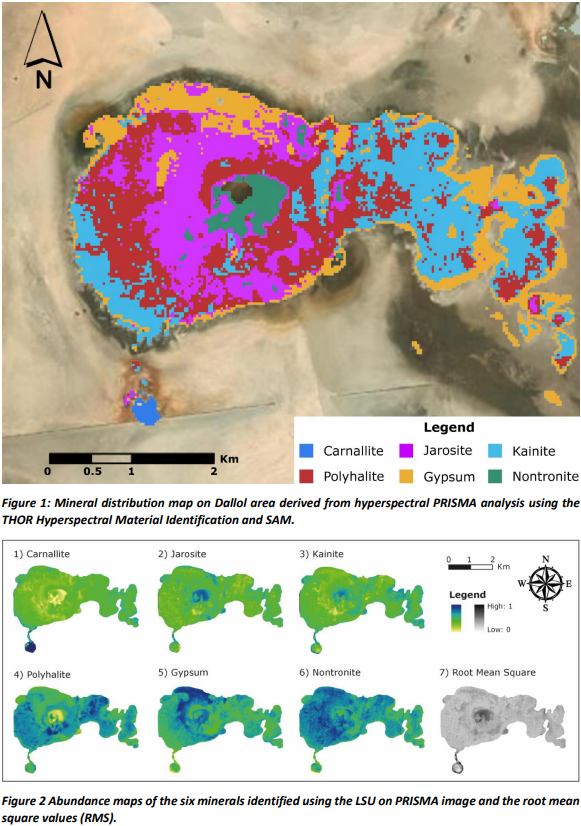
Conclusion
Six minerals have been recognised with the SAM classification from ENVI spectral library, in excellent agreement with the previous studies: carnallite, jarosite, kainite, polyhalite, gypsum and nontronite. The results confirm the mineralogical variability typical of the Dallol; in Fig.2, high mineral abundance values are shown in blue. The error calculated with the RMS is very low over the entire area of interest, except for the central zone where there are sulphur pools and therefore the presence of water does not favour this type of analysis.
To better constrain the mineralogical mapping, future work will be conducted by a field exploration campaign to collect spectral signatures to be added to the ENVI library used, which so far could not be organised due to the ongoing civil war in Dankalia.
To sum up, the study of terrestrial analogs can provide insights into the probable presence and nature of spring deposits on Mars, as well as help develop methods for classifying them from remote sensing data. PRISMA represents a valuable satellite for distinguishing not only the geometric characteristics of observed objects, but also the chemical-physical composition of the surface of the Earth.
References: [1] Walter, M.R. and Des Marais, D.J., 1993. Icarus 101:129–143 [2] Chang, C.I., 2007. John Wiley & Sons. 10.1002/0470124628 [3] Candela, L., et al. 2016. IEEE international geoscience and remote sensing symposium (IGARSS), 253-256. 10.1109/IGARSS.2016.7729057 [4] Loizzo, R., et al. 2019. IEEE (IGARSS), 4503-4506. 10.1109/IGARSS.2019.8899272 [5] Cavalazzi, B., et al. 2019. Astrobiology, 19(4), 553-578. 10.1089/AST.2018.1926 [6] López-García, J.M., et al. 2020. Frontiers in Earth Science, 7, 351. 10.3389/FEART.2019.00351
How to cite: Mancini, F., Tullo, A., Allemand, P., and Ori, G. G.: Mineral Identification and Abundance Mapping through the hyperspectral PRISMA images on the Dallol Planetary Analog, Europlanet Science Congress 2022, Granada, Spain, 18–23 Sep 2022, EPSC2022-983, https://doi.org/10.5194/epsc2022-983, 2022.
The identification of novel terrestrial sites that are analogous for other planetary bodies is an active area of research within astrobiology, because of the logistical and financial difficulties in obtaining extraterrestrial samples for analysis. Characterisation of potential analogue sites is undertaken to assess how accurately they represent a specific extraterrestrial environment. Analysing their physicochemical conditions and microbial communities are key components of these studies to understand what metabolisms would be viable in such environments.
One such novel analogue environment is the salt plains of Western Sahara. Western Sahara is one of the driest regions on Earth. It is located on the northwest coast of West Africa and is characterised by high UV exposure, low annual precipitation and water activity, subsurface water and high annual temperatures. These features make Western Sahara a potential analogue site for Mars during the Noachian-Hesperian transition period (3.5 – 3.8 Ga), when the atmosphere began to thin and surface water started evaporating (Warner et al., 2010), similar to other terrestrial deserts, such as the Atacama Desert and the McMurdo Dry Valleys.
The hypersalinity, aridity and high UV radiation levels of the Western Sahara salt plains would also be appropriate to study whether dissimilatory sulfur metabolisms would be viable in a Noachian-Hesperian Mars analogue environment. Dissimilatory sulfur cycling refers to the use of inorganic sulfur compounds for energy conservation and it has been recognised as a metabolic strategy of interest for putative martian life (Macey et al., 2020). On Earth, evidence from stable sulfur isotope fractionation has suggested this metabolism emerged early in the history of life (~3.5 Ga). During this period, the conditions on Mars were predicted as being more habitable than present-day, with an active magnetic field, thicker atmosphere and liquid water on the surface.
In this study, molecular and geochemical techniques were used to give first insights into the potential of the Western Sahara salt plains to serve as an analogue of Mars during the Noachian-Hesperian transition period. The microbiology was investigated through cultivation-independent and culture-dependent analyses of salt crystals, sediment and water samples obtained at three sites near Llaayoune (Fig. 1). The chemical nature of the samples was analysed through ion chromatography (IC) and inductively coupled plasma - optical emission spectrometry (ICP-OES).
The geochemical characterisation confirmed the high salinity of the samples and identified that sodium, potassium, magnesium and sulfur were the most enriched elements within all samples. Cultivation-dependent work resulted in the enrichment of a wide range of metabolic strategies from the samples including aerobic heterotrophs, phototrophs and sulfate-reducers. The enrichments from the salt were dominated by strains of Bacillus, whereas sulfate-reducing strains of Clostridium were isolated from the sediment samples. Microscope analysis of phototroph-selective media also indicated that algae and Cyanobacteria were successfully enriched from the samples. 16S rRNA amplicon sequencing results will also be presented to gain further in-depth understanding of the microbial community composition. Additionally, results from quantitative polymerase chain reaction (qPCR) experiment targeting sox and dsr genes will be presented to identify the abundance of genes specific for dissimilatory sulfur metabolisms within the samples.
Preliminary data shows that sulfur cycling is occurring in Western Sahara salt plains. Future characterisation of this environment will involve metagenomic analysis of the samples and genome sequencing of the isolates to identify the key metabolisms underpinning the survival and viability of the microbial community. Comparative studies with other Mars analogue environments will then be undertaken to identify metabolisms that may have been thermodynamically viable in ancient martian aqueous environments.
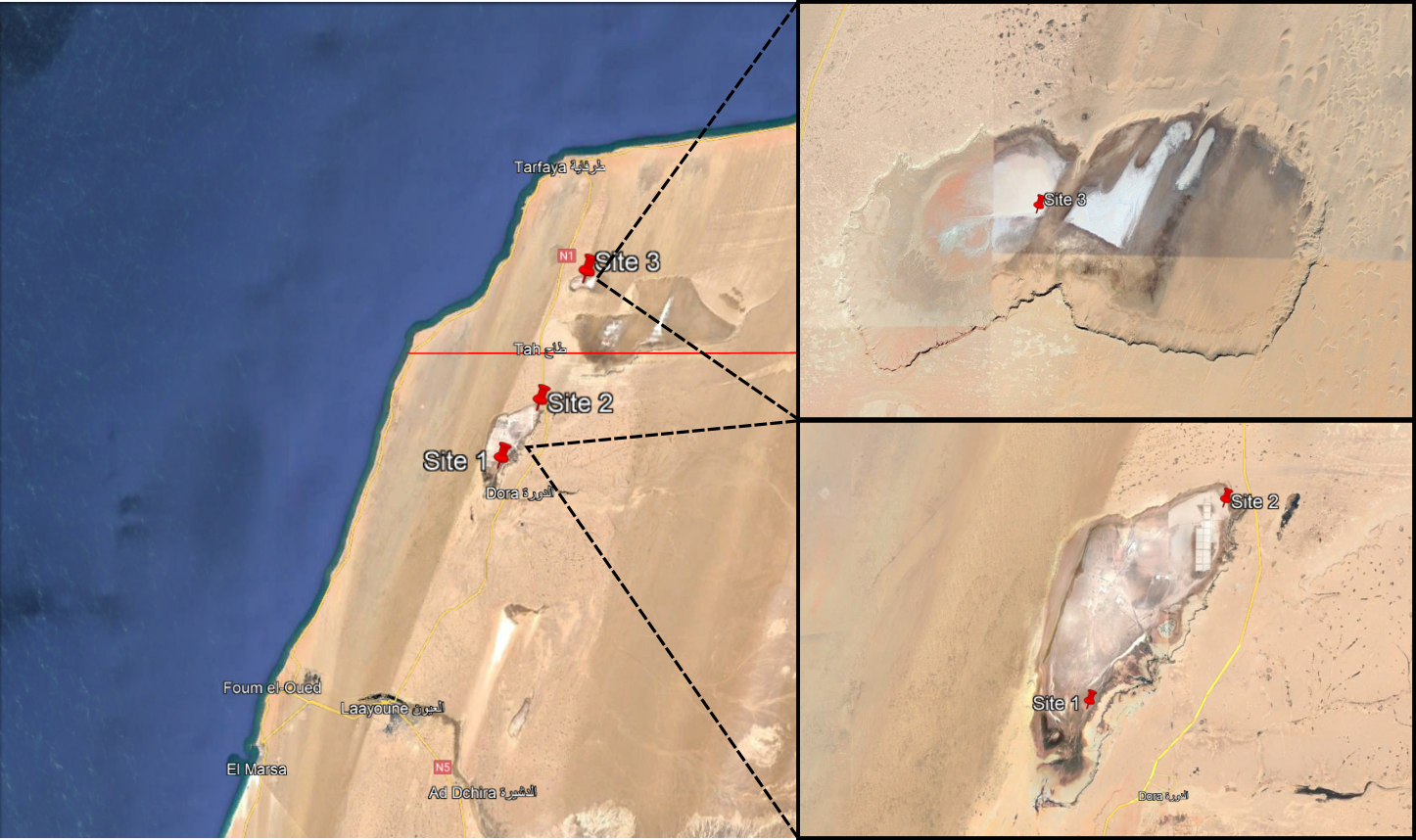
Figure 1. Location of the sample collection sites. Images were generated with Google Earth Pro.
References
Macey, M. C., Fox-Powell, M., Ramkissoon, N. K., Stephens, B. P., Barton, T., Schwenzer, S. P., . . . Olsson-Francis, K. (2020). The identification of sulfide oxidation as a potential metabolism driving primary production on late Noachian Mars. Scientific Reports, 10(1), 10941. https://doi.org/10.1038/s41598-020-67815-8
Warner, N., Gupta, S., Lin, S.-Y., Kim, J.-R., Muller, J.-P., & Morley, J. (2010). Late Noachian to Hesperian climate change on Mars: Evidence of episodic warming from transient crater lakes near Ares Vallis [https://doi.org/10.1029/2009JE003522]. Journal of Geophysical Research: Planets, 115(E6). https://doi.org/https://doi.org/10.1029/2009JE003522
How to cite: Ilieva, V., Stephens, B., Goodall, T., Ori, G., Read, D., Pearson, V., Olsson-Francis, K., and Macey, M.: Western Sahara salt plains as a potential novel Mars analogue, Europlanet Science Congress 2022, Granada, Spain, 18–23 Sep 2022, EPSC2022-1043, https://doi.org/10.5194/epsc2022-1043, 2022.
After a pause of two years, the two-week summer school at Vulcano, Sicily in June 2022 brought together, once again, scientists, researchers, students, and technicians, to another field campaign dealing with topics ranging from geology to robotic environmental exploration, astrobiology, and the study of planetary analogues. A number of successful (planned and unplanned) experiments and sampling campaigns were carried out on the island and in the coastal waters around Vulcano.
Vulcano is the third largest and southernmost island of the Aeolian archipelago in the Tyrrhenian Sea. The central Fossa crater on Vulcano has similar surface morphology to lunar and martian regions with extremely dry, arid conditions, little or no vegetation cover, angular grains over a range of grain-sizes. The diverse and extreme (hostile) environments at Vulcano provide an essential training ground for testing instruments and techniques foreseen for future robotic exploration missions to Mars and other bodies with a particular focus on astrobiology. This year, as in the past campaigns, a variety of spectral instruments ranging from visible and near-infrared (VNIR) reflectance to Raman spectroscopy will be deployed at various sites for mineralogical, biological, and elemental analysis. The in-situ survey, and its comparison with laboratory standards and instruments, will provide an assessment of the usability of these techniques to characterize extraterrestrial environments and guide our search for life in the Solar System (e.g. via assessing the detectability of biosignatures).
Drone photogrammetry surveys provide the regional context, map areas of interest such as potential hazards, while an Integrated Positioning System (IPS) in combination with infrared thermal imagery was deployed for future mapping and thermal stability analysis of different sites on Vulcano.
Furthermore, geophysics techniques such TEM and IP electric measurements of fumaroles and their 3D structure will be investigated. Last but not least, robotic missions for terrain analysis, locomotion and mapping will be undertaken on various lunar and martian analog terrains.
How to cite: Unnithan, V. and the VulcanoTeam2022: Vulcano Summer School 2022: Overview of the field-based terrestrial, marine and planetary analogue studies campaign, Europlanet Science Congress 2022, Granada, Spain, 18–23 Sep 2022, EPSC2022-1109, https://doi.org/10.5194/epsc2022-1109, 2022.
Introduction
The volcanic settings of the Eolian Islands, Italy, offer access to various types of volcanic terrains, with diverse morphology and mineralogy. This study focuses on Vulcano, whose last eruption is dated to 1890 but still shows volcanic activity [1]. The dry landscape and easy access to layers of older and more recent volcanic material, in addition to the possibility of investigating secondary minerals, make this site a very promising analog for our neighbor planets; Mars and Venus. Building on previous expeditions, we have acquired experience and knowledge about the potential of these analog environments and their habitability [2 - 4]. Our objectives for the June 2022 field campaign are: to investigate the surface roughness and active surface processes, as well as spectral characterization of volcanic material (Venus analog) and secondary minerals (Mars analog) with both field and lab instruments (detailed hereafter). We are also interested in the astrobiological aspects of these environments, which could represent early Venus/Mars, pertaining to the questions of life detection, using spectroscopy techniques, and habitability, looking at microbial colonization.
In-situ Instrumentation
Field measurements are collected with the following portable instrumentation:
- VEM (Venus Emissivity Mapper) Field Prototype - simulating the VEM and VenSpec-M instruments that will fly on the next VERITAS NASA and EnVision ESA missions to Venus, respectively [5]. The prototype is composed of a commercial camera and optics with narrow filters at 850, 910, 990 and 1000 nm, corresponding to four spectral windows in the Venus atmosphere where it is possible to obtain mapping of Venus’ surface features.
- Portable Raman - the RaPort handheld Raman instrument by EnSpectr equipped with a 532 nm excitation laser (same wavelength as used for the ExoMars rover) operating at <60 mW laser power, has a spectral range of 120 - 4000 cm-1 (> 2.5µm) at 6-9 cm-1 spectral resolution and a spot size of around 0.5 mm.
- Portable XRD/XRF Terra - is a portable X-ray diffraction/ X-ray Fluorescence instrument born from the need to perform XRD analysis on the Mars Science Laboratory (MSL) and is being now widely applied for Earth on field applications.
- Mini-PAM - instrument used to detect the presence of chlorophyll and photosynthetic activity.
- Portable spectro-radiometer (PSR+3500) operating in the visible and near-infrared spectral range (350 – 2500 nm) with a spectral resolution between 3 and 8 nm and a measurement spot size of 3 by 3 mm and is best used for mineralogical investigations.
- The Integrated Positioning System (IPS, developed at DLR) combines stereo camera, inertial and GNSS measurements for localization, 3D reconstruction and inspections in unknown environments. Equipped with a thermal imaging camera (Optris PI 640, spectral range of 8 - 14 µm), the hand-held prototype is investigated for exploration and thermal mapping of fumarolic fields [6].
Laboratory analysis
Further measurements on collected samples from Vulcano are performed at the Department of Planetary Laboratories (PLL)[7] at the German Aerospace Center (DLR, Berlin, Germany) in the:
- Planetary Spectroscopy Laboratory (PSL) - by mean of three Bruker Vertex80V FTIR spectrometers at PSL we can measure bi-directional bulk sample spectroscopy of the collected samples completely under vacuum in the whole spectral range from UV to FIR (0.25 µm to at least 25 µm spectral range). A Bruker Hyperion 2000 FT-IR microscope allows mapping smaller grains from VIS to MIR (0.4 to at least 16 µm spectral range) with a spatial resolution down to 50 µm.
- Raman-Mineral- Biology Detection Lab (RMBD) - equipped with a confocal WITec alpha 300 system, a piezo-driven scan table, a UHTS 300 spectrometer with an ultrafast EMCCD detector and a frequency-doubled Nd:YAG laser at 532 nm excitation wavelength. The spot diameter at the sample is ~2.5 µm and the spectral resolution of the spectrometer 4–5 cm-1 at 600 l/mm grating.
- Planetary Analog Simulation LABoratory (PASLAB) and Mars Simulation Facility-Laboratory (MSF) - selected samples are further tested in our simulation facilities able to recreate Mars and other planetary environmental conditions by a controlled gas mixing system (up to 5 gasses, e.g. CO2/N2/Ar/CH4/O2) with H2O, a resulting pressure of 6 – 10 mbar (Mars) and up to 1 bar (Earth-like conditions) and diurnal cycles of radiation (190 nm – 2200 nm), humidity (rh % 0 to 100) and temperature (-70°C to 130°C).
Discussion
This is the sixth time a field campaign coupled to a summer school takes place on Vulcano. It is a remarkable site to test and train instruments, rovers, or data processing techniques of high interest for planetary science (for instance, testing the potential of portable LIBS and VIS/NIR spectrometers [2-4] or mapping using drone and camera data [8]). The comparison between field and laboratory measurements, as well as with data acquired from previous field campaigns to the same site, provides useful hints on the further understanding and characterization of these terrestrial sites as planetary analogs. Moreover, it plays an important role in enhancing the capabilities of these in-situ techniques for the characterization of extraterrestrial environments in the view of the analysis and interpretation of orbital and in-situ planetary data. In terms of habitability and the search for life, the identified extreme and unique environments present at Vulcano inform us on strategies and protocols on how to detect life elsewhere.
Acknowledgements
The Vulcano Summer School is provided limited support by the ARCHES Project (Helmholtz Association Project Alliance ZT-0033) and institutional support from various universities and research institutions such as DLR, Jacobs University and University Freiberg.
References
[1] De Astis G. et al. (2013). Geol. Soc. Lond. Mem. 37 (1), 281 LP – 349.
[2] Rammelkamp, K. et al. (2021).. Spectr. Acta Part B: Atomic Spectroscopy, 177, 106067.
[3] Stephan et al. (2019), EPSC Abstracts Vol. 13, EPSC-DPS2019-2062, 2019.
[4] Stephan, K. et al. (2020), LPSC2020, p. 2411.
[5] Helbert et al. (2020), EPSC 2020, EPSC2020-260, https://doi.org/10.5194/epsc2020-260.
[6] Irmisch, P. et al. (2021), Geometry and Vision. ISGV 2021, vol 1386, pp 68–84.
[7] Helbert et al. (2022), 53rd Lun. and Planet. Sci. Conf., Co #2678, id. 1850.
[8] Gwinner, K. et al. (2000), Eos 81, 44, pp. 513, 516, 520.
How to cite: Baqué, M., Alemanno, G., Adeli, S., Bonato, E., D'Amore, M., Garland, S., Gwinner, K., Herrmann, C., Helbert, J., Irmisch, P., Maturilli, A., Pisello, A., Sohl, F., Stephan, K., Thomson, L., and Unnithan, V.: Vulcano (Italy) lava fields as Mars and Venus analogs: field and laboratory characterization, Europlanet Science Congress 2022, Granada, Spain, 18–23 Sep 2022, EPSC2022-1151, https://doi.org/10.5194/epsc2022-1151, 2022.
Introduction
If life ever existed on Mars, its presence on the surface was likely relegated to spatially isolated patches [c.f., Phillips et al. this conference]. It follows that finding evidence for past life on Mars will require careful selection of rover-explorable targets that are most likely to have hosted organisms at or near the surface and retained evidence of those organisms. The salt habitats of paleo-lake basins [1], [2] are examples of habitats with taphonomic windows [3], [4], and as such are high priority targets for astrobiological exploration [c.f,. Phillips et al. this conference]. Salt-encrusted paleo-lake basins on Mars [5]–[7] may contain features that in similar environments on Earth serve as habitats; however, the spatial resolution necessary to detect these features is relatively unknown [8]. Here, we show how deep-learning can be used to understand spatial resolution thresholds for the identification of habitats and apply this method to the habitats in a terrestrial salt-encrusted paleo lake basin (salar), Salar de Pajonales.
Geologic Background
Salar de Pajonales, Chile (SdP, 25°08’29”S, 68°46’20”W, 3547 m, Fig. 1) lies within the Altiplano Puna plateau near the border of the Atacama Desert (hereafter, Altiplano and Atacama, respectively). Salt-encrusted basins in the Atacama and Altiplano experience multiple extreme conditions, including aridity/hyper-aridity [9], intense UV irradiation [10], severe diurnal temperature swings, high evaporation rates [9], and high concentrations of salt, which make them suitable environmental analogs to the salt-encrusted basins of Mars. The surface of SdP hosts regions locally dominated by gypsum and carbonate [11]. Data for our study was collected from a gypsum-dominated area of the salar, designated the “Dome Field” for its many domical gypsum structures [2]. [12] show that microbial (chasmo)endoliths preferentially reside in alabaster habitats within decimeter- to meter-tall domes and ridges [c.f., Phillips et al. this conference].
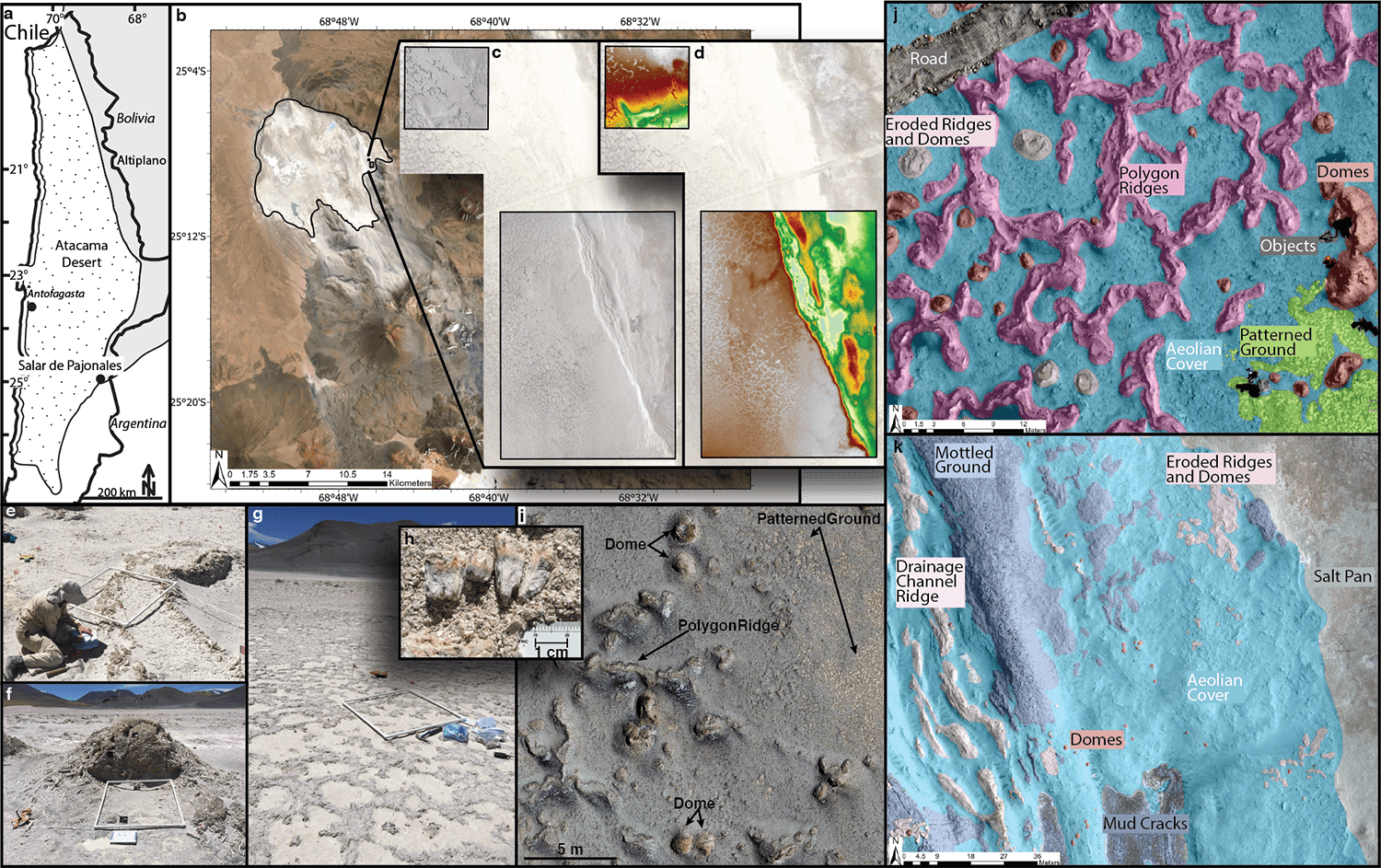
Fig. 1 Overview of Salar de Pajonales (SdP). A) Location of SdP within the Chilean Atacama Desert. B) Outline of SdP, note volcano to its south. C+D) Orthophotomosaic and DEM of the Dome Field generated with drone-collected images. E, F, G) Ridge, Dome, and Patterned Ground (biological soil crust) habitast at SdP, respectively. H) Pink and green horizons show endolithic microbial communities. I) Aerial view of Domes, Ridges, and Patterned Ground (biological soil crust) at SdP. J+K) Human-mapped ground truth classifications of the 12 feature classes in our study site.
Methods
We assessed the confidence with which habitats at SdP (polygon ridges, domes, and patterned ground) could be identified over a series of spatial resolutions with a methodology based on fully convolutional neural networks (FCNs, [13]). An FCN is a convolutional neural network with at least one fully-connected layer that adapts it to the semantic segmentation task. A “Confidence Score” was formulated to represent the degree to which one should trust FCN predictions [8]. The Confidence Score takes into account the correct and incorrect predictions made by the network, as well as the certainty (calculated using the Monte-Carlo Dropout method, [14]) associated with each prediction. BF-Score, precision, and recall were also calculated.
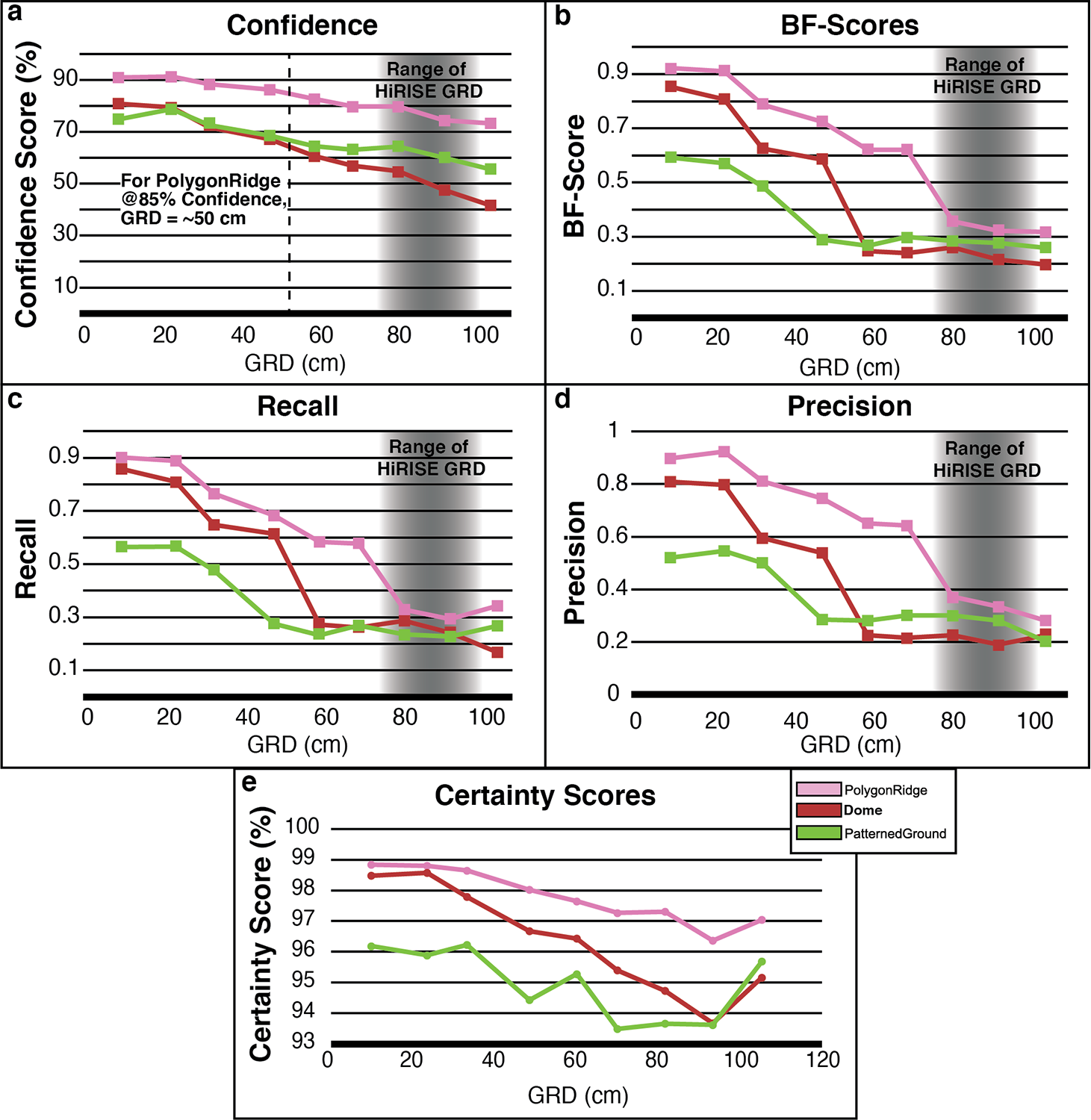
Fig. 2 Results as a function of Ground Resolved Distance (GRD). A) Confidence Score. B) BF-Score. C) Recall. D) Precision. E) Certainty. Gray region represents the approximate range of spatial resolutions achievable with HiRISE.
Results
The general characteristics of Precision, Recall, and BF-Score values as a function of image spatial resolution were relatively consistent between the habitats evaluated (Fig. 2b-d). We interpret the sharp drops in Precision, Recall, and BF-Score to mean that a spatial threshold critical for accurately segmenting (i.e., drawing a boundary around) a feature has been crossed. The threshold occurs at a GRD ~one-third the characteristic length scale of each feature, i.e., when the feature is spanned by 9 to 12 pixels. An analogy can be made to the Nyquist sampling frequency, wherein 2 to 3 pixels are required for a feature to be detected in an image. To achieve a 1-sigma level of identification confidence (Confidence Score ≥~85%) for the PolygonRidge class, a GRD approximately 20% its length scale is required, that is, it must be spanned by 15 to 20 pixels, or 5 to 10 times more pixels than is required to detect the feature. Conversely, Domes require a GRD ~6% their characteristic length scale (spanned by 50 to 65 pixels, or 17 to 33 times its detection limit) to be identified at the 1-sigma confidence level. PatternedGround could not be identified at the 1-sigma confidence level with the spatial resolutions studied here. This pattern suggests an intuitive hierarchy of recognition:
- detection: at 2-3 pixels, it is known that a feature exists
- segmentation: at 9-12 pixels, a boundary can be drawn around the feature
- identification: at ≥ 15 pixels, a class name can be accurately assigned to the feature.
These results emphasize the complexity and feature-specific nature of establishing identification thresholds in spatial resolution, and show that assuming the identifiability of a feature based only on its size may lead to overconfidence in the ability to identify it (e.g., the Dome class).Extending this work to establish the most- and least-identifiable habitats within presently-available images of Mars would be key for triaging habitats into a prioritized list of astrobiology targets and for informing future instrument specification requirements.
References:
[1] A. F. Davila et al., 2008. doi: 10.1029/2007JG000561.
[2] N. W. Hinman et al., 2022, https://www.frontiersin.org/article/10.3389/fspas.2021.797591
[3] R. E. Summons et al., Astrobiology, vol. 11, no. 2. p. 157, 2011.
[4] D. C. Fernández‐Remolar et al., 2013. doi: 10.1002/jgrg.20059.
[5] M. M. Osterloo et al., 2008. doi: 10.1126/science.1150690.
[6] T. D. Glotch, et al., 2016. doi: 10.1002/2015JE004921.
[7] E. K. Leask and B. L. Ehlmann, 2022, doi: 10.1029/2021AV000534.
[8] M. S. Phillips et al., Astrobiology, in review.
[9] J. Houston and A. J. Hartley, 2003. doi: 10.1002/joc.938.
[10] D. Häder and N. A. Cabrol, 2020. doi: 10.1111/php.13276.
[11] C. Rodríguez-Albornoz, Thesis, Universidad Católica del Norte, 2018.
[12] K. Warren-Rhodes et al., Nature Astronomy. in review.
[13] E. Shelhamer, et al., arXiv:1605.06211. p. tran, 2016.
[14] Y. Gal and Z. Ghahramani, ArXiv, vol. abs/1506.02142. 2016.
[15] B. L. Carrier et al., 2020. doi: 10.1089/ast.2020.2237.
[16] B. L. Ehlmann et al., 2016. doi: 10.1002/2016JE005134.
[17] T. C. Onstott et al., 2019. doi: 10.1089/ast.2018.1960.
[18] L. Hays, “NASA Astrobiology Strategy.” 2015.
How to cite: Phillips, M.: What is that? Identification confidence of Mars analog habitats with Deep Learning, Europlanet Science Congress 2022, Granada, Spain, 18–23 Sep 2022, EPSC2022-1200, https://doi.org/10.5194/epsc2022-1200, 2022.
AMADEE-20 is the latest Mars Analog Mission of the Austrian Space Forum (OeWF), conducted in Israel in the Negev Desert and hosted by the Israel Space Agency.
The 40 km long and 11 km wide Ramon Crater is an erosive crater unveiling a geological window of different sedimentary and volcanic processes with formations of sandstone, shales at the crater base, and mostly limestone and dolomite by the crater wall and represents sediments of the Thetis paleo-ocean with several volcanic and plutonic episodes including paleo-volcanos and granites. This nascency is accompanied by a semi-arid climate with dry summer (June – September), mild winter (December- February), and sparse vegetation only growing on the high rim hillslope and wadis (dry streams). Therefore, the Ramon Crater (Maktesh Ramon) presents remarkable geologic and geomorphological structures comparable to the Red Planet. Hence, beyond traditional analog mission applications, such as equipment behavior and evolving the know-how on crew management, we had the opportunity to develop research methods to catalyse the visibility of planetary explorations and develop structures for life-detection systematics and geoscientific techniques.
Two main segments of the mission; the mission support center (MSC)- on Earth time- and the field crew- on Mars time- were emulating a planetary surface mission by keeping a 20min time delay (10 min per signal direction) to account for the average signal travel time between Earth and Mars. The MSC was staffed by a Flight Director, Biomedical Engineers, Earth Communicators, CONTACTS,Records Manager, Procedure monitoring, Human Factors, Remote Science Support, Flightplan Team, Ground Support & Security, Science Data Officer, and Media Communication. The field crew was divided into two elements; I) the flight crew (6 AAs) with the analog astronauts, who conducted the experiments, and ii) the on-site support team (12 crew members) who provided support without interfering with the experiments or interacting directly with the AAs. Thereby, also maintaining a secured parameter and safety infrastructure for the simulation All major workflows of the mission were defined via the OeWF Standard Operating Procedures.

The flight crew habitat was provided by the Israel Space Agency and D-Mars, based upon the foldable D-Mars station design, complemented with a new module comprised of a Command module, Engineering/Science compartment, Crew quarters, Storage space, Mess and Hygiene module.
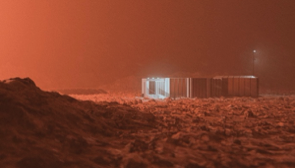
To provide a realistic platform for the experiments, isolation protocols were in place ensured. In total, 25 experiments were conducted from the fields such as engineering and robotics, human-robot interactions, health sciences, life sciences and geosciences. Outcomes of these experiments and the AMADEE-20 mission will be presented. This included an innovative science strategy, the exploration cascade which is an algorithm providing an efficient deployment sequence of scientific investigations (Groemer and Ozdemir, 2020).
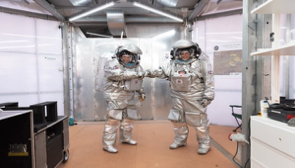
In the meantime, the preparations for the 14th analog mission of the OeWF, AMADEE-24 have started. With a comparable mission architecture as described above, we will be soliciting proposals for research experiments, to be selected peer-review process. These missions are a formidable platform for testing technologies, instruments and science workflows as well as it is a research opportunity for human factor studies.

REFERENCES:
Groemer G. and Ozdemir S. 2020. Planetary Analog Field Operations as a Learning Tool. Front. Astron. Space Sci. DOI: https://doi.org/10.3389/fspas.2020.00032
How to cite: Özdemir, S., Grömer, G., and Gruber, S.: Overview of AMADE-20 Mars Analog Mission and Insights from AMADEE-24, Europlanet Science Congress 2022, Granada, Spain, 18–23 Sep 2022, EPSC2022-1247, https://doi.org/10.5194/epsc2022-1247, 2022.
TP18 | Ionospheres of unmagnetized or weakly magnetized bodies
We estimate ion escape from Mars by combining observations and models. Assuming that upstream solar wind conditions are known, a computer model of the interaction between the solar wind and the planet is executed for different ionospheric ion production rates. This results in different amounts of mass loading of the solar wind. Then we obtain the ion escape rate from the model run that best fit observations of the bow shock location. This method enables studies of how escape depend on different parameters, and also escape rates during extreme solar wind conditions, applicable to studies of escape in the early solar system, and at exoplanets. This approach also allows us to use data sets traditionally not used for ion escape estimates, such as magnetic field and electron observations. We can also estimate the escape rate from a very small set of observations, during every orbit of a spacecraft around a planet or during one flyby of a planet.
How to cite: Holmstrom, M., Zhang, Q., Wang, X.-D., and Fatemi, S.: Estimations of Ion Escape from Mars, Europlanet Science Congress 2022, Granada, Spain, 18–23 Sep 2022, EPSC2022-239, https://doi.org/10.5194/epsc2022-239, 2022.
Unlike Earth, Venus doesn’t have an intrinsic magnetic field shielding it from the solar wind. However, an induced
magnetic field is generated from the interaction of solar wind and the dense atmosphere of the planet. Recent
Venus flybys by the BepiColombo mission in October 2020 and August 2021, and by Parker Solar Probe and Solar
Orbiter, are unique opportunities to further study the interaction between Venus and the Sun.
Observational data are essential in the study of this interaction but they are limited by the mission’s trajectory,
offering a constrained view of the processes that take place. On the other hand, simulations offer a global view
of the interactions, allowing us to get results with physical significance that would not have been possible from
observational data only. LatHyS is a three-dimensional parallel multi-species model using the hybrid formalism,
that represents the electrons as a massless fluid conserving the neutrality of the plasma, and the ions by numerical
macroparticles with variable weights. Ions and electrons are coupled together using the Maxwell equations, and the
macroscopic plasma parameters determine the evolution of the magnetic field (Ledvina et al. 2008). It was initially
developed at LATMOS, Paris, France, for Mars (Modolo et al. 2005) and later parallelized (Modolo et al. 2016) for
performance and optimization purposes. It has the advantage of having a self consistently calculated ionosphere.
LatHyS was recently adapted to the simulations of the interaction between the solar wind and Venus at IRAP,
Toulouse, France (Aizawa et al. 2022).
The work conducted aims at adapting a multi-grid method, initially adapted to LatHyS by Leclercq et al. 2016
for the study of Mars and Ganymede, to the case of Venus. The multi-grid refinement allows a more efficient use
of computing resources and an improved accuracy of the simulation thanks to a spatial resolution equivalent to or
lower than the ionospheric plasma scale height.
First, the multi-grid method is presented. Then, simulations using the multi-grid method on the solar wind’s
interaction with Venus are conducted, and their results are compared to simulations made using LatHyS with a
single homogeneous grid.
Finally the outputs of the numerical simulations are compared to data on the magnetic field and charged particles
from recent flybys and from the Venus Express mission, that orbited the planet from 2006 to 2014.
References:
Aizawa et al. 2022. https://doi.org/10.1016/j.pss.2022.105499
Leclercq et al. 2016. http://dx.doi.org/10.1016/j.jcp.2016.01.005
Ledvina et al. 2008. http://dx.doi.org/10.1007/s11214-008-9384-6
Modolo et al. 2005. https://doi.org/10.5194/angeo-23-433-2005
Modolo et al. 2016. http://dx.doi.org/10.1002/2015JA022324
How to cite: Jariel, E., Aizawa, S., Modolo, R., Leclercq, L., Baskevitch, C., Andre, N., and Persson, M.: Adapting a multi-grid method to a numerical simulation model of the interaction between Venus and the solar wind, Europlanet Science Congress 2022, Granada, Spain, 18–23 Sep 2022, EPSC2022-417, https://doi.org/10.5194/epsc2022-417, 2022.
Global dust storms at Mars engulf the entire planet in a dusty haze, causing increases in temperature and ion escape as dust is lifted up to 80 km in altitude. The two most recent storms occurred in 2007 (Mars Year (MY) 28) and 2018 (MY34), and have been observed by spacecrafts such as Mars Express (MEx). MEx has been operating at Mars since 2004, and has produced a long time-base of plasma measurements from as low as 250 km. Using MEx, we investigate whether the 2007 dust storm has influenced the magnetosphere of Mars by looking at the position of the bow shock and induced magnetospheric boundary, compared to the expected position provided by 3D magnetohydrodynamical models. To identify boundary positions, we use data from the ASPERA-3 instrument (Analyser of Space Plasma and EneRgetic Atoms) onboard MEx, which contains an electron spectrometer (ELS), ion mass analyser (IMA), neutral particle imager (NPI) and neutral particle detector (NPD). For this study, we use data from ELS and IMA. We consider a number of influences on the boundary position, including the solar wind conditions and the crustal fields. Our study period includes time before, during, and after the MY28 global storm, and we expected the bow shock and induced magnetospheric boundary to increase in altitude due to the storm. Out results show that the system is more complex, and multiple influences need to be distinguished to leave any change due to the dust storm itself.
How to cite: Regan, C., Coates, A., Wellbrock, A., Haythornthwaite, R., Jones, G., Sánchez-Cano, B., Holmström, M., Frahm, R., and Garnier, P.: Investigating the Global Dust Storm in Mars Year 28 with Mars Express, Europlanet Science Congress 2022, Granada, Spain, 18–23 Sep 2022, EPSC2022-527, https://doi.org/10.5194/epsc2022-527, 2022.


